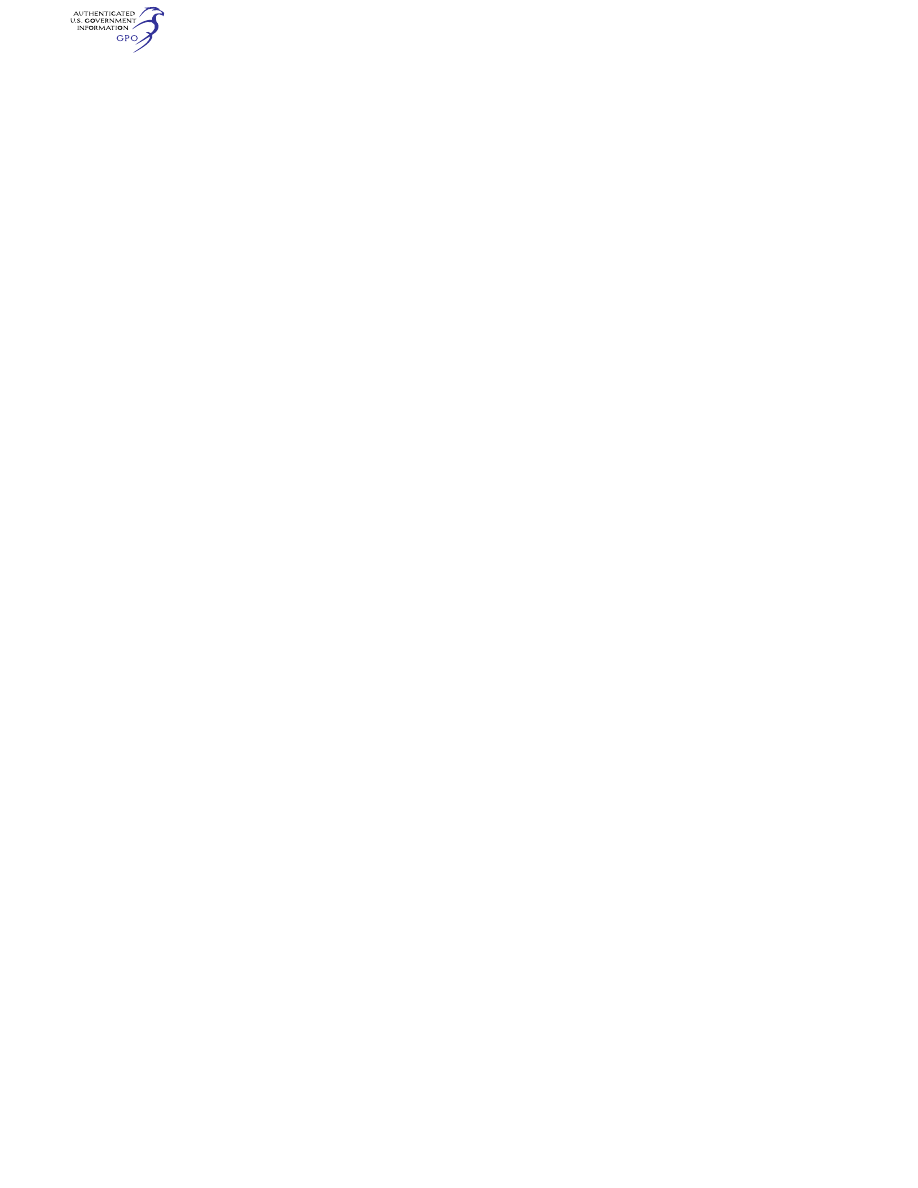
415
Federal Aviation Administration, DOT
Pt. 135
(1) Information on any peculiarities
discovered when operating particular
rotorcraft-load combinations;
(2) Precautionary advice regarding
static electricity discharges for Class
B, Class C, and Class D rotorcraft-load
combinations; and
(3) Any other information essential
for safe operation with external loads.
[Doc. No. 1529, 29 FR 603, Jan. 24, 1964, as
amended by Amdt. 133–9, 51 FR 40709, Nov. 7,
1986]
§ 133.49 Markings and placards.
The following markings and placards
must be displayed conspicuously and
must be such that they cannot be eas-
ily erased, disfigured, or obscured:
(a) A placard (displayed in the cock-
pit or cabin) stating the class of rotor-
craft-load combination for which the
rotorcraft has been approved and the
occupancy limitation prescribed in
§ 133.35(a).
(b) A placard, marking, or instruc-
tion (displayed next to the external-
load attaching means) stating the max-
imum external load prescribed as an
operating limitation in § 133.45(b).
[Docket 1529, Amdt. 133–9A, 81 FR 85138, Nov.
25, 2016]
§ 133.51 Airworthiness certification.
A Rotorcraft External-Load Operator
Certificate is a current and valid air-
worthiness certificate for each rotor-
craft type certificated under part 27 or
29 of this chapter (or their predecessor
parts) and listed by registration num-
ber on a list attached to the certifi-
cate, when the rotorcraft is being used
in operations conducted under this
part.
[Doc. No. 24550, 51 FR 40709, Nov. 7, 1986]
PART 135—OPERATING REQUIRE-
MENTS: COMMUTER AND ON DE-
MAND OPERATIONS AND RULES
GOVERNING PERSONS ON
BOARD SUCH AIRCRAFT
S
PECIAL
F
EDERAL
A
VIATION
R
EGULATION
N
O
.
50–2 [N
OTE
]
S
PECIAL
F
EDERAL
A
VIATION
R
EGULATION
N
O
.
71 [N
OTE
]
S
PECIAL
F
EDERAL
A
VIATION
R
EGULATION
N
O
.
89 [N
OTE
]
S
PECIAL
F
EDERAL
A
VIATION
R
EGULATION
N
O
.
97 [N
OTE
]
Subpart A—General
Sec.
135.1
Applicability.
135.2
Compliance schedule for operators
that transition to part 121 of this chap-
ter; certain new entrant operators.
135.3
Rules applicable to operations subject
to this part.
135.4
Applicability of rules for eligible on-
demand operations.
135.7
Applicability of rules to unauthorized
operators.
135.12
Previously trained crewmembers.
135.19
Emergency operations.
135.21
Manual requirements.
135.23
Manual contents.
135.25
Aircraft requirements.
135.41
Carriage of narcotic drugs, mari-
huana, and depressant or stimulant drugs
or substances.
135.43
Crewmember certificates: Inter-
national operations.
Subpart B—Flight Operations
135.61
General.
135.63
Recordkeeping requirements.
135.64
Retention of contracts and amend-
ments: Commercial operators who con-
duct intrastate operations for compensa-
tion or hire.
135.65
Reporting mechanical irregularities.
135.67
Reporting potentially hazardous me-
teorological conditions and irregularities
of ground facilities or navigation aids.
135.69
Restriction or suspension of oper-
ations: Continuation of flight in an emer-
gency.
135.71
Airworthiness check.
135.73
Inspections and tests.
135.75
Inspectors credentials: Admission to
pilots’ compartment: Forward observer’s
seat.
135.76
DOD Commercial Air Carrier Eval-
uator’s Credentials: Admission to pilots
compartment: Forward observer’s seat.
135.77
Responsibility for operational con-
trol.
135.78
Instrument approach procedures and
IFR landing minimums.
135.79
Flight locating requirements.
135.81
Informing personnel of operational
information and appropriate changes.
135.83
Operating information required.
135.85
Carriage of persons without compli-
ance with the passenger-carrying provi-
sions of this part.
135.87
Carriage of cargo including carry-on
baggage.
135.89
Pilot requirements: Use of oxygen.
135.91
Oxygen and portable oxygen con-
centrators for medical use by passengers.
135.93
Minimum altitudes for use of auto-
pilot.

416
14 CFR Ch. I (1–1–24 Edition)
Pt. 135
135.95
Airmen: Limitations on use of serv-
ices.
135.97
Aircraft and facilities for recent
flight experience.
135.98
Operations in the North Polar Area.
135.99
Composition of flight crew.
135.100
Flight crewmember duties.
135.101
Second in command required under
IFR.
135.103
[Reserved]
135.105
Exception to second in command re-
quirement: Approval for use of autopilot
system.
135.107
Flight attendant crewmember re-
quirement.
135.109
Pilot in command or second in com-
mand: Designation required.
135.111
Second in command required in Cat-
egory II operations.
135.113
Passenger occupancy of pilot seat.
135.115
Manipulation of controls.
135.117
Briefing of passengers before flight.
135.119
Prohibition against carriage of
weapons.
135.120
Prohibition on interference with
crewmembers.
135.121
Alcoholic beverages.
135.122
Stowage of food, beverage, and pas-
senger service equipment during aircraft
movement on the surface, takeoff, and
landing.
135.123
Emergency and emergency evacu-
ation duties.
135.125
Aircraft security.
135.127
Passenger information requirements
and smoking prohibitions.
135.128
Use of safety belts and child re-
straint systems.
135.129
Exit seating.
Subpart C—Aircraft and Equipment
135.141
Applicability.
135.143
General requirements.
135.144
Portable electronic devices.
135.145
Aircraft proving and validation
tests.
135.147
Dual controls required.
135.149
Equipment requirements: General.
135.150
Public address and crewmember
interphone systems.
135.151
Cockpit voice recorders.
135.152
Flight data recorders.
135.153
[Reserved]
135.154
Terrain awareness and warning sys-
tem.
135.155
Fire extinguishers: Passenger-car-
rying aircraft.
135.156
Flight data recorders: filtered data.
135.157
Oxygen equipment requirements.
135.158
Pitot heat indication systems.
135.159
Equipment requirements: Carrying
passengers under VFR at night or under
VFR over-the-top conditions.
135.160
Radio altimeters for rotorcraft oper-
ations.
135.161
Communication and navigation
equipment for aircraft operations under
VFR over routes navigated by pilotage.
135.163
Equipment requirements: Aircraft
carrying passengers under IFR.
135.165
Communication and navigation
equipment: Extended over-water or IFR
operations.
135.167
Emergency equipment: Extended
overwater operations.
135.168
Emergency equipment: Overwater
rotorcraft operations.
135.169
Additional airworthiness require-
ments.
135.170
Materials for compartment inte-
riors.
135.171
Shoulder harness installation at
flight crewmember stations.
135.173
Airborne thunderstorm detection
equipment requirements.
135.175
Airborne weather radar equipment
requirements.
135.177
Emergency equipment requirements
for aircraft having a passenger seating
configuration of more than 19 passengers.
135.178
Additional emergency equipment.
135.179
Inoperable instruments and equip-
ment.
135.180
Traffic Alert and Collision Avoid-
ance System.
135.181
Performance requirements: Aircraft
operated over-the-top or in IFR condi-
tions.
135.183
Performance requirements: Land
aircraft operated over water.
135.185
Empty weight and center of gravity:
Currency requirement.
Subpart D—VFR/IFR Operating Limitations
and Weather Requirements
135.201
Applicability.
135.203
VFR: Minimum altitudes.
135.205
VFR: Visibility requirements.
135.207
VFR: Helicopter surface reference
requirements.
135.209
VFR: Fuel supply.
135.211
VFR: Over-the-top carrying pas-
sengers: Operating limitations.
135.213
Weather reports and forecasts.
135.215
IFR: Operating limitations.
135.217
IFR: Takeoff limitations.
135.219
IFR: Destination airport weather
minimums.
135.221
IFR: Alternate airport weather
minimums.
135.223
IFR: Alternate airport requirements.
135.225
IFR: Takeoff, approach and landing
minimums.
135.227
Icing conditions: Operating limita-
tions.
135.229
Airport requirements.
Subpart E—Flight Crewmember
Requirements
135.241
Applicability.

417
Federal Aviation Administration, DOT
Pt. 135
135.243
Pilot in command qualifications.
135.244
Operating experience.
135.245
Second in command qualifications.
135.247
Pilot qualifications: Recent experi-
ence.
135.249–135.255
[Reserved]
Subpart F—Crewmember Flight Time and
Duty Period Limitations and Rest Re-
quirements
135.261
Applicability.
135.263
Flight time limitations and rest re-
quirements: All certificate holders.
135.265
Flight time limitations and rest re-
quirements: Scheduled operations.
135.267
Flight time limitations and rest re-
quirements: Unscheduled one- and two-
pilot crews.
135.269
Flight time limitations and rest re-
quirements: Unscheduled three- and four-
pilot crews.
135.271
Helicopter hospital emergency med-
ical evacuation service (HEMES).
135.273
Duty period limitations and rest
time requirements.
Subpart G—Crewmember Testing
Requirements
135.291
Applicability.
135.293
Initial and recurrent pilot testing
requirements.
135.295
Initial and recurrent flight attend-
ant crewmember testing requirements.
135.297
Pilot in command: Instrument pro-
ficiency check requirements.
135.299
Pilot in command: Line checks:
Routes and airports.
135.301
Crewmember: Tests and checks,
grace provisions, training to accepted
standards.
Subpart H—Training
135.321
Applicability and terms used.
135.323
Training program: General.
135.324
Training program: Special rules.
135.325
Training program and revision: Ini-
tial and final approval.
135.327
Training program: Curriculum.
135.329
Crewmember training requirements.
135.330
Crew resource management training.
135.331
Crewmember emergency training.
135.335
Approval of aircraft simulators and
other training devices.
135.336
Airline transport pilot certification
training program.
135.337
Qualifications: Check airmen (air-
craft) and check airmen (simulator).
135.338
Qualifications: Flight instructors
(aircraft) and flight instructors (simu-
lator).
135.339
Initial and transition training and
checking: Check airmen (aircraft), check
airmen (simulator).
135.340
Initial and transition training and
checking: Flight instructors (aircraft),
flight instructors (simulator).
135.341
Pilot and flight attendant crew-
member training programs.
135.343
Crewmember initial and recurrent
training requirements.
135.345
Pilots: Initial, transition, and up-
grade ground training.
135.347
Pilots: Initial, transition, upgrade,
and differences flight training.
135.349
Flight attendants: Initial and transi-
tion ground training.
135.351
Recurrent training.
135.353
[Reserved]
Subpart I—Airplane Performance
Operating Limitations
135.361
Applicability.
135.363
General.
135.364
Maximum flying time outside the
United States.
135.365
Large transport category airplanes:
Reciprocating engine powered: Weight
limitations.
135.367
Large transport category airplanes:
Reciprocating engine powered: Takeoff
limitations.
135.369
Large transport category airplanes:
Reciprocating engine powered: En route
limitations: All engines operating.
135.371
Large transport category airplanes:
Reciprocating engine powered: En route
limitations: One engine inoperative.
135.373
Part 25 transport category airplanes
with four or more engines: Reciprocating
engine powered: En route limitations:
Two engines inoperative.
135.375
Large transport category airplanes:
Reciprocating engine powered: Landing
limitations: Destination airports.
135.377
Large transport category airplanes:
Reciprocating engine powered: Landing
limitations: Alternate airports.
135.379
Large transport category airplanes:
Turbine engine powered: Takeoff limita-
tions.
135.381
Large transport category airplanes:
Turbine engine powered: En route limita-
tions: One engine inoperative.
135.383
Large transport category airplanes:
Turbine engine powered: En route limita-
tions: Two engines inoperative.
135.385
Large transport category airplanes:
Turbine engine powered: Landing limita-
tions: Destination airports.
135.387
Large transport category airplanes:
Turbine engine powered: Landing limita-
tions: Alternate airports.
135.389
Large nontransport category air-
planes: Takeoff limitations.
135.391
Large nontransport category air-
planes: En route limitations: One engine
inoperative.

418
14 CFR Ch. I (1–1–24 Edition)
Pt. 135, SFAR No. 50–2, Nt.
135.393
Large nontransport category air-
planes: Landing limitations: Destination
airports.
135.395
Large nontransport category air-
planes: Landing limitations: Alternate
airports.
135.397
Small transport category airplane
performance operating limitations.
135.398
Commuter category airplanes per-
formance operating limitations.
135.399
Small nontransport category air-
plane performance operating limitations.
Subpart J—Maintenance, Preventive
Maintenance, and Alterations
135.411
Applicability.
135.413
Responsibility for airworthiness.
135.415
Service difficulty reports.
135.417
Mechanical interruption summary
report.
135.419
Approved aircraft inspection pro-
gram.
135.421
Additional maintenance require-
ments.
135.422
Aging airplane inspections and
records reviews for multiengine airplanes
certificated with nine or fewer passenger
seats.
135.423
Maintenance, preventive mainte-
nance, and alteration organization.
135.425
Maintenance, preventive mainte-
nance, and alteration programs.
135.426
Contract maintenance.
135.427
Manual requirements.
135.429
Required inspection personnel.
135.431
Continuing analysis and surveil-
lance.
135.433
Maintenance and preventive mainte-
nance training program.
135.435
Certificate requirements.
135.437
Authority to perform and approve
maintenance, preventive maintenance,
and alterations.
135.439
Maintenance recording require-
ments.
135.441
Transfer of maintenance records.
135.443
Airworthiness release or aircraft
maintenance log entry.
Subpart K—Hazardous Materials Training
Program
135.501
Applicability and definitions.
135.503
Hazardous materials training: Gen-
eral.
135.505
Hazardous materials training re-
quired.
135.507
Hazardous materials training
records.
Subpart L—Helicopter Air Ambulance
Equipment, Operations, and Training
Requirements
135.601
Applicability and definitions.
135.603
Pilot-in-command instrument quali-
fications.
135.605
Helicopter terrain awareness and
warning system (HTAWS).
135.607
Flight Data Monitoring System.
135.609
VFR ceiling and visibility require-
ments for Class G airspace.
135.611
IFR operations at locations without
weather reporting.
135.613
Approach/departure IFR transitions.
135.615
VFR flight planning.
135.617
Pre-flight risk analysis.
135.619
Operations control centers.
135.621
Briefing of medical personnel.
A
PPENDIX
A
TO
P
ART
135—A
DDITIONAL
A
IR
-
WORTHINESS
S
TANDARDS FOR
10
OR
M
ORE
P
ASSENGER
A
IRPLANES
A
PPENDIX
B
TO
P
ART
135—A
IRPLANE
F
LIGHT
R
ECORDER
S
PECIFICATIONS
A
PPENDIX
C
TO
P
ART
135—H
ELICOPTER
F
LIGHT
R
ECORDER
S
PECIFICATIONS
A
PPENDIX
D
TO
P
ART
135—A
IRPLANE
F
LIGHT
R
ECORDER
S
PECIFICATION
A
PPENDIX
E
TO
P
ART
135—H
ELICOPTER
F
LIGHT
R
ECORDER
S
PECIFICATIONS
A
PPENDIX
F
TO
P
ART
135—A
IRPLANE
F
LIGHT
R
ECORDER
S
PECIFICATIONS
A
PPENDIX
G
TO
P
ART
135—E
XTENDED
O
PER
-
ATIONS
(ETOPS)
A
UTHORITY
: 49 U.S.C. 106(f), 106(g), 40113,
41706, 44701–44702, 44705, 44709, 44711–44713,
44715–44717, 44722, 44730, 45101–45105; Pub. L.
112–95, 126 Stat. 58 (49 U.S.C. 44730).
S
OURCE
: Docket No. 16097, 43 FR 46783, Oct.
10, 1978, unless otherwise noted.
S
PECIAL
F
EDERAL
A
VIATION
R
EGULATION
N
O
. 50–2
E
DITORIAL
N
OTE
: For the text of SFAR No.
50–2, see part 91 of this chapter.
S
PECIAL
F
EDERAL
A
VIATION
R
EGULATION
N
O
. 71
E
DITORIAL
N
OTE
: For the text of SFAR No.
71, see part 91 of this chapter.
S
PECIAL
F
EDERAL
A
VIATION
R
EGULATION
N
O
. 89
E
DITORIAL
N
OTE
: For the text of SFAR No.
89, see part 121 of this chapter.
S
PECIAL
F
EDERAL
A
VIATION
R
EGULATION
N
O
. 97
E
DITORIAL
N
OTE
: For the text of SFAR No.
97, see part 91 of this chapter.

419
Federal Aviation Administration, DOT
§ 135.2
Subpart A—General
§ 135.1 Applicability.
(a) This part prescribes rules gov-
erning—
(1) The commuter or on-demand oper-
ations of each person who holds or is
required to hold an Air Carrier Certifi-
cate or Operating Certificate under
part 119 of this chapter.
(2) Each person employed or used by
a certificate holder conducting oper-
ations under this part including the
maintenance, preventative mainte-
nance and alteration of an aircraft.
(3) The transportation of mail by air-
craft conducted under a postal service
contract awarded under 39 U.S.C. 5402c.
(4) Each person who applies for provi-
sional approval of an Advanced Quali-
fication Program curriculum, cur-
riculum segment, or portion of a cur-
riculum segment under subpart Y of
part 121 of this chapter of 14 CFR part
121 and each person employed or used
by an air carrier or commercial oper-
ator under this part to perform train-
ing, qualification, or evaluation func-
tions under an Advanced Qualification
Program under subpart Y of part 121 of
this chapter of 14 CFR part 121.
(5) Nonstop Commercial Air Tour
flights conducted for compensation or
hire in accordance with § 119.1(e)(2) of
this chapter that begin and end at the
same airport and are conducted within
a 25-statute-mile radius of that airport;
provided further that these operations
must comply only with the drug and
alcohol testing requirements in
§§ 120.31, 120.33, 120.35, 120.37, and 120.39
of this chapter; and with the provisions
of part 136, subpart A, and § 91.147 of
this chapter by September 11, 2007.
(6) Each person who is on board an
aircraft being operated under this part.
(7) Each person who is an applicant
for an Air Carrier Certificate or an Op-
erating Certificate under 119 of this
chapter, when conducting proving
tests.
(8) Commercial Air tours conducted
by holders of operations specifications
issued under this part must comply
with the provisions of part 136, Subpart
A of this chapter by September 11, 2007.
(9) Helicopter air ambulance oper-
ations as defined in § 135.601(b)(1).
(b) [Reserved]
(c) An operator who does not hold a
part 119 certificate and who operates
under the provisions of § 91.147 of this
chapter is permitted to use a person
who is otherwise authorized to perform
aircraft maintenance or preventive
maintenance duties and who is not sub-
ject to anti-drug and alcohol misuse
prevent programs to perform—
(1) Aircraft maintenance or preven-
tive maintenance on the operator’s air-
craft if the operator would otherwise
be required to transport the aircraft
more than 50 nautical miles further
than the repair point closest to opera-
tor’s principal place of operation to ob-
tain these services; or
(2) Emergency repairs on the opera-
tor’s aircraft if the aircraft cannot be
safely operated to a location where an
employee subject to FAA-approved pro-
grams can perform the repairs.
[Doc. No. 16097, 43 FR 46783, Oct. 10, 1978]
E
DITORIAL
N
OTE
: For F
EDERAL
R
EGISTER
ci-
tations affecting § 135.1, see the List of CFR
Sections Affected, which appears in the
Finding Aids section of the printed volume
and at
www.govinfo.gov.
§ 135.2 Compliance schedule for opera-
tors that transition to part 121 of
this chapter; certain new entrant
operators.
(a)
Applicability.
This section applies
to the following:
(1) Each certificate holder that was
issued an air carrier or operating cer-
tificate and operations specifications
under the requirements of part 135 of
this chapter or under SFAR No. 38–2 of
14 CFR part 121 before January 19, 1996,
and that conducts scheduled passenger-
carrying operations with:
(i) Nontransport category turbo-
propeller powered airplanes type cer-
tificated after December 31, 1964, that
have a passenger seat configuration of
10–19 seats;
(ii) Transport category turbo-
propeller powered airplanes that have a
passenger seat configuration of 20–30
seats; or
(iii) Turbojet engine powered air-
planes having a passenger seat configu-
ration of 1–30 seats.
(2) Each person who, after January
19, 1996, applies for or obtains an initial
air carrier or operating certificate and
operations specifications to conduct

420
14 CFR Ch. I (1–1–24 Edition)
§ 135.2
scheduled passenger-carrying oper-
ations in the kinds of airplanes de-
scribed in paragraphs (a)(1)(i), (a)(1)(ii),
or paragraph (a)(1)(iii) of this section.
(b)
Obtaining operations specifications.
A certificate holder described in para-
graph (a)(1) of this section may not,
after March 20, 1997, operate an air-
plane described in paragraphs (a)(1)(i),
(a)(1)(ii), or (a)(1)(iii) of this section in
scheduled passenger-carrying oper-
ations, unless it obtains operations
specifications to conduct its scheduled
operations under part 121 of this chap-
ter on or before March 20, 1997.
(c)
Regular or accelerated compliance.
Except as provided in paragraphs (d),
and (e) of this section, each certificate
holder described in paragraph (a)(1) of
this section shall comply with each ap-
plicable requirement of part 121 of this
chapter on and after March 20, 1997 or
on and after the date on which the cer-
tificate holder is issued operations
specifications under this part, which-
ever occurs first. Except as provided in
paragraphs (d) and (e) of this section,
each person described in paragraph
(a)(2) of this section shall comply with
each applicable requirement of part 121
of this chapter on and after the date on
which that person is issued a certifi-
cate and operations specifications
under part 121 of this chapter.
(d)
Delayed compliance dates.
Unless
paragraph (e) of this section specifies
an earlier compliance date, no certifi-
cate holder that is covered by para-
graph (a) of this section may operate
an airplane in 14 CFR part 121 oper-
ations on or after a date listed in this
paragraph unless that airplane meets
the applicable requirement of this
paragraph:
(1)
Nontransport category turbo-
propeller powered airplanes type certifi-
cated after December 31, 1964, that have a
passenger seat configuration of 10–19
seats.
No certificate holder may oper-
ate under this part an airplane that is
described in paragraph (a)(1)(i) of this
section on or after a date listed in
paragraph (d)(1) of this section unless
that airplane meets the applicable re-
quirement listed in paragraph (d)(1) of
this section:
(i) December 20, 1997:
(A) Section 121.289, Landing gear
aural warning.
(B) Section 121.308, Lavatory fire pro-
tection.
(C) Section 121.310(e), Emergency exit
handle illumination.
(D) Section 121.337(b)(8), Protective
breathing equipment.
(E) Section 121.340, Emergency flota-
tion means.
(ii) December 20, 1999: Section 121.342,
Pitot heat indication system.
(iii) December 20, 2010:
(A) For airplanes described in
§ 121.157(f), the Airplane Performance
Operating Limitations in §§ 121.189
through 121.197.
(B) Section 121.161(b), Ditching ap-
proval.
(C) Section 121.305(j), Third attitude
indicator.
(D) Section 121.312(c), Passenger seat
cushion flammability.
(iv) March 12, 1999: Section
121.310(b)(1), Interior emergency exit
locating sign.
(2)
Transport category turbopropeller
powered airplanes that have a passenger
seat configuration of 20–30 seats.
No cer-
tificate holder may operate under this
part an airplane that is described in
paragraph (a)(1)(ii) of this section on or
after a date listed in paragraph (d)(2) of
this section unless that airplane meets
the applicable requirement listed in
paragraph (d)(2) of this section:
(i) December 20, 1997:
(A) Section 121.308, Lavatory fire pro-
tection.
(B) Section 121.337(b) (8) and (9), Pro-
tective breathing equipment.
(C) Section 121.340, Emergency flota-
tion means.
(ii) December 20, 2010: Section
121.305(j), Third attitude indicator.
(e)
Newly manufactured airplanes.
No
certificate holder that is described in
paragraph (a) of this section may oper-
ate under part 121 of this chapter an
airplane manufactured on or after a
date listed in this paragraph (e) unless
that airplane meets the applicable re-
quirement listed in this paragraph (e).
(1) For nontransport category turbo-
propeller powered airplanes type cer-
tificated after December 31, 1964, that
have a passenger seat configuration of
10–19 seats:
(i) Manufactured on or after March
20, 1997:

421
Federal Aviation Administration, DOT
§ 135.3
(A) Section 121.305(j), Third attitude
indicator.
(B) Section 121.311(f), Safety belts
and shoulder harnesses.
(ii) Manufactured on or after Decem-
ber 20, 1997: Section 121.317(a), Fasten
seat belt light.
(iii) Manufactured on or after Decem-
ber 20, 1999: Section 121.293, Takeoff
warning system.
(iv) Manufactured on or after March
12, 1999: Section 121.310(b)(1), Interior
emergency exit locating sign.
(2) For transport category turbo-
propeller powered airplanes that have a
passenger seat configuration of 20–30
seats manufactured on or after March
20, 1997: Section 121.305(j), Third atti-
tude indicator.
(f)
New type certification requirements.
No person may operate an airplane for
which the application for a type cer-
tificate was filed after March 29, 1995,
in 14 CFR part 121 operations unless
that airplane is type certificated under
part 25 of this chapter.
(g)
Transition plan.
Before March 19,
1996 each certificate holder described in
paragraph (a)(1) of this section must
submit to the FAA a transition plan
(containing a calendar of events) for
moving from conducting its scheduled
operations under the commuter re-
quirements of part 135 of this chapter
to the requirements for domestic or
flag operations under part 121 of this
chapter. Each transition plan must
contain details on the following:
(1) Plans for obtaining new oper-
ations specifications authorizing do-
mestic or flag operations;
(2) Plans for being in compliance
with the applicable requirements of
part 121 of this chapter on or before
March 20, 1997; and
(3) Plans for complying with the com-
pliance date schedules contained in
paragraphs (d) and (e) of this section.
[Doc. No. 28154, 60 FR 65938, Dec. 20, 1995, as
amended by Amdt. 135–65, 61 FR 30435, June
14, 1996; Amdt. 135–66, 62 FR 13257, Mar. 19,
1997]
§ 135.3 Rules applicable to operations
subject to this part.
(a) Each person operating an aircraft
in operations under this part shall—
(1) While operating inside the United
States, comply with the applicable
rules of this chapter; and
(2) While operating outside the
United States, comply with Annex 2,
Rules of the Air, to the Convention on
International Civil Aviation or the reg-
ulations of any foreign country, which-
ever applies, and with any rules of
parts 61 and 91 of this chapter and this
part that are more restrictive than
that Annex or those regulations and
that can be complied with without vio-
lating that Annex or those regulations.
Annex 2 is incorporated by reference in
§ 91.703(b) of this chapter.
(b) Each certificate holder that con-
ducts commuter operations under this
part with airplanes in which two pilots
are required by the type certification
rules of this chapter shall comply with
subparts N and O of part 121 of this
chapter instead of the requirements of
subparts E, G, and H of this part. Not-
withstanding the requirements of this
paragraph, a pilot serving under this
part as second in command in a com-
muter operation with airplanes in
which two pilots are required by the
type certification rules of this chapter
may meet the requirements of § 135.245
instead of the requirements of § 121.436.
(c) If authorized by the Adminis-
trator upon application, each certifi-
cate holder that conducts operations
under this part to which paragraph (b)
of this section does not apply, may
comply with the applicable sections of
subparts N and O of part 121 instead of
the requirements of subparts E, G, and
H of this part, except that those au-
thorized certificate holders may choose
to comply with the operating experi-
ence requirements of § 135.244, instead
of the requirements of § 121.434 of this
chapter. Notwithstanding the require-
ments of this paragraph, a pilot serving
under this part as second in command
may meet the requirements of § 135.245
instead of the requirements of § 121.436.
(d) Additional limitations applicable
to certificate holders that are required
by paragraph (b) of this section or au-
thorized in accordance with paragraph
(c) of this section, to comply with part
121, subparts N and O of this chapter
instead of subparts E, G, and H of this
part.

422
14 CFR Ch. I (1–1–24 Edition)
§ 135.4
(1)
Upgrade training.
(i) Each certifi-
cate holder must include in upgrade
ground training for pilots, instruction
in at least the subjects identified in
§ 121.419(a) of this chapter, as applicable
to their assigned duties; and, for pilots
serving in crews of two or more pilots,
beginning on April 27, 2022, instruction
and facilitated discussion in the sub-
jects identified in § 121.419(c) of this
chapter.
(ii) Each certificate holder must in-
clude in upgrade flight training for pi-
lots, flight training for the maneuvers
and procedures required in § 121.424(a),
(c), (e), and (f) of this chapter; and, for
pilots serving in crews of two or more
pilots, beginning on April 27, 2022, the
flight training required in § 121.424(b) of
this chapter.
(2)
Initial and recurrent leadership and
command and mentoring training.
Cer-
tificate holders are not required to in-
clude leadership and command training
in §§ 121.409(b)(2)(ii)(B)(
6
), 121.419(c)(1),
121.424(b) and 121.427(d)(1) of this chap-
ter and mentoring training in
§§ 121.419(c)(2) and 121.427(d)(1) of this
chapter in initial and recurrent train-
ing for pilots in command who serve in
operations that use only one pilot.
(3)
One-time leadership and command
and mentoring training.
Section 121.429
of this chapter does not apply to cer-
tificate holders conducting operations
under this part when those operations
use only one pilot.
[Doc. No. 27993, 60 FR 65949, Dec. 20, 1995, as
amended by Amdt. 135–65, 61 FR 30435, June
14, 1996; Amdt. 135–127A, 78 FR 77574, Dec. 24,
2013; Docket FAA–2010–0100, Amdt. 135–127B,
81 FR 2, Jan. 4, 2016; Amdt. 135–142, 85 FR
10935, Feb. 25, 2020]
§ 135.4 Applicability of rules for eligi-
ble on-demand operations.
(a) An ‘‘eligible on-demand oper-
ation’’ is an on-demand operation con-
ducted under this part that meets the
following requirements:
(1)
Two-pilot crew.
The flightcrew
must consist of at least two qualified
pilots employed or contracted by the
certificate holder.
(2)
Flight crew experience.
The crew-
members must have met the applicable
requirements of part 61 of this chapter
and have the following experience and
ratings:
(i) Total flight time for all pilots:
(A) Pilot in command—A minimum
of 1,500 hours.
(B) Second in command—A minimum
of 500 hours.
(ii) For multi-engine turbine-powered
fixed-wing and powered-lift aircraft,
the following FAA certification and
ratings requirements:
(A) Pilot in command—Airline trans-
port pilot and applicable type ratings.
(B) Second in command—Commercial
pilot and instrument ratings.
(iii) For all other aircraft, the fol-
lowing FAA certification and rating re-
quirements:
(A) Pilot in command—Commercial
pilot and instrument ratings.
(B) Second in command—Commercial
pilot and instrument ratings.
(3)
Pilot operating limitations.
If the
second in command of a fixed-wing air-
craft has fewer than 100 hours of flight
time as second in command flying in
the aircraft make and model and, if a
type rating is required, in the type air-
craft being flown, and the pilot in com-
mand is not an appropriately qualified
check pilot, the pilot in command shall
make all takeoffs and landings in any
of the following situations:
(i) Landings at the destination air-
port when a Destination Airport Anal-
ysis is required by § 135.385(f); and
(ii) In any of the following condi-
tions:
(A) The prevailing visibility for the
airport is at or below
3
⁄
4
mile.
(B) The runway visual range for the
runway to be used is at or below 4,000
feet.
(C) The runway to be used has water,
snow, slush, ice, or similar contamina-
tion that may adversely affect aircraft
performance.
(D) The braking action on the run-
way to be used is reported to be less
than ‘‘good.’’
(E) The crosswind component for the
runway to be used is in excess of 15
knots.
(F) Windshear is reported in the vi-
cinity of the airport.
(G) Any other condition in which the
pilot in command determines it to be
prudent to exercise the pilot in com-
mand’s authority.
(4)
Crew pairing.
Either the pilot in
command or the second in command

423
Federal Aviation Administration, DOT
§ 135.21
must have at least 75 hours of flight
time in that aircraft make or model
and, if a type rating is required, for
that type aircraft, either as pilot in
command or second in command.
(b) The Administrator may authorize
deviations from paragraphs (a)(2)(i) or
(a)(4) of this section if the responsible
Flight Standards office that issued the
certificate holder’s operations speci-
fications finds that the crewmember
has comparable experience, and can ef-
fectively perform the functions associ-
ated with the position in accordance
with the requirements of this chapter.
The Administrator may, at any time,
terminate any grant of deviation au-
thority issued under this paragraph.
Grants of deviation under this para-
graph may be granted after consider-
ation of the size and scope of the oper-
ation, the qualifications of the in-
tended personnel and the following cir-
cumstances:
(1) A newly authorized certificate
holder does not employ any pilots who
meet the minimum requirements of
paragraphs (a)(2)(i) or (a)(4) of this sec-
tion.
(2) An existing certificate holder adds
to its fleet a new category and class
aircraft not used before in its oper-
ation.
(3) An existing certificate holder es-
tablishes a new base to which it assigns
pilots who will be required to become
qualified on the aircraft operated from
that base.
(c) An eligible on-demand operation
may comply with alternative require-
ments specified in §§ 135.225(b),
135.385(f), and 135.387(b) instead of the
requirements that apply to other on-
demand operations.
[Doc. No. FAA–2001–10047, 68 FR 54585, Sept.
17, 2003, as amended by Docket FAA–2018–
0119, Amdt. 135–139, 83 FR 9175, Mar. 5, 2018]
§ 135.7 Applicability of rules to unau-
thorized operators.
The rules in this part which apply to
a person certificated under part 119 of
this chapter also apply to a person who
engages in any operation governed by
this part without an appropriate cer-
tificate and operations specifications
required by part 119 of this chapter.
[Doc. No. 16097, 43 FR 46783, Oct. 10, 1978, as
amended by Amdt. 135–58, 60 FR 65939, Dec.
20, 1995]
§ 135.12 Previously trained crew-
members.
A certificate holder may use a crew-
member who received the certificate
holder’s training in accordance with
subparts E, G, and H of this part before
March 19, 1997 without complying with
initial training and qualification re-
quirements of subparts N and O of part
121 of this chapter. The crewmember
must comply with the applicable recur-
rent training requirements of part 121
of this chapter.
[Doc. No. 27993, 60 FR 65950, Dec. 20, 1995]
§ 135.19 Emergency operations.
(a) In an emergency involving the
safety of persons or property, the cer-
tificate holder may deviate from the
rules of this part relating to aircraft
and equipment and weather minimums
to the extent required to meet that
emergency.
(b) In an emergency involving the
safety of persons or property, the pilot
in command may deviate from the
rules of this part to the extent required
to meet that emergency.
(c) Each person who, under the au-
thority of this section, deviates from a
rule of this part shall, within 10 days,
excluding Saturdays, Sundays, and
Federal holidays, after the deviation,
send to the responsible Flight Stand-
ards office charged with the overall in-
spection of the certificate holder a
complete report of the aircraft oper-
ation involved, including a description
of the deviation and reasons for it.
[Docket No. 16097, 43 FR 46783, Oct. 10, 1978,
as amended by Docket FAA–2018–0119, Amdt.
135–139, 83 FR 9175, Mar. 5, 2018]
§ 135.21 Manual requirements.
(a) Each certificate holder, other
than one who uses only one pilot in the
certificate holder’s operations, shall
prepare and keep current a manual set-
ting forth the certificate holder’s pro-
cedures and policies acceptable to the
Administrator. This manual must be
used by the certificate holder’s flight,

424
14 CFR Ch. I (1–1–24 Edition)
§ 135.23
ground, and maintenance personnel in
conducting its operations. However,
the Administrator may authorize a de-
viation from this paragraph if the Ad-
ministrator finds that, because of the
limited size of the operation, all or
part of the manual is not necessary for
guidance of flight, ground, or mainte-
nance personnel.
(b) Each certificate holder shall
maintain at least one copy of the man-
ual at its principal base of operations.
(c) The manual must not be contrary
to any applicable Federal regulations,
foreign regulation applicable to the
certificate holder’s operations in for-
eign countries, or the certificate hold-
er’s operating certificate or operations
specifications.
(d) A copy of the manual, or appro-
priate portions of the manual (and
changes and additions) shall be made
available to maintenance and ground
operations personnel by the certificate
holder and furnished to—
(1) Its flight crewmembers; and
(2) Representatives of the Adminis-
trator assigned to the certificate hold-
er.
(e) Each employee of the certificate
holder to whom a manual or appro-
priate portions of it are furnished
under paragraph (d)(1) of this section
shall keep it up to date with the
changes and additions furnished to
them.
(f) The certificate holder must ensure
the appropriate parts of the manual are
accessible to flight, ground, and main-
tenance personnel at all times when
such personnel are performing their as-
signed duties.
(g) The information and instructions
contained in the manual must be dis-
played clearly and be retrievable in the
English language.
[Doc. No. 16097, 43 FR 46783, Oct. 10, 1978, as
amended by Amdt. 135–18, 47 FR 33396, Aug. 2,
1982; Amdt. 135–58, 60 FR 65939, Dec. 20, 1995;
Amdt. 135–66, 62 FR 13257, Mar. 19, 1997;
Amdt. 135–91, 68 FR 54585, Sept. 17, 2003;
Docket No. FAA–2022–0912; Amdt. No. 135–144,
88 FR 34443, May 30, 2023]
§ 135.23 Manual contents.
Each manual accessed in paper for-
mat must display the date of last revi-
sion on each page. Each manual
accessed in electronic format must dis-
play the date of last revision in a man-
ner in which a person can immediately
ascertain it. The manual must include:
(a) The name of each management
person required under § 119.69(a) of this
chapter who is authorized to act for
the certificate holder, the person’s as-
signed area of responsibility, the per-
son’s duties, responsibilities, and au-
thority, and the name and title of each
person authorized to exercise oper-
ational control under § 135.77;
(b) Procedures for ensuring compli-
ance with aircraft weight and balance
limitations and, for multiengine air-
craft, for determining compliance with
§ 135.185;
(c) Copies of the certificate holder’s
operations specifications or appro-
priate extracted information, including
area of operations authorized, category
and class of aircraft authorized, crew
complements, and types of operations
authorized;
(d) Procedures for complying with ac-
cident notification requirements;
(e) Procedures for ensuring that the
pilot in command knows that required
airworthiness inspections have been
made and that the aircraft has been ap-
proved for return to service in compli-
ance with applicable maintenance re-
quirements;
(f) Procedures for reporting and re-
cording mechanical irregularities that
come to the attention of the pilot in
command before, during, and after
completion of a flight;
(g) Procedures to be followed by the
pilot in command for determining that
mechanical irregularities or defects re-
ported for previous flights have been
corrected or that correction has been
deferred;
(h) Procedures to be followed by the
pilot in command to obtain mainte-
nance, preventive maintenance, and
servicing of the aircraft at a place
where previous arrangements have not
been made by the operator, when the
pilot is authorized to so act for the op-
erator;
(i) Procedures under § 135.179 for the
release for, or continuation of, flight if
any item of equipment required for the
particular type of operation becomes
inoperative or unserviceable en route;

425
Federal Aviation Administration, DOT
§ 135.23
(j) Procedures for refueling aircraft,
eliminating fuel contamination, pro-
tecting from fire (including electro-
static protection), and supervising and
protecting passengers during refueling;
(k) Procedures to be followed by the
pilot in command in the briefing under
§ 135.117;
(l) Flight locating procedures, when
applicable;
(m) Procedures for ensuring compli-
ance with emergency procedures, in-
cluding a list of the functions assigned
each category of required crew-
members in connection with an emer-
gency and emergency evacuation du-
ties under § 135.123;
(n) En route qualification procedures
for pilots, when applicable;
(o) The approved aircraft inspection
program, when applicable;
(p)(1) Procedures and information, as
described in paragraph (p)(2) of this
section, to assist each crewmember and
person performing or directly super-
vising the following job functions in-
volving items for transport on an air-
craft:
(i) Acceptance;
(ii) Rejection;
(iii) Handling;
(iv) Storage incidental to transport;
(v) Packaging of company material;
or
(vi) Loading.
(2) Ensure that the procedures and
information described in this para-
graph are sufficient to assist a person
in identifying packages that are
marked or labeled as containing haz-
ardous materials or that show signs of
containing undeclared hazardous mate-
rials. The procedures and information
must include:
(i) Procedures for rejecting packages
that do not conform to the Hazardous
Materials Regulations in 49 CFR parts
171 through 180 or that appear to con-
tain undeclared hazardous materials;
(ii) Procedures for complying with
the hazardous materials incident re-
porting requirements of 49 CFR 171.15
and 171.16 and discrepancy reporting re-
quirements of 49 CFR 175.31.
(iii) The certificate holder’s hazmat
policies and whether the certificate
holder is authorized to carry, or is pro-
hibited from carrying, hazardous mate-
rials; and
(iv) If the certificate holder’s oper-
ations specifications permit the trans-
port of hazardous materials, procedures
and information to ensure the fol-
lowing:
(A) That packages containing haz-
ardous materials are properly offered
and accepted in compliance with 49
CFR parts 171 through 180;
(B) That packages containing haz-
ardous materials are properly handled,
stored, packaged, loaded and carried on
board an aircraft in compliance with 49
CFR parts 171 through 180;
(C) That the requirements for Notice
to the Pilot in Command (49 CFR
175.33) are complied with; and
(D) That aircraft replacement parts,
consumable materials or other items
regulated by 49 CFR parts 171 through
180 are properly handled, packaged, and
transported.
(q) Procedures for the evacuation of
persons who may need the assistance of
another person to move expeditiously
to an exit if an emergency occurs; and
(r) If required by § 135.385, an ap-
proved Destination Airport Analysis
establishing runway safety margins at
destination airports, taking into ac-
count the following factors as sup-
ported by published aircraft perform-
ance data supplied by the aircraft man-
ufacturer for the appropriate runway
conditions—
(1) Pilot qualifications and experi-
ence;
(2) Aircraft performance data to in-
clude normal, abnormal and emergency
procedures as supplied by the aircraft
manufacturer;
(3) Airport facilities and topography;
(4) Runway conditions (including
contamination);
(5) Airport or area weather reporting;
(6) Appropriate additional runway
safety margins, if required;
(7) Airplane inoperative equipment;
(8) Environmental conditions; and
(9) Other criteria affecting aircraft
performance.
(s) Other procedures and policy in-
structions regarding the certificate

426
14 CFR Ch. I (1–1–24 Edition)
§ 135.25
holder’s operations issued by the cer-
tificate holder.
[Doc. No. 16097, 43 FR 46783, Oct. 10, 1978, as
amended by Amdt. 135–20, 51 FR 40709, Nov. 7,
1986; Amdt. 135–58, 60 FR 65939, Dec. 20, 1995;
Amdt. 135–91, 68 FR 54586, Sept. 17, 2003;
Amdt. 135–101, 70 FR 58829, Oct. 7, 2005; Dock-
et No. FAA–2022–0912; Amdt. No. 135–144, 88
FR 34443, May 30, 2023]
§ 135.25 Aircraft requirements.
(a) Except as provided in paragraph
(d) of this section, no certificate holder
may operate an aircraft under this part
unless that aircraft—
(1) Is registered as a civil aircraft of
the United States and carries an appro-
priate and current airworthiness cer-
tificate issued under this chapter; and
(2) Is in an airworthy condition and
meets the applicable airworthiness re-
quirements of this chapter, including
those relating to identification and
equipment.
(b) Each certificate holder must have
the exclusive use of at least one air-
craft that meets the requirements for
at least one kind of operation author-
ized in the certificate holder’s oper-
ations specifications. In addition, for
each kind of operation for which the
certificate holder does not have the ex-
clusive use of an aircraft, the certifi-
cate holder must have available for use
under a written agreement (including
arrangements for performing required
maintenance) at least one aircraft that
meets the requirements for that kind
of operation. However, this paragraph
does not prohibit the operator from
using or authorizing the use of the air-
craft for other than operations under
this part and does not require the cer-
tificate holder to have exclusive use of
all aircraft that the certificate holder
uses.
(c) For the purposes of paragraph (b)
of this section, a person has exclusive
use of an aircraft if that person has the
sole possession, control, and use of it
for flight, as owner, or has a written
agreement (including arrangements for
performing required maintenance), in
effect when the aircraft is operated,
giving the person that possession, con-
trol, and use for at least 6 consecutive
months.
(d) A certificate holder may operate
in common carriage, and for the car-
riage of mail, a civil aircraft which is
leased or chartered to it without crew
and is registered in a country which is
a party to the Convention on Inter-
national Civil Aviation if—
(1) The aircraft carries an appro-
priate airworthiness certificate issued
by the country of registration and
meets the registration and identifica-
tion requirements of that country;
(2) The aircraft is of a type design
which is approved under a U.S. type
certificate and complies with all of the
requirements of this chapter (14 CFR
chapter I) that would be applicable to
that aircraft were it registered in the
United States, including the require-
ments which must be met for issuance
of a U.S. standard airworthiness cer-
tificate (including type design con-
formity, condition for safe operation,
and the noise, fuel venting, and engine
emission requirements of this chapter),
except that a U.S. registration certifi-
cate and a U.S. standard airworthiness
certificate will not be issued for the
aircraft;
(3) The aircraft is operated by U.S.-
certificated airmen employed by the
certificate holder; and
(4) The certificate holder files a copy
of the aircraft lease or charter agree-
ment with the FAA Aircraft Registry,
Department of Transportation, 6400
South MacArthur Boulevard, Okla-
homa City, OK (Mailing address: P.O.
Box 25504, Oklahoma City, OK 73125).
[Doc. No. 16097, 43 FR 46783, Oct. 10, 1978, as
amended by Amdt. 135–8, 45 FR 68649, Oct. 16,
1980; Amdt. 135–66, 62 FR 13257, Mar. 19, 1997]
§ 135.41 Carriage of narcotic drugs,
marihuana, and depressant or stim-
ulant drugs or substances.
If the holder of a certificate oper-
ating under this part allows any air-
craft owned or leased by that holder to
be engaged in any operation that the
certificate holder knows to be in viola-
tion of § 91.19(a) of this chapter, that
operation is a basis for suspending or
revoking the certificate.
[Doc. No. 28154, 60 FR 65939, Dec. 20, 1995]
§ 135.43 Crewmember certificates:
International operations.
(a) This section describes the certifi-
cates that were issued to United States

427
Federal Aviation Administration, DOT
§ 135.63
citizens who were employed by air car-
riers at the time of issuance as flight
crewmembers on United States reg-
istered aircraft engaged in inter-
national air commerce. The purpose of
the certificate is to facilitate the entry
and clearance of those crewmembers
into ICAO contracting states. They
were issued under Annex 9, as amended,
to the Convention on International
Civil Aviation.
(b) The holder of a certificate issued
under this section, or the air carrier by
whom the holder is employed, shall
surrender the certificate for cancella-
tion at the responsible Flight Stand-
ards office at the termination of the
holder’s employment with that air car-
rier.
[Doc. No. 28154, 61 FR 30435, June 14, 1996, as
amended by Docket FAA–2018–0119, Amdt.
135–139, 83 FR 9175, Mar. 5, 2018]
Subpart B—Flight Operations
§ 135.61 General.
This subpart prescribes rules, in addi-
tion to those in part 91 of this chapter,
that apply to operations under this
part.
§ 135.63 Recordkeeping requirements.
(a) Each certificate holder shall keep
at its principal business office or at
other places approved by the Adminis-
trator, and shall make available for in-
spection by the Administrator the fol-
lowing—
(1) The certificate holder’s operating
certificate;
(2) The certificate holder’s operations
specifications;
(3) A current list of the aircraft used
or available for use in operations under
this part and the operations for which
each is equipped;
(4) An individual record of each pilot
used in operations under this part, in-
cluding the following information:
(i) The full name of the pilot.
(ii) The pilot certificate (by type and
number) and ratings that the pilot
holds.
(iii) The pilot’s aeronautical experi-
ence in sufficient detail to determine
the pilot’s qualifications to pilot air-
craft in operations under this part.
(iv) The pilot’s current duties and the
date of the pilot’s assignment to those
duties.
(v) The effective date and class of the
medical certificate that the pilot
holds.
(vi) The date and result of each of the
initial and recurrent competency tests
and proficiency and route checks re-
quired by this part and the type of air-
craft flown during that test or check.
(vii) The pilot’s flight time in suffi-
cient detail to determine compliance
with the flight time limitations of this
part.
(viii) The pilot’s check pilot author-
ization, if any.
(ix) Any action taken concerning the
pilot’s release from employment for
physical or professional disqualifica-
tion.
(x) The date of the completion of the
initial phase and each recurrent phase
of the training required by this part;
and
(5) An individual record for each
flight attendant who is required under
this part, maintained in sufficient de-
tail to determine compliance with the
applicable portions of § 135.273 of this
part.
(b) Each certificate holder must keep
each record required by paragraph
(a)(3) of this section for at least 6
months, and must keep each record re-
quired by paragraphs (a)(4) and (a)(5) of
this section for at least 12 months.
(c) For multiengine aircraft, each
certificate holder is responsible for the
preparation and accuracy of a load
manifest in duplicate containing infor-
mation concerning the loading of the
aircraft. The manifest must be pre-
pared before each takeoff and must in-
clude:
(1) The number of passengers;
(2) The total weight of the loaded air-
craft;
(3) The maximum allowable takeoff
weight for that flight;
(4) The center of gravity limits;
(5) The center of gravity of the load-
ed aircraft, except that the actual cen-
ter of gravity need not be computed if
the aircraft is loaded according to a
loading schedule or other approved
method that ensures that the center of
gravity of the loaded aircraft is within
approved limits. In those cases, an

428
14 CFR Ch. I (1–1–24 Edition)
§ 135.64
entry shall be made on the manifest in-
dicating that the center of gravity is
within limits according to a loading
schedule or other approved method;
(6) The registration number of the
aircraft or flight number;
(7) The origin and destination; and
(8) Identification of crew members
and their crew position assignments.
(d) The pilot in command of an air-
craft for which a load manifest must be
prepared shall carry a copy of the com-
pleted load manifest in the aircraft to
its destination. The certificate holder
shall keep copies of completed load
manifests for at least 30 days at its
principal operations base, or at another
location used by it and approved by the
Administrator.
[Doc. No. 16097, 43 FR 46783, Oct. 10, 1978, as
amended by Amdt. 135–52, 59 FR 42993, Aug.
19, 1994]
§ 135.64 Retention of contracts and
amendments: Commercial operators
who conduct intrastate operations
for compensation or hire.
Each commercial operator who con-
ducts intrastate operations for com-
pensation or hire shall keep a copy of
each written contract under which it
provides services as a commercial oper-
ator for a period of at least one year
after the date of execution of the con-
tract. In the case of an oral contract, it
shall keep a memorandum stating its
elements, and of any amendments to it,
for a period of at least one year after
the execution of that contract or
change.
[Doc. No. 28154, 60 FR 65939, Dec. 20, 1995, as
amended by Amdt. 135–65, 61 FR 30435, June
14, 1996; Amdt. 135–66, 62 FR 13257, Mar. 19,
1997]
§ 135.65 Reporting mechanical irreg-
ularities.
(a) Each certificate holder shall pro-
vide an aircraft maintenance log to be
carried on board each aircraft for re-
cording or deferring mechanical irreg-
ularities and their correction.
(b) The pilot in command shall enter
or have entered in the aircraft mainte-
nance log each mechanical irregularity
that comes to the pilot’s attention dur-
ing flight time. Before each flight, the
pilot in command shall, if the pilot
does not already know, determine the
status of each irregularity entered in
the maintenance log at the end of the
preceding flight.
(c) Each person who takes corrective
action or defers action concerning a re-
ported or observed failure or malfunc-
tion of an airframe, powerplant, pro-
peller, rotor, or appliance, shall record
the action taken in the aircraft main-
tenance log under the applicable main-
tenance requirements of this chapter.
(d) Each certificate holder shall es-
tablish a procedure for keeping copies
of the aircraft maintenance log re-
quired by this section in the aircraft
for access by appropriate personnel and
shall include that procedure in the
manual required by § 135.21.
§ 135.67 Reporting potentially haz-
ardous meteorological conditions
and irregularities of ground facili-
ties or navigation aids.
Whenever a pilot encounters a poten-
tially hazardous meteorological condi-
tion or an irregularity in a ground fa-
cility or navigation aid in flight, the
knowledge of which the pilot considers
essential to the safety of other flights,
the pilot shall notify an appropriate
ground radio station as soon as prac-
ticable.
[Doc. No. 16097, 43 FR 46783, Oct. 1, 1978, as
amended at Amdt. 135–1, 44 FR 26737, May 7,
1979; Amdt. 135–110, 72 FR 31684, June 7, 2007]
§ 135.69 Restriction or suspension of
operations: Continuation of flight in
an emergency.
(a) During operations under this part,
if a certificate holder or pilot in com-
mand knows of conditions, including
airport and runway conditions, that
are a hazard to safe operations, the cer-
tificate holder or pilot in command, as
the case may be, shall restrict or sus-
pend operations as necessary until
those conditions are corrected.
(b) No pilot in command may allow a
flight to continue toward any airport
of intended landing under the condi-
tions set forth in paragraph (a) of this
section, unless, in the opinion of the
pilot in command, the conditions that
are a hazard to safe operations may
reasonably be expected to be corrected
by the estimated time of arrival or, un-
less there is no safer procedure. In the
latter event, the continuation toward

429
Federal Aviation Administration, DOT
§ 135.79
that airport is an emergency situation
under § 135.19.
§ 135.71 Airworthiness check.
The pilot in command may not begin
a flight unless the pilot determines
that the airworthiness inspections re-
quired by § 91.409 of this chapter, or
§ 135.419, whichever is applicable, have
been made.
[Doc. No. 16097, 43 FR 46783, Oct. 10, 1978, as
amended by Amdt. 135–32, 54 FR 34332, Aug.
18, 1989]
§ 135.73 Inspections and tests.
Each certificate holder and each per-
son employed by the certificate holder
shall allow the Administrator, at any
time or place, to make inspections or
tests (including en route inspections)
to determine the holder’s compliance
with the Federal Aviation Act of 1958,
applicable regulations, and the certifi-
cate holder’s operating certificate, and
operations specifications.
§ 135.75 Inspectors credentials: Admis-
sion to pilots’ compartment: For-
ward observer’s seat.
(a) Whenever, in performing the du-
ties of conducting an inspection, an
FAA inspector presents an Aviation
Safety Inspector credential, FAA Form
110A, to the pilot in command of an
aircraft operated by the certificate
holder, the inspector must be given
free and uninterrupted access to the
pilot compartment of that aircraft.
However, this paragraph does not limit
the emergency authority of the pilot in
command to exclude any person from
the pilot compartment in the interest
of safety.
(b) A forward observer’s seat on the
flight deck, or forward passenger seat
with headset or speaker must be pro-
vided for use by the Administrator
while conducting en route inspections.
The suitability of the location of the
seat and the headset or speaker for use
in conducting en route inspections is
determined by the Administrator.
§ 135.76 DOD Commercial Air Carrier
Evaluator’s Credentials: Admission
to pilots compartment: Forward ob-
server’s seat.
(a) Whenever, in performing the du-
ties of conducting an evaluation, a
DOD commercial air carrier evaluator
presents S&A Form 110B, ‘‘DOD Com-
mercial Air Carrier Evaluator’s Cre-
dential,’’ to the pilot in command of an
aircraft operated by the certificate
holder, the evaluator must be given
free and uninterrupted access to the pi-
lot’s compartment of that aircraft.
However, this paragraph does not limit
the emergency authority of the pilot in
command to exclude any person from
the pilot compartment in the interest
of safety.
(b) A forward observer’s seat on the
flight deck or forward passenger seat
with headset or speaker must be pro-
vided for use by the evaluator while
conducting en route evaluations. The
suitability of the location of the seat
and the headset or speaker for use in
conducting en route evaluations is de-
termined by the FAA.
[Doc. No. FAA–2003–15571, 68 FR 41218, July
10, 2003]
§ 135.77 Responsibility for operational
control.
Each certificate holder is responsible
for operational control and shall list,
in the manual required by § 135.21, the
name and title of each person author-
ized by it to exercise operational con-
trol.
§ 135.78 Instrument approach proce-
dures and IFR landing minimums.
No person may make an instrument
approach at an airport except in ac-
cordance with IFR weather minimums
and instrument approach procedures
set forth in the certificate holder’s op-
erations specifications.
[Doc. No. FAA–2002–14002, 72 FR 31684, June 7,
2007]
§ 135.79 Flight locating requirements.
(a) Each certificate holder must have
procedures established for locating
each flight, for which an FAA flight
plan is not filed, that—
(1) Provide the certificate holder
with at least the information required
to be included in a VFR flight plan;
(2) Provide for timely notification of
an FAA facility or search and rescue
facility, if an aircraft is overdue or
missing; and

430
14 CFR Ch. I (1–1–24 Edition)
§ 135.81
(3) Provide the certificate holder
with the location, date, and estimated
time for reestablishing communica-
tions, if the flight will operate in an
area where communications cannot be
maintained.
(b) Flight locating information shall
be retained at the certificate holder’s
principal place of business, or at other
places designated by the certificate
holder in the flight locating proce-
dures, until the completion of the
flight.
(c) Each certificate holder shall fur-
nish the representative of the Adminis-
trator assigned to it with a copy of its
flight locating procedures and any
changes or additions, unless those pro-
cedures are included in a manual re-
quired under this part.
[Doc. No. 16097, 43 FR 46783, Oct. 10, 1978, as
amended by Amdt. 135–110, 72 FR 31684, June
7, 2007]
§ 135.81 Informing personnel of oper-
ational information and appro-
priate changes.
Each certificate holder shall inform
each person in its employment of the
operations specifications that apply to
that person’s duties and responsibil-
ities and shall make available to each
pilot in the certificate holder’s employ
the following materials in current
form:
(a) Airman’s Information Manual
(Alaska Supplement in Alaska and Pa-
cific Chart Supplement in Pacific-Asia
Regions) or a commercial publication
that contains the same information.
(b) This part and part 91 of this chap-
ter.
(c) Aircraft Equipment Manuals, and
Aircraft Flight Manual or equivalent.
(d) For foreign operations, the Inter-
national Flight Information Manual or
a commercial publication that con-
tains the same information concerning
the pertinent operational and entry re-
quirements of the foreign country or
countries involved.
§ 135.83 Operating information re-
quired.
(a) The operator of an aircraft must
provide the following materials, in cur-
rent and appropriate form, accessible
to the pilot at the pilot station, and
the pilot shall use them:
(1) A cockpit checklist.
(2) For multiengine aircraft or for
aircraft with retractable landing gear,
an emergency cockpit checklist con-
taining the procedures required by
paragraph (c) of this section, as appro-
priate.
(3) Pertinent aeronautical charts.
(4) For IFR operations, each perti-
nent navigational en route, terminal
area, and approach and letdown chart.
(5) For multiengine aircraft, one-en-
gine-inoperative climb performance
data and if the aircraft is approved for
use in IFR or over-the-top operations,
that data must be sufficient to enable
the pilot to determine compliance with
§ 135.181(a)(2).
(b) Each cockpit checklist required
by paragraph (a)(1) of this section must
contain the following procedures:
(1) Before starting engines;
(2) Before takeoff;
(3) Cruise;
(4) Before landing;
(5) After landing;
(6) Stopping engines.
(c) Each emergency cockpit checklist
required by paragraph (a)(2) of this sec-
tion must contain the following proce-
dures, as appropriate:
(1) Emergency operation of fuel, hy-
draulic, electrical, and mechanical sys-
tems.
(2) Emergency operation of instru-
ments and controls.
(3) Engine inoperative procedures.
(4) Any other emergency procedures
necessary for safety.
§ 135.85 Carriage of persons without
compliance with the passenger-car-
rying provisions of this part.
The following persons may be carried
aboard an aircraft without complying
with the passenger-carrying require-
ments of this part:
(a) A crewmember or other employee
of the certificate holder.
(b) A person necessary for the safe
handling of animals on the aircraft.
(c) A person necessary for the safe
handling of hazardous materials (as de-
fined in subchapter C of title 49 CFR).
(d) A person performing duty as a se-
curity or honor guard accompanying a
shipment made by or under the author-
ity of the U.S. Government.
(e) A military courier or a military
route supervisor carried by a military

431
Federal Aviation Administration, DOT
§ 135.89
cargo contract air carrier or commer-
cial operator in operations under a
military cargo contract, if that car-
riage is specifically authorized by the
appropriate military service.
(f) An authorized representative of
the Administrator conducting an en
route inspection.
(g) A person, authorized by the Ad-
ministrator, who is performing a duty
connected with a cargo operation of
the certificate holder.
(h) A DOD commercial air carrier
evaluator conducting an en route eval-
uation.
[Doc. No. 16097, 43 FR 46783, Oct. 10, 1978, as
amended by Amdt. 135–88, 68 FR 41218, July
10, 2003]
§ 135.87 Carriage of cargo including
carry-on baggage.
No person may carry cargo, including
carry-on baggage, in or on any aircraft
unless—
(a) It is carried in an approved cargo
rack, bin, or compartment installed in
or on the aircraft;
(b) It is secured by an approved
means; or
(c) It is carried in accordance with
each of the following:
(1) For cargo, it is properly secured
by a safety belt or other tie-down hav-
ing enough strength to eliminate the
possibility of shifting under all nor-
mally anticipated flight and ground
conditions, or for carry-on baggage, it
is restrained so as to prevent its move-
ment during air turbulence.
(2) It is packaged or covered to avoid
possible injury to occupants.
(3) It does not impose any load on
seats or on the floor structure that ex-
ceeds the load limitation for those
components.
(4) It is not located in a position that
obstructs the access to, or use of, any
required emergency or regular exit, or
the use of the aisle between the crew
and the passenger compartment, or lo-
cated in a position that obscures any
passenger’s view of the ‘‘seat belt’’
sign, ‘‘no smoking’’ sign, or any re-
quired exit sign, unless an auxiliary
sign or other approved means for prop-
er notification of the passengers is pro-
vided.
(5) It is not carried directly above
seated occupants.
(6) It is stowed in compliance with
this section for takeoff and landing.
(7) For cargo only operations, para-
graph (c)(4) of this section does not
apply if the cargo is loaded so that at
least one emergency or regular exit is
available to provide all occupants of
the aircraft a means of unobstructed
exit from the aircraft if an emergency
occurs.
(d) Each passenger seat under which
baggage is stowed shall be fitted with a
means to prevent articles of baggage
stowed under it from sliding under
crash impacts severe enough to induce
the ultimate inertia forces specified in
the emergency landing condition regu-
lations under which the aircraft was
type certificated.
(e) When cargo is carried in cargo
compartments that are designed to re-
quire the physical entry of a crew-
member to extinguish any fire that
may occur during flight, the cargo
must be loaded so as to allow a crew-
member to effectively reach all parts
of the compartment with the contents
of a hand fire extinguisher.
§ 135.89 Pilot requirements: Use of ox-
ygen.
(a)
Unpressurized aircraft.
Each pilot
of an unpressurized aircraft shall use
oxygen continuously when flying—
(1) At altitudes above 10,000 feet
through 12,000 feet MSL for that part of
the flight at those altitudes that is of
more than 30 minutes duration; and
(2) Above 12,000 feet MSL.
(b)
Pressurized aircraft.
(1) Whenever a
pressurized aircraft is operated with
the cabin pressure altitude more than
10,000 feet MSL, each pilot shall com-
ply with paragraph (a) of this section.
(2) Whenever a pressurized aircraft is
operated at altitudes above 25,000 feet
through 35,000 feet MSL, unless each
pilot has an approved quick-donning
type oxygen mask—
(i) At least one pilot at the controls
shall wear, secured and sealed, an oxy-
gen mask that either supplies oxygen
at all times or automatically supplies
oxygen whenever the cabin pressure al-
titude exceeds 12,000 feet MSL; and
(ii) During that flight, each other
pilot on flight deck duty shall have an
oxygen mask, connected to an oxygen

432
14 CFR Ch. I (1–1–24 Edition)
§ 135.91
supply, located so as to allow imme-
diate placing of the mask on the pilot’s
face sealed and secured for use.
(3) Whenever a pressurized aircraft is
operated at altitudes above 35,000 feet
MSL, at least one pilot at the controls
shall wear, secured and sealed, an oxy-
gen mask required by paragraph
(b)(2)(i) of this section.
(4) If one pilot leaves a pilot duty sta-
tion of an aircraft when operating at
altitudes above 25,000 feet MSL, the re-
maining pilot at the controls shall put
on and use an approved oxygen mask
until the other pilot returns to the
pilot duty station of the aircraft.
§ 135.91 Oxygen and portable oxygen
concentrators for medical use by
passengers.
(a) Except as provided in paragraphs
(d) and (e) of this section, no certifi-
cate holder may allow the carriage or
operation of equipment for the storage,
generation or dispensing of medical ox-
ygen unless the conditions in para-
graphs (a) through (c) of this section
are satisfied. Beginning August 22, 2016,
a certificate holder may allow a pas-
senger to carry and operate a portable
oxygen concentrator when the condi-
tions in paragraphs (b) and (f) of this
section are satisfied.
(1) The equipment must be—
(i) Of an approved type or in con-
formity with the manufacturing, pack-
aging, marking, labeling, and mainte-
nance requirements of title 49 CFR
parts 171, 172, and 173, except
§ 173.24(a)(1);
(ii) When owned by the certificate
holder, maintained under the certifi-
cate holder’s approved maintenance
program;
(iii) Free of flammable contaminants
on all exterior surfaces;
(iv) Constructed so that all valves,
fittings, and gauges are protected from
damage during carriage or operation;
and
(v) Appropriately secured.
(2) When the oxygen is stored in the
form of a liquid, the equipment must
have been under the certificate holder’s
approved maintenance program since
its purchase new or since the storage
container was last purged.
(3) When the oxygen is stored in the
form of a compressed gas as defined in
title 49 CFR 173.115(b)—
(i) When owned by the certificate
holder, it must be maintained under its
approved maintenance program; and
(ii) The pressure in any oxygen cyl-
inder must not exceed the rated cyl-
inder pressure.
(4) The pilot in command must be ad-
vised when the equipment is on board,
and when it is intended to be used.
(5) The equipment must be stowed,
and each person using the equipment
must be seated, so as not to restrict ac-
cess to or use of any required emer-
gency or regular exit, or of the aisle in
the passenger compartment.
(b) No person may smoke or create
an open flame and no certificate holder
may allow any person to smoke or cre-
ate an open flame within 10 feet of oxy-
gen storage and dispensing equipment
carried under paragraph (a) of this sec-
tion or a portable oxygen concentrator
carried and operated under paragraph
(f) of this section.
(c) No certificate holder may allow
any person other than a person trained
in the use of medical oxygen equip-
ment to connect or disconnect oxygen
bottles or any other ancillary compo-
nent while any passenger is aboard the
aircraft.
(d) Paragraph (a)(1)(i) of this section
does not apply when that equipment is
furnished by a professional or medical
emergency service for use on board an
aircraft in a medical emergency when
no other practical means of transpor-
tation (including any other properly
equipped certificate holder) is reason-
ably available and the person carried
under the medical emergency is accom-
panied by a person trained in the use of
medical oxygen.
(e) Each certificate holder who, under
the authority of paragraph (d) of this
section, deviates from paragraph
(a)(1)(i) of this section under a medical
emergency shall, within 10 days, ex-
cluding Saturdays, Sundays, and Fed-
eral holidays, after the deviation, send
to the responsible Flight Standards of-
fice a complete report of the operation
involved, including a description of the
deviation and the reasons for it.
(f)
Portable oxygen concentrators
—(1)
Acceptance criteria.
A passenger may

433
Federal Aviation Administration, DOT
§ 135.93
carry or operate a portable oxygen con-
centrator for personal use on board an
aircraft and a certificate holder may
allow a passenger to carry or operate a
portable oxygen concentrator on board
an aircraft operated under this part
during all phases of flight if the port-
able oxygen concentrator satisfies all
of the requirements of this paragraph
(f):
(i) Is legally marketed in the United
States in accordance with Food and
Drug Administration requirements in
title 21 of the CFR;
(ii) Does not radiate radio frequency
emissions that interfere with aircraft
systems;
(iii) Generates a maximum oxygen
pressure of less than 200 kPa gauge
(29.0 psig/43.8 psia) at 20
°
C (68
°
F);
(iv) Does not contain any hazardous
materials subject to the Hazardous Ma-
terials Regulations (49 CFR parts 171
through 180) except as provided in 49
CFR 175.10 for batteries used to power
portable electronic devices and that do
not require aircraft operator approval;
and
(v) Bears a label on the exterior of
the device applied in a manner that en-
sures the label will remain affixed for
the life of the device and containing
the following certification statement
in red lettering: ‘‘The manufacturer of
this POC has determined this device
conforms to all applicable FAA accept-
ance criteria for POC carriage and use
on board aircraft.’’ The label require-
ments in this paragraph (f)(1)(v) do not
apply to the following portable oxygen
concentrators approved by the FAA for
use on board aircraft prior to May 24,
2016:
(A) AirSep Focus;
(B) AirSep FreeStyle;
(C) AirSep FreeStyle 5;
(D) AirSep LifeStyle;
(E) Delphi RS–00400;
(F) DeVilbiss Healthcare iGo;
(G) Inogen One;
(H) Inogen One G2;
(I) Inogen One G3;
(J) Inova Labs LifeChoice;
(K) Inova Labs LifeChoice Activox;
(L) International Biophysics
LifeChoice;
(M) Invacare Solo2;
(N) Invacare XPO2;
(O) Oxlife Independence Oxygen Con-
centrator;
(P) Oxus RS–00400;
(Q) Precision Medical EasyPulse;
(R) Respironics EverGo;
(S) Respironics SimplyGo;
(T) SeQual Eclipse;
(U) SeQual eQuinox Oxygen System
(model 4000);
(V) SeQual Oxywell Oxygen System
(model 4000);
(W) SeQual SAROS; and
(X) VBox Trooper Oxygen Concen-
trator.
(2)
Operating requirements.
Portable
oxygen concentrators that satisfy the
acceptance criteria identified in para-
graph (f)(1) of this section may be car-
ried on or operated by a passenger on
board an aircraft provided the aircraft
operator ensures that all of the condi-
tions in this paragraph (f)(2) are satis-
fied:
(i)
Exit seats.
No person operating a
portable oxygen concentrator is per-
mitted to occupy an exit seat.
(ii)
Stowage of device.
During move-
ment on the surface, takeoff and land-
ing, the device must be stowed under
the seat in front of the user, or in an-
other approved stowage location so
that it does not block the aisle way or
the entryway to the row. If the device
is to be operated by the user, it must
be operated only at a seat location that
does not restrict any passenger’s access
to, or use of, any required emergency
or regular exit, or the aisle(s) in the
passenger compartment.
[Doc. No. 16097, 43 FR 46783, Oct. 10, 1978, as
amended by Amdt. 135–60, 61 FR 2616, Jan. 26,
1996; Docket FAA–2014–0554, Amdt. 135–133, 81
FR 33119, May 24, 2016; Docket FAA–2018–0119,
Amdt. 135–139, 83 FR 9175, Mar. 5, 2018]
§ 135.93 Minimum altitudes for use of
autopilot.
(a)
Definitions.
For purpose of this
section—
(1) Altitudes for takeoff/initial climb
and go-around/missed approach are de-
fined as above the airport elevation.
(2) Altitudes for enroute operations
are defined as above terrain elevation.
(3) Altitudes for approach are defined
as above the touchdown zone elevation
(TDZE), unless the altitude is specifi-
cally in reference to DA (H) or MDA, in

434
14 CFR Ch. I (1–1–24 Edition)
§ 135.95
which case the altitude is defined by
reference to the DA(H) or MDA itself.
(b)
Takeoff and initial climb.
No person
may use an autopilot for takeoff or ini-
tial climb below the higher of 500 feet
or an altitude that is no lower than
twice the altitude loss specified in the
Airplane Flight Manual (AFM), except
as follows—
(1) At a minimum engagement alti-
tude specified in the AFM; or
(2) At an altitude specified by the Ad-
ministrator, whichever is greater.
(c)
Enroute.
No person may use an
autopilot enroute, including climb and
descent, below the following—
(1) 500 feet;
(2) At an altitude that is no lower
than twice the altitude loss specified in
the AFM for an autopilot malfunction
in cruise conditions; or
(3) At an altitude specified by the Ad-
ministrator, whichever is greater.
(d)
Approach.
No person may use an
autopilot at an altitude lower than 50
feet below the DA(H) or MDA for the
instrument procedure being flown, ex-
cept as follows—
(1) For autopilots with an AFM speci-
fied altitude loss for approach oper-
ations—
(i) An altitude no lower than twice
the specified altitude loss if higher
than 50 feet below the MDA or DA(H);
(ii) An altitude no lower than 50 feet
higher than the altitude loss specified
in the AFM, when the following condi-
tions are met—
(A) Reported weather conditions are
less than the basic VFR weather condi-
tions in § 91.155 of this chapter;
(B) Suitable visual references speci-
fied in § 91.175 of this chapter have been
established on the instrument ap-
proach procedure; and
(C) The autopilot is coupled and re-
ceiving both lateral and vertical path
references;
(iii) An altitude no lower than the
higher of the altitude loss specified in
the AFM or 50 feet above the TDZE,
when the following conditions are
met—
(A) Reported weather conditions are
equal to or better than the basic VFR
weather conditions in § 91.155 of this
chapter; and
(B) The autopilot is coupled and re-
ceiving both lateral and vertical path
references; or
(iv) A greater altitude specified by
the Administrator.
(2) For autopilots with AFM specified
approach altitude limitations, the
greater of—
(i) The minimum use altitude speci-
fied for the coupled approach mode se-
lected;
(ii) 50 feet; or
(iii) An altitude specified by Admin-
istrator.
(3) For autopilots with an AFM speci-
fied negligible or zero altitude loss for
an autopilot approach mode malfunc-
tion, the greater of—
(i) 50 feet; or
(ii) An altitude specified by Adminis-
trator.
(4) If executing an autopilot coupled
go-around or missed approach using a
certificated and functioning autopilot
in accordance with paragraph (e) in
this section.
(e)
Go-Around/Missed Approach.
No
person may engage an autopilot during
a go-around or missed approach below
the minimum engagement altitude
specified for takeoff and initial climb
in paragraph (b) in this section. An
autopilot minimum use altitude does
not apply to a go-around/missed ap-
proach initiated with an engaged auto-
pilot. Performing a go-around or
missed approach with an engaged auto-
pilot must not adversely affect safe ob-
stacle clearance.
(f)
Landing.
Notwithstanding para-
graph (d) of this section, autopilot min-
imum use altitudes do not apply to
autopilot operations when an approved
automatic landing system mode is
being used for landing. Automatic
landing systems must be authorized in
an operations specification issued to
the operator.
(g) This section does not apply to op-
erations conducted in rotorcraft.
[Doc. No. FAA–2012–1059, 79 FR 6088, Feb. 3,
2014]
§ 135.95 Airmen: Limitations on use of
services.
(a) No certificate holder may use the
services of any person as an airman un-
less the person performing those serv-
ices—

435
Federal Aviation Administration, DOT
§ 135.99
(1) Holds an appropriate and current
airman certificate; and
(2) Is qualified, under this chapter,
for the operation for which the person
is to be used.
(b) A certificate holder may obtain
approval to provide a temporary docu-
ment verifying a flightcrew member’s
airman certificate and medical certifi-
cate privileges under an approved cer-
tificate verification plan set forth in
the certificate holder’s operations
specifications. A document provided by
the certificate holder may be carried as
an airman certificate or medical cer-
tificate on flights within the United
States for up to 72 hours.
[Amdt. No. 135–140, 83 FR 30282, June 27, 2018]
§ 135.97 Aircraft and facilities for re-
cent flight experience.
Each certificate holder shall provide
aircraft and facilities to enable each of
its pilots to maintain and demonstrate
the pilot’s ability to conduct all oper-
ations for which the pilot is author-
ized.
§ 135.98 Operations in the North Polar
Area.
After August 13, 2008, no certificate
holder may operate an aircraft in the
region north of 78
°
N latitude (‘‘North
Polar Area’’), other than intrastate op-
erations wholly within the state of
Alaska, unless authorized by the FAA.
The certificate holder’s operation spec-
ifications must include the following:
(a) The designation of airports that
may be used for en-route diversions
and the requirements the airports must
meet at the time of diversion.
(b) Except for all-cargo operations, a
recovery plan for passengers at des-
ignated diversion airports.
(c) A fuel-freeze strategy and proce-
dures for monitoring fuel freezing for
operations in the North Polar Area.
(d) A plan to ensure communication
capability for operations in the North
Polar Area.
(e) An MEL for operations in the
North Polar Area.
(f) A training plan for operations in
the North Polar Area.
(g) A plan for mitigating crew expo-
sure to radiation during solar flare ac-
tivity.
(h) A plan for providing at least two
cold weather anti-exposure suits in the
aircraft, to protect crewmembers dur-
ing outside activity at a diversion air-
port with extreme climatic conditions.
The FAA may relieve the certificate
holder from this requirement if the
season of the year makes the equip-
ment unnecessary.
[Doc. No. FAA–2002–6717, 72 FR 1885, Jan. 16,
2007, as amended by Amdt. 135–112, 73 FR
8798, Feb. 15, 2008]
§ 135.99 Composition of flight crew.
(a) No certificate holder may operate
an aircraft with less than the min-
imum flight crew specified in the air-
craft operating limitations or the Air-
craft Flight Manual for that aircraft
and required by this part for the kind
of operation being conducted.
(b) No certificate holder may operate
an aircraft without a second in com-
mand if that aircraft has a passenger
seating configuration, excluding any
pilot seat, of ten seats or more.
(c) Except as provided in paragraph
(d) of this section, a certificate holder
authorized to conduct operations under
instrument flight rules may receive au-
thorization from the Administrator
through its operations specifications to
establish a second-in-command profes-
sional development program. As part of
that program, a pilot employed by the
certificate holder may log time as sec-
ond in command in operations con-
ducted under this part and part 91 of
this chapter that do not require a sec-
ond pilot by type certification of the
aircraft or the regulation under which
the flight is being conducted, provided
the flight operation is conducted in ac-
cordance with the certificate holder’s
operations specifications for second-in-
command professional development
program; and—
(1) The certificate holder:
(i) Maintains records for each as-
signed second in command consistent
with the requirements in § 135.63;
(ii) Provides a copy of the records re-
quired by § 135.63(a)(4)(vi) and (x) to the
assigned second in command upon re-
quest and within a reasonable time;
and
(iii) Establishes and maintains a data
collection and analysis process that
will enable the certificate holder and

436
14 CFR Ch. I (1–1–24 Edition)
§ 135.100
the FAA to determine whether the sec-
ond-in-command professional develop-
ment program is accomplishing its ob-
jectives.
(2) The aircraft is a multiengine air-
plane or a single-engine turbine-pow-
ered airplane. The aircraft must have
an independent set of controls for a
second pilot flightcrew member, which
may not include a throwover control
wheel. The aircraft must also have the
following equipment and independent
instrumentation for a second pilot:
(i) An airspeed indicator;
(ii) Sensitive altimeter adjustable for
barometric pressure;
(iii) Gyroscopic bank and pitch indi-
cator;
(iv) Gyroscopic rate-of-turn indicator
combined with an integral slip-skid in-
dicator;
(v) Gyroscopic direction indicator;
(vi) For IFR operations, a vertical
speed indicator;
(vii) For IFR operations, course guid-
ance for en route navigation and in-
strument approaches; and
(viii) A microphone, transmit switch,
and headphone or speaker.
(3) The pilot assigned to serve as sec-
ond in command satisfies the following
requirements:
(i) The second in command qualifica-
tions in § 135.245;
(ii) The flight time and duty period
limitations and rest requirements in
subpart F of this part;
(iii) The crewmember testing require-
ments for second in command in sub-
part G of this part; and
(iv) The crewmember training re-
quirements for second in command in
subpart H of this part.
(4) The pilot assigned to serve as
pilot in command satisfies the fol-
lowing requirements:
(i) Has been fully qualified to serve as
a pilot in command for the certificate
holder for at least the previous 6 cal-
endar months; and
(ii) Has completed mentoring train-
ing, including techniques for rein-
forcing the highest standards of tech-
nical performance, airmanship and pro-
fessionalism within the preceding 36
calendar months.
(d) The following certificate holders
are not eligible to receive authoriza-
tion for a second-in-command profes-
sional development program under
paragraph (c) of this section:
(1) A certificate holder that uses only
one pilot in its operations; and
(2) A certificate holder that has been
approved to deviate from the require-
ments in § 135.21(a), § 135.341(a), or
§ 119.69(a) of this chapter.
[Doc. No. 16097, 43 FR 46783, Oct. 10, 1978, as
amended at 83 FR 30282, June 27, 2018]
§ 135.100 Flight crewmember duties.
(a) No certificate holder shall re-
quire, nor may any flight crewmember
perform, any duties during a critical
phase of flight except those duties re-
quired for the safe operation of the air-
craft. Duties such as company required
calls made for such nonsafety related
purposes as ordering galley supplies
and confirming passenger connections,
announcements made to passengers
promoting the air carrier or pointing
out sights of interest, and filling out
company payroll and related records
are not required for the safe operation
of the aircraft.
(b) No flight crewmember may en-
gage in, nor may any pilot in command
permit, any activity during a critical
phase of flight which could distract
any flight crewmember from the per-
formance of his or her duties or which
could interfere in any way with the
proper conduct of those duties. Activi-
ties such as eating meals, engaging in
nonessential conversations within the
cockpit and nonessential communica-
tions between the cabin and cockpit
crews, and reading publications not re-
lated to the proper conduct of the
flight are not required for the safe op-
eration of the aircraft.
(c) For the purposes of this section,
critical phases of flight includes all
ground operations involving taxi, take-
off and landing, and all other flight op-
erations conducted below 10,000 feet,
except cruise flight.
N
OTE
: Taxi is defined as ‘‘movement of an
airplane under its own power on the surface
of an airport.’’
[Doc. No. 20661, 46 FR 5502, Jan. 19, 1981]
§ 135.101 Second in command required
under IFR.
Except as provided in § 135.105, no per-
son may operate an aircraft carrying

437
Federal Aviation Administration, DOT
§ 135.115
passengers under IFR unless there is a
second in command in the aircraft.
[Doc. No. 28743, 62 FR 42374, Aug. 6, 1997]
§ 135.103 [Reserved]
§ 135.105 Exception to second in com-
mand requirement: Approval for
use of autopilot system.
(a) Except as provided in §§ 135.99 and
135.111, unless two pilots are required
by this chapter for operations under
VFR, a person may operate an aircraft
without a second in command, if it is
equipped with an operative approved
autopilot system and the use of that
system is authorized by appropriate op-
erations specifications. No certificate
holder may use any person, nor may
any person serve, as a pilot in com-
mand under this section of an aircraft
operated in a commuter operation, as
defined in part 119 of this chapter un-
less that person has at least 100 hours
pilot in command flight time in the
make and model of aircraft to be flown
and has met all other applicable re-
quirements of this part.
(b) The certificate holder may apply
for an amendment of its operations
specifications to authorize the use of
an autopilot system in place of a sec-
ond in command.
(c) The Administrator issues an
amendment to the operations specifica-
tions authorizing the use of an auto-
pilot system, in place of a second in
command, if—
(1) The autopilot is capable of oper-
ating the aircraft controls to maintain
flight and maneuver it about the three
axes; and
(2) The certificate holder shows, to
the satisfaction of the Administrator,
that operations using the autopilot
system can be conducted safely and in
compliance with this part.
The amendment contains any condi-
tions or limitations on the use of the
autopilot system that the Adminis-
trator determines are needed in the in-
terest of safety.
[Doc. No. 16097, 43 FR 46783, Oct. 10, 1978, as
amended by Amdt. 135–3, 45 FR 7542, Feb. 4,
1980; Amdt. 135–58, 60 FR 65939, Dec. 20, 1995]
§ 135.107 Flight attendant crew-
member requirement.
No certificate holder may operate an
aircraft that has a passenger seating
configuration, excluding any pilot seat,
of more than 19 unless there is a flight
attendant crewmember on board the
aircraft.
§ 135.109 Pilot in command or second
in command: Designation required.
(a) Each certificate holder shall des-
ignate a—
(1) Pilot in command for each flight;
and
(2) Second in command for each
flight requiring two pilots.
(b) The pilot in command, as des-
ignated by the certificate holder, shall
remain the pilot in command at all
times during that flight.
§ 135.111 Second in command required
in Category II operations.
No person may operate an aircraft in
a Category II operation unless there is
a second in command of the aircraft.
§ 135.113 Passenger occupancy of pilot
seat.
No certificate holder may operate an
aircraft type certificated after October
15, 1971, that has a passenger seating
configuration, excluding any pilot seat,
of more than eight seats if any person
other than the pilot in command, a sec-
ond in command, a company check air-
man, or an authorized representative of
the Administrator, the National Trans-
portation Safety Board, or the United
States Postal Service occupies a pilot
seat.
§ 135.115 Manipulation of controls.
No pilot in command may allow any
person to manipulate the flight con-
trols of an aircraft during flight con-
ducted under this part, nor may any
person manipulate the controls during
such flight unless that person is—
(a) A pilot employed by the certifi-
cate holder and qualified in the air-
craft; or
(b) An authorized safety representa-
tive of the Administrator who has the
permission of the pilot in command, is
qualified in the aircraft, and is check-
ing flight operations.

438
14 CFR Ch. I (1–1–24 Edition)
§ 135.117
§ 135.117 Briefing of passengers before
flight.
(a) Before each takeoff each pilot in
command of an aircraft carrying pas-
sengers shall ensure that all passengers
have been orally briefed on—
(1)
Smoking.
Each passenger shall be
briefed on when, where, and under what
conditions smoking is prohibited (in-
cluding, but not limited to, any appli-
cable requirements of part 252 of this
title). This briefing shall include a
statement that the Federal Aviation
Regulations require passenger compli-
ance with the lighted passenger infor-
mation signs (if such signs are re-
quired), posted placards, areas des-
ignated for safety purposes as no smok-
ing areas, and crewmember instruc-
tions with regard to these items. The
briefing shall also include a statement
(if the aircraft is equipped with a lava-
tory) that Federal law prohibits: tam-
pering with, disabling, or destroying
any smoke detector installed in an air-
craft lavatory; smoking in lavatories;
and, when applicable, smoking in pas-
senger compartments.
(2) The use of safety belts, including
instructions on how to fasten and un-
fasten the safety belts. Each passenger
shall be briefed on when, where, and
under what conditions the safety belt
must be fastened about that passenger.
This briefing shall include a statement
that the Federal Aviation Regulations
require passenger compliance with
lighted passenger information signs
and crewmember instructions con-
cerning the use of safety belts.
(3) The placement of seat backs in an
upright position before takeoff and
landing;
(4) Location and means for opening
the passenger entry door and emer-
gency exits;
(5) Location of survival equipment;
(6) If the flight involves extended
overwater operation, ditching proce-
dures and the use of required flotation
equipment;
(7) If the flight involves operations
above 12,000 feet MSL, the normal and
emergency use of oxygen; and
(8) Location and operation of fire ex-
tinguishers.
(9) If a rotorcraft operation involves
flight beyond autorotational distance
from the shoreline, as defined in
§ 135.168(a), use of life preservers, ditch-
ing procedures and emergency exit
from the rotorcraft in the event of a
ditching; and the location and use of
life rafts and other life preserver de-
vices if applicable.
(b) Before each takeoff the pilot in
command shall ensure that each person
who may need the assistance of an-
other person to move expeditiously to
an exit if an emergency occurs and
that person’s attendant, if any, has re-
ceived a briefing as to the procedures
to be followed if an evacuation occurs.
This paragraph does not apply to a per-
son who has been given a briefing be-
fore a previous leg of a flight in the
same aircraft.
(c) The oral briefing required by
paragraph (a) of this section shall be
given by the pilot in command or a
crewmember.
(d) Notwithstanding the provisions of
paragraph (c) of this section, for air-
craft certificated to carry 19 passengers
or less, the oral briefing required by
paragraph (a) of this section shall be
given by the pilot in command, a crew-
member, or other qualified person des-
ignated by the certificate holder and
approved by the Administrator.
(e) The oral briefing required by
paragraph (a) of this section must be
supplemented by printed cards which
must be carried in the aircraft in loca-
tions convenient for the use of each
passenger. The cards must—
(1) Be appropriate for the aircraft on
which they are to be used;
(2) Contain a diagram of, and method
of operating, the emergency exits;
(3) Contain other instructions nec-
essary for the use of emergency equip-
ment on board the aircraft; and
(4) No later than June 12, 2005, for
scheduled Commuter passenger-car-
rying flights, include the sentence,
‘‘Final assembly of this aircraft was
completed in [INSERT NAME OF
COUNTRY].’’
(f) The briefing required by para-
graph (a) may be delivered by means of
an approved recording playback device

439
Federal Aviation Administration, DOT
§ 135.127
that is audible to each passenger under
normal noise levels.
[Doc. No. 16097, 43 FR 46783, Oct. 10, 1978, as
amended by Amdt. 135–9, 51 FR 40709, Nov. 7,
1986; Amdt. 135–25, 53 FR 12362, Apr. 13, 1988;
Amdt. 135–44, 57 FR 42675, Sept. 15, 1992; 57
FR 43776, Sept. 22, 1992; 69 FR 39294, June 29,
2004; Amdt. 135–129, 79 FR 9973, Feb. 21, 2014]
§ 135.119 Prohibition against carriage
of weapons.
No person may, while on board an
aircraft being operated by a certificate
holder, carry on or about that person a
deadly or dangerous weapon, either
concealed or unconcealed. This section
does not apply to—
(a) Officials or employees of a mu-
nicipality or a State, or of the United
States, who are authorized to carry
arms; or
(b) Crewmembers and other persons
authorized by the certificate holder to
carry arms.
§ 135.120 Prohibition on interference
with crewmembers.
No person may assault, threaten, in-
timidate, or interfere with a crew-
member in the performance of the
crewmember’s duties aboard an air-
craft being operated under this part.
[Doc. No. FAA–1998–4954, 64 FR 1080, Jan. 7,
1999]
§ 135.121 Alcoholic beverages.
(a) No person may drink any alco-
holic beverage aboard an aircraft un-
less the certificate holder operating
the aircraft has served that beverage.
(b) No certificate holder may serve
any alcoholic beverage to any person
aboard its aircraft if that person ap-
pears to be intoxicated.
(c) No certificate holder may allow
any person to board any of its aircraft
if that person appears to be intoxi-
cated.
§ 135.122 Stowage of food, beverage,
and passenger service equipment
during aircraft movement on the
surface, takeoff, and landing.
(a) No certificate holder may move
an aircraft on the surface, take off, or
land when any food, beverage, or table-
ware furnished by the certificate hold-
er is located at any passenger seat.
(b) No certificate holder may move
an aircraft on the surface, take off, or
land unless each food and beverage
tray and seat back tray table is se-
cured in its stowed position.
(c) No certificate holder may permit
an aircraft to move on the surface,
take off, or land unless each passenger
serving cart is secured in its stowed po-
sition.
(d) Each passenger shall comply with
instructions given by a crewmember
with regard to compliance with this
section.
[Doc. No. 26142, 57 FR 42675, Sept. 15, 1992]
§ 135.123 Emergency and emergency
evacuation duties.
(a) Each certificate holder shall as-
sign to each required crewmember for
each type of aircraft as appropriate,
the necessary functions to be per-
formed in an emergency or in a situa-
tion requiring emergency evacuation.
The certificate holder shall ensure that
those functions can be practicably ac-
complished, and will meet any reason-
ably anticipated emergency including
incapacitation of individual crew-
members or their inability to reach the
passenger cabin because of shifting
cargo in combination cargo-passenger
aircraft.
(b) The certificate holder shall de-
scribe in the manual required under
§ 135.21 the functions of each category
of required crewmembers assigned
under paragraph (a) of this section.
§ 135.125 Aircraft security.
Certificate holders conducting opera-
tors conducting operations under this
part must comply with the applicable
security requirements in 49 CFR chap-
ter XII.
[67 FR 8350, Feb. 22, 2002]
§ 135.127 Passenger information re-
quirements and smoking prohibi-
tions.
(a) No person may conduct a sched-
uled flight on which smoking is prohib-
ited by part 252 of this title unless the
‘‘No Smoking’’ passenger information
signs are lighted during the entire
flight, or one or more ‘‘No Smoking’’
placards meeting the requirements of

440
14 CFR Ch. I (1–1–24 Edition)
§ 135.128
§ 25.1541 of this chapter are posted dur-
ing the entire flight. If both the lighted
signs and the placards are used, the
signs must remain lighted during the
entire flight segment.
(b) No person may smoke while a ‘‘No
Smoking’’ sign is lighted or while ‘‘No
Smoking’’ placards are posted, except
as follows:
(1)
On-demand operations.
The pilot in
command of an aircraft engaged in an
on-demand operation may authorize
smoking on the flight deck (if it is
physically separated from any pas-
senger compartment), except in any of
the following situations:
(i) During aircraft movement on the
surface or during takeoff or landing;
(ii) During scheduled passenger-car-
rying public charter operations con-
ducted under part 380 of this title;
(iii) During on-demand operations
conducted interstate that meet para-
graph (2) of the definition ‘‘On-demand
operation’’ in § 110.2 of this chapter, un-
less permitted under paragraph (b)(2) of
this section; or
(iv) During any operation where
smoking is prohibited by part 252 of
this title or by international agree-
ment.
(2)
Certain intrastate commuter oper-
ations and certain intrastate on-demand
operations.
Except during aircraft
movement on the surface or during
takeoff or landing, a pilot in command
of an aircraft engaged in a commuter
operation or an on-demand operation
that meets paragraph (2) of the defini-
tion of ‘‘On-demand operation’’ in
§ 110.2 of this chapter may authorize
smoking on the flight deck (if it is
physically separated from the pas-
senger compartment, if any) if—
(i) Smoking on the flight deck is not
otherwise prohibited by part 252 of this
title;
(ii) The flight is conducted entirely
within the same State of the United
States (a flight from one place in Ha-
waii to another place in Hawaii
through the airspace over a place out-
side Hawaii is not entirely within the
same State); and
(iii) The aircraft is either not tur-
bojet-powered or the aircraft is not ca-
pable of carrying at least 30 passengers.
(c) No person may smoke in any air-
craft lavatory.
(d) No person may operate an aircraft
with a lavatory equipped with a smoke
detector unless there is in that lava-
tory a sign or placard which reads:
‘‘Federal law provides for a penalty of
up to $2,000 for tampering with the
smoke detector installed in this lava-
tory.’’
(e) No person may tamper with, dis-
able, or destroy any smoke detector in-
stalled in any aircraft lavatory.
(f) On flight segments other than
those described in paragraph (a) of this
section, the ‘‘No Smoking’’ sign re-
quired by § 135.177(a)(3) of this part
must be turned on during any move-
ment of the aircraft on the surface, for
each takeoff or landing, and at any
other time considered necessary by the
pilot in command.
(g) The passenger information re-
quirements prescribed in § 91.517 (b) and
(d) of this chapter are in addition to
the requirements prescribed in this sec-
tion.
(h) Each passenger shall comply with
instructions given him or her by crew-
members regarding compliance with
paragraphs (b), (c), and (e) of this sec-
tion.
[Doc. No. 25590, 55 FR 8367, Mar. 7, 1990, as
amended by Amdt. 135–35, 55 FR 20135, May
15, 1990; Amdt. 135–44, 57 FR 42675, Sept. 15,
1992; Amdt. 135–60, 61 FR 2616, Jan. 26, 1996;
Amdt. 135–76, 65 FR 36780, June 9, 2000; Amdt.
135–124, 76 FR 7491, Feb. 10, 2011]
§ 135.128 Use of safety belts and child
restraint systems.
(a) Except as provided in this para-
graph, each person on board an aircraft
operated under this part shall occupy
an approved seat or berth with a sepa-
rate safety belt properly secured about
him or her during movement on the
surface, takeoff, and landing. For sea-
plane and float equipped rotorcraft op-
erations during movement on the sur-
face, the person pushing off the sea-
plane or rotorcraft from the dock and
the person mooring the seaplane or
rotorcraft at the dock are excepted
from the preceding seating and safety
belt requirements. A safety belt pro-
vided for the occupant of a seat may
not be used by more than one person
who has reached his or her second
birthday. Notwithstanding the pre-
ceding requirements, a child may:

441
Federal Aviation Administration, DOT
§ 135.128
(1) Be held by an adult who is occu-
pying an approved seat or berth, pro-
vided the child has not reached his or
her second birthday and the child does
not occupy or use any restraining de-
vice; or
(2) Notwithstanding any other re-
quirement of this chapter, occupy an
approved child restraint system fur-
nished by the certificate holder or one
of the persons described in paragraph
(a)(2)(i) of this section, provided:
(i) The child is accompanied by a par-
ent, guardian, or attendant designated
by the child’s parent or guardian to at-
tend to the safety of the child during
the flight;
(ii) Except as provided in paragraph
(a)(2)(ii)(D) of this section, the ap-
proved child restraint system bears one
or more labels as follows:
(A) Seats manufactured to U.S.
standards between January 1, 1981, and
February 25, 1985, must bear the label:
‘‘This child restraint system conforms
to all applicable Federal motor vehicle
safety standards’’;
(B) Seats manufactured to U.S.
standards on or after February 26, 1985,
must bear two labels:
(
1
) ‘‘This child restraint system con-
forms to all applicable Federal motor
vehicle safety standards’’; and
(
2
) ‘‘THIS RESTRAINT IS CER-
TIFIED FOR USE IN MOTOR VEHI-
CLES AND AIRCRAFT’’ in red let-
tering;
(C) Seats that do not qualify under
paragraphs (a)(2)(ii)(A) and (a)(2)(ii)(B)
of this section must bear a label or
markings showing:
(
1
) That the seat was approved by a
foreign government;
(
2
) That the seat was manufactured
under the standards of the United Na-
tions;
(
3
) That the seat or child restraint
device furnished by the certificate
holder was approved by the FAA
through Type Certificate or Supple-
mental Type Certificate; or
(
4
) That the seat or child restraint
device furnished by the certificate
holder, or one of the persons described
in paragraph (a)(2)(i) of this section,
was approved by the FAA in accord-
ance with § 21.8(d) of this chapter or
Technical Standard Order C–100b, or a
later version. The child restraint de-
vice manufactured by AmSafe, Inc.
(CARES, Part No. 4082) and approved
by the FAA in accordance with
§ 21.305(d) (2010 ed.) of this chapter may
continue to bear a label or markings
showing FAA approval in accordance
with § 21.305(d) (2010 ed.) of this chapter.
(D) Except as provided in
§ 135.128(a)(2)(ii)(C)(
3
) and
§ 135.128(a)(2)(ii)(C)(
4
), booster-type
child restraint systems (as defined in
Federal Motor Vehicle Safety Standard
No. 213 (49 CFR 571.213)), vest- and har-
ness-type child restraint systems, and
lap held child restraints are not ap-
proved for use in aircraft; and
(iii) The certificate holder complies
with the following requirements:
(A) The restraint system must be
properly secured to an approved for-
ward-facing seat or berth;
(B) The child must be properly se-
cured in the restraint system and must
not exceed the specified weight limit
for the restraint system; and
(C) The restraint system must bear
the appropriate label(s).
(b) Except as provided in paragraph
(b)(3) of this section, the following pro-
hibitions apply to certificate holders:
(1) Except as provided in § 135.128
(a)(2)(ii)(C)(
3
) and § 135.128
(a)(2)(ii)(C)(
4
), no certificate holder
may permit a child, in an aircraft, to
occupy a booster-type child restraint
system, a vest-type child restraint sys-
tem, a harness-type child restraint sys-
tem, or a lap held child restraint sys-
tem during take off, landing, and
movement on the surface.
(2) Except as required in paragraph
(b)(1) of this section, no certificate
holder may prohibit a child, if re-
quested by the child’s parent, guardian,
or designated attendant, from occu-
pying a child restraint system fur-
nished by the child’s parent, guardian,
or designated attendant provided:
(i) The child holds a ticket for an ap-
proved seat or berth or such seat or
berth is otherwise made available by
the certificate holder for the child’s
use;
(ii) The requirements of paragraph
(a)(2)(i) of this section are met;
(iii) The requirements of paragraph
(a)(2)(iii) of this section are met; and
(iv) The child restraint system has
one or more of the labels described in

442
14 CFR Ch. I (1–1–24 Edition)
§ 135.129
paragraphs (a)(2)(ii)(A) through
(a)(2)(ii)(C) of this section.
(3) This section does not prohibit the
certificate holder from providing child
restraint systems authorized by this
or, consistent with safe operating prac-
tices, determining the most appro-
priate passenger seat location for the
child restraint system.
[Doc. No. 26142, 57 FR 42676, Sept. 15, 1992, as
amended by Amdt. 135–62, 61 FR 28422, June
4, 1996; Amdt. 135–100, 70 FR 50907, Aug. 26,
2005; Amdt. 135–106, 71 FR 40010, July 14, 2006;
71 FR 59374, Oct. 10, 2006; Amdt. 135–130, 79 FR
28812, May 20, 2014]
§ 135.129 Exit seating.
(a)(1)
Applicability.
This section ap-
plies to all certificate holders oper-
ating under this part, except for on-de-
mand operations with aircraft having
19 or fewer passenger seats and com-
muter operations with aircraft having
9 or fewer passenger seats.
(2)
Duty to make determination of suit-
ability.
Each certificate holder shall de-
termine, to the extent necessary to
perform the applicable functions of
paragraph (d) of this section, the suit-
ability of each person it permits to oc-
cupy an exit seat. For the purpose of
this section—
(i)
Exit seat
means—
(A) Each seat having direct access to
an exit; and
(B) Each seat in a row of seats
through which passengers would have
to pass to gain access to an exit, from
the first seat inboard of the exit to the
first aisle inboard of the exit.
(ii) A passenger seat having
direct ac-
cess
means a seat from which a pas-
senger can proceed directly to the exit
without entering an aisle or passing
around an obstruction.
(3)
Persons designated to make deter-
mination.
Each certificate holder shall
make the passenger exit seating deter-
minations required by this paragraph
in a non-discriminatory manner con-
sistent with the requirements of this
section, by persons designated in the
certificate holder’s required operations
manual.
(4)
Submission of designation for ap-
proval.
Each certificate holder shall
designate the exit seats for each pas-
senger seating configuration in its fleet
in accordance with the definitions in
this paragraph and submit those des-
ignations for approval as part of the
procedures required to be submitted for
approval under paragraphs (n) and (p)
of this section.
(b) No certificate holder may seat a
person in a seat affected by this section
if the certificate holder determines
that it is likely that the person would
be unable to perform one or more of
the applicable functions listed in para-
graph (d) of this section because—
(1) The person lacks sufficient mobil-
ity, strength, or dexterity in both arms
and hands, and both legs:
(i) To reach upward, sideways, and
downward to the location of emergency
exit and exit-slide operating mecha-
nisms;
(ii) To grasp and push, pull, turn, or
otherwise manipulate those mecha-
nisms;
(iii) To push, shove, pull, or other-
wise open emergency exits;
(iv) To lift out, hold, deposit on near-
by seats, or maneuver over the
seatbacks to the next row objects the
size and weight of over-wing window
exit doors;
(v) To remove obstructions of size
and weight similar over-wing exit
doors;
(vi) To reach the emergency exit ex-
peditiously;
(vii) To maintain balance while re-
moving obstructions;
(viii) To exit expeditiously;
(ix) To stabilize an escape slide after
deployment; or
(x) To assist others in getting off an
escape slide;
(2) The person is less than 15 years of
age or lacks the capacity to perform
one or more of the applicable functions
listed in paragraph (d) of this section
without the assistance of an adult com-
panion, parent, or other relative;
(3) The person lacks the ability to
read and understand instructions re-
quired by this section and related to
emergency evacuation provided by the
certificate holder in printed or graphic
form or the ability to understand oral
crew commands.
(4) The person lacks sufficient visual
capacity to perform one or more of the
applicable functions in paragraph (d) of
this section without the assistance of

443
Federal Aviation Administration, DOT
§ 135.129
visual aids beyond contact lenses or
eyeglasses;
(5) The person lacks sufficient aural
capacity to hear and understand in-
structions shouted by flight attend-
ants, without assistance beyond a hear-
ing aid;
(6) The person lacks the ability ade-
quately to impart information orally
to other passengers; or,
(7) The person has:
(i) A condition or responsibilities,
such as caring for small children, that
might prevent the person from per-
forming one or more of the applicable
functions listed in paragraph (d) of this
section; or
(ii) A condition that might cause the
person harm if he or she performs one
or more of the applicable functions
listed in paragraph (d) of this section.
(c) Each passenger shall comply with
instructions given by a crewmember or
other authorized employee of the cer-
tificate holder implementing exit seat-
ing restrictions established in accord-
ance with this section.
(d) Each certificate holder shall in-
clude on passenger information cards,
presented in the language in which
briefings and oral commands are given
by the crew, at each exit seat affected
by this section, information that, in
the event of an emergency in which a
crewmember is not available to assist,
a passenger occupying an exit seat may
use if called upon to perform the fol-
lowing functions:
(1) Locate the emergency exit;
(2) Recognize the emergency exit
opening mechanism;
(3) Comprehend the instructions for
operating the emergency exit;
(4) Operate the emergency exit;
(5) Assess whether opening the emer-
gency exit will increase the hazards to
which passengers may be exposed;
(6) Follow oral directions and hand
signals given by a crewmember;
(7) Stow or secure the emergency exit
door so that it will not impede use of
the exit;
(8) Assess the condition of an escape
slide, activate the slide, and stabilize
the slide after deployment to assist
others in getting off the slide;
(9) Pass expeditiously through the
emergency exit; and
(10) Assess, select, and follow a safe
path away from the emergency exit.
(e) Each certificate holder shall in-
clude on passenger information cards,
at each exit seat—
(1) In the primary language in which
emergency commands are given by the
crew, the selection criteria set forth in
paragraph (b) of this section, and a re-
quest that a passenger identify himself
or herself to allow reseating if he or
she—
(i) Cannot meet the selection criteria
set forth in paragraph (b) of this sec-
tion;
(ii) Has a nondiscernible condition
that will prevent him or her from per-
forming the applicable functions listed
in paragraph (d) of this section;
(iii) May suffer bodily harm as the re-
sult of performing one or more of those
functions; or
(iv) Does not wish to perform those
functions; and,
(2) In each language used by the cer-
tificate holder for passenger informa-
tion cards, a request that a passenger
identify himself or herself to allow re-
seating if he or she lacks the ability to
read, speak, or understand the lan-
guage or the graphic form in which in-
structions required by this section and
related to emergency evacuation are
provided by the certificate holder, or
the ability to understand the specified
language in which crew commands will
be given in an emergency;
(3) May suffer bodily harm as the re-
sult of performing one or more of those
functions; or,
(4) Does not wish to perform those
functions.
A certificate holder shall not require
the passenger to disclose his or her rea-
son for needing reseating.
(f) Each certificate holder shall make
available for inspection by the public
at all passenger loading gates and tick-
et counters at each airport where it
conducts passenger operations, written
procedures established for making de-
terminations in regard to exit row
seating.
(g) No certificate holder may allow
taxi or pushback unless at least one re-
quired crewmember has verified that
no exit seat is occupied by a person the
crewmember determines is likely to be

444
14 CFR Ch. I (1–1–24 Edition)
§ 135.141
unable to perform the applicable func-
tions listed in paragraph (d) of this sec-
tion.
(h) Each certificate holder shall in-
clude in its passenger briefings a ref-
erence to the passenger information
cards, required by paragraphs (d) and
(e), the selection criteria set forth in
paragraph (b), and the functions to be
performed, set forth in paragraph (d) of
this section.
(i) Each certificate holder shall in-
clude in its passenger briefings a re-
quest that a passenger identify himself
or herself to allow reseating if he or
she—
(1) Cannot meet the selection criteria
set forth in paragraph (b) of this sec-
tion;
(2) Has a nondiscernible condition
that will prevent him or her from per-
forming the applicable functions listed
in paragraph (d) of this section;
(3) May suffer bodily harm as the re-
sult of performing one or more of those
functions; or,
(4) Does not wish to perform those
functions.
A certificate holder shall not require
the passenger to disclose his or her rea-
son for needing reseating.
(j) [Reserved]
(k) In the event a certificate holder
determines in accordance with this sec-
tion that it is likely that a passenger
assigned to an exit seat would be un-
able to perform the functions listed in
paragraph (d) of this section or a pas-
senger requests a non-exit seat, the
certificate holder shall expeditiously
relocate the passenger to a non-exit
seat.
(l) In the event of full booking in the
non-exit seats and if necessary to ac-
commodate a passenger being relocated
from an exit seat, the certificate hold-
er shall move a passenger who is will-
ing and able to assume the evacuation
functions that may be required, to an
exit seat.
(m) A certificate holder may deny
transportation to any passenger under
this section only because—
(1) The passenger refuses to comply
with instructions given by a crew-
member or other authorized employee
of the certificate holder implementing
exit seating restrictions established in
accordance with this section, or
(2) The only seat that will physically
accommodate the person’s handicap is
an exit seat.
(n) In order to comply with this sec-
tion certificate holders shall—
(1) Establish procedures that address:
(i) The criteria listed in paragraph
(b) of this section;
(ii) The functions listed in paragraph
(d) of this section;
(iii) The requirements for airport in-
formation, passenger information
cards, crewmember verification of ap-
propriate seating in exit seats, pas-
senger briefings, seat assignments, and
denial of transportation as set forth in
this section;
(iv) How to resolve disputes arising
from implementation of this section,
including identification of the certifi-
cate holder employee on the airport to
whom complaints should be addressed
for resolution; and,
(2) Submit their procedures for pre-
liminary review and approval to the
principal operations inspectors as-
signed to them at the responsible
Flight Standards office.
(o) Certificate holders shall assign
seats prior to boarding consistent with
the criteria listed in paragraph (b) and
the functions listed in paragraph (d) of
this section, to the maximum extent
feasible.
(p) The procedures required by para-
graph (n) of this section will not be-
come effective until final approval is
granted by the Executive Director,
Flight Standards Service, Washington,
DC. Approval will be based solely upon
the safety aspects of the certificate
holder’s procedures.
[Doc. No. 25821, 55 FR 8073, Mar. 6, 1990, as
amended by Amdt. 135–45, 57 FR 48664, Oct.
27, 1992; Amdt. 135–50, 59 FR 33603, June 29,
1994; Amdt. 135–60, 61 FR 2616, Jan. 26, 1996;
Docket FAA–2018–0119, Amdt. 135–139, 83 FR
9175, Mar. 5, 2018]
Subpart C—Aircraft and
Equipment
§ 135.141 Applicability.
This subpart prescribes aircraft and
equipment requirements for operations
under this part. The requirements of
this subpart are in addition to the air-
craft and equipment requirements of
part 91 of this chapter. However, this

445
Federal Aviation Administration, DOT
§ 135.145
part does not require the duplication of
any equipment required by this chap-
ter.
§ 135.143 General requirements.
(a) No person may operate an aircraft
under this part unless that aircraft and
its equipment meet the applicable reg-
ulations of this chapter.
(b) Except as provided in § 135.179, no
person may operate an aircraft under
this part unless the required instru-
ments and equipment in it have been
approved and are in an operable condi-
tion.
(c) ATC transponder equipment in-
stalled within the time periods indi-
cated below must meet the perform-
ance and environmental requirements
of the following TSO’s:
(1)
Through January 1, 1992:
(i) Any
class of TSO-C74b or any class of TSO-
C74c as appropriate, provided that the
equipment was manufactured before
January 1, 1990; or
(ii) The appropriate class of TSO-C112
(Mode S).
(2)
After January 1, 1992:
The appro-
priate class of TSO-C112 (Mode S). For
purposes of paragraph (c)(2) of this sec-
tion, ‘‘installation’’ does not include—
(i) Temporary installation of TSO-
C74b or TSO-C74c substitute equip-
ment, as appropriate, during mainte-
nance of the permanent equipment;
(ii) Reinstallation of equipment after
temporary removal for maintenance; or
(iii) For fleet operations, installation
of equipment in a fleet aircraft after
removal of the equipment for mainte-
nance from another aircraft in the
same operator’s fleet.
[Doc. No. 16097, 43 FR 46783, Oct. 10, 1978, as
amended by Amdt. 135–22, 52 FR 3392, Feb. 3,
1987]
§ 135.144 Portable electronic devices.
(a) Except as provided in paragraph
(b) of this section, no person may oper-
ate, nor may any operator or pilot in
command of an aircraft allow the oper-
ation of, any portable electronic device
on any U.S.-registered civil aircraft op-
erating under this part.
(b) Paragraph (a) of this section does
not apply to—
(1) Portable voice recorders;
(2) Hearing aids;
(3) Heart pacemakers;
(4) Electric shavers;
(5) Portable oxygen concentrators
that comply with the requirements in
§ 135.91; or
(6) Any other portable electronic de-
vice that the part 119 certificate holder
has determined will not cause inter-
ference with the navigation or commu-
nication system of the aircraft on
which it is to be used.
(c). The determination required by
paragraph (b)(6) of this section shall be
made by that part 119 certificate holder
operating the aircraft on which the
particular device is to be used.
[Doc. No. FAA–1998–4954, 64 FR 1080, Jan. 7,
1999, as amended by Docket FAA–2014–0554,
Amdt. 135–133, 81 FR 33120, May 24, 2016]
§ 135.145 Aircraft proving and valida-
tion tests.
(a) No certificate holder may operate
an aircraft, other than a turbojet air-
craft, for which two pilots are required
by this chapter for operations under
VFR, if it has not previously proved
such an aircraft in operations under
this part in at least 25 hours of proving
tests acceptable to the Administrator
including—
(1) Five hours of night time, if night
flights are to be authorized;
(2) Five instrument approach proce-
dures under simulated or actual condi-
tions, if IFR flights are to be author-
ized; and
(3) Entry into a representative num-
ber of en route airports as determined
by the Administrator.
(b) No certificate holder may operate
a turbojet airplane if it has not pre-
viously proved a turbojet airplane in
operations under this part in at least 25
hours of proving tests acceptable to the
Administrator including—
(1) Five hours of night time, if night
flights are to be authorized;
(2) Five instrument approach proce-
dures under simulated or actual condi-
tions, if IFR flights are to be author-
ized; and
(3) Entry into a representative num-
ber of en route airports as determined
by the Administrator.
(c) No certificate holder may carry
passengers in an aircraft during prov-
ing tests, except those needed to make
the tests and those designated by the
Administrator to observe the tests.

446
14 CFR Ch. I (1–1–24 Edition)
§ 135.147
However, pilot flight training may be
conducted during the proving tests.
(d) Validation testing is required to
determine that a certificate holder is
capable of conducting operations safely
and in compliance with applicable reg-
ulatory standards. Validation tests are
required for the following authoriza-
tions:
(1) The addition of an aircraft for
which two pilots are required for oper-
ations under VFR or a turbojet air-
plane, if that aircraft or an aircraft of
the same make or similar design has
not been previously proved or validated
in operations under this part.
(2) Operations outside U.S. airspace.
(3) Class II navigation authoriza-
tions.
(4) Special performance or oper-
ational authorizations.
(e) Validation tests must be accom-
plished by test methods acceptable to
the Administrator. Actual flights may
not be required when an applicant can
demonstrate competence and compli-
ance with appropriate regulations
without conducting a flight.
(f) Proving tests and validation tests
may be conducted simultaneously
when appropriate.
(g) The Administrator may authorize
deviations from this section if the Ad-
ministrator finds that special cir-
cumstances make full compliance with
this section unnecessary.
[Doc. No. FAA–2001–10047, 68 FR 54586, Sept.
17, 2003]
§ 135.147 Dual controls required.
No person may operate an aircraft in
operations requiring two pilots unless
it is equipped with functioning dual
controls. However, if the aircraft type
certification operating limitations do
not require two pilots, a throwover
control wheel may be used in place of
two control wheels.
§ 135.149 Equipment requirements:
General.
No person may operate an aircraft
unless it is equipped with—
(a) A sensitive altimeter that is ad-
justable for barometric pressure;
(b) Heating or deicing equipment for
each carburetor or, for a pressure car-
buretor, an alternate air source;
(c) For turbojet airplanes, in addition
to two gyroscopic bank-and-pitch indi-
cators (artificial horizons) for use at
the pilot stations, a third indicator
that is installed in accordance with the
instrument requirements prescribed in
§ 121.305(j) of this chapter.
(d) [Reserved]
(e) For turbine powered aircraft, any
other equipment as the Administrator
may require.
[Doc. No. 16097, 43 FR 46783, Oct. 10, 1978, as
amended at Amdt. 135–1, 44 FR 26737, May 7,
1979; Amdt. 135–34, 54 FR 43926, Oct. 27, 1989;
Amdt. 135–38, 55 FR 43310, Oct. 26, 1990]
§ 135.150 Public address and crew-
member interphone systems.
No person may operate an aircraft
having a passenger seating configura-
tion, excluding any pilot seat, of more
than 19 unless it is equipped with—
(a) A public address system which—
(1) Is capable of operation inde-
pendent of the crewmember interphone
system required by paragraph (b) of
this section, except for handsets, head-
sets, microphones, selector switches,
and signaling devices;
(2) Is approved in accordance with
§ 21.305 of this chapter;
(3) Is accessible for immediate use
from each of two flight crewmember
stations in the pilot compartment;
(4) For each required floor-level pas-
senger emergency exit which has an ad-
jacent flight attendant seat, has a
microphone which is readily accessible
to the seated flight attendant, except
that one microphone may serve more
than one exit, provided the proximity
of the exits allows unassisted verbal
communication between seated flight
attendants;
(5) Is capable of operation within 10
seconds by a flight attendant at each of
those stations in the passenger com-
partment from which its use is acces-
sible;
(6) Is audible at all passenger seats,
lavatories, and flight attendant seats
and work stations; and
(7) For transport category airplanes
manufactured on or after November 27,
1990, meets the requirements of § 25.1423
of this chapter.
(b) A crewmember interphone system
which—

447
Federal Aviation Administration, DOT
§ 135.151
(1) Is capable of operation inde-
pendent of the public address system
required by paragraph (a) of this sec-
tion, except for handsets, headsets,
microphones, selector switches, and
signaling devices;
(2) Is approved in accordance with
§ 21.305 of this chapter;
(3) Provides a means of two-way com-
munication between the pilot compart-
ment and—
(i) Each passenger compartment; and
(ii) Each galley located on other than
the main passenger deck level;
(4) Is accessible for immediate use
from each of two flight crewmember
stations in the pilot compartment;
(5) Is accessible for use from at least
one normal flight attendant station in
each passenger compartment;
(6) Is capable of operation within 10
seconds by a flight attendant at each of
those stations in each passenger com-
partment from which its use is acces-
sible; and
(7) For large turbojet-powered air-
planes—
(i) Is accessible for use at enough
flight attendant stations so that all
floor-level emergency exits (or
entryways to those exits in the case of
exits located within galleys) in each
passenger compartment are observable
from one or more of those stations so
equipped;
(ii) Has an alerting system incor-
porating aural or visual signals for use
by flight crewmembers to alert flight
attendants and for use by flight attend-
ants to alert flight crewmembers;
(iii) For the alerting system required
by paragraph (b)(7)(ii) of this section,
has a means for the recipient of a call
to determine whether it is a normal
call or an emergency call; and
(iv) When the airplane is on the
ground, provides a means of two-way
communication between ground per-
sonnel and either of at least two flight
crewmembers in the pilot compart-
ment. The interphone system station
for use by ground personnel must be so
located that personnel using the sys-
tem may avoid visible detection from
within the airplane.
[Doc. No. 24995, 54 FR 43926, Oct. 27, 1989]
§ 135.151 Cockpit voice recorders.
(a) No person may operate a multien-
gine, turbine-powered airplane or
rotorcraft having a passenger seating
configuration of six or more and for
which two pilots are required by cer-
tification or operating rules unless it is
equipped with an approved cockpit
voice recorder that:
(1) Is installed in compliance with
§ 23.1457(a)(1) and (2), (b), (c), (d)(1)(i),
(2) and (3), (e), (f), and (g); § 25.1457(a)(1)
and (2), (b), (c), (d)(1)(i), (2) and (3), (e),
(f), and (g), § 27.1457(a)(1) and (2), (b),
(c), (d)(1)(i), (2) and (3), (e), (f), and (g);
or § 29.1457(a)(1) and (2), (b), (c), (d)(1)(i),
(2) and (3), (e), (f), and (g) of this chap-
ter, as applicable; and
(2) Is operated continuously from the
use of the check list before the flight
to completion of the final check list at
the end of the flight.
(b) No person may operate a multien-
gine, turbine-powered airplane or
rotorcraft having a passenger seating
configuration of 20 or more seats unless
it is equipped with an approved cockpit
voice recorder that—
(1) Is installed in accordance with the
requirements of § 23.1457 (except para-
graphs (a)(6), (d)(1)(ii), (4), and (5));
§ 25.1457 (except paragraphs (a)(6),
(d)(1)(ii), (4), and (5)); § 27.1457 (except
paragraphs (a)(6), (d)(1)(ii), (4), and (5));
or § 29.1457 (except paragraphs (a)(6),
(d)(1)(ii), (4), and (5)) of this chapter, as
applicable; and
(2) Is operated continuously from the
use of the check list before the flight
to completion of the final check list at
the end of the flight.
(c) In the event of an accident, or oc-
currence requiring immediate notifica-
tion of the National Transportation
Safety Board which results in termi-
nation of the flight, the certificate
holder shall keep the recorded informa-
tion for at least 60 days or, if requested
by the Administrator or the Board, for
a longer period. Information obtained
from the record may be used to assist
in determining the cause of accidents
or occurrences in connection with in-
vestigations. The Administrator does
not use the record in any civil penalty
or certificate action.
(d) For those aircraft equipped to
record the uninterrupted audio signals

448
14 CFR Ch. I (1–1–24 Edition)
§ 135.151
received by a boom or a mask micro-
phone the flight crewmembers are re-
quired to use the boom microphone
below 18,000 feet mean sea level. No
person may operate a large turbine en-
gine powered airplane manufactured
after October 11, 1991, or on which a
cockpit voice recorder has been in-
stalled after October 11, 1991, unless it
is equipped to record the uninterrupted
audio signal received by a boom or
mask microphone in accordance with
§ 25.1457(c)(5) of this chapter.
(e) In complying with this section, an
approved cockpit voice recorder having
an erasure feature may be used, so that
during the operation of the recorder,
information:
(1) Recorded in accordance with para-
graph (a) of this section and recorded
more than 15 minutes earlier; or
(2) Recorded in accordance with para-
graph (b) of this section and recorded
more than 30 minutes earlier; may be
erased or otherwise obliterated.
(f) By April 7, 2012, all airplanes sub-
ject to paragraph (a) or paragraph (b)
of this section that are manufactured
before April 7, 2010, and that are re-
quired to have a flight data recorder
installed in accordance with § 135.152,
must have a cockpit voice recorder
that also—
(1) Meets the requirements in
§ 23.1457(d)(6) or § 25.1457(d)(6) of this
chapter, as applicable; and
(2) If transport category, meet the re-
quirements in § 25.1457(a)(3), (a)(4), and
(a)(5) of this chapter.
(g)(1) No person may operate a multi-
engine, turbine-powered airplane or
rotorcraft that is manufactured on or
after April 7, 2010, that has a passenger
seating configuration of six or more
seats, for which two pilots are required
by certification or operating rules, and
that is required to have a flight data
recorder under § 135.152, unless it is
equipped with an approved cockpit
voice recorder that also—
(i) Is installed in accordance with the
requirements of § 23.1457 (except for
paragraph (a)(6)); § 25.1457 (except for
paragraph (a)(6)); § 27.1457 (except for
paragraph (a)(6)); or § 29.1457 (except for
paragraph (a)(6)) of this chapter, as ap-
plicable; and
(ii) Is operated continuously from the
use of the check list before the flight,
to completion of the final check list at
the end of the flight; and
(iii) Retains at least the last 2 hours
of recorded information using a re-
corder that meets the standards of
TSO–C123a, or later revision.
(iv) For all airplanes or rotorcraft
manufactured on or after December 6,
2010, also meets the requirements of
§ 23.1457(a)(6); § 25.1457(a)(6);
§ 27.1457(a)(6); or § 29.457(a)(6) of this
chapter, as applicable.
(2) No person may operate a multien-
gine, turbine-powered airplane or
rotorcraft that is manufactured on or
after April 7, 2010, has a passenger seat-
ing configuration of 20 or more seats,
and that is required to have a flight
data recorder under § 135.152, unless it
is equipped with an approved cockpit
voice recorder that also—
(i) Is installed in accordance with the
requirements of § 23.1457 (except for
paragraph (a)(6)); § 25.1457 (except for
paragraph (a)(6)); § 27.1457 (except for
paragraph (a)(6)); or § 29.1457 (except for
paragraph (a)(6)) of this chapter, as ap-
plicable; and
(ii) Is operated continuously from the
use of the check list before the flight,
to completion of the final check list at
the end of the flight; and
(iii) Retains at least the last 2 hours
of recorded information using a re-
corder that meets the standards of
TSO–C123a, or later revision.
(iv) For all airplanes or rotorcraft
manufactured on or after December 6,
2010, also meets the requirements of
§ 23.1457(a)(6); § 25.1457(a)(6);
§ 27.1457(a)(6); or § 29.457(a)(6) of this
chapter, as applicable.
(h) All airplanes or rotorcraft re-
quired by this part to have a cockpit
voice recorder and a flight data re-
corder, that install datalink commu-
nication equipment on or after Decem-
ber 6, 2010, must record all datalink
messages as required by the certifi-
cation rule applicable to the aircraft.
[Doc. No. 16097, 43 FR 46783, Oct. 10, 1978, as
amended by Amdt. 135–23, 52 FR 9637, Mar. 25,
1987; Amdt. 135–26, 53 FR 26151, July 11, 1988;
Amdt. 135–60, 61 FR 2616, Jan. 26, 1996; Amdt.
135–113, 73 FR 12570, Mar. 7, 2008; Amdt. 135–
113, 74 FR 32801, July 9, 2009; Amdt. 135–121, 75
FR 17046, Apr. 5, 2010]

449
Federal Aviation Administration, DOT
§ 135.152
§ 135.152 Flight data recorders.
(a) Except as provided in paragraph
(k) of this section, no person may oper-
ate under this part a multi-engine, tur-
bine-engine powered airplane or rotor-
craft having a passenger seating con-
figuration, excluding any required
crewmember seat, of 10 to 19 seats, that
was either brought onto the U.S. reg-
ister after, or was registered outside
the United States and added to the op-
erator’s U.S. operations specifications
after, October 11, 1991, unless it is
equipped with one or more approved
flight recorders that use a digital
method of recording and storing data
and a method of readily retrieving that
data from the storage medium. The pa-
rameters specified in either Appendix B
or C of this part, as applicable must be
recorded within the range, accuracy,
resolution, and recording intervals as
specified. The recorder shall retain no
less than 25 hours of aircraft operation.
(b) After October 11, 1991, no person
may operate a multiengine, turbine-
powered airplane having a passenger
seating configuration of 20 to 30 seats
or a multiengine, turbine-powered
rotorcraft having a passenger seating
configuration of 20 or more seats unless
it is equipped with one or more ap-
proved flight recorders that utilize a
digital method of recording and storing
data, and a method of readily retriev-
ing that data from the storage me-
dium. The parameters in appendix D or
E of this part, as applicable, that are
set forth below, must be recorded with-
in the ranges, accuracies, resolutions,
and sampling intervals as specified.
(1) Except as provided in paragraph
(b)(3) of this section for aircraft type
certificated before October 1, 1969, the
following parameters must be recorded:
(i) Time;
(ii) Altitude;
(iii) Airspeed;
(iv) Vertical acceleration;
(v) Heading;
(vi) Time of each radio transmission
to or from air traffic control;
(vii) Pitch attitude;
(viii) Roll attitude;
(ix) Longitudinal acceleration;
(x) Control column or pitch control
surface position; and
(xi) Thrust of each engine.
(2) Except as provided in paragraph
(b)(3) of this section for aircraft type
certificated after September 30, 1969,
the following parameters must be re-
corded:
(i) Time;
(ii) Altitude;
(iii) Airspeed;
(iv) Vertical acceleration;
(v) Heading;
(vi) Time of each radio transmission
either to or from air traffic control;
(vii) Pitch attitude;
(viii) Roll attitude;
(ix) Longitudinal acceleration;
(x) Pitch trim position;
(xi) Control column or pitch control
surface position;
(xii) Control wheel or lateral control
surface position;
(xiii) Rudder pedal or yaw control
surface position;
(xiv) Thrust of each engine;
(xv) Position of each thrust reverser;
(xvi) Trailing edge flap or cockpit
flap control position; and
(xvii) Leading edge flap or cockpit
flap control position.
(3) For aircraft manufactured after
October 11, 1991, all of the parameters
listed in appendix D or E of this part,
as applicable, must be recorded.
(c) Whenever a flight recorder re-
quired by this section is installed, it
must be operated continuously from
the instant the airplane begins the
takeoff roll or the rotorcraft begins the
lift-off until the airplane has com-
pleted the landing roll or the rotorcraft
has landed at its destination.
(d) Except as provided in paragraph
(c) of this section, and except for re-
corded data erased as authorized in
this paragraph, each certificate holder
shall keep the recorded data prescribed
in paragraph (a) of this section until
the aircraft has been operating for at
least 25 hours of the operating time
specified in paragraph (c) of this sec-
tion. In addition, each certificate hold-
er shall keep the recorded data pre-
scribed in paragraph (b) of this section
for an airplane until the airplane has
been operating for at least 25 hours,
and for a rotorcraft until the rotorcraft
has been operating for at least 10
hours, of the operating time specified
in paragraph (c) of this section. A total
of 1 hour of recorded data may be

450
14 CFR Ch. I (1–1–24 Edition)
§ 135.152
erased for the purpose of testing the
flight recorder or the flight recorder
system. Any erasure made in accord-
ance with this paragraph must be of
the oldest recorded data accumulated
at the time of testing. Except as pro-
vided in paragraph (c) of this section,
no record need be kept more than 60
days.
(e) In the event of an accident or oc-
currence that requires the immediate
notification of the National Transpor-
tation Safety Board under 49 CFR part
830 of its regulations and that results
in termination of the flight, the certifi-
cate holder shall remove the recording
media from the aircraft and keep the
recorded data required by paragraphs
(a) and (b) of this section for at least 60
days or for a longer period upon re-
quest of the Board or the Adminis-
trator.
(f)(1) For airplanes manufactured on
or before August 18, 2000, and all other
aircraft, each flight recorder required
by this section must be installed in ac-
cordance with the requirements of
§ 23.1459 (except paragraphs (a)(3)(ii)
and (6)), § 25.1459 (except paragraphs
(a)(3)(ii) and (7)), § 27.1459 (except para-
graphs (a)(3)(ii) and (6)), or § 29.1459 (ex-
cept paragraphs (a)(3)(ii) and (6)), as
appropriate, of this chapter. The cor-
relation required by paragraph (c) of
§§ 23.1459, 25.1459, 27.1459, or 29.1459 of
this chapter, as appropriate, need be
established only on one aircraft of a
group of aircraft:
(i) That are of the same type;
(ii) On which the flight recorder mod-
els and their installations are the
same; and
(iii) On which there are no dif-
ferences in the type designs with re-
spect to the installation of the first pi-
lot’s instruments associated with the
flight recorder. The most recent instru-
ment calibration, including the record-
ing medium from which this calibra-
tion is derived, and the recorder cor-
relation must be retained by the cer-
tificate holder.
(2) For airplanes manufactured after
August 18, 2000, each flight data re-
corder system required by this section
must be installed in accordance with
the requirements of § 23.1459(a) (except
paragraphs (a)(3)(ii) and (6)), (b), (d)
and (e), or § 25.1459(a) (except para-
graphs (a)(3)(ii) and (7)), (b), (d) and (e)
of this chapter. A correlation must be
established between the values re-
corded by the flight data recorder and
the corresponding values being meas-
ured. The correlation must contain a
sufficient number of correlation points
to accurately establish the conversion
from the recorded values to engineer-
ing units or discrete state over the full
operating range of the parameter. Ex-
cept for airplanes having separate alti-
tude and airspeed sensors that are an
integral part of the flight data recorder
system, a single correlation may be es-
tablished for any group of airplanes—
(i) That are of the same type;
(ii) On which the flight recorder sys-
tem and its installation are the same;
and
(iii) On which there is no difference
in the type design with respect to the
installation of those sensors associated
with the flight data recorder system.
Documentation sufficient to convert
recorded data into the engineering
units and discrete values specified in
the applicable appendix must be main-
tained by the certificate holder.
(g) Each flight recorder required by
this section that records the data spec-
ified in paragraphs (a) and (b) of this
section must have an approved device
to assist in locating that recorder
under water.
(h) The operational parameters re-
quired to be recorded by digital flight
data recorders required by paragraphs
(i) and (j) of this section are as follows,
the phrase ‘‘when an information
source is installed’’ following a param-
eter indicates that recording of that
parameter is not intended to require a
change in installed equipment.
(1) Time;
(2) Pressure altitude;
(3) Indicated airspeed;
(4) Heading—primary flight crew ref-
erence (if selectable, record discrete,
true or magnetic);
(5) Normal acceleration (Vertical);
(6) Pitch attitude;
(7) Roll attitude;
(8) Manual radio transmitter keying,
or CVR/DFDR synchronization ref-
erence;
(9) Thrust/power of each engine—pri-
mary flight crew reference;
(10) Autopilot engagement status;

451
Federal Aviation Administration, DOT
§ 135.152
(11) Longitudinal acceleration;
(12) Pitch control input;
(13) Lateral control input;
(14) Rudder pedal input;
(15) Primary pitch control surface po-
sition;
(16) Primary lateral control surface
position;
(17) Primary yaw control surface po-
sition;
(18) Lateral acceleration;
(19) Pitch trim surface position or pa-
rameters of paragraph (h)(82) of this
section if currently recorded;
(20) Trailing edge flap or cockpit flap
control selection (except when param-
eters of paragraph (h)(85) of this sec-
tion apply);
(21) Leading edge flap or cockpit flap
control selection (except when param-
eters of paragraph (h)(86) of this sec-
tion apply);
(22) Each Thrust reverser position (or
equivalent for propeller airplane);
(23) Ground spoiler position or speed
brake selection (except when param-
eters of paragraph (h)(87) of this sec-
tion apply);
(24) Outside or total air temperature;
(25) Automatic Flight Control Sys-
tem (AFCS) modes and engagement
status, including autothrottle;
(26) Radio altitude (when an informa-
tion source is installed);
(27) Localizer deviation, MLS Azi-
muth;
(28) Glideslope deviation, MLS Ele-
vation;
(29) Marker beacon passage;
(30) Master warning;
(31) Air/ground sensor (primary air-
plane system reference nose or main
gear);
(32) Angle of attack (when informa-
tion source is installed);
(33) Hydraulic pressure low (each sys-
tem);
(34) Ground speed (when an informa-
tion source is installed);
(35) Ground proximity warning sys-
tem;
(36) Landing gear position or landing
gear cockpit control selection;
(37) Drift angle (when an information
source is installed);
(38) Wind speed and direction (when
an information source is installed);
(39) Latitude and longitude (when an
information source is installed);
(40) Stick shaker/pusher (when an in-
formation source is installed);
(41) Windshear (when an information
source is installed);
(42) Throttle/power lever position;
(43) Additional engine parameters (as
designated in appendix F of this part);
(44) Traffic alert and collision avoid-
ance system;
(45) DME 1 and 2 distances;
(46) Nav 1 and 2 selected frequency;
(47) Selected barometric setting
(when an information source is in-
stalled);
(48) Selected altitude (when an infor-
mation source is installed);
(49) Selected speed (when an informa-
tion source is installed);
(50) Selected mach (when an informa-
tion source is installed);
(51) Selected vertical speed (when an
information source is installed);
(52) Selected heading (when an infor-
mation source is installed);
(53) Selected flight path (when an in-
formation source is installed);
(54) Selected decision height (when
an information source is installed);
(55) EFIS display format;
(56) Multi-function/engine/alerts dis-
play format;
(57) Thrust command (when an infor-
mation source is installed);
(58) Thrust target (when an informa-
tion source is installed);
(59) Fuel quantity in CG trim tank
(when an information source is in-
stalled);
(60) Primary Navigation System Ref-
erence;
(61) Icing (when an information
source is installed);
(62) Engine warning each engine vi-
bration (when an information source is
installed);
(63) Engine warning each engine over
temp. (when an information source is
installed);
(64) Engine warning each engine oil
pressure low (when an information
source is installed);
(65) Engine warning each engine over
speed (when an information source is
installed;
(66) Yaw trim surface position;
(67) Roll trim surface position;
(68) Brake pressure (selected system);
(69) Brake pedal application (left and
right);

452
14 CFR Ch. I (1–1–24 Edition)
§ 135.153
(70) Yaw or sideslip angle (when an
information source is installed);
(71) Engine bleed valve position
(when an information source is in-
stalled);
(72) De-icing or anti-icing system se-
lection (when an information source is
installed);
(73) Computed center of gravity
(when an information source is in-
stalled);
(74) AC electrical bus status;
(75) DC electrical bus status;
(76) APU bleed valve position (when
an information source is installed);
(77) Hydraulic pressure (each sys-
tem);
(78) Loss of cabin pressure;
(79) Computer failure;
(80) Heads-up display (when an infor-
mation source is installed);
(81) Para-visual display (when an in-
formation source is installed);
(82) Cockpit trim control input posi-
tion—pitch;
(83) Cockpit trim control input posi-
tion—roll;
(84) Cockpit trim control input posi-
tion—yaw;
(85) Trailing edge flap and cockpit
flap control position;
(86) Leading edge flap and cockpit
flap control position;
(87) Ground spoiler position and speed
brake selection; and
(88) All cockpit flight control input
forces (control wheel, control column,
rudder pedal).
(i) For all turbine-engine powered
airplanes with a seating configuration,
excluding any required crewmember
seat, of 10 to 30 passenger seats, manu-
factured after August 18, 2000—
(1) The parameters listed in para-
graphs (h)(1) through (h)(57) of this sec-
tion must be recorded within the
ranges, accuracies, resolutions, and re-
cording intervals specified in Appendix
F of this part.
(2) Commensurate with the capacity
of the recording system, all additional
parameters for which information
sources are installed and which are
connected to the recording system
must be recorded within the ranges, ac-
curacies, resolutions, and sampling in-
tervals specified in Appendix F of this
part.
(j) For all turbine-engine-powered
airplanes with a seating configuration,
excluding any required crewmember
seat, of 10 to 30 passenger seats, that
are manufactured after August 19, 2002
the parameters listed in paragraph
(a)(1) through (a)(88) of this section
must be recorded within the ranges, ac-
curacies, resolutions, and recording in-
tervals specified in Appendix F of this
part.
(k) For aircraft manufactured before
August 18, 1997, the following aircraft
types need not comply with this sec-
tion: Bell 212, Bell 214ST, Bell 412, Bell
412SP, Boeing Chinook (BV–234), Boe-
ing/Kawasaki Vertol 107 (BV/KV–107–
II), deHavilland DHC–6, Eurocopter
Puma 330J, Sikorsky 58, Sikorsky 61N,
Sikorsky 76A.
(l) By April 7, 2012, all aircraft manu-
factured before April 7, 2010, must also
meet the requirements in § 23.1459(a)(7),
§ 25.1459(a)(8), § 27.1459(e), or § 29.1459(e)
of this chapter, as applicable.
(m) All aircraft manufactured on or
after April 7, 2010, must have a flight
data recorder installed that also—
(1) Meets the requirements of
§ 23.1459(a)(3), (a)(6), and (a)(7),
§ 25.1459(a)(3), (a)(7), and (a)(8),
§ 27.1459(a)(3), (a)(6), and (e), or
§ 29.1459(a)(3), (a)(6), and (e) of this
chapter, as applicable; and
(2) Retains the 25 hours of recorded
information required in paragraph (d)
of this section using a recorder that
meets the standards of TSO–C124a, or
later revision.
[Doc. No. 25530, 53 FR 26151, July 11, 1988, as
amended by Amdt. 135–69, 62 FR 38396, July
17, 1997; 62 FR 48135, Sept. 12, 1997; Amdt. 135–
89, 68 FR 42939, July 18, 2003; Amdt. 135–113, 73
FR 12570, Mar. 7, 2008; Amdt. 135–113, 74 FR
32801, July 9, 2009]
§ 135.153 [Reserved]
§ 135.154 Terrain awareness and warn-
ing system.
(a)
Airplanes manufactured after March
29, 2002:
(1) No person may operate a turbine-
powered airplane configured with 10 or
more passenger seats, excluding any
pilot seat, unless that airplane is
equipped with an approved terrain
awareness and warning system that
meets the requirements for Class A
equipment in Technical Standard Order

453
Federal Aviation Administration, DOT
§ 135.156
(TSO)–C151. The airplane must also in-
clude an approved terrain situational
awareness display.
(2) No person may operate a turbine-
powered airplane configured with 6 to 9
passenger seats, excluding any pilot
seat, unless that airplane is equipped
with an approved terrain awareness
and warning system that meets as a
minimum the requirements for Class B
equipment in Technical Standard Order
(TSO)–C151.
(b)
Airplanes manufactured on or before
March 29, 2002:
(1) No person may operate a turbine-
powered airplane configured with 10 or
more passenger seats, excluding any
pilot seat, after March 29, 2005, unless
that airplane is equipped with an ap-
proved terrain awareness and warning
system that meets the requirements
for Class A equipment in Technical
Standard Order (TSO)–C151. The air-
plane must also include an approved
terrain situational awareness display.
(2) No person may operate a turbine-
powered airplane configured with 6 to 9
passenger seats, excluding any pilot
seat, after March 29, 2005, unless that
airplane is equipped with an approved
terrain awareness and warning system
that meets as a minimum the require-
ments for Class B equipment in Tech-
nical Standard Order (TSO)–C151.
(Approved by the Office of Management and
Budget under control number 2120–0631)
(c)
Airplane Flight Manual.
The Air-
plane Flight Manual shall contain ap-
propriate procedures for—
(1) The use of the terrain awareness
and warning system; and
(2) Proper flight crew reaction in re-
sponse to the terrain awareness and
warning system audio and visual warn-
ings.
[Doc. No. 29312, 65 FR 16755, Mar. 29, 2000]
§ 135.155 Fire extinguishers: Pas-
senger-carrying aircraft.
No person may operate an aircraft
carrying passengers unless it is
equipped with hand fire extinguishers
of an approved type for use in crew and
passenger compartments as follows—
(a) The type and quantity of extin-
guishing agent must be suitable for the
kinds of fires likely to occur;
(b) At least one hand fire extin-
guisher must be provided and conven-
iently located on the flight deck for
use by the flight crew; and
(c) At least one hand fire extin-
guisher must be conveniently located
in the passenger compartment of each
aircraft having a passenger seating
configuration, excluding any pilot seat,
of at least 10 seats but less than 31
seats.
§ 135.156 Flight data recorders: fil-
tered data.
(a) A flight data signal is filtered
when an original sensor signal has been
changed in any way, other than
changes necessary to:
(1) Accomplish analog to digital con-
version of the signal;
(2) Format a digital signal to be
DFDR compatible; or
(3) Eliminate a high frequency com-
ponent of a signal that is outside the
operational bandwidth of the sensor.
(b) An original sensor signal for any
flight recorder parameter required to
be recorded under § 135.152 may be fil-
tered only if the recorded signal value
continues to meet the requirements of
Appendix D or F of this part, as appli-
cable.
(c) For a parameter described in
§ 135.152(h)(12) through (17), (42), or (88),
or the corresponding parameter in Ap-
pendix D of this part, if the recorded
signal value is filtered and does not
meet the requirements of Appendix D
or F of this part, as applicable, the cer-
tificate holder must:
(1) Remove the filtering and ensure
that the recorded signal value meets
the requirements of Appendix D or F of
this part, as applicable; or
(2) Demonstrate by test and analysis
that the original sensor signal value
can be reconstructed from the recorded
data. This demonstration requires
that:
(i) The FAA determine that the pro-
cedure and test results submitted by
the certificate holder as its compliance
with paragraph (c)(2) of this section are
repeatable; and
(ii) The certificate holder maintains
documentation of the procedure re-
quired to reconstruct the original sen-
sor signal value. This documentation is

454
14 CFR Ch. I (1–1–24 Edition)
§ 135.157
also subject to the requirements of
§ 135.152(e).
(d)
Compliance.
Compliance is re-
quired as follows:
(1) No later than October 20, 2011,
each operator must determine, for each
aircraft on its operations specifica-
tions, whether the aircraft’s DFDR sys-
tem is filtering any of the parameters
listed in paragraph (c) of this section.
The operator must create a record of
this determination for each aircraft it
operates, and maintain it as part of the
correlation documentation required by
§ 135.152 (f)(1)(iii) or (f)(2)(iii) of this
part as applicable.
(2) For aircraft that are not filtering
any listed parameter, no further action
is required unless the aircraft’s DFDR
system is modified in a manner that
would cause it to meet the definition of
filtering on any listed parameter.
(3) For aircraft found to be filtering a
parameter listed in paragraph (c) of
this section the operator must either:
(i) No later than April 21, 2014, re-
move the filtering; or
(ii) No later than April 22, 2013, sub-
mit the necessary procedure and test
results required by paragraph (c)(2) of
this section.
(4) After April 21, 2014, no aircraft
flight data recording system may filter
any parameter listed in paragraph (c)
of this section that does not meet the
requirements of Appendix D or F of
this part, unless the certificate holder
possesses test and analysis procedures
and the test results that have been ap-
proved by the FAA. All records of
tests, analysis and procedures used to
comply with this section must be
maintained as part of the correlation
documentation required by § 135.152
(f)(1)(iii) or (f)(2)(iii) of this part as ap-
plicable.
[Doc. No. FAA–2006–26135, 75 FR 7357, Feb. 19,
2010]
§ 135.157 Oxygen equipment require-
ments.
(a)
Unpressurized aircraft.
No person
may operate an unpressurized aircraft
at altitudes prescribed in this section
unless it is equipped with enough oxy-
gen dispensers and oxygen to supply
the pilots under § 135.89(a) and to sup-
ply, when flying—
(1) At altitudes above 10,000 feet
through 15,000 feet MSL, oxygen to at
least 10 percent of the occupants of the
aircraft, other than the pilots, for that
part of the flight at those altitudes
that is of more than 30 minutes dura-
tion; and
(2) Above 15,000 feet MSL, oxygen to
each occupant of the aircraft other
than the pilots.
(b)
Pressurized aircraft.
No person may
operate a pressurized aircraft—
(1) At altitudes above 25,000 feet
MSL, unless at least a 10-minute sup-
ply of supplemental oxygen is available
for each occupant of the aircraft, other
than the pilots, for use when a descent
is necessary due to loss of cabin pres-
surization; and
(2) Unless it is equipped with enough
oxygen dispensers and oxygen to com-
ply with paragraph (a) of this section
whenever the cabin pressure altitude
exceeds 10,000 feet MSL and, if the
cabin pressurization fails, to comply
with § 135.89 (a) or to provide a 2-hour
supply for each pilot, whichever is
greater, and to supply when flying—
(i) At altitudes above 10,000 feet
through 15,000 feet MSL, oxygen to at
least 10 percent of the occupants of the
aircraft, other than the pilots, for that
part of the flight at those altitudes
that is of more than 30 minutes dura-
tion; and
(ii) Above 15,000 feet MSL, oxygen to
each occupant of the aircraft, other
than the pilots, for one hour unless, at
all times during flight above that alti-
tude, the aircraft can safely descend to
15,000 feet MSL within four minutes, in
which case only a 30-minute supply is
required.
(c) The equipment required by this
section must have a means—
(1) To enable the pilots to readily de-
termine, in flight, the amount of oxy-
gen available in each source of supply
and whether the oxygen is being deliv-
ered to the dispensing units; or
(2) In the case of individual dis-
pensing units, to enable each user to
make those determinations with re-
spect to that person’s oxygen supply
and delivery; and
(3) To allow the pilots to use undi-
luted oxygen at their discretion at alti-
tudes above 25,000 feet MSL.

455
Federal Aviation Administration, DOT
§ 135.160
§ 135.158 Pitot heat indication systems.
(a) Except as provided in paragraph
(b) of this section, after April 12, 1981,
no person may operate a transport cat-
egory airplane equipped with a flight
instrument pitot heating system unless
the airplane is also equipped with an
operable pitot heat indication system
that complies with § 25.1326 of this
chapter in effect on April 12, 1978.
(b) A certificate holder may obtain
an extension of the April 12, 1981, com-
pliance date specified in paragraph (a)
of this section, but not beyond April 12,
1983, from the Executive Director,
Flight Standards Service if the certifi-
cate holder—
(1) Shows that due to circumstances
beyond its control it cannot comply by
the specified compliance date; and
(2) Submits by the specified compli-
ance date a schedule for compliance,
acceptable to the Executive Director,
indicating that compliance will be
achieved at the earliest practicable
date.
[Doc. No. 18094, Amdt. 135–17, 46 FR 48306,
Aug. 31, 1981, as amended by Amdt. 135–33, 54
FR 39294, Sept. 25, 1989; Docket FAA–2018–
0119, Amdt. 135–139, 83 FR 9175, Mar. 5, 2018]
§ 135.159 Equipment requirements:
Carrying passengers under VFR at
night or under VFR over-the-top
conditions.
No person may operate an aircraft
carrying passengers under VFR at
night or under VFR over-the-top, un-
less it is equipped with—
(a) A gyroscopic rate-of-turn indi-
cator except on the following aircraft:
(1) Airplanes with a third attitude in-
strument system usable through flight
attitudes of 360 degrees of pitch-and-
roll and installed in accordance with
the instrument requirements pre-
scribed in § 121.305(j) of this chapter.
(2) Helicopters with a third attitude
instrument system usable through
flight attitudes of
±
80 degrees of pitch
and
±
120 degrees of roll and installed in
accordance with § 29.1303(g) of this
chapter.
(3) Helicopters with a maximum cer-
tificated takeoff weight of 6,000 pounds
or less.
(b) A slip skid indicator.
(c) A gyroscopic bank-and-pitch indi-
cator.
(d) A gyroscopic direction indicator.
(e) A generator or generators able to
supply all probable combinations of
continuous in-flight electrical loads for
required equipment and for recharging
the battery.
(f) For night flights—
(1) An anticollision light system;
(2) Instrument lights to make all in-
struments, switches, and gauges easily
readable, the direct rays of which are
shielded from the pilots’ eyes; and
(3) A flashlight having at least two
size ‘‘D’’ cells or equivalent.
(g) For the purpose of paragraph (e)
of this section, a continuous in-flight
electrical load includes one that draws
current continuously during flight,
such as radio equipment and elec-
trically driven instruments and lights,
but does not include occasional inter-
mittent loads.
(h) Notwithstanding provisions of
paragraphs (b), (c), and (d), helicopters
having a maximum certificated takeoff
weight of 6,000 pounds or less may be
operated until January 6, 1988, under
visual flight rules at night without a
slip skid indicator, a gyroscopic bank-
and-pitch indicator, or a gyroscopic di-
rection indicator.
[Doc. No. 24550, 51 FR 40709, Nov. 7, 1986, as
amended by Amdt. 135–38, 55 FR 43310, Oct.
26, 1990]
§ 135.160 Radio altimeters for rotor-
craft operations.
(a) After April 24, 2017, no person may
operate a rotorcraft unless that rotor-
craft is equipped with an operable
FAA-approved radio altimeter, or an
FAA-approved device that incorporates
a radio altimeter, unless otherwise au-
thorized in the certificate holder’s ap-
proved minimum equipment list.
(b)
Deviation authority.
The Adminis-
trator may authorize deviations from
paragraph (a) of this section for rotor-
craft that are unable to incorporate a
radio altimeter. This deviation will be
issued as a Letter of Deviation Author-
ity. The deviation may be terminated
or amended at any time by the Admin-
istrator. The request for deviation au-
thority is applicable to rotorcraft with
a maximum gross takeoff weight no
greater than 2,950 pounds. The request
for deviation authority must contain a

456
14 CFR Ch. I (1–1–24 Edition)
§ 135.161
complete statement of the cir-
cumstances and justification, and must
be submitted to the responsible Flight
Standards office, not less than 60 days
prior to the date of intended oper-
ations.
[Doc. No. FAA–2010–0982, 79 FR 9973, Feb. 21,
2014, as amended by Docket FAA–2018–0119,
Amdt. 135–139, 83 FR 9175, Mar. 5, 2018]
§ 135.161 Communication and naviga-
tion equipment for aircraft oper-
ations under VFR over routes navi-
gated by pilotage.
(a) No person may operate an aircraft
under VFR over routes that can be
navigated by pilotage unless the air-
craft is equipped with the two-way
radio communication equipment nec-
essary under normal operating condi-
tions to fulfill the following:
(1) Communicate with at least one
appropriate station from any point on
the route, except in remote locations
and areas of mountainous terrain
where geographical constraints make
such communication impossible.
(2) Communicate with appropriate air
traffic control facilities from any point
within Class B, Class C, or Class D air-
space, or within a Class E surface area
designated for an airport in which
flights are intended; and
(3) Receive meteorological informa-
tion from any point en route, except in
remote locations and areas of moun-
tainous terrain where geographical
constraints make such communication
impossible.
(b) No person may operate an aircraft
at night under VFR over routes that
can be navigated by pilotage unless
that aircraft is equipped with—
(1) Two-way radio communication
equipment necessary under normal op-
erating conditions to fulfill the func-
tions specified in paragraph (a) of this
section; and
(2) Navigation equipment suitable for
the route to be flown.
[Doc. No. FAA–2002–14002, 72 FR 31684, June 7,
2007, as amended by Amdt. 135–116, 74 FR
20205, May 1, 2009]
§ 135.163 Equipment requirements:
Aircraft carrying passengers under
IFR.
No person may operate an aircraft
under IFR, carrying passengers, unless
it has—
(a) A vertical speed indicator;
(b) A free-air temperature indicator;
(c) A heated pitot tube for each air-
speed indicator;
(d) A power failure warning device or
vacuum indicator to show the power
available for gyroscopic instruments
from each power source;
(e) An alternate source of static pres-
sure for the altimeter and the airspeed
and vertical speed indicators;
(f) For a single-engine aircraft:
(1) Two independent electrical power
generating sources each of which is
able to supply all probable combina-
tions of continuous inflight electrical
loads for required instruments and
equipment; or
(2) In addition to the primary elec-
trical power generating source, a
standby battery or an alternate source
of electric power that is capable of sup-
plying 150% of the electrical loads of
all required instruments and equip-
ment necessary for safe emergency op-
eration of the aircraft for at least one
hour;
(g) For multi-engine aircraft, at least
two generators or alternators each of
which is on a separate engine, of which
any combination of one-half of the
total number are rated sufficiently to
supply the electrical loads of all re-
quired instruments and equipment nec-
essary for safe emergency operation of
the aircraft except that for multi-en-
gine helicopters, the two required gen-
erators may be mounted on the main
rotor drive train; and
(h) Two independent sources of en-
ergy (with means of selecting either) of
which at least one is an engine-driven
pump or generator, each of which is
able to drive all required gyroscopic in-
struments powered by, or to be pow-
ered by, that particular source and in-
stalled so that failure of one instru-
ment or source, does not interfere with
the energy supply to the remaining in-
struments or the other energy source
unless, for single-engine aircraft in all
cargo operations only, the rate of turn

457
Federal Aviation Administration, DOT
§ 135.165
indicator has a source of energy sepa-
rate from the bank and pitch and direc-
tion indicators. For the purpose of this
paragraph, for multi-engine aircraft,
each engine-driven source of energy
must be on a different engine.
(i) For the purpose of paragraph (f) of
this section, a continuous inflight elec-
trical load includes one that draws cur-
rent continuously during flight, such
as radio equipment, electrically driven
instruments, and lights, but does not
include occasional intermittent loads.
[Doc. No. 16097, 43 FR 46783, Oct. 10, 1978, as
amended by Amdt. 135–70, 62 FR 42374, Aug. 6,
1997; Amdt. 135–72, 63 FR 25573, May 8, 1998]
§ 135.165 Communication and naviga-
tion equipment: Extended over-
water or IFR operations.
(a)
Aircraft navigation equipment re-
quirements
—
General.
Except as provided
in paragraph (g) of this section, no per-
son may conduct operations under IFR
or extended over-water unless—
(1) The en route navigation aids nec-
essary for navigating the aircraft along
the route (e.g., ATS routes, arrival and
departure routes, and instrument ap-
proach procedures, including missed
approach procedures if a missed ap-
proach routing is specified in the pro-
cedure) are available and suitable for
use by the navigation systems required
by this section:
(2) The aircraft used in extended
over-water operations is equipped with
at least two-approved independent
navigation systems suitable for navi-
gating the aircraft along the route to
be flown within the degree of accuracy
required for ATC.
(3) The aircraft used for IFR oper-
ations is equipped with at least—
(i) One marker beacon receiver pro-
viding visual and aural signals; and
(ii) One ILS receiver.
(4) Any RNAV system used to meet
the navigation equipment require-
ments of this section is authorized in
the certificate holder’s operations
specifications.
(b)
Use of a single independent naviga-
tion system for IFR operations.
The air-
craft may be equipped with a single
independent navigation system suit-
able for navigating the aircraft along
the route to be flown within the degree
of accuracy required for ATC if:
(1) It can be shown that the aircraft
is equipped with at least one other
independent navigation system suit-
able, in the event of loss of the naviga-
tion capability of the single inde-
pendent navigation system permitted
by this paragraph at any point along
the route, for proceeding safely to a
suitable airport and completing an in-
strument approach; and
(2) The aircraft has sufficient fuel so
that the flight may proceed safely to a
suitable airport by use of the remain-
ing navigation system, and complete
an instrument approach and land.
(c)
VOR navigation equipment.
When-
ever VOR navigation equipment is re-
quired by paragraph (a) or (b) of this
section, no person may operate an air-
craft unless it is equipped with at least
one approved DME or suitable RNAV
system.
(d)
Airplane communication equipment
requirements.
Except as permitted in
paragraph (e) of this section, no person
may operate a turbojet airplane having
a passenger seat configuration, exclud-
ing any pilot seat, of 10 seats or more,
or a multiengine airplane in a com-
muter operation, as defined in part 119
of this chapter, under IFR or in ex-
tended over-water operations unless
the airplane is equipped with—
(1) At least two independent commu-
nication systems necessary under nor-
mal operating conditions to fulfill the
functions specified in § 121.347(a) of this
chapter; and
(2) At least one of the communica-
tion systems required by paragraph
(d)(1) of this section must have two-
way voice communication capability.
(e)
IFR or extended over-water commu-
nications equipment requirements.
A per-
son may operate an aircraft other than
that specified in paragraph (d) of this
section under IFR or in extended over-
water operations if it meets all of the
requirements of this section, with the
exception that only one communica-
tion system transmitter is required for
operations other than extended over-
water operations.
(f)
Additional aircraft communication
equipment requirements.
In addition to
the requirements in paragraphs (d) and

458
14 CFR Ch. I (1–1–24 Edition)
§ 135.167
(e) of this section, no person may oper-
ate an aircraft under IFR or in ex-
tended over-water operations unless it
is equipped with at least:
(1) Two microphones; and
(2) Two headsets or one headset and
one speaker.
(g)
Extended over-water exceptions.
Notwithstanding the requirements of
paragraphs (a), (d), and (e) of this sec-
tion, installation and use of a single
long-range navigation system and a
single long-range communication sys-
tem for extended over-water operations
in certain geographic areas may be au-
thorized by the Administrator and ap-
proved in the certificate holder’s oper-
ations specifications. The following are
among the operational factors the Ad-
ministrator may consider in granting
an authorization:
(1) The ability of the flight crew to
navigate the airplane along the route
within the degree of accuracy required
for ATC;
(2) The length of the route being
flown; and
(3) The duration of the very high fre-
quency communications gap.
[Doc. No. FAA–2002–14002, 72 FR 31684, June 7,
2007]
§ 135.167 Emergency equipment: Ex-
tended overwater operations.
(a) Except where the Administrator,
by amending the operations specifica-
tions of the certificate holder, requires
the carriage of all or any specific items
of the equipment listed below for any
overwater operation, or, upon applica-
tion of the certificate holder, the Ad-
ministrator allows deviation for a par-
ticular extended overwater operation,
no person may operate an aircraft in
extended overwater operations unless
it carries, installed in conspicuously
marked locations easily accessible to
the occupants if a ditching occurs, the
following equipment:
(1) An approved life preserver
equipped with an approved survivor lo-
cator light for each occupant of the
aircraft. The life preserver must be eas-
ily accessible to each seated occupant.
(2) Enough approved liferafts of a
rated capacity and buoyancy to accom-
modate the occupants of the aircraft.
(b) Each liferaft required by para-
graph (a) of this section must be
equipped with or contain at least the
following:
(1) One approved survivor locator
light.
(2) One approved pyrotechnic sig-
naling device.
(3) Either—
(i) One survival kit, appropriately
equipped for the route to be flown; or
(ii) One canopy (for sail, sunshade, or
rain catcher);
(iii) One radar reflector;
(iv) One liferaft repair kit;
(v) One bailing bucket;
(vi) One signaling mirror;
(vii) One police whistle;
(viii) One raft knife;
(ix) One CO
2
bottle for emergency in-
flation;
(x) One inflation pump;
(xi) Two oars;
(xii) One 75-foot retaining line;
(xiii) One magnetic compass;
(xiv) One dye marker;
(xv) One flashlight having at least
two size ‘‘D’’ cells or equivalent;
(xvi) A 2-day supply of emergency
food rations supplying at least 1,000
calories per day for each person;
(xvii) For each two persons the raft is
rated to carry, two pints of water or
one sea water desalting kit;
(xviii) One fishing kit; and
(xix) One book on survival appro-
priate for the area in which the air-
craft is operated.
(c) No person may operate an air-
plane in extended overwater operations
unless there is attached to one of the
life rafts required by paragraph (a) of
this section, an approved survival type
emergency locator transmitter. Bat-
teries used in this transmitter must be
replaced (or recharged, if the batteries
are rechargeable) when the transmitter
has been in use for more than 1 cumu-
lative hour, or, when 50 percent of their
useful life (or for rechargeable bat-
teries, 50 percent of their useful life of
charge) has expired, as established by
the transmitter manufacturer under its
approval. The new expiration date for
replacing (or recharging) the battery
must be legibly marked on the outside
of the transmitter. The battery useful
life (or useful life of charge) require-
ments of this paragraph do not apply
to batteries (such as water-activated

459
Federal Aviation Administration, DOT
§ 135.168
batteries) that are essentially unaf-
fected during probable storage inter-
vals.
[Doc. No. 16097, 43 FR 46783, Oct. 10, 1978, as
amended by Amdt. 135–4, 45 FR 38348, June
30, 1980; Amdt. 135–20, 51 FR 40710, Nov. 7,
1986; Amdt. 135–49, 59 FR 32058, June 21, 1994;
Amdt. 135–91, 68 FR 54586, Sept. 17, 2003]
§ 135.168 Emergency equipment:
Overwater rotorcraft operations.
(a)
Definitions.
For the purposes of
this section, the following definitions
apply—
Autorotational distance
refers to the
distance a rotorcraft can travel in
autorotation as described by the manu-
facturer in the approved Rotorcraft
Flight Manual.
Shoreline
means that area of the land
adjacent to the water of an ocean, sea,
lake, pond, river, or tidal basin that is
above the high-water mark at which a
rotorcraft could be landed safely. This
does not include land areas which are
unsuitable for landing such as vertical
cliffs or land intermittently under
water.
(b)
Required equipment.
Except when
authorized by the certificate holder’s
operations specifications, or when nec-
essary only for takeoff or landing, no
person may operate a rotorcraft be-
yond autorotational distance from the
shoreline unless it carries:
(1) An approved life preserver
equipped with an approved survivor lo-
cator light for each occupant of the
rotorcraft. The life preserver must be
worn by each occupant while the rotor-
craft is beyond autorotational distance
from the shoreline, except for a patient
transported during a helicopter air am-
bulance operation, as defined in
§ 135.601(b)(1), when wearing a life pre-
server would be inadvisable for medical
reasons; and
(2) An approved and installed 406 MHz
emergency locator transmitter (ELT)
with 121.5 MHz homing capability. Bat-
teries used in ELTs must be main-
tained in accordance with the fol-
lowing—
(i) Non-rechargeable batteries must
be replaced when the transmitter has
been in use for more than 1 cumulative
hour or when 50% of their useful lives
have expired, as established by the
transmitter manufacturer under its ap-
proval. The new expiration date for re-
placing the batteries must be legibly
marked on the outside of the trans-
mitter. The battery useful life require-
ments of this paragraph (b)(2) do not
apply to batteries (such as water-acti-
vated batteries) that are essentially
unaffected during probable storage in-
tervals; or
(ii) Rechargeable batteries used in
the transmitter must be recharged
when the transmitter has been in use
for more than 1 cumulative hour or
when 50% of their useful-life-of-charge
has expired, as established by the
transmitter manufacturer under its ap-
proval. The new expiration date for re-
charging the batteries must be legibly
marked on the outside of the trans-
mitter. The battery useful-life-of-
charge requirements of this paragraph
(b)(2) do not apply to batteries (such as
water-activated batteries) that are es-
sentially unaffected during probable
storage intervals.
(c) [Reserved]
(d)
ELT standards.
The ELT required
by paragraph (b)(2) of this section must
meet the requirements in:
(1) TSO–C126, TSO–C126a, or TSO–
C126b; and
(2) Section 2 of either RTCA DO–204
or RTCA DO–204A, as specified by the
TSO complied with in paragraph (d)(1)
of this section.
(e)
ELT alternative compliance.
Opera-
tors with an ELT required by para-
graph (b)(2) of this section, or an ELT
with an approved deviation under
§ 21.618 of this chapter, are in compli-
ance with this section.
(f)
Incorporation by reference.
The
standards required in this section are
incorporated by reference into this sec-
tion with the approval of the Director
of the Federal Register under 5 U.S.C.
552(a) and 1 CFR part 51. To enforce
any edition other than that specified in
this section, the FAA must publish no-
tice of change in the F
EDERAL
R
EG
-
ISTER
and the material must be avail-
able to the public. All approved mate-
rial is available for inspection at the
FAA’s Office of Rulemaking (ARM–1),
800 Independence Avenue SW., Wash-
ington, DC 20591 (telephone (202) 267–
9677) and from the sources indicated
below. It is also available for inspec-
tion at the National Archives and

460
14 CFR Ch. I (1–1–24 Edition)
§ 135.169
Records Administration (NARA). For
information on the availability of this
material at NARA, call (202) 741–6030 or
go to
http://www.archives.gov/fed-
eral
_
register/code
_
of
_
federal
_
regulations/
ibr
_
locations.html.
(1) U.S. Department of Transpor-
tation, Subsequent Distribution Office,
DOT Warehouse M30, Ardmore East
Business Center, 3341 Q 75th Avenue,
Landover, MD 20785; telephone (301)
322–5377. Copies are also available on
the FAA’s Web site. Use the following
link and type the TSO number in the
search box:
http://www.airweb.faa.gov/
Regulatory
_
and
_
Guidance
_
Library/
rgTSO.nsf/Frameset?OpenPage.
(i) TSO–C126, 406 MHz Emergency Lo-
cator Transmitter (ELT), Dec. 23, 1992,
(ii) TSO–C126a, 406 MHz Emergency
Locator Transmitter (ELT), Dec. 17,
2008, and
(iii) TSO–C126b, 406 MHz Emergency
Locator Transmitter (ELT), Nov. 26,
2012.
(2) RTCA, Inc., 1150 18th Street NW.,
Suite 910, Washington, DC 20036, tele-
phone (202) 833–9339, and are also avail-
able on RTCA’s Web site at
http://
www.rtca.org/onlinecart/index.cfm.
(i) RTCA DO–204, Minimum Oper-
ational Performance Standards
(MOPS) 406 MHz Emergency Locator
Transmitters (ELTs), Sept. 29, 1989, and
(ii) RTCA DO–204A, Minimum Oper-
ational Performance Standards
(MOPS) 406 MHz Emergency Locator
Transmitters (ELT), Dec. 6, 2007.
[Doc. No. FAA–2010–0982, 79 FR 9973, Feb. 21,
2014, as amended by Amdt. 135–138, 83 FR
1189, Jan. 10, 2018]
§ 135.169 Additional airworthiness re-
quirements.
(a) Except for commuter category
airplanes, no person may operate a
large airplane unless it meets the addi-
tional airworthiness requirements of
§§ 121.213 through 121.283 and 121.307 of
this chapter.
(b) No person may operate a small
airplane that has a passenger-seating
configuration, excluding pilot seats, of
10 seats or more unless it is type cer-
tificated—
(1) In the transport category;
(2) Before July 1, 1970, in the normal
category and meets special conditions
issued by the Administrator for air-
planes intended for use in operations
under this part;
(3) Before July 19, 1970, in the normal
category and meets the additional air-
worthiness standards in Special Fed-
eral Aviation Regulation No. 23;
(4) In the normal category and meets
the additional airworthiness standards
in appendix A;
(5) In the normal category and com-
plies with section 1.(a) of Special Fed-
eral Aviation Regulation No. 41;
(6) In the normal category and com-
plies with section 1.(b) of Special Fed-
eral Aviation Regulation No. 41;
(7) In the commuter category; or
(8) In the normal category, as a
multi-engine certification level 4 air-
plane as defined in part 23 of this chap-
ter.
(c) No person may operate a small
airplane with a passenger seating con-
figuration, excluding any pilot seat, of
10 seats or more, with a seating con-
figuration greater than the maximum
seating configuration used in that type
airplane in operations under this part
before August 19, 1977. This paragraph
does not apply to—
(1) An airplane that is type certifi-
cated in the transport category; or
(2) An airplane that complies with—
(i) Appendix A of this part provided
that its passenger seating configura-
tion, excluding pilot seats, does not ex-
ceed 19 seats; or
(ii) Special Federal Aviation Regula-
tion No. 41.
(d) Cargo or baggage compartments:
(1) After March 20, 1991, each Class C
or D compartment, as defined in § 25.857
of part 25 of this chapter, greater than
200 cubic feet in volume in a transport
category airplane type certificated
after January 1, 1958, must have ceiling
and sidewall panels which are con-
structed of:
(i) Glass fiber reinforced resin;
(ii) Materials which meet the test re-
quirements of part 25, appendix F, part
III of this chapter; or
(iii) In the case of liner installations
approved prior to March 20, 1989, alu-
minum.
(2) For compliance with this para-
graph, the term ‘‘liner’’ includes any

461
Federal Aviation Administration, DOT
§ 135.170
design feature, such as a joint or fas-
tener, which would affect the capa-
bility of the liner to safely contain a
fire.
[Doc. No. 16097, 43 FR 46783, Oct. 10, 1978, as
amended by Amdt. 135–2, 44 FR 53731, Sept.
17, 1979; Amdt. 135–21, 52 FR 1836, Jan. 15,
1987; 52 FR 34745, Sept. 14, 1987; Amdt. 135–31,
54 FR 7389, Feb. 17, 1989; Amdt. 135–55, 60 FR
6628, Feb. 2, 1995; Docket FAA–2015–1621,
Amdt. 135–136, 81 FR 96701, Dec. 30, 2016]
§ 135.170 Materials for compartment
interiors.
(a) No person may operate an air-
plane that conforms to an amended or
supplemental type certificate issued in
accordance with SFAR No. 41 for a
maximum certificated takeoff weight
in excess of 12,500 pounds unless within
one year after issuance of the initial
airworthiness certificate under that
SFAR, the airplane meets the compart-
ment interior requirements set forth in
§ 25.853(a) in effect March 6, 1995 (for-
merly § 25.853 (a), (b), (b–1), (b–2), and
(b–3) of this chapter in effect on Sep-
tember 26, 1978).
(b) Except for commuter category
airplanes and airplanes certificated
under Special Federal Aviation Regula-
tion No. 41, no person may operate a
large airplane unless it meets the fol-
lowing additional airworthiness re-
quirements:
(1) Except for those materials cov-
ered by paragraph (b)(2) of this section,
all materials in each compartment
used by the crewmembers or passengers
must meet the requirements of § 25.853
of this chapter in effect as follows or
later amendment thereto:
(i) Except as provided in paragraph
(b)(1)(iv) of this section, each airplane
with a passenger capacity of 20 or more
and manufactured after August 19, 1988,
but prior to August 20, 1990, must com-
ply with the heat release rate testing
provisions of § 25.853(d) in effect March
6, 1995 (formerly § 25.853(a–1) in effect
on August 20, 1986), except that the
total heat release over the first 2 min-
utes of sample exposure rate must not
exceed 100 kilowatt minutes per square
meter and the peak heat release rate
must not exceed 100 kilowatts per
square meter.
(ii) Each airplane with a passenger
capacity of 20 or more and manufac-
tured after August 19, 1990, must com-
ply with the heat release rate and
smoke testing provisions of § 25.853(d)
in effect March 6, 1995 (formerly
§ 25.83(a–1) in effect on September 26,
1988).
(iii) Except as provided in paragraph
(b)(1) (v) or (vi) of this section, each
airplane for which the application for
type certificate was filed prior to May
1, 1972, must comply with the provi-
sions of § 25.853 in effect on April 30,
1972, regardless of the passenger capac-
ity, if there is a substantially complete
replacement of the cabin interior after
April 30, 1972.
(iv) Except as provided in paragraph
(b)(1) (v) or (vi) of this section, each
airplane for which the application for
type certificate was filed after May 1,
1972, must comply with the material
requirements under which the airplane
was type certificated regardless of the
passenger capacity if there is a sub-
stantially complete replacement of the
cabin interior after that date.
(v) Except as provided in paragraph
(b)(1)(vi) of this section, each airplane
that was type certificated after Janu-
ary 1, 1958, must comply with the heat
release testing provisions of § 25.853(d)
in effect March 6, 1995 (formerly
§ 25.853(a–1) in effect on August 20, 1986),
if there is a substantially complete re-
placement of the cabin interior compo-
nents identified in that paragraph on
or after that date, except that the total
heat release over the first 2 minutes of
sample exposure shall not exceed 100
kilowatt-minutes per square meter and
the peak heat release rate shall not ex-
ceed 100 kilowatts per square meter.
(vi) Each airplane that was type cer-
tificated after January 1, 1958, must
comply with the heat release rate and
smoke testing provisions of § 25.853(d)
in effect March 6, 1995 (formerly
§ 25.853(a–1) in effect on August 20, 1986),
if there is a substantially complete re-
placement of the cabin interior compo-
nents identified in that paragraph after
August 19, 1990.
(vii) Contrary provisions of this sec-
tion notwithstanding, the Director of
the division of the Aircraft Certifi-
cation Service responsible for the air-
worthiness rules may authorize devi-
ation from the requirements of para-
graph (b)(1)(i), (b)(1)(ii), (b)(1)(v), or

462
14 CFR Ch. I (1–1–24 Edition)
§ 135.171
(b)(1)(vi) of this section for specific
components of the cabin interior that
do not meet applicable flammability
and smoke emission requirements, if
the determination is made that special
circumstances exist that make compli-
ance impractical. Such grants of devi-
ation will be limited to those airplanes
manufactured within 1 year after the
applicable date specified in this section
and those airplanes in which the inte-
rior is replaced within 1 year of that
date. A request for such grant of devi-
ation must include a thorough and ac-
curate analysis of each component sub-
ject to § 25.853(d) in effect March 6, 1995
(formerly § 25.853(a–1) in effect on Au-
gust 20, 1986), the steps being taken to
achieve compliance, and, for the few
components for which timely compli-
ance will not be achieved, credible rea-
sons for such noncompliance.
(viii) Contrary provisions of this sec-
tion notwithstanding, galley carts and
standard galley containers that do not
meet the flammability and smoke
emission requirements of § 25.853(d) in
effect March 6, 1995 (formerly § 25.853(a–
1) in effect on August 20, 1986), may be
used in airplanes that must meet the
requirements of paragraph (b)(1)(i),
(b)(1)(ii), (b)(1)(iv) or (b)(1)(vi) of this
section provided the galley carts or
standard containers were manufac-
tured prior to March 6, 1995.
(2) For airplanes type certificated
after January 1, 1958, seat cushions, ex-
cept those on flight crewmember seats,
in any compartment occupied by crew
or passengers must comply with the re-
quirements pertaining to fire protec-
tion of seat cushions in § 25.853(c) effec-
tive November 26, 1984.
(c) Thermal/acoustic insulation ma-
terials. For transport category air-
planes type certificated after January
1, 1958:
(1) For airplanes manufactured before
September 2, 2005, when thermal/acous-
tic insulation is installed in the fuse-
lage as replacements after September
2, 2005, the insulation must meet the
flame propagation requirements of
§ 25.856 of this chapter, effective Sep-
tember 2, 2003, if it is:
(i) Of a blanket construction, or
(ii) Installed around air ducting.
(2) For airplanes manufactured after
September 2, 2005, thermal/acoustic in-
sulation materials installed in the fu-
selage must meet the flame propaga-
tion requirements of § 25.856 of this
chapter, effective September 2, 2003.
[Doc. No. 26192, 60 FR 6628, Feb. 2, 1995; Amdt.
135–55, 60 FR 11194, Mar. 1, 1995; Amdt. 135–56,
60 FR 13011, Mar. 9, 1995; Amdt. 135–90, 68 FR
45084, July 31, 2003; Amdt. 135–103, 70 FR
77752, Dec. 30, 2005; Docket FAA–2018–0119,
Amdt. 135–139, 83 FR 9175, Mar. 5, 2018]
§ 135.171 Shoulder harness installation
at flight crewmember stations.
(a) No person may operate a turbojet
aircraft or an aircraft having a pas-
senger seating configuration, excluding
any pilot seat, of 10 seats or more un-
less it is equipped with an approved
shoulder harness installed for each
flight crewmember station.
(b) Each flight crewmember occu-
pying a station equipped with a shoul-
der harness must fasten the shoulder
harness during takeoff and landing, ex-
cept that the shoulder harness may be
unfastened if the crewmember cannot
perform the required duties with the
shoulder harness fastened.
§ 135.173 Airborne thunderstorm de-
tection equipment requirements.
(a) No person may operate an aircraft
that has a passenger seating configura-
tion, excluding any pilot seat, of 10
seats or more in passenger-carrying op-
erations, except a helicopter operating
under day VFR conditions, unless the
aircraft is equipped with either ap-
proved thunderstorm detection equip-
ment or approved airborne weather
radar equipment.
(b) No person may operate a heli-
copter that has a passenger seating
configuration, excluding any pilot seat,
of 10 seats or more in passenger-car-
rying operations, under night VFR
when current weather reports indicate
that thunderstorms or other poten-
tially hazardous weather conditions
that can be detected with airborne
thunderstorm detection equipment
may reasonably be expected along the
route to be flown, unless the helicopter
is equipped with either approved thun-
derstorm detection equipment or ap-
proved airborne weather radar equip-
ment.
(c) No person may begin a flight
under IFR or night VFR conditions
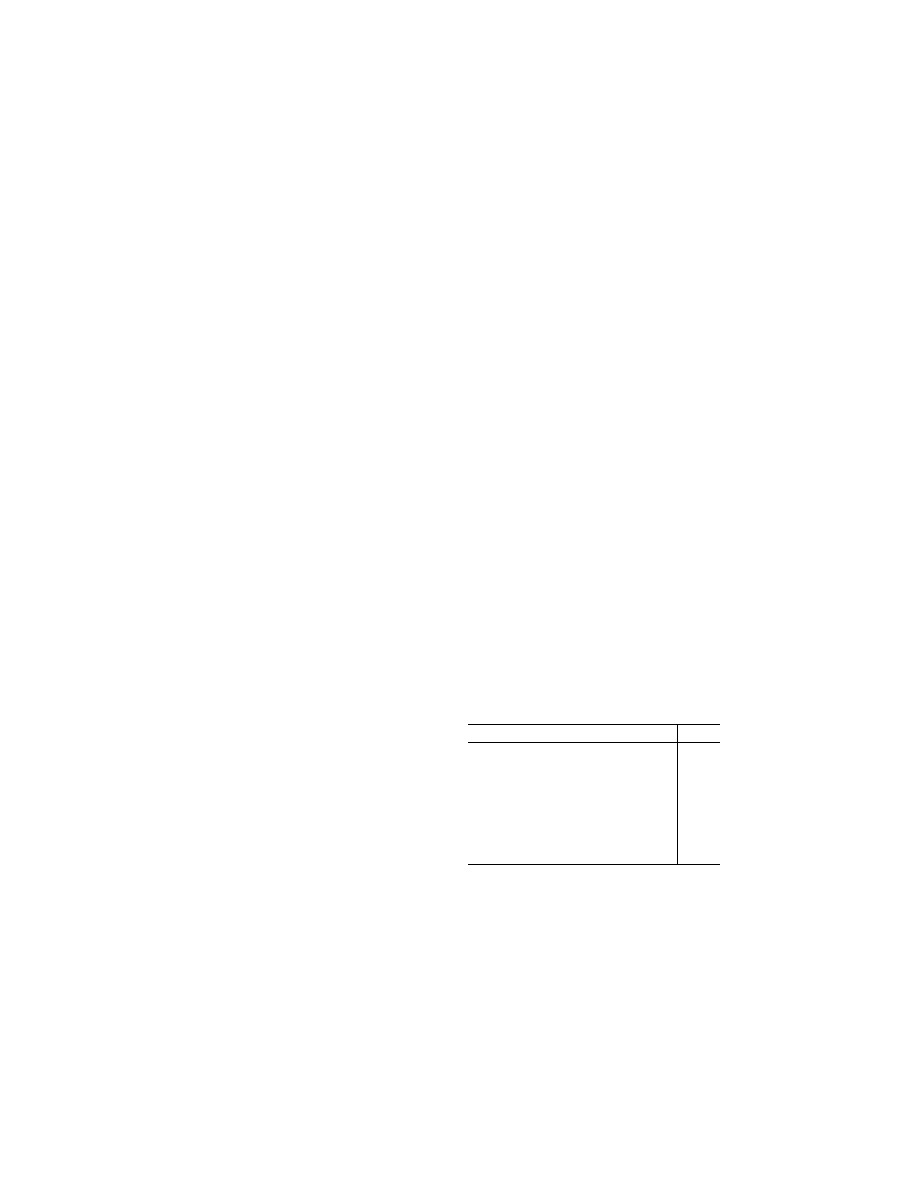
463
Federal Aviation Administration, DOT
§ 135.177
when current weather reports indicate
that thunderstorms or other poten-
tially hazardous weather conditions
that can be detected with airborne
thunderstorm detection equipment, re-
quired by paragraph (a) or (b) of this
section, may reasonably be expected
along the route to be flown, unless the
airborne thunderstorm detection equip-
ment is in satisfactory operating con-
dition.
(d) If the airborne thunderstorm de-
tection equipment becomes inoperative
en route, the aircraft must be operated
under the instructions and procedures
specified for that event in the manual
required by § 135.21.
(e) This section does not apply to air-
craft used solely within the State of
Hawaii, within the State of Alaska,
within that part of Canada west of lon-
gitude 130 degrees W, between latitude
70 degrees N, and latitude 53 degrees N,
or during any training, test, or ferry
flight.
(f) Without regard to any other provi-
sion of this part, an alternate elec-
trical power supply is not required for
airborne thunderstorm detection equip-
ment.
[Doc. No. 16097, 43 FR 46783, Oct. 10, 1978, as
amended by Amdt. 135–20, 51 FR 40710, Nov. 7,
1986; Amdt. 135–60, 61 FR 2616, Jan. 26, 1996]
§ 135.175 Airborne weather radar
equipment requirements.
(a) No person may operate a large,
transport category aircraft in pas-
senger-carrying operations unless ap-
proved airborne weather radar equip-
ment is installed in the aircraft.
(b) No person may begin a flight
under IFR or night VFR conditions
when current weather reports indicate
that thunderstorms, or other poten-
tially hazardous weather conditions
that can be detected with airborne
weather radar equipment, may reason-
ably be expected along the route to be
flown, unless the airborne weather
radar equipment required by paragraph
(a) of this section is in satisfactory op-
erating condition.
(c) If the airborne weather radar
equipment becomes inoperative en
route, the aircraft must be operated
under the instructions and procedures
specified for that event in the manual
required by § 135.21.
(d) This section does not apply to air-
craft used solely within the State of
Hawaii, within the State of Alaska,
within that part of Canada west of lon-
gitude 130 degrees W, between latitude
70 degrees N, and latitude 53 degrees N,
or during any training, test, or ferry
flight.
(e) Without regard to any other pro-
vision of this part, an alternate elec-
trical power supply is not required for
airborne weather radar equipment.
§ 135.177 Emergency equipment re-
quirements for aircraft having a
passenger seating configuration of
more than 19 passengers.
(a) No person may operate an aircraft
having a passenger seating configura-
tion, excluding any pilot seat, of more
than 19 seats unless it is equipped with
the following emergency equipment:
(1) At least one approved first-aid kit
for treatment of injuries likely to
occur in flight or in a minor accident
that must:
(i) Be readily accessible to crew-
members.
(ii) Be stored securely and kept free
from dust, moisture, and damaging
temperatures.
(iii) Contain at least the following
appropriately maintained contents in
the specified quantities:
Contents
Quantity
Adhesive bandage compresses, 1-inch .................
16
Antiseptic swabs .....................................................
20
Ammonia inhalants .................................................
10
Bandage compresses, 4-inch .................................
8
Triangular bandage compresses, 40-inch ..............
5
Arm splint, noninflatable .........................................
1
Leg splint, noninflatable ..........................................
1
Roller bandage, 4-inch ...........................................
4
Adhesive tape, 1-inch standard roll ........................
2
Bandage scissors ...................................................
1
Protective nonpermeable gloves or equivalent ......
1 pair
(2) A crash axe carried so as to be ac-
cessible to the crew but inaccessible to
passengers during normal operations.
(3) Signs that are visible to all occu-
pants to notify them when smoking is
prohibited and when safety belts must
be fastened. The signs must be con-
structed so that they can be turned on
during any movement of the aircraft
on the surface, for each takeoff or land-
ing, and at other times considered nec-
essary by the pilot in command. ‘‘No
smoking’’ signs shall be turned on
when required by § 135.127.

464
14 CFR Ch. I (1–1–24 Edition)
§ 135.178
(4) [Reserved]
(b) Each item of equipment must be
inspected regularly under inspection
periods established in the operations
specifications to ensure its condition
for continued serviceability and imme-
diate readiness to perform its intended
emergency purposes.
[Doc. No. 16097, 43 FR 46783, Oct. 10, 1978, as
amended by Amdt. 135–25, 53 FR 12362, Apr.
13, 1988; Amdt. 135–43, 57 FR 19245, May 4,
1992; Amdt. 135–44, 57 FR 42676, Sept. 15, 1992;
Amdt. 135–47, 59 FR 1781, Jan. 12, 1994; Amdt.
135–53, 59 FR 52643, Oct. 18, 1994; 59 FR 55208,
Nov. 4, 1994; Amdt. 121–281, 66 FR 19045, Apr.
12, 2001]
§ 135.178 Additional emergency equip-
ment.
No person may operate an airplane
having a passenger seating configura-
tion of more than 19 seats, unless it has
the additional emergency equipment
specified in paragraphs (a) through (l)
of this section.
(a)
Means for emergency evacuation.
Each passenger-carrying landplane
emergency exit (other than over-the-
wing) that is more than 6 feet from the
ground, with the airplane on the
ground and the landing gear extended,
must have an approved means to assist
the occupants in descending to the
ground. The assisting means for a
floor-level emergency exit must meet
the requirements of § 25.809(f)(1) of this
chapter in effect on April 30, 1972, ex-
cept that, for any airplane for which
the application for the type certificate
was filed after that date, it must meet
the requirements under which the air-
plane was type certificated. An assist-
ing means that deploys automatically
must be armed during taxiing, take-
offs, and landings; however, the Admin-
istrator may grant a deviation from
the requirement of automatic deploy-
ment if he finds that the design of the
exit makes compliance impractical, if
the assisting means automatically
erects upon deployment and, with re-
spect to required emergency exits, if an
emergency evacuation demonstration
is conducted in accordance with
§ 121.291(a) of this chapter. This para-
graph does not apply to the rear win-
dow emergency exit of Douglas DC–3
airplanes operated with fewer than 36
occupants, including crewmembers,
and fewer than five exits authorized for
passenger use.
(b)
Interior emergency exit marking.
The following must be complied with
for each passenger-carrying airplane:
(1) Each passenger emergency exit,
its means of access, and its means of
opening must be conspicuously
marked. The identity and locating of
each passenger emergency exit must be
recognizable from a distance equal to
the width of the cabin. The location of
each passenger emergency exit must be
indicated by a sign visible to occupants
approaching along the main passenger
aisle. There must be a locating sign—
(i) Above the aisle near each over-
the-wing passenger emergency exit, or
at another ceiling location if it is more
practical because of low headroom;
(ii) Next to each floor level passenger
emergency exit, except that one sign
may serve two such exits if they both
can be seen readily from that sign; and
(iii) On each bulkhead or divider that
prevents fore and aft vision along the
passenger cabin, to indicate emergency
exits beyond and obscured by it, except
that if this is not possible, the sign
may be placed at another appropriate
location.
(2) Each passenger emergency exit
marking and each locating sign must
meet the following:
(i) For an airplane for which the ap-
plication for the type certificate was
filed prior to May 1, 1972, each pas-
senger emergency exit marking and
each locating sign must be manufac-
tured to meet the requirements of
§ 25.812(b) of this chapter in effect on
April 30, 1972. On these airplanes, no
sign may continue to be used if its lu-
minescence (brightness) decreases to
below 100 microlamberts. The colors
may be reversed if it increases the
emergency illumination of the pas-
senger compartment. However, the Ad-
ministrator may authorize deviation
from the 2-inch background require-
ments if he finds that special cir-
cumstances exist that make compli-
ance impractical and that the proposed
deviation provides an equivalent level
of safety.
(ii) For an airplane for which the ap-
plication for the type certificate was
filed on or after May 1, 1972, each pas-
senger emergency exit marking and

465
Federal Aviation Administration, DOT
§ 135.178
each locating sign must be manufac-
tured to meet the interior emergency
exit marking requirements under
which the airplane was type certifi-
cated. On these airplanes, no sign may
continue to be used if its luminescence
(brightness) decreases to below 250
microlamberts.
(c)
Lighting for interior emergency exit
markings.
Each passenger-carrying air-
plane must have an emergency lighting
system, independent of the main light-
ing system; however, sources of general
cabin illumination may be common to
both the emergency and the main
lighting systems if the power supply to
the emergency lighting system is inde-
pendent of the power supply to the
main lighting system. The emergency
lighting system must—
(1) Illuminate each passenger exit
marking and locating sign;
(2) Provide enough general lighting
in the passenger cabin so that the aver-
age illumination when measured at 40-
inch intervals at seat armrest height,
on the centerline of the main passenger
aisle, is at least 0.05 foot-candles; and
(3) For airplanes type certificated
after January 1, 1958, include floor
proximity emergency escape path
marking which meets the requirements
of § 25.812(e) of this chapter in effect on
November 26, 1984.
(d)
Emergency light operation.
Except
for lights forming part of emergency
lighting subsystems provided in com-
pliance with § 25.812(h) of this chapter
(as prescribed in paragraph (h) of this
section) that serve no more than one
assist means, are independent of the
airplane’s main emergency lighting
systems, and are automatically acti-
vated when the assist means is de-
ployed, each light required by para-
graphs (c) and (h) of this section must:
(1) Be operable manually both from
the flightcrew station and from a point
in the passenger compartment that is
readily accessible to a normal flight
attendant seat;
(2) Have a means to prevent inad-
vertent operation of the manual con-
trols;
(3) When armed or turned on at ei-
ther station, remain lighted or become
lighted upon interruption of the air-
plane’s normal electric power;
(4) Be armed or turned on during tax-
iing, takeoff, and landing. In showing
compliance with this paragraph, a
transverse vertical separation of the
fuselage need not be considered;
(5) Provide the required level of illu-
mination for at least 10 minutes at the
critical ambient conditions after emer-
gency landing; and
(6) Have a cockpit control device that
has an ‘‘on,’’ ‘‘off,’’ and ‘‘armed’’ posi-
tion.
(e)
Emergency exit operating handles.
(1) For a passenger-carrying airplane
for which the application for the type
certificate was filed prior to May 1,
1972, the location of each passenger
emergency exit operating handle, and
instructions for opening the exit, must
be shown by a marking on or near the
exit that is readable from a distance of
30 inches. In addition, for each Type I
and Type II emergency exit with a
locking mechanism released by rotary
motion of the handle, the instructions
for opening must be shown by—
(i) A red arrow with a shaft at least
three-fourths inch wide and a head
twice the width of the shaft, extending
along at least 70
°
of arc at a radius ap-
proximately equal to three-fourths of
the handle length; and
(ii) The word ‘‘open’’ in red letters 1
inch high placed horizontally near the
head of the arrow.
(2) For a passenger-carrying airplane
for which the application for the type
certificate was filed on or after May 1,
1972, the location of each passenger
emergency exit operating handle and
instructions for opening the exit must
be shown in accordance with the re-
quirements under which the airplane
was type certificated. On these air-
planes, no operating handle or oper-
ating handle cover may continue to be
used if its luminescence (brightness)
decreases to below 100 microlamberts.
(f)
Emergency exit access.
Access to
emergency exits must be provided as
follows for each passenger-carrying air-
plane:
(1) Each passageway between indi-
vidual passenger areas, or leading to a
Type I or Type II emergency exit, must
be unobstructed and at least 20 inches
wide.
(2) There must be enough space next
to each Type I or Type II emergency

466
14 CFR Ch. I (1–1–24 Edition)
§ 135.178
exit to allow a crewmember to assist in
the evacuation of passengers without
reducing the unobstructed width of the
passageway below that required in
paragraph (f)(1) of this section; how-
ever, the Administrator may authorize
deviation from this requirement for an
airplane certificated under the provi-
sions of part 4b of the Civil Air Regula-
tions in effect before December 20, 1951,
if he finds that special circumstances
exist that provide an equivalent level
of safety.
(3) There must be access from the
main aisle to each Type III and Type
IV exit. The access from the aisle to
these exits must not be obstructed by
seats, berths, or other protrusions in a
manner that would reduce the effec-
tiveness of the exit. In addition, for a
transport category airplane type cer-
tificated after January 1, 1958, there
must be placards installed in accord-
ance with § 25.813(c)(3) of this chapter
for each Type III exit after December 3,
1992.
(4) If it is necessary to pass through
a passageway between passenger com-
partments to reach any required emer-
gency exit from any seat in the pas-
senger cabin, the passageway must not
be obstructed. Curtains may, however,
be used if they allow free entry
through the passageway.
(5) No door may be installed in any
partition between passenger compart-
ments.
(6) If it is necessary to pass through
a doorway separating the passenger
cabin from other areas to reach a re-
quired emergency exit from any pas-
senger seat, the door must have a
means to latch it in the open position,
and the door must be latched open dur-
ing each takeoff and landing. The
latching means must be able to with-
stand the loads imposed upon it when
the door is subjected to the ultimate
inertia forces, relative to the sur-
rounding structure, listed in § 25.561(b)
of this chapter.
(g)
Exterior exit markings.
Each pas-
senger emergency exit and the means
of opening that exit from the outside
must be marked on the outside of the
airplane. There must be a 2-inch col-
ored band outlining each passenger
emergency exit on the side of the fuse-
lage. Each outside marking, including
the band, must be readily distinguish-
able from the surrounding fuselage
area by contrast in color. The mark-
ings must comply with the following:
(1) If the reflectance of the darker
color is 15 percent or less, the reflec-
tance of the lighter color must be at
least 45 percent.
(2) If the reflectance of the darker
color is greater than 15 percent, at
least a 30 percent difference between
its reflectance and the reflectance of
the lighter color must be provided.
(3) Exits that are not in the side of
the fuselage must have the external
means of opening and applicable in-
structions marked conspicuously in red
or, if red is inconspicuous against the
background color, in bright chrome
yellow and, when the opening means
for such an exit is located on only one
side of the fuselage, a conspicuous
marking to that effect must be pro-
vided on the other side. ‘‘Reflectance’’
is the ratio of the luminous flux re-
flected by a body to the luminous flux
it receives.
(h)
Exterior emergency lighting and es-
cape route.
(1) Each passenger-carrying
airplane must be equipped with exte-
rior lighting that meets the following
requirements:
(i) For an airplane for which the ap-
plication for the type certificate was
filed prior to May 1, 1972, the require-
ments of § 25.812 (f) and (g) of this chap-
ter in effect on April 30, 1972.
(ii) For an airplane for which the ap-
plication for the type certificate was
filed on or after May 1, 1972, the exte-
rior emergency lighting requirements
under which the airplane was type cer-
tificated.
(2) Each passenger-carrying airplane
must be equipped with a slip-resistant
escape route that meets the following
requirements:
(i) For an airplane for which the ap-
plication for the type certificate was
filed prior to May 1, 1972, the require-
ments of § 25.803(e) of this chapter in ef-
fect on April 30, 1972.
(ii) For an airplane for which the ap-
plication for the type certificate was
filed on or after May 1, 1972, the slip-re-
sistant escape route requirements
under which the airplane was type cer-
tificated.

467
Federal Aviation Administration, DOT
§ 135.179
(i)
Floor level exits.
Each floor level
door or exit in the side of the fuselage
(other than those leading into a cargo
or baggage compartment that is not
accessible from the passenger cabin)
that is 44 or more inches high and 20 or
more inches wide, but not wider than
46 inches, each passenger ventral exit
(except the ventral exits on Martin 404
and Convair 240 airplanes), and each
tail cone exit, must meet the require-
ments of this section for floor level
emergency exits. However, the Admin-
istrator may grant a deviation from
this paragraph if he finds that cir-
cumstances make full compliance im-
practical and that an acceptable level
of safety has been achieved.
(j)
Additional emergency exits.
Ap-
proved emergency exits in the pas-
senger compartments that are in ex-
cess of the minimum number of re-
quired emergency exits must meet all
of the applicable provisions of this sec-
tion, except paragraphs (f) (1), (2), and
(3) of this section, and must be readily
accessible.
(k) On each large passenger-carrying
turbojet-powered airplane, each ven-
tral exit and tailcone exit must be—
(1) Designed and constructed so that
it cannot be opened during flight; and
(2) Marked with a placard readable
from a distance of 30 inches and in-
stalled at a conspicuous location near
the means of opening the exit, stating
that the exit has been designed and
constructed so that it cannot be opened
during flight.
(l)
Portable lights.
No person may op-
erate a passenger-carrying airplane un-
less it is equipped with flashlight stow-
age provisions accessible from each
flight attendant seat.
[Doc. No. 26530, 57 FR 19245, May 4, 1992; 57
FR 29120, June 30, 1992, as amended at 57 FR
34682, Aug. 6, 1992]
§ 135.179 Inoperable instruments and
equipment.
(a) No person may take off an air-
craft with inoperable instruments or
equipment installed unless the fol-
lowing conditions are met:
(1) An approved Minimum Equipment
List exists for that aircraft.
(2) The responsible Flight Standards
office has issued the certificate holder
operations specifications authorizing
operations in accordance with an ap-
proved Minimum Equipment List. The
flight crew shall have direct access at
all times prior to flight to all of the in-
formation contained in the approved
Minimum Equipment List through
printed or other means approved by the
Administrator in the certificate hold-
ers operations specifications. An ap-
proved Minimum Equipment List, as
authorized by the operations specifica-
tions, constitutes an approved change
to the type design without requiring
recertification.
(3) The approved Minimum Equip-
ment List must:
(i) Be prepared in accordance with
the limitations specified in paragraph
(b) of this section.
(ii) Provide for the operation of the
aircraft with certain instruments and
equipment in an inoperable condition.
(4) Records identifying the inoperable
instruments and equipment and the in-
formation required by (a)(3)(ii) of this
section must be available to the pilot.
(5) The aircraft is operated under all
applicable conditions and limitations
contained in the Minimum Equipment
List and the operations specifications
authorizing use of the Minimum Equip-
ment List.
(b) The following instruments and
equipment may not be included in the
Minimum Equipment List:
(1) Instruments and equipment that
are either specifically or otherwise re-
quired by the airworthiness require-
ments under which the airplane is type
certificated and which are essential for
safe operations under all operating
conditions.
(2) Instruments and equipment re-
quired by an airworthiness directive to
be in operable condition unless the air-
worthiness directive provides other-
wise.
(3) Instruments and equipment re-
quired for specific operations by this
part.
(c) Notwithstanding paragraphs (b)(1)
and (b)(3) of this section, an aircraft
with inoperable instruments or equip-
ment may be operated under a special

468
14 CFR Ch. I (1–1–24 Edition)
§ 135.180
flight permit under §§ 21.197 and 21.199
of this chapter.
[Doc. No. 25780, 56 FR 12311, Mar. 22, 1991; 56
FR 14920, Apr. 8, 1991, as amended by Amdt.
135–60, 61 FR 2616, Jan. 26, 1996; Amdt. 135–91,
68 FR 54586, Sept. 17, 2003; Docket FAA–2018–
0119, Amdt. 135–139, 83 FR 9175, Mar. 5, 2018]
§ 135.180 Traffic Alert and Collision
Avoidance System.
(a) Unless otherwise authorized by
the Administrator, after December 31,
1995, no person may operate a turbine
powered airplane that has a passenger
seat configuration, excluding any pilot
seat, of 10 to 30 seats unless it is
equipped with an approved traffic alert
and collision avoidance system. If a
TCAS II system is installed, it must be
capable of coordinating with TCAS
units that meet TSO C–119.
(b) The airplane flight manual re-
quired by § 135.21 of this part shall con-
tain the following information on the
TCAS I system required by this sec-
tion:
(1) Appropriate procedures for—
(i) The use of the equipment; and
(ii) Proper flightcrew action with re-
spect to the equipment operation.
(2) An outline of all input sources
that must be operating for the TCAS to
function properly.
[Doc. No. 25355, 54 FR 951, Jan. 10, 1989, as
amended by Amdt. 135–54, 59 FR 67587, Dec.
29, 1994]
§ 135.181 Performance requirements:
Aircraft operated over-the-top or in
IFR conditions.
(a) Except as provided in paragraphs
(b) and (c) of this section, no person
may—
(1) Operate a single-engine aircraft
carrying passengers over-the-top; or
(2) Operate a multiengine aircraft
carrying passengers over-the-top or in
IFR conditions at a weight that will
not allow it to climb, with the critical
engine inoperative, at least 50 feet a
minute when operating at the MEAs of
the route to be flown or 5,000 feet MSL,
whichever is higher.
(b) Notwithstanding the restrictions
in paragraph (a)(2) of this section, mul-
tiengine helicopters carrying pas-
sengers offshore may conduct such op-
erations in over-the-top or in IFR con-
ditions at a weight that will allow the
helicopter to climb at least 50 feet per
minute with the critical engine inoper-
ative when operating at the MEA of
the route to be flown or 1,500 feet MSL,
whichever is higher.
(c) Without regard to paragraph (a) of
this section, if the latest weather re-
ports or forecasts, or any combination
of them, indicate that the weather
along the planned route (including
takeoff and landing) allows flight
under VFR under the ceiling (if a ceil-
ing exists) and that the weather is fore-
cast to remain so until at least 1 hour
after the estimated time of arrival at
the destination, a person may operate
an aircraft over-the-top.
(d) Without regard to paragraph (a)
of this section, a person may operate
an aircraft over-the-top under condi-
tions allowing—
(1) For multiengine aircraft, descent
or continuance of the flight under VFR
if its critical engine fails; or
(2) For single-engine aircraft, descent
under VFR if its engine fails.
[Doc. No. 16097, 43 FR 46783, Oct. 10, 1978, as
amended by Amdt. 135–20, 51 FR 40710, Nov. 7,
1986; Amdt. 135–70, 62 FR 42374, Aug. 6, 1997]
§ 135.183 Performance requirements:
Land aircraft operated over water.
No person may operate a land air-
craft carrying passengers over water
unless—
(a) It is operated at an altitude that
allows it to reach land in the case of
engine failure;
(b) It is necessary for takeoff or land-
ing;
(c) It is a multiengine aircraft oper-
ated at a weight that will allow it to
climb, with the critical engine inoper-
ative, at least 50 feet a minute, at an
altitude of 1,000 feet above the surface;
or
(d) It is a helicopter equipped with
helicopter flotation devices.
§ 135.185 Empty weight and center of
gravity: Currency requirement.
(a) No person may operate a multien-
gine aircraft unless the current empty
weight and center of gravity are cal-
culated from values established by ac-
tual weighing of the aircraft within the
preceding 36 calendar months.
(b) Paragraph (a) of this section does
not apply to—

469
Federal Aviation Administration, DOT
§ 135.211
(1) Aircraft issued an original air-
worthiness certificate within the pre-
ceding 36 calendar months; and
(2) Aircraft operated under a weight
and balance system approved in the op-
erations specifications of the certifi-
cate holder.
Subpart D—VFR/IFR Operating
Limitations and Weather Re-
quirements
§ 135.201 Applicability.
This subpart prescribes the operating
limitations for VFR/IFR flight oper-
ations and associated weather require-
ments for operations under this part.
§ 135.203 VFR: Minimum altitudes.
Except when necessary for takeoff
and landing, no person may operate
under VFR—
(a) An airplane—
(1) During the day, below 500 feet
above the surface or less than 500 feet
horizontally from any obstacle; or
(2) At night, at an altitude less than
1,000 feet above the highest obstacle
within a horizontal distance of 5 miles
from the course intended to be flown
or, in designated mountainous terrain,
less than 2,000 feet above the highest
obstacle within a horizontal distance of
5 miles from the course intended to be
flown; or
(b) A helicopter over a congested area
at an altitude less than 300 feet above
the surface.
§ 135.205 VFR: Visibility requirements.
(a) No person may operate an air-
plane under VFR in uncontrolled air-
space when the ceiling is less than 1,000
feet unless flight visibility is at least 2
miles.
(b) No person may operate a heli-
copter under VFR in Class G airspace
at an altitude of 1,200 feet or less above
the surface or within the lateral bound-
aries of the surface areas of Class B,
Class C, Class D, or Class E airspace
designated for an airport unless the
visibility is at least—
(1) During the day—
1
⁄
2
mile; or
(2) At night—1 mile.
[Doc. No. 16097, 43 FR 46783, Oct. 10, 1978, as
amended by Amdt. 135–41, 56 FR 65663, Dec.
17, 1991]
§ 135.207 VFR: Helicopter surface ref-
erence requirements.
No person may operate a helicopter
under VFR unless that person has vis-
ual surface reference or, at night, vis-
ual surface light reference, sufficient
to safely control the helicopter.
§ 135.209 VFR: Fuel supply.
(a) No person may begin a flight op-
eration in an airplane under VFR un-
less, considering wind and forecast
weather conditions, it has enough fuel
to fly to the first point of intended
landing and, assuming normal cruising
fuel consumption—
(1) During the day, to fly after that
for at least 30 minutes; or
(2) At night, to fly after that for at
least 45 minutes.
(b) No person may begin a flight op-
eration in a helicopter under VFR un-
less, considering wind and forecast
weather conditions, it has enough fuel
to fly to the first point of intended
landing and, assuming normal cruising
fuel consumption, to fly after that for
at least 20 minutes.
§ 135.211 VFR: Over-the-top carrying
passengers: Operating limitations.
Subject to any additional limitations
in § 135.181, no person may operate an
aircraft under VFR over-the-top car-
rying passengers, unless—
(a) Weather reports or forecasts, or
any combination of them, indicate that
the weather at the intended point of
termination of over-the-top flight—
(1) Allows descent to beneath the
ceiling under VFR and is forecast to re-
main so until at least 1 hour after the
estimated time of arrival at that point;
or
(2) Allows an IFR approach and land-
ing with flight clear of the clouds until
reaching the prescribed initial ap-
proach altitude over the final approach
facility, unless the approach is made
with the use of radar under § 91.175(i) of
this chapter; or
(b) It is operated under conditions al-
lowing—
(1) For multiengine aircraft, descent
or continuation of the flight under
VFR if its critical engine fails; or

470
14 CFR Ch. I (1–1–24 Edition)
§ 135.213
(2) For single-engine aircraft, descent
under VFR if its engine fails.
[Doc. No. 16097, 43 FR 46783, Oct. 10, 1978, as
amended by Amdt. 135–32, 54 FR 34332, Aug.
18, 1989; 73 FR 20164, Apr. 15, 2008]
§ 135.213 Weather reports and fore-
casts.
(a) Whenever a person operating an
aircraft under this part is required to
use a weather report or forecast, that
person shall use that of the U.S. Na-
tional Weather Service, a source ap-
proved by the U.S. National Weather
Service, or a source approved by the
Administrator. However, for operations
under VFR, the pilot in command may,
if such a report is not available, use
weather information based on that pi-
lot’s own observations or on those of
other persons competent to supply ap-
propriate observations.
(b) For the purposes of paragraph (a)
of this section, weather observations
made and furnished to pilots to con-
duct IFR operations at an airport must
be taken at the airport where those
IFR operations are conducted, unless
the Administrator issues operations
specifications allowing the use of
weather observations taken at a loca-
tion not at the airport where the IFR
operations are conducted. The Admin-
istrator issues such operations speci-
fications when, after investigation by
the U.S. National Weather Service and
the responsible Flight Standards office,
it is found that the standards of safety
for that operation would allow the de-
viation from this paragraph for a par-
ticular operation for which an air car-
rier operating certificate or operating
certificate has been issued.
[Doc. No. 16097, 43 FR 46783, Oct. 10, 1978, as
amended by Amdt. 135–60, 61 FR 2616, Jan. 26,
1996; Docket FAA–2018–0119, Amdt. 135–139, 83
FR 9175, Mar. 5, 2018]
§ 135.215 IFR: Operating limitations.
(a) Except as provided in paragraphs
(b), (c) and (d) of this section, no person
may operate an aircraft under IFR out-
side of controlled airspace or at any
airport that does not have an approved
standard instrument approach proce-
dure.
(b) The Administrator may issue op-
erations specifications to the certifi-
cate holder to allow it to operate under
IFR over routes outside controlled air-
space if—
(1) The certificate holder shows the
Administrator that the flight crew is
able to navigate, without visual ref-
erence to the ground, over an intended
track without deviating more than 5
degrees or 5 miles, whichever is less,
from that track; and
(2) The Administrator determines
that the proposed operations can be
conducted safely.
(c) A person may operate an aircraft
under IFR outside of controlled air-
space if the certificate holder has been
approved for the operations and that
operation is necessary to—
(1) Conduct an instrument approach
to an airport for which there is in use
a current approved standard or special
instrument approach procedure; or
(2) Climb into controlled airspace
during an approved missed approach
procedure; or
(3) Make an IFR departure from an
airport having an approved instrument
approach procedure.
(d) The Administrator may issue op-
erations specifications to the certifi-
cate holder to allow it to depart at an
airport that does not have an approved
standard instrument approach proce-
dure when the Administrator deter-
mines that it is necessary to make an
IFR departure from that airport and
that the proposed operations can be
conducted safely. The approval to oper-
ate at that airport does not include an
approval to make an IFR approach to
that airport.
§ 135.217 IFR: Takeoff limitations.
No person may takeoff an aircraft
under IFR from an airport where
weather conditions are at or above
takeoff minimums but are below au-
thorized IFR landing minimums unless
there is an alternate airport within 1
hour’s flying time (at normal cruising
speed, in still air) of the airport of de-
parture.
§ 135.219 IFR: Destination airport
weather minimums.
No person may take off an aircraft
under IFR or begin an IFR or over-the-
top operation unless the latest weather
reports or forecasts, or any combina-
tion of them, indicate that weather

471
Federal Aviation Administration, DOT
§ 135.225
conditions at the estimated time of ar-
rival at the next airport of intended
landing will be at or above authorized
IFR landing minimums.
§ 135.221 IFR: Alternate airport weath-
er minimums.
(a)
Aircraft other than rotorcraft.
No
person may designate an alternate air-
port unless the weather reports or fore-
casts, or any combination of them, in-
dicate that the weather conditions will
be at or above authorized alternate air-
port landing minimums for that air-
port at the estimated time of arrival.
(b)
Rotorcraft.
Unless otherwise au-
thorized by the Administrator, no per-
son may include an alternate airport in
an IFR flight plan unless appropriate
weather reports or weather forecasts,
or a combination of them, indicate
that, at the estimated time of arrival
at the alternate airport, the ceiling
and visibility at that airport will be at
or above the following weather mini-
mums—
(1) If, for the alternate airport, an in-
strument approach procedure has been
published in part 97 of this chapter or
a special instrument approach proce-
dure has been issued by the FAA to the
certificate holder, the ceiling is 200 feet
above the minimum for the approach
to be flown, and visibility is at least 1
statute mile but never less than the
minimum visibility for the approach to
be flown.
(2) If, for the alternate airport, no in-
strument approach procedure has been
published in part 97 of this chapter and
no special instrument approach proce-
dure has been issued by the FAA to the
certificate holder, the ceiling and visi-
bility minimums are those allowing de-
scent from the minimum enroute alti-
tude (MEA), approach, and landing
under basic VFR.
[Doc. No. FAA–2010–0982, 79 FR 9974, Feb. 21,
2014]
§ 135.223 IFR: Alternate airport re-
quirements.
(a) Except as provided in paragraph
(b) of this section, no person may oper-
ate an aircraft in IFR conditions unless
it carries enough fuel (considering
weather reports or forecasts or any
combination of them) to—
(1) Complete the flight to the first
airport of intended landing;
(2) Fly from that airport to the alter-
nate airport; and
(3) Fly after that for 45 minutes at
normal cruising speed or, for heli-
copters, fly after that for 30 minutes at
normal cruising speed.
(b) Paragraph (a)(2) of this section
does not apply if part 97 of this chapter
prescribes a standard instrument ap-
proach procedure for the first airport
of intended landing and, for at least
one hour before and after the estimated
time of arrival, the appropriate weath-
er reports or forecasts, or any combina-
tion of them, indicate that—
(1) The ceiling will be at least 1,500
feet above the lowest circling approach
MDA; or
(2) If a circling instrument approach
is not authorized for the airport, the
ceiling will be at least 1,500 feet above
the lowest published minimum or 2,000
feet above the airport elevation, which-
ever is higher; and
(3) Visibility for that airport is fore-
cast to be at least three miles, or two
miles more than the lowest applicable
visibility minimums, whichever is the
greater, for the instrument approach
procedure to be used at the destination
airport.
[Doc. No. 16097, 43 FR 46783, Oct. 10, 1978, as
amended by Amdt. 135–20, 51 FR 40710, Nov. 7,
1986]
§ 135.225 IFR: Takeoff, approach and
landing minimums.
(a) Except to the extent permitted by
paragraphs (b) and (j) of this section,
no pilot may begin an instrument ap-
proach procedure to an airport unless—
(1) That airport has a weather report-
ing facility operated by the U.S. Na-
tional Weather Service, a source ap-
proved by U.S. National Weather Serv-
ice, or a source approved by the Admin-
istrator; and
(2) The latest weather report issued
by that weather reporting facility indi-
cates that weather conditions are at or
above the authorized IFR landing mini-
mums for that airport.
(b) A pilot conducting an eligible on-
demand operation may begin and con-
duct an instrument approach procedure
to an airport that does not have a
weather reporting facility operated by

472
14 CFR Ch. I (1–1–24 Edition)
§ 135.225
the U.S. National Weather Service, a
source approved by the U.S. National
Weather Service, or a source approved
by the Administrator if—
(1) The alternate airport has a weath-
er reporting facility operated by the
U.S. National Weather Service, a
source approved by the U.S. National
Weather Service, or a source approved
by the Administrator; and
(2) The latest weather report issued
by the weather reporting facility in-
cludes a current local altimeter setting
for the destination airport. If no local
altimeter setting for the destination
airport is available, the pilot may use
the current altimeter setting provided
by the facility designated on the ap-
proach chart for the destination air-
port.
(c) Except as provided in paragraph
(j) of this section, no pilot may begin
the final approach segment of an in-
strument approach procedure to an air-
port unless the latest weather reported
by the facility described in paragraph
(a)(1) of this section indicates that
weather conditions are at or above the
authorized IFR landing minimums for
that procedure.
(d) Except as provided in paragraph
(j) of this section, a pilot who has
begun the final approach segment of an
instrument approach to an airport
under paragraph (c) of this section, and
receives a later weather report indi-
cating that conditions have worsened
to below the minimum requirements,
may continue the approach only if the
following conditions are met—
(1) The later weather report is re-
ceived when the aircraft is in one of
the following approach phases:
(i) The aircraft is on an ILS final ap-
proach and has passed the final ap-
proach fix;
(ii) The aircraft is on an ASR or PAR
final approach and has been turned
over to the final approach controller;
or
(iii) The aircraft is on a non-preci-
sion final approach and the aircraft—
(A) Has passed the appropriate facil-
ity or final approach fix; or
(B) Where a final approach fix is not
specified, has completed the procedure
turn and is established inbound toward
the airport on the final approach
course within the distance prescribed
in the procedure; and
(2) The pilot in command finds, on
reaching the authorized MDA or DA/
DH, that the actual weather conditions
are at or above the minimums pre-
scribed for the procedure being used.
(e) The MDA or DA/DH and visibility
landing minimums prescribed in part 97
of this chapter or in the operator’s op-
erations specifications are increased by
100 feet and
1
⁄
2
mile respectively, but
not to exceed the ceiling and visibility
minimums for that airport when used
as an alternate airport, for each pilot
in command of a turbine-powered air-
plane who has not served at least 100
hours as pilot in command in that type
of airplane.
(f) Each pilot making an IFR takeoff
or approach and landing at a military
or foreign airport shall comply with
applicable instrument approach proce-
dures and weather minimums pre-
scribed by the authority having juris-
diction over that airport. In addition,
unless authorized by the certificate
holder’s operations specifications, no
pilot may, at that airport—
(1) Take off under IFR when the visi-
bility is less than 1 mile; or
(2) Make an instrument approach
when the visibility is less than
1
⁄
2
mile.
(g) If takeoff minimums are specified
in part 97 of this chapter for the take-
off airport, no pilot may take off an
aircraft under IFR when the weather
conditions reported by the facility de-
scribed in paragraph (a)(1) of this sec-
tion are less than the takeoff mini-
mums specified for the takeoff airport
in part 97 or in the certificate holder’s
operations specifications.
(h) Except as provided in paragraph
(i) of this section, if takeoff minimums
are not prescribed in part 97 of this
chapter for the takeoff airport, no pilot
may takeoff an aircraft under IFR
when the weather conditions reported
by the facility described in paragraph
(a)(1) of this section are less than that
prescribed in part 91 of this chapter or
in the certificate holder’s operations
specifications.

473
Federal Aviation Administration, DOT
§ 135.227
(i) At airports where straight-in in-
strument approach procedures are au-
thorized, a pilot may takeoff an air-
craft under IFR when the weather con-
ditions reported by the facility de-
scribed in paragraph (a)(1) of this sec-
tion are equal to or better than the
lowest straight-in landing minimums,
unless otherwise restricted, if—
(1) The wind direction and velocity at
the time of takeoff are such that a
straight-in instrument approach can be
made to the runway served by the in-
strument approach;
(2) The associated ground facilities
upon which the landing minimums are
predicated and the related airborne
equipment are in normal operation;
and
(3) The certificate holder has been
approved for such operations.
(j) A pilot may begin an instrument
approach procedure, or continue an ap-
proach, at an airport when the visi-
bility is reported to be less than the
visibility minimums prescribed for
that procedure if the pilot uses an op-
erable EFVS in accordance with § 91.176
of this chapter and the certificate hold-
er’s operations specifications for EFVS
operations.
[Doc. No. 16097, 43 FR 46783, Oct. 10, 1978, as
amended by Amdt. 135–91, 68 FR 54586, Sept.
17, 2003; Amdt. 135–93, 69 FR 1641, Jan. 9, 2004;
Amdt. 135–110, 72 FR 31685, June 7, 2007;
Amdt. 135–126, 77 FR 1632, Jan. 11, 2012; Dock-
et FAA–2013–0485, Amdt. 135–135, 81 FR 90177,
Dec. 13, 2016]
§ 135.227 Icing conditions: Operating
limitations.
(a) No pilot may take off an aircraft
that has frost, ice, or snow adhering to
any rotor blade, propeller, windshield,
stabilizing or control surface; to a pow-
erplant installation; or to an airspeed,
altimeter, rate of climb, flight attitude
instrument system, or wing, except
that takeoffs may be made with frost
under the wing in the area of the fuel
tanks if authorized by the FAA.
(b) No certificate holder may author-
ize an airplane to take off and no pilot
may take off an airplane any time con-
ditions are such that frost, ice, or snow
may reasonably be expected to adhere
to the airplane unless the pilot has
completed all applicable training as re-
quired by § 135.341 and unless one of the
following requirements is met:
(1) A pretakeoff contamination
check, that has been established by the
certificate holder and approved by the
Administrator for the specific airplane
type, has been completed within 5 min-
utes prior to beginning takeoff. A pre-
takeoff contamination check is a check
to make sure the wings and control
surfaces are free of frost, ice, or snow.
(2) The certificate holder has an ap-
proved alternative procedure and under
that procedure the airplane is deter-
mined to be free of frost, ice, or snow.
(3) The certificate holder has an ap-
proved deicing/anti-icing program that
complies with § 121.629(c) of this chap-
ter and the takeoff complies with that
program.
(c) No pilot may fly under IFR into
known or forecast light or moderate
icing conditions or under VFR into
known light or moderate icing condi-
tions, unless—
(1) The aircraft has functioning deic-
ing or anti-icing equipment protecting
each rotor blade, propeller, windshield,
wing, stabilizing or control surface,
and each airspeed, altimeter, rate of
climb, or flight attitude instrument
system;
(2) The airplane has ice protection
provisions that meet section 34 of ap-
pendix A of this part; or
(3) The airplane meets transport cat-
egory airplane type certification provi-
sions, including the requirements for
certification for flight in icing condi-
tions.
(d) No pilot may fly a helicopter
under IFR into known or forecast icing
conditions or under VFR into known
icing conditions unless it has been type
certificated and appropriately equipped
for operations in icing conditions.
(e) Except for an airplane that has
ice protection provisions that meet
section 34 of appendix A, or those for
transport category airplane type cer-
tification, no pilot may fly an aircraft
into known or forecast severe icing
conditions.
(f) If current weather reports and
briefing information relied upon by the
pilot in command indicate that the
forecast icing condition that would
otherwise prohibit the flight will not

474
14 CFR Ch. I (1–1–24 Edition)
§ 135.229
be encountered during the flight be-
cause of changed weather conditions
since the forecast, the restrictions in
paragraphs (c), (d), and (e) of this sec-
tion based on forecast conditions do
not apply.
[Doc. No. 16097, 43 FR 46783, Oct. 10, 1978, as
amended by Amdt. 133–20, 51 FR 40710, Nov. 7,
1986; Amdt. 135–46, 58 FR 69629, Dec. 30, 1993;
Amdt. 135–60, 61 FR 2616, Jan. 26, 1996; Amdt.
135–119, 74 FR 62696, Dec. 1, 2009]
§ 135.229 Airport requirements.
(a) No certificate holder may use any
airport unless it is adequate for the
proposed operation, considering such
items as size, surface, obstructions,
and lighting.
(b) No pilot of an aircraft carrying
passengers at night may takeoff from,
or land on, an airport unless—
(1) That pilot has determined the
wind direction from an illuminated
wind direction indicator or local
ground communications or, in the case
of takeoff, that pilot’s personal obser-
vations; and
(2) The limits of the area to be used
for landing or takeoff are clearly
shown—
(i) For airplanes, by boundary or run-
way marker lights;
(ii) For helicopters, by boundary or
runway marker lights or reflective ma-
terial.
(c) For the purpose of paragraph (b)
of this section, if the area to be used
for takeoff or landing is marked by
flare pots or lanterns, their use must
be approved by the Administrator.
Subpart E—Flight Crewmember
Requirements
§ 135.241 Applicability.
Except as provided in § 135.3, this sub-
part prescribes the flight crewmember
requirements for operations under this
part.
[Doc. No. 16097, 43 FR 46783, Oct. 10, 1978, as
amended by Amdt. 121–250, 60 FR 65950, Dec.
20, 1995]
§ 135.243 Pilot in command qualifica-
tions.
(a) No certificate holder may use a
person, nor may any person serve, as
pilot in command in passenger-car-
rying operations—
(1) Of a turbojet airplane, of an air-
plane having a passenger-seat configu-
ration, excluding each crewmember
seat, of 10 seats or more, or of a multi-
engine airplane in a commuter oper-
ation as defined in part 119 of this
chapter, unless that person holds an
airline transport pilot certificate with
appropriate category and class ratings
and, if required, an appropriate type
rating for that airplane.
(2) Of a helicopter in a scheduled
interstate air transportation operation
by an air carrier within the 48 contig-
uous states unless that person holds an
airline transport pilot certificate, ap-
propriate type ratings, and an instru-
ment rating.
(b) Except as provided in paragraph
(a) of this section, no certificate holder
may use a person, nor may any person
serve, as pilot in command of an air-
craft under VFR unless that person—
(1) Holds at least a commercial pilot
certificate with appropriate category
and class ratings and, if required, an
appropriate type rating for that air-
craft; and
(2) Has had at least 500 hours time as
a pilot, including at least 100 hours of
cross-country flight time, at least 25
hours of which were at night; and
(3) For an airplane, holds an instru-
ment rating or an airline transport
pilot certificate with an airplane cat-
egory rating; or
(4) For helicopter operations con-
ducted VFR over-the-top, holds a heli-
copter instrument rating, or an airline
transport pilot certificate with a cat-
egory and class rating for that aircraft,
not limited to VFR.
(c) Except as provided in paragraph
(a) of this section, no certificate holder
may use a person, nor may any person
serve, as pilot in command of an air-
craft under IFR unless that person—
(1) Holds at least a commercial pilot
certificate with appropriate category
and class ratings and, if required, an
appropriate type rating for that air-
craft; and
(2) Has had at least 1,200 hours of
flight time as a pilot, including 500
hours of cross country flight time, 100
hours of night flight time, and 75 hours
of actual or simulated instrument time

475
Federal Aviation Administration, DOT
§ 135.244
at least 50 hours of which were in ac-
tual flight; and
(3) For an airplane, holds an instru-
ment rating or an airline transport
pilot certificate with an airplane cat-
egory rating; or
(4) For a helicopter, holds a heli-
copter instrument rating, or an airline
transport pilot certificate with a cat-
egory and class rating for that aircraft,
not limited to VFR.
(d) Paragraph (b)(3) of this section
does not apply when—
(1) The aircraft used is a single recip-
rocating-engine-powered airplane;
(2) The certificate holder does not
conduct any operation pursuant to a
published flight schedule which speci-
fies five or more round trips a week be-
tween two or more points and places
between which the round trips are per-
formed, and does not transport mail by
air under a contract or contracts with
the United States Postal Service hav-
ing total amount estimated at the be-
ginning of any semiannual reporting
period (January 1–June 30; July 1–De-
cember 31) to be in excess of $20,000
over the 12 months commencing with
the beginning of the reporting period;
(3) The area, as specified in the cer-
tificate holder’s operations specifica-
tions, is an isolated area, as deter-
mined by the Flight Standards office, if
it is shown that—
(i) The primary means of navigation
in the area is by pilotage, since radio
navigational aids are largely ineffec-
tive; and
(ii) The primary means of transpor-
tation in the area is by air;
(4) Each flight is conducted under
day VFR with a ceiling of not less than
1,000 feet and visibility not less than 3
statute miles;
(5) Weather reports or forecasts, or
any combination of them, indicate that
for the period commencing with the
planned departure and ending 30 min-
utes after the planned arrival at the
destination the flight may be con-
ducted under VFR with a ceiling of not
less than 1,000 feet and visibility of not
less than 3 statute miles, except that if
weather reports and forecasts are not
available, the pilot in command may
use that pilot’s observations or those
of other persons competent to supply
weather observations if those observa-
tions indicate the flight may be con-
ducted under VFR with the ceiling and
visibility required in this paragraph;
(6) The distance of each flight from
the certificate holder’s base of oper-
ation to destination does not exceed 250
nautical miles for a pilot who holds a
commercial pilot certificate with an
airplane rating without an instrument
rating, provided the pilot’s certificate
does not contain any limitation to the
contrary; and
(7) The areas to be flown are ap-
proved by the responsible Flight Stand-
ards office and are listed in the certifi-
cate holder’s operations specifications.
[Doc. No. 16097, 43 FR 46783, Oct. 10, 1978;
Amdt. 135–1, 43 FR 49975, Oct. 26, 1978, as
amended by Amdt. 135–15, 46 FR 30971, June
11, 1981; Amdt. 135–58, 60 FR 65939, Dec. 20,
1995; Docket FAA–2018–0119, Amdt. 135–139, 83
FR 9175, Mar. 5, 2018]
§ 135.244 Operating experience.
(a) No certificate holder may use any
person, nor may any person serve, as a
pilot in command of an aircraft oper-
ated in a commuter operation, as de-
fined in part 119 of this chapter unless
that person has completed, prior to
designation as pilot in command, on
that make and basic model aircraft and
in that crewmember position, the fol-
lowing operating experience in each
make and basic model of aircraft to be
flown:
(1) Aircraft, single engine—10 hours.
(2) Aircraft multiengine, recipro-
cating engine-powered—15 hours.
(3) Aircraft multiengine, turbine en-
gine-powered—20 hours.
(4) Airplane, turbojet-powered—25
hours.
(b) In acquiring the operating experi-
ence, each person must comply with
the following:
(1) The operating experience must be
acquired after satisfactory completion
of the appropriate ground and flight
training for the aircraft and crew-
member position. Approved provisions
for the operating experience must be
included in the certificate holder’s
training program.
(2) The experience must be acquired
in flight during commuter passenger-
carrying operations under this part.
However, in the case of an aircraft not

476
14 CFR Ch. I (1–1–24 Edition)
§ 135.245
previously used by the certificate hold-
er in operations under this part, oper-
ating experience acquired in the air-
craft during proving flights or ferry
flights may be used to meet this re-
quirement.
(3) Each person must acquire the op-
erating experience while performing
the duties of a pilot in command under
the supervision of a qualified check
pilot.
(4) The hours of operating experience
may be reduced to not less than 50 per-
cent of the hours required by this sec-
tion by the substitution of one addi-
tional takeoff and landing for each
hour of flight.
[Doc. No. 20011, 45 FR 7541, Feb. 4, 1980, as
amended by Amdt. 135–9, 45 FR 80461, Dec. 14,
1980; Amdt. 135–58, 60 FR 65940, Dec. 20, 1995]
§ 135.245 Second in command quali-
fications.
(a) Except as provided in paragraph
(b) of this section, no certificate holder
may use any person, nor may any per-
son serve, as second in command of an
aircraft unless that person holds at
least a commercial pilot certificate
with appropriate category and class
ratings and an instrument rating.
(b) A second in command of a heli-
copter operated under VFR, other than
over-the-top, must have at least a com-
mercial pilot certificate with an appro-
priate aircraft category and class rat-
ing.
(c) No certificate holder may use any
person, nor may any person serve, as
second in command under IFR unless
that person meets the following instru-
ment experience requirements:
(1)
Use of an airplane or helicopter for
maintaining instrument experience.
With-
in the 6 calendar months preceding the
month of the flight, that person per-
formed and logged at least the fol-
lowing tasks and iterations in-flight in
an airplane or helicopter, as appro-
priate, in actual weather conditions, or
under simulated instrument conditions
using a view-limiting device:
(i) Six instrument approaches;
(ii) Holding procedures and tasks;
and
(iii) Intercepting and tracking
courses through the use of navigational
electronic systems.
(2)
Use of an FSTD for maintaining in-
strument experience.
A person may ac-
complish the requirements in para-
graph (c)(1) of this section in an ap-
proved FSTD, or a combination of air-
craft and FSTD, provided:
(i) The FSTD represents the category
of aircraft for the instrument rating
privileges to be maintained;
(ii) The person performs the tasks
and iterations in simulated instrument
conditions; and
(iii) A flight instructor qualified
under § 135.338 or a check pilot qualified
under § 135.337 observes the tasks and
iterations and signs the person’s log-
book or training record to verify the
time and content of the session.
(d) A second in command who has
failed to meet the instrument experi-
ence requirements of paragraph (c) of
this section for more than six calendar
months must reestablish instrument
recency under the supervision of a
flight instructor qualified under
§ 135.338 or a check pilot qualified under
§ 135.337. To reestablish instrument
recency, a second in command must
complete at least the following areas of
operation required for the instrument
rating practical test in an aircraft or
FSTD that represents the category of
aircraft for the instrument experience
requirements to be reestablished:
(1) Air traffic control clearances and
procedures;
(2) Flight by reference to instru-
ments;
(3) Navigation systems;
(4) Instrument approach procedures;
(5) Emergency operations; and
(6) Postflight procedures.
[44 FR 26738, May 7, 1979, as amended by Doc.
No. FAA–2016–6142, 83 FR 30283, June 27, 2018]
§ 135.247 Pilot qualifications: Recent
experience.
(a) No certificate holder may use any
person, nor may any person serve, as
pilot in command of an aircraft car-
rying passengers unless, within the
preceding 90 days, that person has—
(1) Made three takeoffs and three
landings as the sole manipulator of the
flight controls in an aircraft of the
same category and class and, if a type
rating is required, of the same type in
which that person is to serve; or

477
Federal Aviation Administration, DOT
§ 135.247
(2) For operation during the period
beginning 1 hour after sunset and end-
ing 1 hour before sunrise (as published
in the Air Almanac), made three take-
offs and three landings during that pe-
riod as the sole manipulator of the
flight controls in an aircraft of the
same category and class and, if a type
rating is required, of the same type in
which that person is to serve.
A person who complies with paragraph
(a)(2) of this section need not comply
with paragraph (a)(1) of this section.
(3) Paragraph (a)(2) of this section
does not apply to a pilot in command
of a turbine-powered airplane that is
type certificated for more than one
pilot crewmember, provided that pilot
has complied with the requirements of
paragraph (a)(3)(i) or (ii) of this sec-
tion:
(i) The pilot in command must hold
at least a commercial pilot certificate
with the appropriate category, class,
and type rating for each airplane that
is type certificated for more than one
pilot crewmember that the pilot seeks
to operate under this alternative, and:
(A) That pilot must have logged at
least 1,500 hours of aeronautical experi-
ence as a pilot;
(B) In each airplane that is type cer-
tificated for more than one pilot crew-
member that the pilot seeks to operate
under this alternative, that pilot must
have accomplished and logged the day-
time takeoff and landing recent flight
experience of paragraph (a) of this sec-
tion, as the sole manipulator of the
flight controls;
(C) Within the preceding 90 days prior
to the operation of that airplane that
is type certificated for more than one
pilot crewmember, the pilot must have
accomplished and logged at least 15
hours of flight time in the type of air-
plane that the pilot seeks to operate
under this alternative; and
(D) That pilot has accomplished and
logged at least 3 takeoffs and 3 land-
ings to a full stop, as the sole manipu-
lator of the flight controls, in a tur-
bine-powered airplane that requires
more than one pilot crewmember. The
pilot must have performed the takeoffs
and landings during the period begin-
ning 1 hour after sunset and ending 1
hour before sunrise within the pre-
ceding 6 months prior to the month of
the flight.
(ii) The pilot in command must hold
at least a commercial pilot certificate
with the appropriate category, class,
and type rating for each airplane that
is type certificated for more than one
pilot crewmember that the pilot seeks
to operate under this alternative, and:
(A) That pilot must have logged at
least 1,500 hours of aeronautical experi-
ence as a pilot;
(B) In each airplane that is type cer-
tificated for more than one pilot crew-
member that the pilot seeks to operate
under this alternative, that pilot must
have accomplished and logged the day-
time takeoff and landing recent flight
experience of paragraph (a) of this sec-
tion, as the sole manipulator of the
flight controls;
(C) Within the preceding 90 days prior
to the operation of that airplane that
is type certificated for more than one
pilot crewmember, the pilot must have
accomplished and logged at least 15
hours of flight time in the type of air-
plane that the pilot seeks to operate
under this alternative; and
(D) Within the preceding 12 months
prior to the month of the flight, the
pilot must have completed a training
program that is approved under part
142 of this chapter. The approved train-
ing program must have required and
the pilot must have performed, at least
6 takeoffs and 6 landings to a full stop
as the sole manipulator of the controls
in a flight simulator that is representa-
tive of a turbine-powered airplane that
requires more than one pilot crew-
member. The flight simulator’s visual
system must have been adjusted to rep-
resent the period beginning 1 hour
after sunset and ending 1 hour before
sunrise.
(b) For the purpose of paragraph (a)
of this section, if the aircraft is a tail-
wheel airplane, each takeoff must be
made in a tailwheel airplane and each
landing must be made to a full stop in
a tailwheel airplane.
[Doc. No. 16097, 43 FR 46783, Oct. 10, 1978, as
amended by Amdt. 135–91, 68 FR 54587, Sept.
17, 2003]

478
14 CFR Ch. I (1–1–24 Edition)
§§ 135.249–135.255
§§ 135.249–135.255 [Reserved]
Subpart F—Crewmember Flight
Time and Duty Period Limita-
tions and Rest Requirements
S
OURCE
: Docket No. 23634, 50 FR 29320, July
18, 1985, unless otherwise noted.
§ 135.261 Applicability.
Sections 135.263 through 135.273 of
this part prescribe flight time limita-
tions, duty period limitations, and rest
requirements for operations conducted
under this part as follows:
(a) Section 135.263 applies to all oper-
ations under this subpart.
(b) Section 135.265 applies to:
(1) Scheduled passenger-carrying op-
erations except those conducted solely
within the state of Alaska. ‘‘Scheduled
passenger-carrying operations’’ means
passenger-carrying operations that are
conducted in accordance with a pub-
lished schedule which covers at least
five round trips per week on at least
one route between two or more points,
includes dates or times (or both), and is
openly advertised or otherwise made
readily available to the general public,
and
(2) Any other operation under this
part, if the operator elects to comply
with § 135.265 and obtains an appro-
priate operations specification amend-
ment.
(c) Sections 135.267 and 135.269 apply
to any operation that is not a sched-
uled passenger-carrying operation and
to any operation conducted solely
within the State of Alaska, unless the
operator elects to comply with § 135.265
as authorized under paragraph (b)(2) of
this section.
(d) Section 135.271 contains special
daily flight time limits for operations
conducted under the helicopter emer-
gency medical evacuation service
(HEMES).
(e) Section 135.273 prescribes duty pe-
riod limitations and rest requirements
for flight attendants in all operations
conducted under this part.
[Doc. No. 23634, 50 FR 29320, July 18, 1985, as
amended by Amdt. 135–52, 59 FR 42993, Aug.
19, 1994]
§ 135.263 Flight time limitations and
rest requirements: All certificate
holders.
(a) A certificate holder may assign a
flight crewmember and a flight crew-
member may accept an assignment for
flight time only when the applicable
requirements of §§ 135.263 through
135.271 are met.
(b) No certificate holder may assign
any flight crewmember to any duty
with the certificate holder during any
required rest period.
(c) Time spent in transportation, not
local in character, that a certificate
holder requires of a flight crewmember
and provides to transport the crew-
member to an airport at which he is to
serve on a flight as a crewmember, or
from an airport at which he was re-
lieved from duty to return to his home
station, is not considered part of a rest
period.
(d) A flight crewmember is not con-
sidered to be assigned flight time in ex-
cess of flight time limitations if the
flights to which he is assigned nor-
mally terminate within the limita-
tions, but due to circumstances beyond
the control of the certificate holder or
flight crewmember (such as adverse
weather conditions), are not at the
time of departure expected to reach
their destination within the planned
flight time.
§ 135.265 Flight time limitations and
rest requirements: Scheduled oper-
ations.
(a) No certificate holder may sched-
ule any flight crewmember, and no
flight crewmember may accept an as-
signment, for flight time in scheduled
operations or in other commercial fly-
ing if that crewmember’s total flight
time in all commercial flying will ex-
ceed—
(1) 1,200 hours in any calendar year.
(2) 120 hours in any calendar month.
(3) 34 hours in any 7 consecutive days.
(4) 8 hours during any 24 consecutive
hours for a flight crew consisting of
one pilot.
(5) 8 hours between required rest peri-
ods for a flight crew consisting of two
pilots qualified under this part for the
operation being conducted.
(b) Except as provided in paragraph
(c) of this section, no certificate holder

479
Federal Aviation Administration, DOT
§ 135.267
may schedule a flight crewmember,
and no flight crewmember may accept
an assignment, for flight time during
the 24 consecutive hours preceding the
scheduled completion of any flight seg-
ment without a scheduled rest period
during that 24 hours of at least the fol-
lowing:
(1) 9 consecutive hours of rest for less
than 8 hours of scheduled flight time.
(2) 10 consecutive hours of rest for 8
or more but less than 9 hours of sched-
uled flight time.
(3) 11 consecutive hours of rest for 9
or more hours of scheduled flight time.
(c) A certificate holder may schedule
a flight crewmember for less than the
rest required in paragraph (b) of this
section or may reduce a scheduled rest
under the following conditions:
(1) A rest required under paragraph
(b)(1) of this section may be scheduled
for or reduced to a minimum of 8 hours
if the flight crewmember is given a rest
period of at least 10 hours that must
begin no later than 24 hours after the
commencement of the reduced rest pe-
riod.
(2) A rest required under paragraph
(b)(2) of this section may be scheduled
for or reduced to a minimum of 8 hours
if the flight crewmember is given a rest
period of at least 11 hours that must
begin no later than 24 hours after the
commencement of the reduced rest pe-
riod.
(3) A rest required under paragraph
(b)(3) of this section may be scheduled
for or reduced to a minimum of 9 hours
if the flight crewmember is given a rest
period of at least 12 hours that must
begin no later than 24 hours after the
commencement of the reduced rest pe-
riod.
(d) Each certificate holder shall re-
lieve each flight crewmember engaged
in scheduled air transportation from
all further duty for at least 24 consecu-
tive hours during any 7 consecutive
days.
§ 135.267 Flight time limitations and
rest requirements: Unscheduled
one- and two-pilot crews.
(a) No certificate holder may assign
any flight crewmember, and no flight
crewmember may accept an assign-
ment, for flight time as a member of a
one- or two-pilot crew if that crew-
member’s total flight time in all com-
mercial flying will exceed—
(1) 500 hours in any calendar quarter.
(2) 800 hours in any two consecutive
calendar quarters.
(3) 1,400 hours in any calendar year.
(b) Except as provided in paragraph
(c) of this section, during any 24 con-
secutive hours the total flight time of
the assigned flight when added to any
other commercial flying by that flight
crewmember may not exceed—
(1) 8 hours for a flight crew con-
sisting of one pilot; or
(2) 10 hours for a flight crew con-
sisting of two pilots qualified under
this part for the operation being con-
ducted.
(c) A flight crewmember’s flight time
may exceed the flight time limits of
paragraph (b) of this section if the as-
signed flight time occurs during a regu-
larly assigned duty period of no more
than 14 hours and—
(1) If this duty period is immediately
preceded by and followed by a required
rest period of at least 10 consecutive
hours of rest;
(2) If flight time is assigned during
this period, that total flight time when
added to any other commercial flying
by the flight crewmember may not ex-
ceed—
(i) 8 hours for a flight crew consisting
of one pilot; or
(ii) 10 hours for a flight crew con-
sisting of two pilots; and
(3) If the combined duty and rest pe-
riods equal 24 hours.
(d) Each assignment under paragraph
(b) of this section must provide for at
least 10 consecutive hours of rest dur-
ing the 24-hour period that precedes
the planned completion time of the as-
signment.
(e) When a flight crewmember has ex-
ceeded the daily flight time limitations
in this section, because of cir-
cumstances beyond the control of the
certificate holder or flight crew-
member (such as adverse weather con-
ditions), that flight crewmember must
have a rest period before being assigned
or accepting an assignment for flight
time of at least—
(1) 11 consecutive hours of rest if the
flight time limitation is exceeded by
not more than 30 minutes;

480
14 CFR Ch. I (1–1–24 Edition)
§ 135.269
(2) 12 consecutive hours of rest if the
flight time limitation is exceeded by
more than 30 minutes, but not more
than 60 minutes; and
(3) 16 consecutive hours of rest if the
flight time limitation is exceeded by
more than 60 minutes.
(f) The certificate holder must pro-
vide each flight crewmember at least 13
rest periods of at least 24 consecutive
hours each in each calendar quarter.
[Doc. No. 23634, 50 FR 29320, July 18, 1985, as
amended by Amdt. 135–33, 54 FR 39294, Sept.
25, 1989; Amdt. 135–60, 61 FR 2616, Jan. 26,
1996]
§ 135.269 Flight time limitations and
rest requirements: Unscheduled
three- and four-pilot crews.
(a) No certificate holder may assign
any flight crewmember, and no flight
crewmember may accept an assign-
ment, for flight time as a member of a
three- or four-pilot crew if that crew-
member’s total flight time in all com-
mercial flying will exceed—
(1) 500 hours in any calendar quarter.
(2) 800 hours in any two consecutive
calendar quarters.
(3) 1,400 hours in any calendar year.
(b) No certificate holder may assign
any pilot to a crew of three or four pi-
lots, unless that assignment provides—
(1) At least 10 consecutive hours of
rest immediately preceding the assign-
ment;
(2) No more than 8 hours of flight
deck duty in any 24 consecutive hours;
(3) No more than 18 duty hours for a
three-pilot crew or 20 duty hours for a
four-pilot crew in any 24 consecutive
hours;
(4) No more than 12 hours aloft for a
three-pilot crew or 16 hours aloft for a
four-pilot crew during the maximum
duty hours specified in paragraph (b)(3)
of this section;
(5) Adequate sleeping facilities on the
aircraft for the relief pilot;
(6) Upon completion of the assign-
ment, a rest period of at least 12 hours;
(7) For a three-pilot crew, a crew
which consists of at least the fol-
lowing:
(i) A pilot in command (PIC) who
meets the applicable flight crew-
member requirements of subpart E of
part 135;
(ii) A PIC who meets the applicable
flight crewmember requirements of
subpart E of part 135, except those pre-
scribed in §§ 135.244 and 135.247; and
(iii) A second in command (SIC) who
meets the SIC qualifications of
§ 135.245.
(8) For a four-pilot crew, at least
three pilots who meet the conditions of
paragraph (b)(7) of this section, plus a
fourth pilot who meets the SIC quali-
fications of § 135.245.
(c) When a flight crewmember has ex-
ceeded the daily flight deck duty limi-
tation in this section by more than 60
minutes, because of circumstances be-
yond the control of the certificate
holder or flight crewmember, that
flight crewmember must have a rest
period before the next duty period of at
least 16 consecutive hours.
(d) A certificate holder must provide
each flight crewmember at least 13 rest
periods of at least 24 consecutive hours
each in each calendar quarter.
§ 135.271 Helicopter hospital emer-
gency medical evacuation service
(HEMES).
(a) No certificate holder may assign
any flight crewmember, and no flight
crewmember may accept an assign-
ment for flight time if that crew-
member’s total flight time in all com-
mercial flight will exceed—
(1) 500 hours in any calendar quarter.
(2) 800 hours in any two consecutive
calendar quarters.
(3) 1,400 hours in any calendar year.
(b) No certificate holder may assign a
helicopter flight crewmember, and no
flight crewmember may accept an as-
signment, for hospital emergency med-
ical evacuation service helicopter oper-
ations unless that assignment provides
for at least 10 consecutive hours of rest
immediately preceding reporting to the
hospital for availability for flight time.
(c) No flight crewmember may accrue
more than 8 hours of flight time during
any 24-consecutive hour period of a
HEMES assignment, unless an emer-
gency medical evacuation operation is
prolonged. Each flight crewmember
who exceeds the daily 8 hour flight
time limitation in this paragraph must
be relieved of the HEMES assignment
immediately upon the completion of

481
Federal Aviation Administration, DOT
§ 135.273
that emergency medical evacuation op-
eration and must be given a rest period
in compliance with paragraph (h) of
this section.
(d) Each flight crewmember must re-
ceive at least 8 consecutive hours of
rest during any 24 consecutive hour pe-
riod of a HEMES assignment. A flight
crewmember must be relieved of the
HEMES assignment if he or she has not
or cannot receive at least 8 consecutive
hours of rest during any 24 consecutive
hour period of a HEMES assignment.
(e) A HEMES assignment may not ex-
ceed 72 consecutive hours at the hos-
pital.
(f) An adequate place of rest must be
provided at, or in close proximity to,
the hospital at which the HEMES as-
signment is being performed.
(g) No certificate holder may assign
any other duties to a flight crew-
member during a HEMES assignment.
(h) Each pilot must be given a rest
period upon completion of the HEMES
assignment and prior to being assigned
any further duty with the certificate
holder of—
(1) At least 12 consecutive hours for
an assignment of less than 48 hours.
(2) At least 16 consecutive hours for
an assignment of more than 48 hours.
(i) The certificate holder must pro-
vide each flight crewmember at least 13
rest periods of at least 24 consecutive
hours each in each calendar quarter.
§ 135.273 Duty period limitations and
rest time requirements.
(a) For purposes of this section—
Calendar day
means the period of
elapsed time, using Coordinated Uni-
versal Time or local time, that begins
at midnight and ends 24 hours later at
the next midnight.
Duty period
means the period of
elapsed time between reporting for an
assignment involving flight time and
release from that assignment by the
certificate holder. The time is cal-
culated using either Coordinated Uni-
versal Time or local time to reflect the
total elapsed time.
Flight attendant
means an individual,
other than a flight crewmember, who is
assigned by the certificate holder, in
accordance with the required minimum
crew complement under the certificate
holder’s operations specifications or in
addition to that minimum com-
plement, to duty in an aircraft during
flight time and whose duties include
but are not necessarily limited to
cabin-safety-related responsibilities.
Rest period
means the period free of
all responsibility for work or duty
should the occasion arise.
(b) Except as provided in paragraph
(c) of this section, a certificate holder
may assign a duty period to a flight at-
tendant only when the applicable duty
period limitations and rest require-
ments of this paragraph are met.
(1) Except as provided in paragraphs
(b)(4), (b)(5), and (b)(6) of this section,
no certificate holder may assign a
flight attendant to a scheduled duty
period of more than 14 hours.
(2) Except as provided in paragraph
(b)(3) of this section, a flight attendant
scheduled to a duty period of 14 hours
or less as provided under paragraph
(b)(1) of this section must be given a
scheduled rest period of at least 9 con-
secutive hours. This rest period must
occur between the completion of the
scheduled duty period and the com-
mencement of the subsequent duty pe-
riod.
(3) The rest period required under
paragraph (b)(2) of this section may be
scheduled or reduced to 8 consecutive
hours if the flight attendant is pro-
vided a subsequent rest period of at
least 10 consecutive hours; this subse-
quent rest period must be scheduled to
begin no later than 24 hours after the
beginning of the reduced rest period
and must occur between the comple-
tion of the scheduled duty period and
the commencement of the subsequent
duty period.
(4) A certificate holder may assign a
flight attendant to a scheduled duty
period of more than 14 hours, but no
more than 16 hours, if the certificate
holder has assigned to the flight or
flights in that duty period at least one
flight attendant in addition to the min-
imum flight attendant complement re-
quired for the flight or flights in that
duty period under the certificate hold-
er’s operations specifications.
(5) A certificate holder may assign a
flight attendant to a scheduled duty
period of more than 16 hours, but no
more than 18 hours, if the certificate
holder has assigned to the flight or

482
14 CFR Ch. I (1–1–24 Edition)
§ 135.273
flights in that duty period at least two
flight attendants in addition to the
minimum flight attendant complement
required for the flight or flights in that
duty period under the certificate hold-
er’s operations specifications.
(6) A certificate holder may assign a
flight attendant to a scheduled duty
period of more than 18 hours, but no
more than 20 hours, if the scheduled
duty period includes one or more
flights that land or take off outside the
48 contiguous states and the District of
Columbia, and if the certificate holder
has assigned to the flight or flights in
that duty period at least three flight
attendants in addition to the minimum
flight attendant complement required
for the flight or flights in that duty pe-
riod under the certificate holder’s oper-
ations specifications.
(7) Except as provided in paragraph
(b)(8) of this section, a flight attendant
scheduled to a duty period of more
than 14 hours but no more than 20
hours, as provided in paragraphs (b)(4),
(b)(5), and (b)(6) of this section, must be
given a scheduled rest period of at least
12 consecutive hours. This rest period
must occur between the completion of
the scheduled duty period and the com-
mencement of the subsequent duty pe-
riod.
(8) The rest period required under
paragraph (b)(7) of this section may be
scheduled or reduced to 10 consecutive
hours if the flight attendant is pro-
vided a subsequent rest period of at
least 14 consecutive hours; this subse-
quent rest period must be scheduled to
begin no later than 24 hours after the
beginning of the reduced rest period
and must occur between the comple-
tion of the scheduled duty period and
the commencement of the subsequent
duty period.
(9) Notwithstanding paragraphs
(b)(4), (b)(5), and (b)(6) of this section, if
a certificate holder elects to reduce the
rest period to 10 hours as authorized by
paragraph (b)(8) of this section, the cer-
tificate holder may not schedule a
flight attendant for a duty period of
more than 14 hours during the 24-hour
period commencing after the beginning
of the reduced rest period.
(10) No certificate holder may assign
a flight attendant any duty period with
the certificate holder unless the flight
attendant has had at least the min-
imum rest required under this section.
(11) No certificate holder may assign
a flight attendant to perform any duty
with the certificate holder during any
required rest period.
(12) Time spent in transportation,
not local in character, that a certifi-
cate holder requires of a flight attend-
ant and provides to transport the flight
attendant to an airport at which that
flight attendant is to serve on a flight
as a crewmember, or from an airport at
which the flight attendant was relieved
from duty to return to the flight at-
tendant’s home station, is not consid-
ered part of a rest period.
(13) Each certificate holder must re-
lieve each flight attendant engaged in
air transportation from all further
duty for at least 24 consecutive hours
during any 7 consecutive calendar
days.
(14) A flight attendant is not consid-
ered to be scheduled for duty in excess
of duty period limitations if the flights
to which the flight attendant is as-
signed are scheduled and normally ter-
minate within the limitations but due
to circumstances beyond the control of
the certificate holder (such as adverse
weather conditions) are not at the time
of departure expected to reach their
destination within the scheduled time.
(c) Notwithstanding paragraph (b) of
this section, a certificate holder may
apply the flight crewmember flight
time and duty limitations and rest re-
quirements of this part to flight at-
tendants for all operations conducted
under this part provided that—
(1) The certificate holder establishes
written procedures that—
(i) Apply to all flight attendants used
in the certificate holder’s operation;
(ii) Include the flight crewmember
requirements contained in subpart F of
this part, as appropriate to the oper-
ation being conducted, except that rest
facilities on board the aircraft are not
required; and
(iii) Include provisions to add one
flight attendant to the minimum flight
attendant complement for each flight
crewmember who is in excess of the
minimum number required in the air-
craft type certificate data sheet and
who is assigned to the aircraft under

483
Federal Aviation Administration, DOT
§ 135.293
the provisions of subpart F of this part,
as applicable.
(iv) Are approved by the Adminis-
trator and described or referenced in
the certificate holder’s operations
specifications; and
(2) Whenever the Administrator finds
that revisions are necessary for the
continued adequacy of duty period lim-
itation and rest requirement proce-
dures that are required by paragraph
(c)(1) of this section and that had been
granted final approval, the certificate
holder must, after notification by the
Administrator, make any changes in
the procedures that are found nec-
essary by the Administrator. Within 30
days after the certificate holder re-
ceives such notice, it may file a peti-
tion to reconsider the notice with the
responsible Flight Standards office.
The filing of a petition to reconsider
stays the notice, pending decision by
the Administrator. However, if the Ad-
ministrator finds that there is an
emergency that requires immediate ac-
tion in the interest of safety, the Ad-
ministrator may, upon a statement of
the reasons, require a change effective
without stay.
[Amdt. 135–52, 59 FR 42993, Aug. 19, 1994, as
amended by Amdt. 135–60, 61 FR 2616, Jan. 26,
1996; Docket FAA–2018–0119, Amdt. 135–139, 83
FR 9175, Mar. 5, 2018]
Subpart G—Crewmember Testing
Requirements
§ 135.291 Applicability.
Except as provided in § 135.3, this sub-
part—
(a) Prescribes the tests and checks
required for pilot and flight attendant
crewmembers and for the approval of
check pilots in operations under this
part; and
(b) Permits training center personnel
authorized under part 142 of this chap-
ter who meet the requirements of
§§ 135.337 and 135.339 to conduct train-
ing, testing, and checking under con-
tract or other arrangement to those
persons subject to the requirements of
this subpart.
[Doc. No. 26933, 61 FR 34561, July 2, 1996, as
amended by Amdt. 135–91, 68 FR 54587, Sept.
17, 2003]
§ 135.293 Initial and recurrent pilot
testing requirements.
(a) No certificate holder may use a
pilot, nor may any person serve as a
pilot, unless, since the beginning of the
12th calendar month before that serv-
ice, that pilot has passed a written or
oral test, given by the Administrator
or an authorized check pilot, on that
pilot’s knowledge in the following
areas—
(1) The appropriate provisions of
parts 61, 91, and 135 of this chapter and
the operations specifications and the
manual of the certificate holder;
(2) For each type of aircraft to be
flown by the pilot, the aircraft power-
plant, major components and systems,
major appliances, performance and op-
erating limitations, standard and
emergency operating procedures, and
the contents of the approved Aircraft
Flight Manual or equivalent, as appli-
cable;
(3) For each type of aircraft to be
flown by the pilot, the method of deter-
mining compliance with weight and
balance limitations for takeoff, landing
and en route operations;
(4) Navigation and use of air naviga-
tion aids appropriate to the operation
or pilot authorization, including, when
applicable, instrument approach facili-
ties and procedures;
(5) Air traffic control procedures, in-
cluding IFR procedures when applica-
ble;
(6) Meteorology in general, including
the principles of frontal systems, icing,
fog, thunderstorms, and windshear,
and, if appropriate for the operation of
the certificate holder, high altitude
weather;
(7) Procedures for—
(i) Recognizing and avoiding severe
weather situations;
(ii) Escaping from severe weather sit-
uations, in case of inadvertent encoun-
ters, including low-altitude windshear
(except that rotorcraft pilots are not
required to be tested on escaping from
low-altitude windshear);
(iii) Operating in or near thunder-
storms (including best penetrating al-
titudes), turbulent air (including clear
air turbulence), icing, hail, and other
potentially hazardous meteorological
conditions; and

484
14 CFR Ch. I (1–1–24 Edition)
§ 135.295
(8) New equipment, procedures, or
techniques, as appropriate; and
(9) For rotorcraft pilots, procedures
for aircraft handling in flat-light,
whiteout, and brownout conditions, in-
cluding methods for recognizing and
avoiding those conditions.
(b) No certificate holder may use a
pilot, nor may any person serve as a
pilot, in any aircraft unless, since the
beginning of the 12th calendar month
before that service, that pilot has
passed a competency check given by
the Administrator or an authorized
check pilot in that class of aircraft, if
single-engine airplane other than tur-
bojet, or that type of aircraft, if heli-
copter, multiengine airplane, or tur-
bojet airplane, to determine the pilot’s
competence in practical skills and
techniques in that aircraft or class of
aircraft. The extent of the competency
check shall be determined by the Ad-
ministrator or authorized check pilot
conducting the competency check. The
competency check may include any of
the maneuvers and procedures cur-
rently required for the original
issuance of the particular pilot certifi-
cate required for the operations au-
thorized and appropriate to the cat-
egory, class and type of aircraft in-
volved. For the purposes of this para-
graph, type, as to an airplane, means
any one of a group of airplanes deter-
mined by the Administrator to have a
similar means of propulsion, the same
manufacturer, and no significantly dif-
ferent handling or flight characteris-
tics. For the purposes of this para-
graph, type, as to a helicopter, means a
basic make and model.
(c) Each competency check given in a
rotorcraft must include a demonstra-
tion of the pilot’s ability to maneuver
the rotorcraft solely by reference to in-
struments. The check must determine
the pilot’s ability to safely maneuver
the rotorcraft into visual meteorolog-
ical conditions following an inad-
vertent encounter with instrument me-
teorological conditions. For com-
petency checks in non-IFR-certified
rotorcraft, the pilot must perform such
maneuvers as are appropriate to the
rotorcraft’s installed equipment, the
certificate holder’s operations speci-
fications, and the operating environ-
ment.
(d) The instrument proficiency check
required by § 135.297 may be substituted
for the competency check required by
this section for the type of aircraft
used in the check.
(e) For the purpose of this part, com-
petent performance of a procedure or
maneuver by a person to be used as a
pilot requires that the pilot be the ob-
vious master of the aircraft, with the
successful outcome of the maneuver
never in doubt.
(f) The Administrator or authorized
check pilot certifies the competency of
each pilot who passes the knowledge or
flight check in the certificate holder’s
pilot records.
(g) Portions of a required competency
check may be given in an aircraft sim-
ulator or other appropriate training de-
vice, if approved by the Administrator.
(h) Rotorcraft pilots must be tested
on the subjects in paragraph (a)(9) of
this section when taking a written or
oral knowledge test after April 22, 2015.
Rotorcraft pilots must be checked on
the maneuvers and procedures in para-
graph (c) of this section when taking a
competency check after April 22, 2015.
(i) If the certificate holder is author-
ized to conduct EFVS operations, the
competency check in paragraph (b) of
this section must include tasks appro-
priate to the EFVS operations the cer-
tificate holder is authorized to con-
duct.
[Doc. No. 16097, 43 FR 46783, Oct. 10, 1978, as
amended by Amdt. 135–27, 53 FR 37697, Sept.
27, 1988; Amdt. 135–129, 79 FR 9974, Feb. 21,
2014; 79 FR 22012, Apr. 21, 2014; Docket FAA–
2013–0485, Amdt. 135–135, 81 FR 90177, Dec. 13,
2016]
§ 135.295 Initial and recurrent flight
attendant crewmember testing re-
quirements.
No certificate holder may use a flight
attendant crewmember, nor may any
person serve as a flight attendant crew-
member unless, since the beginning of
the 12th calendar month before that
service, the certificate holder has de-
termined by appropriate initial and re-
current testing that the person is
knowledgeable and competent in the
following areas as appropriate to as-
signed duties and responsibilities—
(a) Authority of the pilot in com-
mand;

485
Federal Aviation Administration, DOT
§ 135.297
(b) Passenger handling, including
procedures to be followed in handling
deranged persons or other persons
whose conduct might jeopardize safety;
(c) Crewmember assignments, func-
tions, and responsibilities during ditch-
ing and evacuation of persons who may
need the assistance of another person
to move expeditiously to an exit in an
emergency;
(d) Briefing of passengers;
(e) Location and operation of port-
able fire extinguishers and other items
of emergency equipment;
(f) Proper use of cabin equipment and
controls;
(g) Location and operation of pas-
senger oxygen equipment;
(h) Location and operation of all nor-
mal and emergency exits, including
evacuation chutes and escape ropes;
and
(i) Seating of persons who may need
assistance of another person to move
rapidly to an exit in an emergency as
prescribed by the certificate holder’s
operations manual.
§ 135.297 Pilot in command: Instru-
ment proficiency check require-
ments.
(a) No certificate holder may use a
pilot, nor may any person serve, as a
pilot in command of an aircraft under
IFR unless, since the beginning of the
6th calendar month before that service,
that pilot has passed an instrument
proficiency check under this section
administered by the Administrator or
an authorized check pilot.
(b) No pilot may use any type of pre-
cision instrument approach procedure
under IFR unless, since the beginning
of the 6th calendar month before that
use, the pilot satisfactorily dem-
onstrated that type of approach proce-
dure. No pilot may use any type of non-
precision approach procedure under
IFR unless, since the beginning of the
6th calendar month before that use, the
pilot has satisfactorily demonstrated
either that type of approach procedure
or any other two different types of non-
precision approach procedures. The in-
strument approach procedure or proce-
dures must include at least one
straight-in approach, one circling ap-
proach, and one missed approach. Each
type of approach procedure dem-
onstrated must be conducted to pub-
lished minimums for that procedure.
(c) The instrument proficiency check
required by paragraph (a) of this sec-
tion consists of an oral or written
equipment test and a flight check
under simulated or actual IFR condi-
tions. The equipment test includes
questions on emergency procedures, en-
gine operation, fuel and lubrication
systems, power settings, stall speeds,
best engine-out speed, propeller and su-
percharger operations, and hydraulic,
mechanical, and electrical systems, as
appropriate. The flight check includes
navigation by instruments, recovery
from simulated emergencies, and
standard instrument approaches in-
volving navigational facilities which
that pilot is to be authorized to use.
Each pilot taking the instrument pro-
ficiency check must show that stand-
ard of competence required by
§ 135.293(e).
(1) The instrument proficiency check
must—
(i) For a pilot in command of an air-
plane under § 135.243(a), include the pro-
cedures and maneuvers for an airline
transport pilot certificate in the par-
ticular type of airplane, if appropriate;
and
(ii) For a pilot in command of an air-
plane or helicopter under § 135.243(c),
include the procedures and maneuvers
for a commercial pilot certificate with
an instrument rating and, if required,
for the appropriate type rating.
(2) The instrument proficiency check
must be given by an authorized check
airman or by the Administrator.
(d) If the pilot in command is as-
signed to pilot only one type of air-
craft, that pilot must take the instru-
ment proficiency check required by
paragraph (a) of this section in that
type of aircraft.
(e) If the pilot in command is as-
signed to pilot more than one type of
aircraft, that pilot must take the in-
strument proficiency check required by
paragraph (a) of this section in each
type of aircraft to which that pilot is
assigned, in rotation, but not more
than one flight check during each pe-
riod described in paragraph (a) of this
section.
(f) If the pilot in command is as-
signed to pilot both single-engine and

486
14 CFR Ch. I (1–1–24 Edition)
§ 135.299
multiengine aircraft, that pilot must
initially take the instrument pro-
ficiency check required by paragraph
(a) of this section in a multiengine air-
craft, and each succeeding check alter-
nately in single-engine and multien-
gine aircraft, but not more than one
flight check during each period de-
scribed in paragraph (a) of this section.
Portions of a required flight check may
be given in an aircraft simulator or
other appropriate training device, if
approved by the Administrator.
(g) If the pilot in command is author-
ized to use an autopilot system in place
of a second in command, that pilot
must show, during the required instru-
ment proficiency check, that the pilot
is able (without a second in command)
both with and without using the auto-
pilot to—
(1) Conduct instrument operations
competently; and
(2) Properly conduct air-ground com-
munications and comply with complex
air traffic control instructions.
(3) Each pilot taking the autopilot
check must show that, while using the
autopilot, the airplane can be operated
as proficiently as it would be if a sec-
ond in command were present to han-
dle air-ground communications and air
traffic control instructions. The auto-
pilot check need only be demonstrated
once every 12 calendar months during
the instrument proficiency check re-
quired under paragraph (a) of this sec-
tion.
[Doc. No. 16097, 43 FR 46783, Oct. 10, 1978, as
amended by Amdt. 135–15, 46 FR 30971, June
11, 1981; Amdt. 135–129, 79 FR 9975, Feb. 21,
2014]
§ 135.299 Pilot in command: Line
checks: Routes and airports.
(a) No certificate holder may use a
pilot, nor may any person serve, as a
pilot in command of a flight unless,
since the beginning of the 12th cal-
endar month before that service, that
pilot has passed a flight check in one of
the types of aircraft which that pilot is
to fly. The flight check shall—
(1) Be given by an approved check
pilot or by the Administrator;
(2) Consist of at least one flight over
one route segment; and
(3) Include takeoffs and landings at
one or more representative airports. In
addition to the requirements of this
paragraph, for a pilot authorized to
conduct IFR operations, at least one
flight shall be flown over a civil air-
way, an approved off-airway route, or a
portion of either of them.
(b) The pilot who conducts the check
shall determine whether the pilot being
checked satisfactorily performs the du-
ties and responsibilities of a pilot in
command in operations under this
part, and shall so certify in the pilot
training record.
(c) Each certificate holder shall es-
tablish in the manual required by
§ 135.21 a procedure which will ensure
that each pilot who has not flown over
a route and into an airport within the
preceding 90 days will, before beginning
the flight, become familiar with all
available information required for the
safe operation of that flight.
§ 135.301 Crewmember: Tests and
checks, grace provisions, training
to accepted standards.
(a) If a crewmember who is required
to take a test or a flight check under
this part, completes the test or flight
check in the calendar month before or
after the calendar month in which it is
required, that crewmember is consid-
ered to have completed the test or
check in the calendar month in which
it is required.
(b) If a pilot being checked under this
subpart fails any of the required ma-
neuvers, the person giving the check
may give additional training to the
pilot during the course of the check. In
addition to repeating the maneuvers
failed, the person giving the check may
require the pilot being checked to re-
peat any other maneuvers that are nec-
essary to determine the pilot’s pro-
ficiency. If the pilot being checked is
unable to demonstrate satisfactory
performance to the person conducting
the check, the certificate holder may
not use the pilot, nor may the pilot
serve, as a flight crewmember in oper-
ations under this part until the pilot
has satisfactorily completed the check.

487
Federal Aviation Administration, DOT
§ 135.323
Subpart H—Training
§ 135.321 Applicability and terms used.
(a) Except as provided in § 135.3, this
subpart prescribes the requirements
applicable to—
(1) A certificate holder under this
part which contracts with, or other-
wise arranges to use the services of a
training center certificated under part
142 to perform training, testing, and
checking functions;
(2) Each certificate holder for estab-
lishing and maintaining an approved
training program for crewmembers,
check airmen and instructors, and
other operations personnel employed or
used by that certificate holder; and
(3) Each certificate holder for the
qualification, approval, and use of air-
craft simulators and flight training de-
vices in the conduct of the program.
(b) For the purposes of this subpart,
the following terms and definitions
apply:
(1)
Initial training.
The training re-
quired for crewmembers who have not
qualified and served in the same capac-
ity on an aircraft.
(2)
Transition training.
The training
required for crewmembers who have
qualified and served in the same capac-
ity on another aircraft.
(3)
Upgrade training.
The training re-
quired for crewmembers who have
qualified and served as second in com-
mand on a particular aircraft type, be-
fore they serve as pilot in command on
that aircraft.
(4)
Differences training.
The training
required for crewmembers who have
qualified and served on a particular
type aircraft, when the Administrator
finds differences training is necessary
before a crewmember serves in the
same capacity on a particular vari-
ation of that aircraft.
(5)
Recurrent training.
The training
required for crewmembers to remain
adequately trained and currently pro-
ficient for each aircraft, crewmember
position, and type of operation in
which the crewmember serves.
(6)
In flight.
The maneuvers, proce-
dures, or functions that must be con-
ducted in the aircraft.
(7)
Training center.
An organization
governed by the applicable require-
ments of part 142 of this chapter that
conducts training, testing, and check-
ing under contract or other arrange-
ment to certificate holders subject to
the requirements of this part.
(8)
Requalification training.
The train-
ing required for crewmembers pre-
viously trained and qualified, but who
have become unqualified due to not
having met within the required period
the—
(i) Recurrent pilot testing require-
ments of § 135.293;
(ii) Instrument proficiency check re-
quirements of § 135.297; or
(iii) Line checks required by § 135.299.
[Doc. No. 16097, 43 FR 46783, Oct. 10, 1978, as
amended by Amdt. 121–250, 60 FR 65950, Dec.
20, 1995; Amdt. 135–63, 61 FR 34561, July 2,
1996; Amdt. 135–91, 68 FR 54588, Sept. 17, 2003]
§ 135.323 Training program: General.
(a) Each certificate holder required
to have a training program under
§ 135.341 shall:
(1) Establish and implement a train-
ing program that satisfies the require-
ments of this subpart and that ensures
that each crewmember, aircraft dis-
patcher, flight instructor and check
airman is adequately trained to per-
form his or her assigned duties. Prior
to implementation, the certificate
holder must obtain initial and final
FAA approval of the training program.
(2) Provide adequate ground and
flight training facilities and properly
qualified ground instructors for the
training required by this subpart.
(3) Provide and keep current for each
aircraft type used and, if applicable,
the particular variations within the
aircraft type, appropriate training ma-
terial, examinations, forms, instruc-
tions, and procedures for use in con-
ducting the training and checks re-
quired by this subpart.
(4) Provide enough flight instructors,
check airmen, and simulator instruc-
tors to conduct required flight training
and flight checks, and simulator train-
ing courses allowed under this subpart.
(b) Whenever a crewmember who is
required to take recurrent training
under this subpart completes the train-
ing in the calendar month before, or
the calendar month after, the month in
which that training is required, the
crewmember is considered to have

488
14 CFR Ch. I (1–1–24 Edition)
§ 135.324
completed it in the calendar month in
which it was required.
(c) Each instructor, supervisor, or
check airman who is responsible for a
particular ground training subject, seg-
ment of flight training, course of train-
ing, flight check, or competence check
under this part shall certify as to the
proficiency and knowledge of the crew-
member, flight instructor, or check
airman concerned upon completion of
that training or check. That certifi-
cation shall be made a part of the crew-
member’s record. When the certifi-
cation required by this paragraph is
made by an entry in a computerized
recordkeeping system, the certifying
instructor, supervisor, or check air-
man, must be identified with that
entry. However, the signature of the
certifying instructor, supervisor, or
check airman, is not required for com-
puterized entries.
(d) Training subjects that apply to
more than one aircraft or crewmember
position and that have been satisfac-
torily completed during previous train-
ing while employed by the certificate
holder for another aircraft or another
crewmember position, need not be re-
peated during subsequent training
other than recurrent training.
(e) Aircraft simulators and other
training devices may be used in the
certificate holder’s training program if
approved by the Administrator.
[Doc. No. 16097, 43 FR 46783, Oct. 10, 1978, as
amended by Amdt. 135–101, 70 FR 58829, Oct.
7, 2005]
§ 135.324 Training program: Special
rules.
(a) Other than the certificate holder,
only another certificate holder certifi-
cated under this part or a training cen-
ter certificated under part 142 of this
chapter is eligible under this subpart
to conduct training, testing, and
checking under contract or other ar-
rangement to those persons subject to
the requirements of this subpart.
(b) A certificate holder may contract
with, or otherwise arrange to use the
services of, a training center certifi-
cated under part 142 of this chapter to
conduct training, testing, and checking
required by this part only if the train-
ing center—
(1) Holds applicable training speci-
fications issued under part 142 of this
chapter;
(2) Has facilities, training equipment,
and courseware meeting the applicable
requirements of part 142 of this chap-
ter;
(3) Has approved curriculums, cur-
riculum segments, and portions of cur-
riculum segments applicable for use in
training courses required by this sub-
part; and
(4) Has sufficient instructor and
check airmen qualified under the appli-
cable requirements of §§ 135.337 through
135.340 to provide training, testing, and
checking to persons subject to the re-
quirements of this subpart.
[Doc. No. 26933, 61 FR 34562, July 2, 1996, as
amended by Amdt. 135–67, 62 FR 13791, Mar.
21, 1997; Amdt. 135–91, 68 FR 54588, Sept. 17,
2003]
§ 135.325 Training program and revi-
sion: Initial and final approval.
(a) To obtain initial and final ap-
proval of a training program, or a revi-
sion to an approved training program,
each certificate holder must submit to
the Administrator—
(1) An outline of the proposed or re-
vised curriculum, that provides enough
information for a preliminary evalua-
tion of the proposed training program
or revision; and
(2) Additional relevant information
that may be requested by the Adminis-
trator.
(b) If the proposed training program
or revision complies with this subpart,
the Administrator grants initial ap-
proval in writing after which the cer-
tificate holder may conduct the train-
ing under that program. The Adminis-
trator then evaluates the effectiveness
of the training program and advises the
certificate holder of deficiencies, if
any, that must be corrected.
(c) The Administrator grants final
approval of the proposed training pro-
gram or revision if the certificate hold-
er shows that the training conducted
under the initial approval in paragraph
(b) of this section ensures that each
person who successfully completes the
training is adequately trained to per-
form that person’s assigned duties.
(d) Whenever the Administrator finds
that revisions are necessary for the

489
Federal Aviation Administration, DOT
§ 135.330
continued adequacy of a training pro-
gram that has been granted final ap-
proval, the certificate holder shall,
after notification by the Adminis-
trator, make any changes in the pro-
gram that are found necessary by the
Administrator. Within 30 days after the
certificate holder receives the notice,
it may file a petition to reconsider the
notice with the Administrator. The fil-
ing of a petition to reconsider stays the
notice pending a decision by the Ad-
ministrator. However, if the Adminis-
trator finds that there is an emergency
that requires immediate action in the
interest of safety, the Administrator
may, upon a statement of the reasons,
require a change effective without
stay.
§ 135.327 Training program: Cur-
riculum.
(a) Each certificate holder must pre-
pare and keep current a written train-
ing program curriculum for each type
of aircraft for each crewmember re-
quired for that type aircraft. The cur-
riculum must include ground and flight
training required by this subpart.
(b) Each training program cur-
riculum must include the following:
(1) A list of principal ground training
subjects, including emergency training
subjects, that are provided.
(2) A list of all the training devices,
mockups, systems trainers, procedures
trainers, or other training aids that
the certificate holder will use.
(3) Detailed descriptions or pictorial
displays of the approved normal, abnor-
mal, and emergency maneuvers, proce-
dures and functions that will be per-
formed during each flight training
phase or flight check, indicating those
maneuvers, procedures and functions
that are to be performed during the
inflight portions of flight training and
flight checks.
§ 135.329 Crewmember training re-
quirements.
(a) Each certificate holder must in-
clude in its training program the fol-
lowing initial and transition ground
training as appropriate to the par-
ticular assignment of the crewmember:
(1) Basic indoctrination ground train-
ing for newly hired crewmembers in-
cluding instruction in at least the—
(i) Duties and responsibilities of
crewmembers as applicable;
(ii) Appropriate provisions of this
chapter;
(iii) Contents of the certificate hold-
er’s operating certificate and oper-
ations specifications (not required for
flight attendants); and
(iv) Appropriate portions of the cer-
tificate holder’s operating manual.
(2) The initial and transition ground
training in §§ 135.345 and 135.349, as ap-
plicable.
(3) Emergency training in § 135.331.
(4) Crew resource management train-
ing in § 135.330.
(b) Each training program must pro-
vide the initial and transition flight
training in § 135.347, as applicable.
(c) Each training program must pro-
vide recurrent ground and flight train-
ing in § 135.351.
(d) Upgrade training in §§ 135.345 and
135.347 for a particular type aircraft
may be included in the training pro-
gram for crewmembers who have quali-
fied and served as second in command
on that aircraft.
(e) In addition to initial, transition,
upgrade and recurrent training, each
training program must provide ground
and flight training, instruction, and
practice necessary to ensure that each
crewmember—
(1) Remains adequately trained and
currently proficient for each aircraft,
crewmember position, and type of oper-
ation in which the crewmember serves;
and
(2) Qualifies in new equipment, facili-
ties, procedures, and techniques, in-
cluding modifications to aircraft.
[Doc. No. 16097, 43 FR 46783, Oct. 10, 1978, as
amended by Amdt. 135–122, 76 FR 3837, Jan.
21, 2011]
§ 135.330 Crew resource management
training.
(a) Each certificate holder must have
an approved crew resource manage-
ment training program that includes
initial and recurrent training. The
training program must include at least
the following:
(1) Authority of the pilot in com-
mand;
(2) Communication processes, deci-
sions, and coordination, to include

490
14 CFR Ch. I (1–1–24 Edition)
§ 135.331
communication with Air Traffic Con-
trol, personnel performing flight locat-
ing and other operational functions,
and passengers;
(3) Building and maintenance of a
flight team;
(4) Workload and time management;
(5) Situational awareness;
(6) Effects of fatigue on performance,
avoidance strategies and counter-
measures;
(7) Effects of stress and stress reduc-
tion strategies; and
(8) Aeronautical decision-making and
judgment training tailored to the oper-
ator’s flight operations and aviation
environment.
(b) After March 22, 2013, no certifi-
cate holder may use a person as a
flightcrew member or flight attendant
unless that person has completed ap-
proved crew resource management ini-
tial training with that certificate hold-
er.
(c) For flightcrew members and flight
attendants, the Administrator, at his
or her discretion, may credit crew re-
source management training com-
pleted with that certificate holder be-
fore March 22, 2013, toward all or part
of the initial CRM training required by
this section.
(d) In granting credit for initial CRM
training, the Administrator considers
training aids, devices, methods and
procedures used by the certificate hold-
er in a voluntary CRM program in-
cluded in a training program required
by § 135.341, § 135.345, or § 135.349.
[Doc. No. FAA–2009–0023, 76 FR 3837, Jan. 21,
2011]
§ 135.331 Crewmember emergency
training.
(a) Each training program must pro-
vide emergency training under this sec-
tion for each aircraft type, model, and
configuration, each crewmember, and
each kind of operation conducted, as
appropriate for each crewmember and
the certificate holder.
(b) Emergency training must provide
the following:
(1) Instruction in emergency assign-
ments and procedures, including co-
ordination among crewmembers.
(2) Individual instruction in the loca-
tion, function, and operation of emer-
gency equipment including—
(i) Equipment used in ditching and
evacuation;
(ii) First aid equipment and its prop-
er use; and
(iii) Portable fire extinguishers, with
emphasis on the type of extinguisher to
be used on different classes of fires.
(3) Instruction in the handling of
emergency situations including—
(i) Rapid decompression;
(ii) Fire in flight or on the surface
and smoke control procedures with em-
phasis on electrical equipment and re-
lated circuit breakers found in cabin
areas;
(iii) Ditching and evacuation;
(iv) Illness, injury, or other abnormal
situations involving passengers or
crewmembers; and
(v) Hijacking and other unusual situ-
ations.
(4) Review of the certificate holder’s
previous aircraft accidents and inci-
dents involving actual emergency situ-
ations.
(c) Each crewmember must perform
at least the following emergency drills,
using the proper emergency equipment
and procedures, unless the Adminis-
trator finds that, for a particular drill,
the crewmember can be adequately
trained by demonstration:
(1) Ditching, if applicable.
(2) Emergency evacuation.
(3) Fire extinguishing and smoke con-
trol.
(4) Operation and use of emergency
exits, including deployment and use of
evacuation chutes, if applicable.
(5) Use of crew and passenger oxygen.
(6) Removal of life rafts from the air-
craft, inflation of the life rafts, use of
life lines, and boarding of passengers
and crew, if applicable.
(7) Donning and inflation of life vests
and the use of other individual flota-
tion devices, if applicable.
(d) Crewmembers who serve in oper-
ations above 25,000 feet must receive
instruction in the following:
(1) Respiration.
(2) Hypoxia.
(3) Duration of consciousness without
supplemental oxygen at altitude.
(4) Gas expansion.
(5) Gas bubble formation.
(6) Physical phenomena and incidents
of decompression.

491
Federal Aviation Administration, DOT
§ 135.336
§ 135.335 Approval of aircraft simula-
tors and other training devices.
(a) Training courses using aircraft
simulators and other training devices
may be included in the certificate hold-
er’s training program if approved by
the Administrator.
(b) Each aircraft simulator and other
training device that is used in a train-
ing course or in checks required under
this subpart must meet the following
requirements:
(1) It must be specifically approved
for—
(i) The certificate holder; and
(ii) The particular maneuver, proce-
dure, or crewmember function in-
volved.
(2) It must maintain the perform-
ance, functional, and other character-
istics that are required for approval.
(3) Additionally, for aircraft simula-
tors, it must be—
(i) Approved for the type aircraft
and, if applicable, the particular vari-
ation within type for which the train-
ing or check is being conducted; and
(ii) Modified to conform with any
modification to the aircraft being sim-
ulated that changes the performance,
functional, or other characteristics re-
quired for approval.
(c) A particular aircraft simulator or
other training device may be used by
more than one certificate holder.
(d) In granting initial and final ap-
proval of training programs or revi-
sions to them, the Administrator con-
siders the training devices, methods
and procedures listed in the certificate
holder’s curriculum under § 135.327.
[Doc. No. 16907, 43 FR 46783, Oct. 10, 1978, as
amended by Amdt. 135–1, 44 FR 26738, May 7,
1979]
§ 135.336 Airline transport pilot certifi-
cation training program.
(a) A certificate holder may obtain
approval to establish and implement a
training program to satisfy the re-
quirements of § 61.156 of this chapter.
The training program must be separate
from the air carrier training program
required by this part.
(b) No certificate holder may use a
person nor may any person serve as an
instructor in a training program ap-
proved to meet the requirements of
§ 61.156 of this chapter unless the in-
structor:
(1) Holds an airline transport pilot
certificate with an airplane category
multiengine class rating;
(2) Has at least 2 years of experience
as a pilot in command in operations
conducted under § 91.1053(a)(2)(i) of this
chapter, § 135.243(a)(1) of this part, or as
a pilot in command or second in com-
mand in any operation conducted
under part 121 of this chapter;
(3) Except for the holder of a flight
instructor certificate, receives initial
training on the following topics:
(i) The fundamental principles of the
learning process;
(ii) Elements of effective teaching,
instruction methods, and techniques;
(iii) Instructor duties, privileges, re-
sponsibilities, and limitations;
(iv) Training policies and procedures;
and
(v) Evaluation.
(4) If providing training in a flight
simulation training device, holds an
aircraft type rating for the aircraft
represented by the flight simulation
training device utilized in the training
program and have received training
and evaluation within the preceding 12
months from the certificate holder on:
(i) Proper operation of flight simu-
lator and flight training device con-
trols and systems;
(ii) Proper operation of environ-
mental and fault panels;
(iii) Data and motion limitations of
simulation;
(iv) Minimum equipment require-
ments for each curriculum; and
(v) The maneuvers that will be dem-
onstrated in the flight simulation
training device.
(c) A certificate holder may not issue
a graduation certificate to a student
unless that student has completed all
the curriculum requirements of the
course.
(d) A certificate holder must conduct
evaluations to ensure that training
techniques, procedures, and standards
are acceptable to the Administrator.
[Doc. No. FAA–2010–0100, 78 FR 42379, July 15,
2013]

492
14 CFR Ch. I (1–1–24 Edition)
§ 135.337
§ 135.337 Qualifications: Check airmen
(aircraft) and check airmen (simu-
lator).
(a) For the purposes of this section
and § 135.339:
(1) A check airman (aircraft) is a per-
son who is qualified to conduct flight
checks in an aircraft, in a flight simu-
lator, or in a flight training device for
a particular type aircraft.
(2) A check airman (simulator) is a
person who is qualified to conduct
flight checks, but only in a flight simu-
lator, in a flight training device, or
both, for a particular type aircraft.
(3) Check airmen (aircraft) and check
airmen (simulator) are those check air-
men who perform the functions de-
scribed in §§ 135.321 (a) and 135.323(a)(4)
and (c).
(b) No certificate holder may use a
person, nor may any person serve as a
check airman (aircraft) in a training
program established under this subpart
unless, with respect to the aircraft
type involved, that person—
(1) Holds the airman certificates and
ratings required to serve as a pilot in
command in operations under this
part;
(2) Has satisfactorily completed the
training phases for the aircraft, includ-
ing recurrent training, that are re-
quired to serve as a pilot in command
in operations under this part;
(3) Has satisfactorily completed the
proficiency or competency checks that
are required to serve as a pilot in com-
mand in operations under this part;
(4) Has satisfactorily completed the
applicable training requirements of
§ 135.339;
(5) Holds at least a Class III medical
certificate unless serving as a required
crewmember, in which case holds a
Class I or Class II medical certificate
as appropriate.
(6) Has satisfied the recency of expe-
rience requirements of § 135.247; and
(7) Has been approved by the Admin-
istrator for the check airman duties in-
volved.
(c) No certificate holder may use a
person, nor may any person serve as a
check airman (simulator) in a training
program established under this subpart
unless, with respect to the aircraft
type involved, that person meets the
provisions of paragraph (b) of this sec-
tion, or—
(1) Holds the applicable airman cer-
tificates and ratings, except medical
certificate, required to serve as a pilot
in command in operations under this
part;
(2) Has satisfactorily completed the
appropriate training phases for the air-
craft, including recurrent training,
that are required to serve as a pilot in
command in operations under this
part;
(3) Has satisfactorily completed the
appropriate proficiency or competency
checks that are required to serve as a
pilot in command in operations under
this part;
(4) Has satisfactorily completed the
applicable training requirements of
§ 135.339; and
(5) Has been approved by the Admin-
istrator for the check airman (simu-
lator) duties involved.
(d) Completion of the requirements
in paragraphs (b) (2), (3), and (4) or (c)
(2), (3), and (4) of this section, as appli-
cable, shall be entered in the individ-
ual’s training record maintained by the
certificate holder.
(e) Check airmen who do not hold an
appropriate medical certificate may
function as check airmen (simulator),
but may not serve as flightcrew mem-
bers in operations under this part.
(f) A check airman (simulator) must
accomplish the following—
(1) Fly at least two flight segments
as a required crewmember for the type,
class, or category aircraft involved
within the 12-month preceding the per-
formance of any check airman duty in
a flight simulator; or
(2) Satisfactorily complete an ap-
proved line-observation program with-
in the period prescribed by that pro-
gram and that must precede the per-
formance of any check airman duty in
a flight simulator.
(g) The flight segments or line-obser-
vation program required in paragraph
(f) of this section are considered to be
completed in the month required if
completed in the calendar month be-
fore or the calendar month after the
month in which they are due.
[Doc. No. 28471, 61 FR 30744, June 17, 1996]

493
Federal Aviation Administration, DOT
§ 135.338
§ 135.338 Qualifications: Flight instruc-
tors (aircraft) and flight instructors
(simulator).
(a) For the purposes of this section
and § 135.340:
(1) A flight instructor (aircraft) is a
person who is qualified to instruct in
an aircraft, in a flight simulator, or in
a flight training device for a particular
type, class, or category aircraft.
(2) A flight instructor (simulator) is a
person who is qualified to instruct in a
flight simulator, in a flight training
device, or in both, for a particular
type, class, or category aircraft.
(3) Flight instructors (aircraft) and
flight instructors (simulator) are those
instructors who perform the functions
described in § 135.321(a) and 135.323 (a)(4)
and (c).
(b) No certificate holder may use a
person, nor may any person serve as a
flight instructor (aircraft) in a training
program established under this subpart
unless, with respect to the type, class,
or category aircraft involved, that per-
son—
(1) Holds the airman certificates and
ratings required to serve as a pilot in
command in operations under this
part;
(2) Has satisfactorily completed the
training phases for the aircraft, includ-
ing recurrent training, that are re-
quired to serve as a pilot in command
in operations under this part;
(3) Has satisfactorily completed the
proficiency or competency checks that
are required to serve as a pilot in com-
mand in operations under this part;
(4) Has satisfactorily completed the
applicable training requirements of
§ 135.340;
(5) Holds at least a Class III medical
certificate; and
(6) Has satisfied the recency of expe-
rience requirements of § 135.247.
(c) No certificate holder may use a
person, nor may any person serve as a
flight instructor (simulator) in a train-
ing program established under this sub-
part, unless, with respect to the type,
class, or category aircraft involved,
that person meets the provisions of
paragraph (b) of this section, or—
(1) Holds the airman certificates and
ratings, except medical certificate, re-
quired to serve as a pilot in command
in operations under this part except be-
fore March 19, 1997 that person need not
hold a type rating for the type, class,
or category of aircraft involved.
(2) Has satisfactorily completed the
appropriate training phases for the air-
craft, including recurrent training,
that are required to serve as a pilot in
command in operations under this
part;
(3) Has satisfactorily completed the
appropriate proficiency or competency
checks that are required to serve as a
pilot in command in operations under
this part; and
(4) Has satisfactorily completed the
applicable training requirements of
§ 135.340.
(d) Completion of the requirements
in paragraphs (b) (2), (3), and (4) or (c)
(2), (3), and (4) of this section, as appli-
cable, shall be entered in the individ-
ual’s training record maintained by the
certificate holder.
(e) An airman who does not hold a
medical certificate may function as a
flight instructor in an aircraft if func-
tioning as a non-required crewmember,
but may not serve as a flightcrew
member in operations under this part.
(f) A flight instructor (simulator)
must accomplish the following—
(1) Fly at least two flight segments
as a required crewmember for the type,
class, or category aircraft involved
within the 12-month period preceding
the performance of any flight instruc-
tor duty in a flight simulator; or
(2) Satisfactorily complete an ap-
proved line-observation program with-
in the period prescribed by that pro-
gram preceding the performance of any
flight instructor duty in a flight simu-
lator.
(g) The flight segments or line-obser-
vation program required in paragraph
(f) of this section are considered com-
pleted in the month required if com-
pleted in the calendar month before, or
in the calendar month after, the month
in which they are due.
[Doc. No. 28471, 61 FR 30744, June 17, 1996; 62
FR 3739, Jan. 24, 1997, as amended by Amdt.
135–125, 76 FR 35104, June 16, 2011]

494
14 CFR Ch. I (1–1–24 Edition)
§ 135.339
§ 135.339 Initial and transition train-
ing and checking: Check airmen
(aircraft), check airmen (simulator).
(a) No certificate holder may use a
person nor may any person serve as a
check airman unless—
(1) That person has satisfactorily
completed initial or transition check
airman training; and
(2) Within the preceding 24 calendar
months, that person satisfactorily con-
ducts a proficiency or competency
check under the observation of an FAA
inspector or an aircrew designated ex-
aminer employed by the operator. The
observation check may be accom-
plished in part or in full in an aircraft,
in a flight simulator, or in a flight
training device. This paragraph applies
after March 19, 1997.
(b) The observation check required
by paragraph (a)(2) of this section is
considered to have been completed in
the month required if completed in the
calendar month before or the calendar
month after the month in which it is
due.
(c) The initial ground training for
check airmen must include the fol-
lowing:
(1) Check airman duties, functions,
and responsibilities.
(2) The applicable Code of Federal
Regulations and the certificate hold-
er’s policies and procedures.
(3) The applicable methods, proce-
dures, and techniques for conducting
the required checks.
(4) Proper evaluation of student per-
formance including the detection of—
(i) Improper and insufficient train-
ing; and
(ii) Personal characteristics of an ap-
plicant that could adversely affect
safety.
(5) The corrective action in the case
of unsatisfactory checks.
(6) The approved methods, proce-
dures, and limitations for performing
the required normal, abnormal, and
emergency procedures in the aircraft.
(d) The transition ground training for
check airmen must include the ap-
proved methods, procedures, and limi-
tations for performing the required
normal, abnormal, and emergency pro-
cedures applicable to the aircraft to
which the check airman is in transi-
tion.
(e) The initial and transition flight
training for check airmen (aircraft)
must include the following—
(1) The safety measures for emer-
gency situations that are likely to de-
velop during a check;
(2) The potential results of improper,
untimely, or nonexecution of safety
measures during a check;
(3) Training and practice in con-
ducting flight checks from the left and
right pilot seats in the required nor-
mal, abnormal, and emergency proce-
dures to ensure competence to conduct
the pilot flight checks required by this
part; and
(4) The safety measures to be taken
from either pilot seat for emergency
situations that are likely to develop
during checking.
(f) The requirements of paragraph (e)
of this section may be accomplished in
full or in part in flight, in a flight sim-
ulator, or in a flight training device, as
appropriate.
(g) The initial and transition flight
training for check airmen (simulator)
must include the following:
(1) Training and practice in con-
ducting flight checks in the required
normal, abnormal, and emergency pro-
cedures to ensure competence to con-
duct the flight checks required by this
part. This training and practice must
be accomplished in a flight simulator
or in a flight training device.
(2) Training in the operation of flight
simulators, flight training devices, or
both, to ensure competence to conduct
the flight checks required by this part.
[Doc. No. 28471, 61 FR 30745, June 17, 1996; 62
FR 3739, Jan. 24, 1997]
§ 135.340 Initial and transition train-
ing and checking: Flight instructors
(aircraft), flight instructors (simu-
lator).
(a) No certificate holder may use a
person nor may any person serve as a
flight instructor unless—
(1) That person has satisfactorily
completed initial or transition flight
instructor training; and
(2) Within the preceding 24 calendar
months, that person satisfactorily con-
ducts instruction under the observa-
tion of an FAA inspector, an operator
check airman, or an aircrew designated
examiner employed by the operator.

495
Federal Aviation Administration, DOT
§ 135.341
The observation check may be accom-
plished in part or in full in an aircraft,
in a flight simulator, or in a flight
training device. This paragraph applies
after March 19, 1997.
(b) The observation check required
by paragraph (a)(2) of this section is
considered to have been completed in
the month required if completed in the
calendar month before, or the calendar
month after, the month in which it is
due.
(c) The initial ground training for
flight instructors must include the fol-
lowing:
(1) Flight instructor duties, func-
tions, and responsibilities.
(2) The applicable Code of Federal
Regulations and the certificate hold-
er’s policies and procedures.
(3) The applicable methods, proce-
dures, and techniques for conducting
flight instruction.
(4) Proper evaluation of student per-
formance including the detection of—
(i) Improper and insufficient train-
ing; and
(ii) Personal characteristics of an ap-
plicant that could adversely affect
safety.
(5) The corrective action in the case
of unsatisfactory training progress.
(6) The approved methods, proce-
dures, and limitations for performing
the required normal, abnormal, and
emergency procedures in the aircraft.
(7) Except for holders of a flight in-
structor certificate—
(i) The fundamental principles of the
teaching-learning process;
(ii) Teaching methods and proce-
dures; and
(iii) The instructor-student relation-
ship.
(d) The transition ground training for
flight instructors must include the ap-
proved methods, procedures, and limi-
tations for performing the required
normal, abnormal, and emergency pro-
cedures applicable to the type, class, or
category aircraft to which the flight
instructor is in transition.
(e) The initial and transition flight
training for flight instructors (aircraft)
must include the following—
(1) The safety measures for emer-
gency situations that are likely to de-
velop during instruction;
(2) The potential results of improper
or untimely safety measures during in-
struction;
(3) Training and practice from the
left and right pilot seats in the re-
quired normal, abnormal, and emer-
gency maneuvers to ensure competence
to conduct the flight instruction re-
quired by this part; and
(4) The safety measures to be taken
from either the left or right pilot seat
for emergency situations that are like-
ly to develop during instruction.
(f) The requirements of paragraph (e)
of this section may be accomplished in
full or in part in flight, in a flight sim-
ulator, or in a flight training device, as
appropriate.
(g) The initial and transition flight
training for a flight instructor (simu-
lator) must include the following:
(1) Training and practice in the re-
quired normal, abnormal, and emer-
gency procedures to ensure competence
to conduct the flight instruction re-
quired by this part. These maneuvers
and procedures must be accomplished
in full or in part in a flight simulator
or in a flight training device.
(2) Training in the operation of flight
simulators, flight training devices, or
both, to ensure competence to conduct
the flight instruction required by this
part.
[Doc. No. 28471, 61 FR 30745, June 17, 1996; 61
FR 34927, July 3, 1996; 62 FR 3739, Jan. 24,
1997]
§ 135.341 Pilot and flight attendant
crewmember training programs.
(a) Each certificate holder, other
than one who uses only one pilot in the
certificate holder’s operations, shall
establish and maintain an approved
pilot training program, and each cer-
tificate holder who uses a flight at-
tendant crewmember shall establish
and maintain an approved flight at-
tendant training program, that is ap-
propriate to the operations to which
each pilot and flight attendant is to be
assigned, and will ensure that they are
adequately trained to meet the appli-
cable knowledge and practical testing
requirements of §§ 135.293 through
135.301. However, the Administrator
may authorize a deviation from this
section if the Administrator finds that,
because of the limited size and scope of

496
14 CFR Ch. I (1–1–24 Edition)
§ 135.343
the operation, safety will allow a devi-
ation from these requirements. This
deviation authority does not extend to
the training provided under § 135.336.
(b) Each certificate holder required
to have a training program by para-
graph (a) of this section shall include
in that program ground and flight
training curriculums for—
(1) Initial training;
(2) Transition training;
(3) Upgrade training;
(4) Differences training; and
(5) Recurrent training.
(c) Each certificate holder required
to have a training program by para-
graph (a) of this section shall provide
current and appropriate study mate-
rials for use by each required pilot and
flight attendant.
(d) The certificate holder shall fur-
nish copies of the pilot and flight at-
tendant crewmember training program,
and all changes and additions, to the
assigned representative of the Admin-
istrator. If the certificate holder uses
training facilities of other persons, a
copy of those training programs or ap-
propriate portions used for those facili-
ties shall also be furnished. Curricula
that follow FAA published curricula
may be cited by reference in the copy
of the training program furnished to
the representative of the Adminis-
trator and need not be furnished with
the program.
[Doc. No. 16097, 43 FR 46783, Oct. 10, 1978, as
amended by Amdt. 135–18, 47 FR 33396, Aug. 2,
1982; Amdt. 135–127, 78 FR 42379, July 15, 2013;
Amdt. 135–127A, 78 FR 77574, Dec. 24, 2013]
§ 135.343 Crewmember initial and re-
current training requirements.
No certificate holder may use a per-
son, nor may any person serve, as a
crewmember in operations under this
part unless that crewmember has com-
pleted the appropriate initial or recur-
rent training phase of the training pro-
gram appropriate to the type of oper-
ation in which the crewmember is to
serve since the beginning of the 12th
calendar month before that service.
This section does not apply to a certifi-
cate holder that uses only one pilot in
the certificate holder’s operations.
[Doc. No. 16097, 43 FR 46783, Oct. 10, 1978, as
amended by Amdt. 135–18, 47 FR 33396, Aug. 2,
1982]
§ 135.345 Pilots: Initial, transition, and
upgrade ground training.
Initial, transition, and upgrade
ground training for pilots must include
instruction in at least the following, as
applicable to their duties:
(a) General subjects—
(1) The certificate holder’s flight lo-
cating procedures;
(2) Principles and methods for deter-
mining weight and balance, and run-
way limitations for takeoff and land-
ing;
(3) Enough meteorology to ensure a
practical knowledge of weather phe-
nomena, including the principles of
frontal systems, icing, fog, thunder-
storms, windshear and, if appropriate,
high altitude weather situations;
(4) Air traffic control systems, proce-
dures, and phraseology;
(5) Navigation and the use of naviga-
tional aids, including instrument ap-
proach procedures;
(6) Normal and emergency commu-
nication procedures;
(7) Visual cues before and during de-
scent below DA/DH or MDA;
(8) ETOPS, if applicable;
(9) After August 13, 2008, passenger
recovery plan for any passenger-car-
rying operation (other than intrastate
operations wholly within the state of
Alaska) in the North Polar area; and
(10) Other instructions necessary to
ensure the pilot’s competence.
(b) For each aircraft type—
(1) A general description;
(2) Performance characteristics;
(3) Engines and propellers;
(4) Major components;
(5) Major aircraft systems (
i.e.
, flight
controls, electrical, and hydraulic),
other systems, as appropriate, prin-
ciples of normal, abnormal, and emer-
gency operations, appropriate proce-
dures and limitations;
(6) Knowledge and procedures for—
(i) Recognizing and avoiding severe
weather situations;
(ii) Escaping from severe weather sit-
uations, in case of inadvertent encoun-
ters, including low-altitude windshear
(except that rotorcraft pilots are not
required to be trained in escaping from
low-altitude windshear);
(iii) Operating in or near thunder-
storms (including best penetrating al-
titudes), turbulent air (including clear

497
Federal Aviation Administration, DOT
§ 135.351
air turbulence), icing, hail, and other
potentially hazardous meteorological
conditions; and
(iv) Operating airplanes during
ground icing conditions, (
i.e.
, any time
conditions are such that frost, ice, or
snow may reasonably be expected to
adhere to the airplane), if the certifi-
cate holder expects to authorize take-
offs in ground icing conditions, includ-
ing:
(A) The use of holdover times when
using deicing/anti-icing fluids;
(B) Airplane deicing/anti-icing proce-
dures, including inspection and check
procedures and responsibilities;
(C) Communications;
(D) Airplane surface contamination
(
i.e.
, adherence of frost, ice, or snow)
and critical area identification, and
knowledge of how contamination ad-
versely affects airplane performance
and flight characteristics;
(E) Types and characteristics of deic-
ing/anti-icing fluids, if used by the cer-
tificate holder;
(F) Cold weather preflight inspection
procedures;
(G) Techniques for recognizing con-
tamination on the airplane;
(7) Operating limitations;
(8) Fuel consumption and cruise con-
trol;
(9) Flight planning;
(10) Each normal and emergency pro-
cedure; and
(11) The approved Aircraft Flight
Manual, or equivalent.
[Doc. No. 16097, 43 FR 46783, Oct. 10, 1978, as
amended by Amdt. 135–27, 53 FR 37697, Sept.
27, 1988; Amdt. 135–46, 58 FR 69630, Dec. 30,
1993; Amdt. 135–108, 72 FR 1885, Jan. 16, 2007;
Amdt. 135–110, 72 FR 31685, June 7, 2007;
Amdt. 135–112, 73 FR 8798, Feb. 15, 2008]
§ 135.347 Pilots: Initial, transition, up-
grade, and differences flight train-
ing.
(a) Initial, transition, upgrade, and
differences training for pilots must in-
clude flight and practice in each of the
maneuvers and procedures in the ap-
proved training program curriculum.
(b) The maneuvers and procedures re-
quired by paragraph (a) of this section
must be performed in flight, except to
the extent that certain maneuvers and
procedures may be performed in an air-
craft simulator, or an appropriate
training device, as allowed by this sub-
part.
(c) If the certificate holder’s ap-
proved training program includes a
course of training using an aircraft
simulator or other training device,
each pilot must successfully com-
plete—
(1) Training and practice in the simu-
lator or training device in at least the
maneuvers and procedures in this sub-
part that are capable of being per-
formed in the aircraft simulator or
training device; and
(2) A flight check in the aircraft or a
check in the simulator or training de-
vice to the level of proficiency of a
pilot in command or second in com-
mand, as applicable, in at least the ma-
neuvers and procedures that are capa-
ble of being performed in an aircraft
simulator or training device.
§ 135.349 Flight attendants: Initial and
transition ground training.
Initial and transition ground train-
ing for flight attendants must include
instruction in at least the following—
(a) General subjects—
(1) The authority of the pilot in com-
mand; and
(2) Passenger handling, including pro-
cedures to be followed in handling de-
ranged persons or other persons whose
conduct might jeopardize safety.
(b) For each aircraft type—
(1) A general description of the air-
craft emphasizing physical characteris-
tics that may have a bearing on ditch-
ing, evacuation, and inflight emer-
gency procedures and on other related
duties;
(2) The use of both the public address
system and the means of commu-
nicating with other flight crew-
members, including emergency means
in the case of attempted hijacking or
other unusual situations; and
(3) Proper use of electrical galley
equipment and the controls for cabin
heat and ventilation.
§ 135.351 Recurrent training.
(a) Each certificate holder must en-
sure that each crewmember receives
recurrent training and is adequately
trained and currently proficient for the
type aircraft and crewmember position
involved.

498
14 CFR Ch. I (1–1–24 Edition)
§ 135.353
(b) Recurrent ground training for
crewmembers must include at least the
following:
(1) A quiz or other review to deter-
mine the crewmember’s knowledge of
the aircraft and crewmember position
involved.
(2) Instruction as necessary in the
subjects required for initial ground
training by this subpart, as appro-
priate, including low-altitude
windshear training and training on op-
erating during ground icing conditions
as prescribed in § 135.341 and described
in § 135.345, crew resource management
training as prescribed in § 135.330, and
emergency training as prescribed in
§ 135.331.
(c) Recurrent flight training for pi-
lots must include, at least, flight train-
ing in the maneuvers or procedures in
this subpart, except that satisfactory
completion of the check required by
§ 135.293 within the preceding 12 cal-
endar months may be substituted for
recurrent flight training.
[Doc. No. 16097, 43 FR 46783, Oct. 10, 1978, as
amended by Amdt. 135–27, 53 FR 37698, Sept.
27, 1988; Amdt. 135–46, 58 FR 69630, Dec. 30,
1993; Amdt. 135–122, 76 FR 3837, Jan. 21, 2011]
§ 135.353 [Reserved]
Subpart I—Airplane Performance
Operating Limitations
§ 135.361 Applicability.
(a) This subpart prescribes airplane
performance operating limitations ap-
plicable to the operation of the cat-
egories of airplanes listed in § 135.363
when operated under this part.
(b) For the purpose of this subpart,
effective length of the runway,
for land-
ing means the distance from the point
at which the obstruction clearance
plane associated with the approach end
of the runway intersects the centerline
of the runway to the far end of the run-
way.
(c) For the purpose of this subpart,
obstruction clearance plane
means a
plane sloping upward from the runway
at a slope of 1:20 to the horizontal, and
tangent to or clearing all obstructions
within a specified area surrounding the
runway as shown in a profile view of
that area. In the plan view, the center-
line of the specified area coincides with
the centerline of the runway, beginning
at the point where the obstruction
clearance plane intersects the center-
line of the runway and proceeding to a
point at least 1,500 feet from the begin-
ning point. After that the centerline
coincides with the takeoff path over
the ground for the runway (in the case
of takeoffs) or with the instrument ap-
proach counterpart (for landings), or,
where the applicable one of these paths
has not been established, it proceeds
consistent with turns of at least 4,000-
foot radius until a point is reached be-
yond which the obstruction clearance
plane clears all obstructions. This area
extends laterally 200 feet on each side
of the centerline at the point where the
obstruction clearance plane intersects
the runway and continues at this width
to the end of the runway; then it in-
creases uniformly to 500 feet on each
side of the centerline at a point 1,500
feet from the intersection of the ob-
struction clearance plane with the run-
way; after that it extends laterally 500
feet on each side of the centerline.
§ 135.363 General.
(a) Each certificate holder operating
a reciprocating engine powered large
transport category airplane shall com-
ply with §§ 135.365 through 135.377.
(b) Each certificate holder operating
a turbine engine powered large trans-
port category airplane shall comply
with §§ 135.379 through 135.387, except
that when it operates a turbopropeller-
powered large transport category air-
plane certificated after August 29, 1959,
but previously type certificated with
the same number of reciprocating en-
gines, it may comply with §§ 135.365
through 135.377.
(c) Each certificate holder operating
a large nontransport category airplane
shall comply with §§ 135.389 through
135.395 and any determination of com-
pliance must be based only on approved
performance data. For the purpose of
this subpart, a large nontrans- port
category airplane is an airplane that
was type certificated before July 1,
1942.
(d) Each certificate holder operating
a small transport category airplane
shall comply with § 135.397.

499
Federal Aviation Administration, DOT
§ 135.367
(e) Each certificate holder operating
a small nontransport category airplane
shall comply with § 135.399.
(f) The performance data in the Air-
plane Flight Manual applies in deter-
mining compliance with §§ 135.365
through 135.387. Where conditions are
different from those on which the per-
formance data is based, compliance is
determined by interpolation or by com-
puting the effects of change in the spe-
cific variables, if the results of the in-
terpolation or computations are sub-
stantially as accurate as the results of
direct tests.
(g) No person may take off a recipro-
cating engine powered large transport
category airplane at a weight that is
more than the allowable weight for the
runway being used (determined under
the runway takeoff limitations of the
transport category operating rules of
this subpart) after taking into account
the temperature operating correction
factors in section 4a.749a-T or section
4b.117 of the Civil Air Regulations in
effect on January 31, 1965, and in the
applicable Airplane Flight Manual.
(h) The Administrator may author-
ize in the operations specifications de-
viations from this subpart if special
circumstances make a literal observ-
ance of a requirement unnecessary for
safety.
(i) The 10-mile width specified in
§§ 135.369 through 135.373 may be re-
duced to 5 miles, for not more than 20
miles, when operating under VFR or
where navigation facilities furnish reli-
able and accurate identification of high
ground and obstructions located out-
side of 5 miles, but within 10 miles, on
each side of the intended track.
(j) Each certificate holder operating
a commuter category airplane shall
comply with § 135.398.
[Doc. No. 16097, 43 FR 46783, Oct. 10, 1978, as
amended by Amdt. 135–21, 52 FR 1836, Jan. 15,
1987]
§ 135.364 Maximum flying time outside
the United States.
After August 13, 2008, no certificate
holder may operate an airplane, other
than an all-cargo airplane with more
than two engines, on a planned route
that exceeds 180 minutes flying time
(at the one-engine-inoperative cruise
speed under standard conditions in still
air) from an Adequate Airport outside
the continental United States unless
the operation is approved by the FAA
in accordance with Appendix G of this
part, Extended Operations (ETOPS).
[Doc. No. FAA–1999–6717, 73 FR 8798, Feb. 15,
2008]
§ 135.365 Large transport category air-
planes: Reciprocating engine pow-
ered: Weight limitations.
(a) No person may take off a recipro-
cating engine powered large transport
category airplane from an airport lo-
cated at an elevation outside of the
range for which maximum takeoff
weights have been determined for that
airplane.
(b) No person may take off a recipro-
cating engine powered large transport
category airplane for an airport of in-
tended destination that is located at an
elevation outside of the range for
which maximum landing weights have
been determined for that airplane.
(c) No person may specify, or have
specified, an alternate airport that is
located at an elevation outside of the
range for which maximum landing
weights have been determined for the
reciprocating engine powered large
transport category airplane concerned.
(d) No person may take off a recipro-
cating engine powered large transport
category airplane at a weight more
than the maximum authorized takeoff
weight for the elevation of the airport.
(e) No person may take off a recipro-
cating engine powered large transport
category airplane if its weight on ar-
rival at the airport of destination will
be more than the maximum authorized
landing weight for the elevation of that
airport, allowing for normal consump-
tion of fuel and oil en route.
§ 135.367 Large transport category air-
planes: Reciprocating engine pow-
ered: Takeoff limitations.
(a) No person operating a recipro-
cating engine powered large transport
category airplane may take off that
airplane unless it is possible—
(1) To stop the airplane safely on the
runway, as shown by the accelerate-
stop distance data, at any time during
takeoff until reaching critical-engine
failure speed;

500
14 CFR Ch. I (1–1–24 Edition)
§ 135.369
(2) If the critical engine fails at any
time after the airplane reaches crit-
ical-engine failure speed V
1
, to con-
tinue the takeoff and reach a height of
50 feet, as indicated by the takeoff path
data, before passing over the end of the
runway; and
(3) To clear all obstacles either by at
least 50 feet vertically (as shown by the
takeoff path data) or 200 feet hori-
zontally within the airport boundaries
and 300 feet horizontally beyond the
boundaries, without banking before
reaching a height of 50 feet (as shown
by the takeoff path data) and after
that without banking more than 15 de-
grees.
(b) In applying this section, correc-
tions must be made for any runway
gradient. To allow for wind effect,
takeoff data based on still air may be
corrected by taking into account not
more than 50 percent of any reported
headwind component and not less than
150 percent of any reported tailwind
component.
§ 135.369 Large transport category air-
planes: Reciprocating engine pow-
ered: En route limitations: All en-
gines operating.
(a) No person operating a recipro-
cating engine powered large transport
category airplane may take off that
airplane at a weight, allowing for nor-
mal consumption of fuel and oil, that
does not allow a rate of climb (in feet
per minute), with all engines oper-
ating, of at least 6.90 Vs
o
(that is, the
number of feet per minute obtained by
multiplying the number of knots by
6.90) at an altitude of a least 1,000 feet
above the highest ground or obstruc-
tion within ten miles of each side of
the intended track.
(b) This section does not apply to
large transport category airplanes cer-
tificated under part 4a of the Civil Air
Regulations.
§ 135.371 Large transport category air-
planes: Reciprocating engine pow-
ered: En route limitations: One en-
gine inoperative.
(a) Except as provided in paragraph
(b) of this section, no person operating
a reciprocating engine powered large
transport category airplane may take
off that airplane at a weight, allowing
for normal consumption of fuel and oil,
that does not allow a rate of climb (in
feet per minute), with one engine inop-
erative, of at least (0.079
¥
0.106/N) Vs
o
2
(where N is the number of engines in-
stalled and Vs
o
is expressed in knots)
at an altitude of least 1,000 feet above
the highest ground or obstruction
within 10 miles of each side of the in-
tended track. However, for the pur-
poses of this paragraph the rate of
climb for transport category airplanes
certificated under part 4a of the Civil
Air Regulations is 0.026 Vs
o
2.
(b) In place of the requirements of
paragraph (a) of this section, a person
may, under an approved procedure, op-
erate a reciprocating engine powered
large transport category airplane at an
all-engines-operating altitude that al-
lows the airplane to continue, after an
engine failure, to an alternate airport
where a landing can be made under
§ 135.377, allowing for normal consump-
tion of fuel and oil. After the assumed
failure, the flight path must clear the
ground and any obstruction within five
miles on each side of the intended
track by at least 2,000 feet.
(c) If an approved procedure under
paragraph (b) of this section is used,
the certificate holder shall comply
with the following:
(1) The rate of climb (as prescribed in
the Airplane Flight Manual for the ap-
propriate weight and altitude) used in
calculating the airplane’s flight path
shall be diminished by an amount in
feet per minute, equal to (0.079
¥
0.106/
N) Vs
o
2 (when N is the number of en-
gines installed and Vs
o
is expressed in
knots) for airplanes certificated under
part 25 of this chapter and by 0.026 Vs
o
2
for airplanes certificated under part 4a
of the Civil Air Regulations.
(2) The all-engines-operating altitude
shall be sufficient so that in the event
the critical engine becomes inoperative
at any point along the route, the flight
will be able to proceed to a predeter-
mined alternate airport by use of this
procedure. In determining the takeoff
weight, the airplane is assumed to pass
over the critical obstruction following
engine failure at a point no closer to
the critical obstruction than the near-
est approved navigational fix, unless
the Administrator approves a proce-
dure established on a different basis

501
Federal Aviation Administration, DOT
§ 135.375
upon finding that adequate operational
safeguards exist.
(3) The airplane must meet the provi-
sions of paragraph (a) of this section at
1,000 feet above the airport used as an
alternate in this procedure.
(4) The procedure must include an ap-
proved method of accounting for winds
and temperatures that would otherwise
adversely affect the flight path.
(5) In complying with this procedure,
fuel jettisoning is allowed if the certifi-
cate holder shows that it has an ade-
quate training program, that proper in-
structions are given to the flight crew,
and all other precautions are taken to
ensure a safe procedure.
(6) The certificate holder and the
pilot in command shall jointly elect an
alternate airport for which the appro-
priate weather reports or forecasts, or
any combination of them, indicate that
weather conditions will be at or above
the alternate weather minimum speci-
fied in the certificate holder’s oper-
ations specifications for that airport
when the flight arrives.
[Doc. No. 16097, 43 FR 46783, Oct. 10, 1978, as
amended by Amdt. 135–110, 72 FR 31685, June
7, 2007]
§ 135.373 Part 25 transport category
airplanes with four or more en-
gines: Reciprocating engine pow-
ered: En route limitations: Two en-
gines inoperative.
(a) No person may operate an air-
plane certificated under part 25 and
having four or more engines unless—
(1) There is no place along the in-
tended track that is more than 90 min-
utes (with all engines operating at
cruising power) from an airport that
meets § 135.377; or
(2) It is operated at a weight allowing
the airplane, with the two critical en-
gines inoperative, to climb at 0.013 Vs
o
2
feet per minute (that is, the number of
feet per minute obtained by multi-
plying the number of knots squared by
0.013) at an altitude of 1,000 feet above
the highest ground or obstruction
within 10 miles on each side of the in-
tended track, or at an altitude of 5,000
feet, whichever is higher.
(b) For the purposes of paragraph
(a)(2) of this section, it is assumed
that—
(1) The two engines fail at the point
that is most critical with respect to
the takeoff weight;
(2) Consumption of fuel and oil is nor-
mal with all engines operating up to
the point where the two engines fail
with two engines operating beyond
that point;
(3) Where the engines are assumed to
fail at an altitude above the prescribed
minimum altitude, compliance with
the prescribed rate of climb at the pre-
scribed minimum altitude need not be
shown during the descent from the
cruising altitude to the prescribed min-
imum altitude, if those requirements
can be met once the prescribed min-
imum altitude is reached, and assum-
ing descent to be along a net flight
path and the rate of descent to be 0.013
Vs
o
2 greater than the rate in the ap-
proved performance data; and
(4) If fuel jettisoning is provided, the
airplane’s weight at the point where
the two engines fail is considered to be
not less than that which would include
enough fuel to proceed to an airport
meeting § 135.377 and to arrive at an al-
titude of at least 1,000 feet directly
over that airport.
§ 135.375 Large transport category air-
planes: Reciprocating engine pow-
ered: Landing limitations: Destina-
tion airports.
(a) Except as provided in paragraph
(b) of this section, no person operating
a reciprocating engine powered large
transport category airplane may take
off that airplane, unless its weight on
arrival, allowing for normal consump-
tion of fuel and oil in flight, would
allow a full stop landing at the in-
tended destination within 60 percent of
the effective length of each runway de-
scribed below from a point 50 feet di-
rectly above the intersection of the ob-
struction clearance plane and the run-
way. For the purposes of determining
the allowable landing weight at the
destination airport the following is as-
sumed:
(1) The airplane is landed on the most
favorable runway and in the most fa-
vorable direction in still air.
(2) The airplane is landed on the most
suitable runway considering the prob-
able wind velocity and direction (fore-
cast for the expected time of arrival),

502
14 CFR Ch. I (1–1–24 Edition)
§ 135.377
the ground handling characteristics of
the type of airplane, and other condi-
tions such as landing aids and terrain,
and allowing for the effect of the land-
ing path and roll of not more than 50
percent of the headwind component or
not less than 150 percent of the tail-
wind component.
(b) An airplane that would be prohib-
ited from being taken off because it
could not meet paragraph (a)(2) of this
section may be taken off if an alter-
nate airport is selected that meets all
of this section except that the airplane
can accomplish a full stop landing
within 70 percent of the effective
length of the runway.
§ 135.377 Large transport category air-
planes: Reciprocating engine pow-
ered: Landing limitations: Alternate
airports.
No person may list an airport as an
alternate airport in a flight plan unless
the airplane (at the weight anticipated
at the time of arrival at the airport),
based on the assumptions in § 135.375(a)
(1) and (2), can be brought to a full stop
landing within 70 percent of the effec-
tive length of the runway.
§ 135.379 Large transport category air-
planes: Turbine engine powered:
Takeoff limitations.
(a) No person operating a turbine en-
gine powered large transport category
airplane may take off that airplane at
a weight greater than that listed in the
Airplane Flight Manual for the ele-
vation of the airport and for the ambi-
ent temperature existing at take- off.
(b) No person operating a turbine en-
gine powered large transport category
airplane certificated after August 26,
1957, but before August 30, 1959 (SR422,
422A), may take off that airplane at a
weight greater than that listed in the
Airplane Flight Manual for the min-
imum distance required for takeoff. In
the case of an airplane certificated
after September 30, 1958 (SR422A, 422B),
the takeoff distance may include a
clearway distance but the clearway dis-
tance included may not be greater than
one-half of the takeoff run.
(c) No person operating a turbine en-
gine powered large transport category
airplane certificated after August 29,
1959 (SR422B), may take off that air-
plane at a weight greater than that
listed in the Airplane Flight Manual at
which compliance with the following
may be shown:
(1) The accelerate-stop distance, as
defined in § 25.109 of this chapter, must
not exceed the length of the runway
plus the length of any stopway.
(2) The takeoff distance must not ex-
ceed the length of the runway plus the
length of any clearway except that the
length of any clearway included must
not be greater than one-half the length
of the runway.
(3) The takeoff run must not be
greater than the length of the runway.
(d) No person operating a turbine en-
gine powered large transport category
airplane may take off that airplane at
a weight greater than that listed in the
Airplane Flight Manual—
(1) For an airplane certificated after
August 26, 1957, but before October 1,
1958 (SR422), that allows a takeoff path
that clears all obstacles either by at
least (35 + 0.01 D) feet vertically (D is
the distance along the intended flight
path from the end of the runway in
feet), or by at least 200 feet hori-
zontally within the airport boundaries
and by at least 300 feet horizontally
after passing the boundaries; or
(2) For an airplane certificated after
September 30, 1958 (SR422A, 422B), that
allows a net takeoff flight path that
clears all obstacles either by a height
of at least 35 feet vertically, or by at
least 200 feet horizontally within the
airport boundaries and by at least 300
feet horizontally after passing the
boundaries.
(e) In determining maximum
weights, minimum distances, and flight
paths under paragraphs (a) through (d)
of this section, correction must be
made for the runway to be used, the
elevation of the airport, the effective
runway gradient, the ambient tempera-
ture and wind component at the time
of takeoff, and, if operating limitations
exist for the minimum distances re-
quired for takeoff from wet runways,
the runway surface condition (dry or
wet). Wet runway distances associated
with grooved or porous friction course
runways, if provided in the Airplane
Flight Manual, may be used only for
runways that are grooved or treated
with a porous friction course (PFC)

503
Federal Aviation Administration, DOT
§ 135.383
overlay, and that the operator deter-
mines are designed, constructed, and
maintained in a manner acceptable to
the Administrator.
(f) For the purposes of this section, it
is assumed that the airplane is not
banked before reaching a height of 50
feet, as shown by the takeoff path or
net takeoff flight path data (as appro-
priate) in the Airplane Flight Manual,
and after that the maximum bank is
not more than 15 degrees.
(g) For the purposes of this section,
the terms,
takeoff distance, takeoff run,
net takeoff flight path,
have the same
meanings as set forth in the rules
under which the airplane was certifi-
cated.
[Doc. No. 16097, 43 FR 46783, Oct. 10, 1978, as
amended by Amdt. 135–71, 63 FR 8321, Feb. 18,
1998]
§ 135.381 Large transport category air-
planes: Turbine engine powered: En
route limitations: One engine inop-
erative.
(a) No person operating a turbine en-
gine powered large transport category
airplane may take off that airplane at
a weight, allowing for normal con-
sumption of fuel and oil, that is greater
than that which (under the approved,
one engine inoperative, en route net
flight path data in the Airplane Flight
Manual for that airplane) will allow
compliance with paragraph (a) (1) or (2)
of this section, based on the ambient
temperatures expected en route.
(1) There is a positive slope at an al-
titude of at least 1,000 feet above all
terrain and obstructions within five
statute miles on each side of the in-
tended track, and, in addition, if that
airplane was certificated after August
29, 1958 (SR422B), there is a positive
slope at 1,500 feet above the airport
where the airplane is assumed to land
after an engine fails.
(2) The net flight path allows the air-
plane to continue flight from the cruis-
ing altitude to an airport where a land-
ing can be made under § 135.387 clearing
all terrain and obstructions within five
statute miles of the intended track by
at least 2,000 feet vertically and with a
positive slope at 1,000 feet above the
airport where the airplane lands after
an engine fails, or, if that airplane was
certificated after September 30, 1958
(SR422A, 422B), with a positive slope at
1,500 feet above the airport where the
airplane lands after an engine fails.
(b) For the purpose of paragraph
(a)(2) of this section, it is assumed
that—
(1) The engine fails at the most crit-
ical point en route;
(2) The airplane passes over the crit-
ical obstruction, after engine failure at
a point that is no closer to the obstruc-
tion than the approved navigation fix,
unless the Administrator authorizes a
different procedure based on adequate
operational safeguards;
(3) An approved method is used to
allow for adverse winds;
(4) Fuel jettisoning will be allowed if
the certificate holder shows that the
crew is properly instructed, that the
training program is adequate, and that
all other precautions are taken to en-
sure a safe procedure;
(5) The alternate airport is selected
and meets the prescribed weather mini-
mums; and
(6) The consumption of fuel and oil
after engine failure is the same as the
consumption that is allowed for in the
approved net flight path data in the
Airplane Flight Manual.
[Doc. No. 16097, 43 FR 46783, Oct. 10, 1978, as
amended by Amdt. 135–110, 72 FR 31685, June
7, 2007]
§ 135.383 Large transport category air-
planes: Turbine engine powered: En
route limitations: Two engines inop-
erative.
(a) Airplanes certificated after Au-
gust 26, 1957, but before October 1, 1958
(SR422). No person may operate a tur-
bine engine powered large transport
category airplane along an intended
route unless that person complies with
either of the following:
(1) There is no place along the in-
tended track that is more than 90 min-
utes (with all engines operating at
cruising power) from an airport that
meets § 135.387.
(2) Its weight, according to the two-
engine-inoperative, en route, net flight
path data in the Airplane Flight Man-
ual, allows the airplane to fly from the
point where the two engines are as-
sumed to fail simultaneously to an air-
port that meets § 135.387, with a net
flight path (considering the ambient

504
14 CFR Ch. I (1–1–24 Edition)
§ 135.383
temperature anticipated along the
track) having a positive slope at an al-
titude of at least 1,000 feet above all
terrain and obstructions within five
statute miles on each side of the in-
tended track, or at an altitude of 5,000
feet, whichever is higher.
For the purposes of paragraph (a)(2) of
this section, it is assumed that the two
engines fail at the most critical point
en route, that if fuel jettisoning is pro-
vided, the airplane’s weight at the
point where the engines fail includes
enough fuel to continue to the airport
and to arrive at an altitude of at least
1,000 feet directly over the airport, and
that the fuel and oil consumption after
engine failure is the same as the con-
sumption allowed for in the net flight
path data in the Airplane Flight Man-
ual.
(b) Airplanes certificated after Sep-
tember 30, 1958, but before August 30,
1959 (SR422A). No person may operate a
turbine engine powered large transport
category airplane along an intended
route unless that person complies with
either of the following:
(1) There is no place along the in-
tended track that is more than 90 min-
utes (with all engines operating at
cruising power) from an airport that
meets § 135.387.
(2) Its weight, according to the two-
engine-inoperative, en route, net flight
path data in the Airplane Flight Man-
ual allows the airplane to fly from the
point where the two engines are as-
sumed to fail simultaneously to an air-
port that meets § 135.387 with a net
flight path (considering the ambient
temperatures anticipated along the
track) having a positive slope at an al-
titude of at least 1,000 feet above all
terrain and obstructions within five
statute miles on each side of the in-
tended track, or at an altitude of 2,000
feet, whichever is higher.
For the purpose of paragraph (b)(2) of
this section, it is assumed that the two
engines fail at the most critical point
en route, that the airplane’s weight at
the point where the engines fail in-
cludes enough fuel to continue to the
airport, to arrive at an altitude of at
least 1,500 feet directly over the air-
port, and after that to fly for 15 min-
utes at cruise power or thrust, or both,
and that the consumption of fuel and
oil after engine failure is the same as
the consumption allowed for in the net
flight path data in the Airplane Flight
Manual.
(c) Aircraft certificated after August
29, 1959 (SR422B). No person may oper-
ate a turbine engine powered large
transport category airplane along an
intended route unless that person com-
plies with either of the following:
(1) There is no place along the in-
tended track that is more than 90 min-
utes (with all engines operating at
cruising power) from an airport that
meets § 135.387.
(2) Its weight, according to the two-
engine-inoperative, en route, net flight
path data in the Airplane Flight Man-
ual, allows the airplane to fly from the
point where the two engines are as-
sumed to fail simultaneously to an air-
port that meets § 135.387, with the net
flight path (considering the ambient
temperatures anticipated along the
track) clearing vertically by at least
2,000 feet all terrain and obstructions
within five statute miles on each side
of the intended track. For the purposes
of this paragraph, it is assumed that—
(i) The two engines fail at the most
critical point en route;
(ii) The net flight path has a positive
slope at 1,500 feet above the airport
where the landing is assumed to be
made after the engines fail;
(iii) Fuel jettisoning will be approved
if the certificate holder shows that the
crew is properly instructed, that the
training program is adequate, and that
all other precautions are taken to en-
sure a safe procedure;
(iv) The airplane’s weight at the
point where the two engines are as-
sumed to fail provides enough fuel to
continue to the airport, to arrive at an
altitude of at least 1,500 feet directly
over the airport, and after that to fly
for 15 minutes at cruise power or
thrust, or both; and
(v) The consumption of fuel and oil
after the engines fail is the same as the
consumption that is allowed for in the
net flight path data in the Airplane
Flight Manual.

505
Federal Aviation Administration, DOT
§ 135.385
§ 135.385 Large transport category air-
planes: Turbine engine powered:
Landing limitations: Destination
airports.
(a) No person operating a turbine en-
gine powered large transport category
airplane may take off that airplane at
a weight that (allowing for normal con-
sumption of fuel and oil in flight to the
destination or alternate airport) the
weight of the airplane on arrival would
exceed the landing weight in the Air-
plane Flight Manual for the elevation
of the destination or alternate airport
and the ambient temperature antici-
pated at the time of landing.
(b) Except as provided in paragraph
(c), (d), (e), or (f) of this section, no per-
son operating a turbine engine powered
large transport category airplane may
take off that airplane unless its weight
on arrival, allowing for normal con-
sumption of fuel and oil in flight (in
accordance with the landing distance
in the Airplane Flight Manual for the
elevation of the destination airport and
the wind conditions expected there at
the time of landing), would allow a full
stop landing at the intended destina-
tion airport within 60 percent of the ef-
fective length of each runway described
below from a point 50 feet above the
intersection of the obstruction clear-
ance plane and the runway. For the
purpose of determining the allowable
landing weight at the destination air-
port the following is assumed:
(1) The airplane is landed on the most
favorable runway and in the most fa-
vorable direction, in still air.
(2) The airplane is landed on the most
suitable runway considering the prob-
able wind velocity and direction and
the ground handling characteristics of
the airplane, and considering other
conditions such as landing aids and ter-
rain.
(c) A turbopropeller powered airplane
that would be prohibited from being
taken off because it could not meet
paragraph (b)(2) of this section, may be
taken off if an alternate airport is se-
lected that meets all of this section ex-
cept that the airplane can accomplish a
full stop landing within 70 percent of
the effective length of the runway.
(d) Unless, based on a showing of ac-
tual operating landing techniques on
wet runways, a shorter landing dis-
tance (but never less than that re-
quired by paragraph (b) of this section)
has been approved for a specific type
and model airplane and included in the
Airplane Flight Manual, no person may
take off a turbojet airplane when the
appropriate weather reports or fore-
casts, or any combination of them, in-
dicate that the runways at the destina-
tion airport may be wet or slippery at
the estimated time of arrival unless
the effective runway length at the des-
tination airport is at least 115 percent
of the runway length required under
paragraph (b) of this section.
(e) A turbojet airplane that would be
prohibited from being taken off be-
cause it could not meet paragraph
(b)(2) of this section may be taken off if
an alternate airport is selected that
meets all of paragraph (b) of this sec-
tion.
(f) An eligible on-demand operator
may take off a turbine engine powered
large transport category airplane on an
on-demand flight if all of the following
conditions exist:
(1) The operation is permitted by an
approved Destination Airport Analysis
in that person’s operations manual.
(2) The airplane’s weight on arrival,
allowing for normal consumption of
fuel and oil in flight (in accordance
with the landing distance in the Air-
plane Flight Manual for the elevation
of the destination airport and the wind
conditions expected there at the time
of landing), would allow a full stop
landing at the intended destination air-
port within 80 percent of the effective
length of each runway described below
from a point 50 feet above the intersec-
tion of the obstruction clearance plane
and the runway. For the purpose of de-
termining the allowable landing weight
at the destination airport, the fol-
lowing is assumed:
(i) The airplane is landed on the most
favorable runway and in the most fa-
vorable direction, in still air.
(ii) The airplane is landed on the
most suitable runway considering the
probable wind velocity and direction
and the ground handling characteris-
tics of the airplane, and considering
other conditions such as landing aids
and terrain.

506
14 CFR Ch. I (1–1–24 Edition)
§ 135.387
(3) The operation is authorized by op-
erations specifications.
[Doc. No. 16097, 43 FR 46783, Oct. 10, 1978, as
amended by Amdt. 135–91, 68 FR 54588, Sept.
17, 2003]
§ 135.387 Large transport category air-
planes: Turbine engine powered:
Landing limitations: Alternate air-
ports.
(a) Except as provided in paragraph
(b) of this section, no person may se-
lect an airport as an alternate airport
for a turbine engine powered large
transport category airplane unless
(based on the assumptions in
§ 135.385(b)) that airplane, at the weight
expected at the time of arrival, can be
brought to a full stop landing within 70
percent of the effective length of the
runway for turbo-propeller-powered
airplanes and 60 percent of the effec-
tive length of the runway for turbojet
airplanes, from a point 50 feet above
the intersection of the obstruction
clearance plane and the runway.
(b) Eligible on-demand operators may
select an airport as an alternate air-
port for a turbine engine powered large
transport category airplane if (based
on the assumptions in § 135.385(f)) that
airplane, at the weight expected at the
time of arrival, can be brought to a full
stop landing within 80 percent of the
effective length of the runway from a
point 50 feet above the intersection of
the obstruction clearance plane and
the runway.
[Doc. No. FAA–2001–10047, 68 FR 54588, Sept.
17, 2003]
§ 135.389 Large nontransport category
airplanes: Takeoff limitations.
(a) No person operating a large non-
transport category airplane may take
off that airplane at a weight greater
than the weight that would allow the
airplane to be brought to a safe stop
within the effective length of the run-
way, from any point during the takeoff
before reaching 105 percent of min-
imum control speed (the minimum
speed at which an airplane can be safe-
ly controlled in flight after an engine
becomes inoperative) or 115 percent of
the power off stalling speed in the
takeoff configuration, whichever is
greater.
(b) For the purposes of this section—
(1) It may be assumed that takeoff
power is used on all engines during the
acceleration;
(2) Not more than 50 percent of the
reported headwind component, or not
less than 150 percent of the reported
tailwind component, may be taken into
account;
(3) The average runway gradient (the
difference between the elevations of
the endpoints of the runway divided by
the total length) must be considered if
it is more than one-half of one percent;
(4) It is assumed that the airplane is
operating in standard atmosphere; and
(5) For takeoff,
effective length of the
runway
means the distance from the
end of the runway at which the takeoff
is started to a point at which the ob-
struction clearance plane associated
with the other end of the runway inter-
sects the runway centerline.
§ 135.391 Large nontransport category
airplanes: En route limitations: One
engine inoperative.
(a) Except as provided in paragraph
(b) of this section, no person operating
a large nontransport category airplane
may take off that airplane at a weight
that does not allow a rate of climb of
at least 50 feet a minute, with the crit-
ical engine inoperative, at an altitude
of at least 1,000 feet above the highest
obstruction within five miles on each
side of the intended track, or 5,000 feet,
whichever is higher.
(b) Without regard to paragraph (a)
of this section, if the Administrator
finds that safe operations are not im-
paired, a person may operate the air-
plane at an altitude that allows the
airplane, in case of engine failure, to
clear all obstructions within five miles
on each side of the intended track by
1,000 feet. If this procedure is used, the
rate of descent for the appropriate
weight and altitude is assumed to be 50
feet a minute greater than the rate in
the approved performance data. Before
approving such a procedure, the Ad-
ministrator considers the following for
the route, route segement, or area con-
cerned:
(1) The reliability of wind and weath-
er forecasting.
(2) The location and kinds of naviga-
tion aids.

507
Federal Aviation Administration, DOT
§ 135.398
(3) The prevailing weather condi-
tions, particularly the frequency and
amount of turbulence normally en-
countered.
(4) Terrain features.
(5) Air traffic problems.
(6) Any other operational factors
that affect the operations.
(c) For the purposes of this section, it
is assumed that—
(1) The critical engine is inoperative;
(2) The propeller of the inoperative
engine is in the minimum drag posi-
tion;
(3) The wing flaps and landing gear
are in the most favorable position;
(4) The operating engines are oper-
ating at the maximum continuous
power available;
(5) The airplane is operating in stand-
ard atmosphere; and
(6) The weight of the airplane is pro-
gressively reduced by the anticipated
consumption of fuel and oil.
§ 135.393 Large nontransport category
airplanes: Landing limitations: Des-
tination airports.
(a) No person operating a large non-
transport category airplane may take
off that airplane at a weight that—
(1) Allowing for anticipated consump-
tion of fuel and oil, is greater than the
weight that would allow a full stop
landing within 60 percent of the effec-
tive length of the most suitable run-
way at the destination airport; and
(2) Is greater than the weight allow-
able if the landing is to be made on the
runway—
(i) With the greatest effective length
in still air; and
(ii) Required by the probable wind,
taking into account not more than 50
percent of the headwind component or
not less than 150 percent of the tail-
wind component.
(b) For the purpose of this section, it
is assumed that—
(1) The airplane passes directly over
the intersection of the obstruction
clearance plane and the runway at a
height of 50 feet in a steady gliding ap-
proach at a true indicated airspeed of
at least 1.3 V
so
;
(2) The landing does not require ex-
ceptional pilot skill; and
(3) The airplane is operating in stand-
ard atmosphere.
§ 135.395 Large nontransport category
airplanes: Landing limitations: Al-
ternate airports.
No person may select an airport as
an alternate airport for a large non-
transport category airplane unless that
airplane (at the weight anticipated at
the time of arrival), based on the as-
sumptions in § 135.393(b), can be
brought to a full stop landing within 70
percent of the effective length of the
runway.
§ 135.397 Small transport category air-
plane performance operating limi-
tations.
(a) No person may operate a recipro-
cating engine powered small transport
category airplane unless that person
complies with the weight limitations
in § 135.365, the takeoff limitations in
§ 135.367 (except paragraph (a)(3)), and
the landing limitations in §§ 135.375 and
135.377.
(b) No person may operate a turbine
engine powered small transport cat-
egory airplane unless that person com-
plies with the takeoff limitations in
§ 135.379 (except paragraphs (d) and (f))
and the landing limitations in §§ 135.385
and 135.387.
§ 135.398 Commuter category airplanes
performance operating limitations.
(a) No person may operate a com-
muter category airplane unless that
person complies with the takeoff
weight limitations in the approved Air-
plane Flight Manual.
(b) No person may take off an air-
plane type certificated in the com-
muter category at a weight greater
than that listed in the Airplane Flight
Manual that allows a net takeoff flight
path that clears all obstacles either by
a height of at least 35 feet vertically,
or at least 200 feet horizontally within
the airport boundaries and by at least
300 feet horizontally after passing the
boundaries.
(c) No person may operate a com-
muter category airplane unless that
person complies with the landing limi-
tations prescribed in §§ 135.385 and
135.387 of this part. For purposes of this

508
14 CFR Ch. I (1–1–24 Edition)
§ 135.399
paragraph, §§ 135.385 and 135.387 are ap-
plicable to all commuter category air-
planes notwithstanding their stated ap-
plicability to turbine-engine-powered
large transport category airplanes.
(d) In determining maximum
weights, minimum distances and flight
paths under paragraphs (a) through (c)
of this section, correction must be
made for the runway to be used, the
elevation of the airport, the effective
runway gradient, and ambient tem-
perature, and wind component at the
time of takeoff.
(e) For the purposes of this section,
the assumption is that the airplane is
not banked before reaching a height of
50 feet as shown by the net takeoff
flight path data in the Airplane Flight
Manual and thereafter the maximum
bank is not more than 15 degrees.
[Doc. No. 23516, 52 FR 1836, Jan. 15, 1987]
§ 135.399 Small nontransport category
airplane performance operating
limitations.
(a) No person may operate a recipro-
cating engine or turbopropeller-pow-
ered small airplane that is certificated
under § 135.169(b) (2), (3), (4), (5), or (6)
unless that person complies with the
takeoff weight limitations in the ap-
proved Airplane Flight Manual or
equivalent for operations under this
part, and, if the airplane is certificated
under § 135.169(b) (4) or (5) with the
landing weight limitations in the Ap-
proved Airplane Flight Manual or
equivalent for operations under this
part.
(b) No person may operate an air-
plane that is certificated under
§ 135.169(b)(6) unless that person com-
plies with the landing limitations pre-
scribed in §§ 135.385 and 135.387 of this
part. For purposes of this paragraph,
§§ 135.385 and 135.387 are applicable to
reciprocating and turbopropeller-pow-
ered small airplanes notwithstanding
their stated applicability to turbine en-
gine powered large transport category
airplanes.
[44 FR 53731, Sept. 17, 1979]
Subpart J—Maintenance, Preven-
tive Maintenance, and Alter-
ations
§ 135.411 Applicability.
(a) This subpart prescribes rules in
addition to those in other parts of this
chapter for the maintenance, preven-
tive maintenance, and alterations for
each certificate holder as follows:
(1) Aircraft that are type certificated
for a passenger seating configuration,
excluding any pilot seat, of nine seats
or less, shall be maintained under parts
91 and 43 of this chapter and §§ 135.415,
135.417, 135.421 and 135.422. An approved
aircraft inspection program may be
used under § 135.419.
(2) Aircraft that are type certificated
for a passenger seating configuration,
excluding any pilot seat, of ten seats or
more, shall be maintained under a
maintenance program in §§ 135.415,
135.417, 135.423 through 135.443.
(b) A certificate holder who is not
otherwise required, may elect to main-
tain its aircraft under paragraph (a)(2)
of this section.
(c) Single engine aircraft used in pas-
senger-carrying IFR operations shall
also be maintained in accordance with
§ 135.421 (c), (d), and (e).
(d) A certificate holder who elects to
operate in accordance with § 135.364
must maintain its aircraft under para-
graph (a)(2) of this section and the ad-
ditional requirements of Appendix G of
this part.
[Doc. No. 16097, 43 FR 46783, Oct. 10, 1978, as
amended by Amdt. 135–70, 62 FR 42374, Aug. 6,
1997; Amdt. 135–78, 65 FR 60556, Oct. 11, 2000;
Amdt. 135–92, 68 FR 69308, Dec. 12, 2003; Amdt.
135–81, 70 FR 5533, Feb. 2, 2005; Amdt. 135–108,
72 FR 1885, Jan. 16, 2007; 72 FR 53114, Sept. 18,
2007]
§ 135.413 Responsibility for airworthi-
ness.
(a) Each certificate holder is pri-
marily responsible for the airworthi-
ness of its aircraft, including air-
frames, aircraft engines, propellers, ro-
tors, appliances, and parts, and shall
have its aircraft maintained under this
chapter, and shall have defects repaired
between required maintenance under
part 43 of this chapter.

509
Federal Aviation Administration, DOT
§ 135.415
(b) Each certificate holder who main-
tains its aircraft under § 135.411(a)(2)
shall—
(1) Perform the maintenance, preven-
tive maintenance, and alteration of its
aircraft, including airframe, aircraft
engines, propellers, rotors, appliances,
emergency equipment and parts, under
its manual and this chapter; or
(2) Make arrangements with another
person for the performance of mainte-
nance, preventive maintenance, or al-
teration. However, the certificate hold-
er shall ensure that any maintenance,
preventive maintenance, or alteration
that is performed by another person is
performed under the certificate hold-
er’s manual and this chapter.
§ 135.415 Service difficulty reports.
(a) Each certificate holder shall re-
port the occurrence or detection of
each failure, malfunction, or defect in
an aircraft concerning—
(1) Fires during flight and whether
the related fire-warning system func-
tioned properly;
(2) Fires during flight not protected
by related fire-warning system;
(3) False fire-warning during flight;
(4) An exhaust system that causes
damage during flight to the engine, ad-
jacent structure, equipment, or compo-
nents;
(5) An aircraft component that
causes accumulation or circulation of
smoke, vapor, or toxic or noxious
fumes in the crew compartment or pas-
senger cabin during flight;
(6) Engine shutdown during flight be-
cause of flameout;
(7) Engine shutdown during flight
when external damage to the engine or
aircraft structure occurs;
(8) Engine shutdown during flight due
to foreign object ingestion or icing;
(9) Shutdown of more than one en-
gine during flight;
(10) A propeller feathering system or
ability of the system to control over-
speed during flight;
(11) A fuel or fuel-dumping system
that affects fuel flow or causes haz-
ardous leakage during flight;
(12) An unwanted landing gear exten-
sion or retraction or opening or closing
of landing gear doors during flight;
(13) Brake system components that
result in loss of brake actuating force
when the aircraft is in motion on the
ground;
(14) Aircraft structure that requires
major repair;
(15) Cracks, permanent deformation,
or corrosion of aircraft structures, if
more than the maximum acceptable to
the manufacturer or the FAA; and
(16) Aircraft components or systems
that result in taking emergency ac-
tions during flight (except action to
shut-down an engine).
(b) For the purpose of this section,
during flight
means the period from the
moment the aircraft leaves the surface
of the earth on takeoff until it touches
down on landing.
(c) In addition to the reports required
by paragraph (a) of this section, each
certificate holder shall report any
other failure, malfunction, or defect in
an aircraft that occurs or is detected at
any time if, in its opinion, the failure,
malfunction, or defect has endangered
or may endanger the safe operation of
the aircraft.
(d) Each certificate holder shall sub-
mit each report required by this sec-
tion, covering each 24-hour period be-
ginning at 0900 local time of each day
and ending at 0900 local time on the
next day, to the FAA offices in Okla-
homa City, Oklahoma. Each report of
occurrences during a 24-hour period
shall be submitted to the collection
point within the next 96 hours. How-
ever, a report due on Saturday or Sun-
day may be submitted on the following
Monday, and a report due on a holiday
may be submitted on the next work-
day.
(e) The certificate holder shall trans-
mit the reports required by this section
on a form and in a manner prescribed
by the Administrator, and shall include
as much of the following as is avail-
able:
(1) The type and identification num-
ber of the aircraft.
(2) The name of the operator.
(3) The date.
(4) The nature of the failure, mal-
function, or defect.
(5) Identification of the part and sys-
tem involved, including available infor-
mation pertaining to type designation
of the major component and time since
last overhaul, if known.

510
14 CFR Ch. I (1–1–24 Edition)
§ 135.417
(6) Apparent cause of the failure,
malfunction or defect (e.g., wear,
crack, design deficiency, or personnel
error).
(7) Other pertinent information nec-
essary for more complete identifica-
tion, determination of seriousness, or
corrective action.
(f) A certificate holder that is also
the holder of a type certificate (includ-
ing a supplemental type certificate), a
Parts Manufacturer Approval, or a
Technical Standard Order Authoriza-
tion, or that is the licensee of a type
certificate need not report a failure,
malfunction, or defect under this sec-
tion if the failure, malfunction, or de-
fect has been reported by it under § 21.3
or § 37.17 of this chapter or under the
accident reporting provisions of 49 CFR
part 830 of the regulations of the Na-
tional Transportation Safety Board.
(g) No person may withhold a report
required by this section even though
all information required by this section
is not available.
(h) When the certificate holder gets
additional information, including in-
formation from the manufacturer or
other agency, concerning a report re-
quired by this section, it shall expedi-
tiously submit it as a supplement to
the first report and reference the date
and place of submission of the first re-
port.
[Doc. No. 16097, 43 FR 46783, Oct. 10, 1978, as
amended by Amdt. 135–102, 70 FR 76979, Dec.
29, 2005; Doc. No. FAA–2022–1355; Amdt. Nos.
135–143; 87 FR 75848, Dec. 9, 2022]
§ 135.417 Mechanical interruption
summary report.
Each certificate holder shall mail or
deliver, before the end of the 10th day
of the following month, a summary re-
port of the following occurrences in
multiengine aircraft for the preceding
month to the responsible Flight Stand-
ards office:
(a) Each interruption to a flight, un-
scheduled change of aircraft en route,
or unscheduled stop or diversion from a
route, caused by known or suspected
mechanical difficulties or malfunctions
that are not required to be reported
under § 135.415.
(b) The number of propeller
featherings in flight, listed by type of
propeller and engine and aircraft on
which it was installed. Propeller
featherings for training, demonstra-
tion, or flight check purposes need not
be reported.
[Doc. No. 16097, 43 FR 46783, Oct. 10, 1978, as
amended by Amdt. 135–60, 61 FR 2616, Jan. 26,
1996; Docket FAA–2018–0119, Amdt. 135–139, 83
FR 9175, Mar. 5, 2018]
§ 135.419 Approved aircraft inspection
program.
(a) Whenever the Administrator finds
that the aircraft inspections required
or allowed under part 91 of this chapter
are not adequate to meet this part, or
upon application by a certificate hold-
er, the Administrator may amend the
certificate holder’s operations speci-
fications under § 119.51, to require or
allow an approved aircraft inspection
program for any make and model air-
craft of which the certificate holder
has the exclusive use of at least one
aircraft (as defined in § 135.25(b)).
(b) A certificate holder who applies
for an amendment of its operations
specifications to allow an approved air-
craft inspection program must submit
that program with its application for
approval by the Administrator.
(c) Each certificate holder who is re-
quired by its operations specifications
to have an approved aircraft inspection
program shall submit a program for ap-
proval by the Administrator within 30
days of the amendment of its oper-
ations specifications or within any
other period that the Administrator
may prescribe in the operations speci-
fications.
(d) The aircraft inspection program
submitted for approval by the Adminis-
trator must contain the following:
(1) Instructions and procedures for
the conduct of aircraft inspections
(which must include necessary tests
and checks), setting forth in detail the
parts and areas of the airframe, en-
gines, propellers, rotors, and appli-
ances, including emergency equipment,
that must be inspected.
(2) A schedule for the performance of
the aircraft inspections under para-
graph (d)(1) of this section expressed in
terms of the time in service, calendar
time, number of system operations, or
any combination of these.
(3) Instructions and procedures for
recording discrepancies found during

511
Federal Aviation Administration, DOT
§ 135.422
inspections and correction or deferral
of discrepancies including form and
disposition of records.
(e) After approval, the certificate
holder shall include the approved air-
craft inspection program in the manual
required by § 135.21.
(f) Whenever the Administrator finds
that revisions to an approved aircraft
inspection program are necessary for
the continued adequacy of the pro-
gram, the certificate holder shall, after
notification by the Administrator,
make any changes in the program
found by the Administrator to be nec-
essary. The certificate holder may pe-
tition the Administrator to reconsider
the notice to make any changes in a
program. The petition must be filed
with the representatives of the Admin-
istrator assigned to it within 30 days
after the certificate holder receives the
notice. Except in the case of an emer-
gency requiring immediate action in
the interest of safety, the filing of the
petition stays the notice pending a de-
cision by the Administrator.
(g) Each certificate holder who has
an approved aircraft inspection pro-
gram shall have each aircraft that is
subject to the program inspected in ac-
cordance with the program.
(h) The registration number of each
aircraft that is subject to an approved
aircraft inspection program must be in-
cluded in the operations specifications
of the certificate holder.
[Doc. No. 16097, 43 FR 46783, Oct. 10, 1978, as
amended by Amdt. 135–104, 71 FR 536, Jan. 4,
2006]
§ 135.421 Additional maintenance re-
quirements.
(a) Each certificate holder who oper-
ates an aircraft type certificated for a
passenger seating configuration, ex-
cluding any pilot seat, of nine seats or
less, must comply with the manufac-
turer’s recommended maintenance pro-
grams, or a program approved by the
Administrator, for each aircraft en-
gine, propeller, rotor, and each item of
emergency equipment required by this
chapter.
(b) For the purpose of this section, a
manufacturer’s maintenance program
is one which is contained in the main-
tenance manual or maintenance in-
structions set forth by the manufac-
turer as required by this chapter for
the aircraft, aircraft engine, propeller,
rotor or item of emergency equipment.
(c) For each single engine aircraft to
be used in passenger-carrying IFR op-
erations, each certificate holder must
incorporate into its maintenance pro-
gram either:
(1) The manufacturer’s recommended
engine trend monitoring program,
which includes an oil analysis, if appro-
priate, or
(2) An FAA approved engine trend
monitoring program that includes an
oil analysis at each 100 hour interval or
at the manufacturer’s suggested inter-
val, whichever is more frequent.
(d) For single engine aircraft to be
used in passenger-carrying IFR oper-
ations, written maintenance instruc-
tions containing the methods, tech-
niques, and practices necessary to
maintain the equipment specified in
§§ 135.105, and 135.163 (f) and (h) are re-
quired.
(e) No certificate holder may operate
a single engine aircraft under IFR, car-
rying passengers, unless the certificate
holder records and maintains in the en-
gine maintenance records the results of
each test, observation, and inspection
required by the applicable engine trend
monitoring program specified in (c) (1)
and (2) of this section.
[Doc. No. 16097, 43 FR 46783, Oct. 10, 1978, as
amended by Amdt. 135–70, 62 FR 42374, Aug. 6,
1997]
§ 135.422 Aging airplane inspections
and records reviews for multien-
gine airplanes certificated with
nine or fewer passenger seats.
(a)
Applicability.
This section applies
to multiengine airplanes certificated
with nine or fewer passenger seats, op-
erated by a certificate holder in a
scheduled operation under this part,
except for those airplanes operated by
a certificate holder in a scheduled op-
eration between any point within the
State of Alaska and any other point
within the State of Alaska.
(b)
Operation after inspections and
records review.
After the dates specified
in this paragraph, a certificate holder
may not operate a multiengine air-
plane in a scheduled operation under
this part unless the Administrator has
notified the certificate holder that the

512
14 CFR Ch. I (1–1–24 Edition)
§ 135.423
Administrator has completed the aging
airplane inspection and records review
required by this section. During the in-
spection and records review, the cer-
tificate holder must demonstrate to
the Administrator that the mainte-
nance of age-sensitive parts and com-
ponents of the airplane has been ade-
quate and timely enough to ensure the
highest degree of safety.
(1)
Airplanes exceeding 24 years in serv-
ice on December 8, 2003; initial and repet-
itive inspections and records reviews.
For
an airplane that has exceeded 24 years
in service on December 8, 2003, no later
than December 5, 2007, and thereafter
at intervals not to exceed 7 years.
(2)
Airplanes exceeding 14 years in serv-
ice but not 24 years in service on Decem-
ber 8, 2003; initial and repetitive inspec-
tions and records reviews.
For an air-
plane that has exceeded 14 years in
service, but not 24 years in service, on
December 8, 2003, no later than Decem-
ber 4, 2008, and thereafter at intervals
not to exceed 7 years.
(3)
Airplanes not exceeding 14 years in
service on December 8, 2003; initial and re-
petitive inspections and records reviews.
For an airplane that has not exceeded
14 years in service on December 8, 2003,
no later than 5 years after the start of
the airplane’s 15th year in service and
thereafter at intervals not to exceed 7
years.
(c)
Unforeseen schedule conflict.
In the
event of an unforeseen scheduling con-
flict for a specific airplane, the Admin-
istrator may approve an extension of
up to 90 days beyond an interval speci-
fied in paragraph (b) of this section.
(d)
Airplane and records availability.
The certificate holder must make
available to the Administrator each
airplane for which an inspection and
records review is required under this
section, in a condition for inspection
specified by the Administrator, to-
gether with the records containing the
following information:
(1) Total years in service of the air-
plane;
(2) Total time in service of the air-
frame;
(3) Date of the last inspection and
records review required by this section;
(4) Current status of life-limited
parts of the airframe;
(5) Time since the last overhaul of all
structural components required to be
overhauled on a specific time basis;
(6) Current inspection status of the
airplane, including the time since the
last inspection required by the inspec-
tion program under which the airplane
is maintained;
(7) Current status of applicable air-
worthiness directives, including the
date and methods of compliance, and,
if the airworthiness directive involves
recurring action, the time and date
when the next action is required;
(8) A list of major structural alter-
ations; and
(9) A report of major structural re-
pairs and the current inspection status
for these repairs.
(e)
Notification to the Administrator.
Each certificate holder must notify the
Administrator at least 60 days before
the date on which the airplane and air-
plane records will be made available
for the inspection and records review.
[Doc. No. FAA–1999–5401, 70 FR 5533, Feb. 2,
2005]
§ 135.423 Maintenance, preventive
maintenance, and alteration organi-
zation.
(a) Each certificate holder that per-
forms any of its maintenance (other
than required inspections), preventive
maintenance, or alterations, and each
person with whom it arranges for the
performance of that work, must have
an organization adequate to perform
the work.
(b) Each certificate holder that per-
forms any inspections required by its
manual under § 135.427(b) (2) or (3), (in
this subpart referred to as
required in-
spections
), and each person with whom
it arranges for the performance of that
work, must have an organization ade-
quate to perform that work.
(c) Each person performing required
inspections in addition to other main-
tenance, preventive maintenance, or
alterations, shall organize the perform-
ance of those functions so as to sepa-
rate the required inspection functions
from the other maintenance, preven-
tive maintenance, and alteration func-
tions. The separation shall be below
the level of administrative control at
which overall responsibility for the re-
quired inspection functions and other

513
Federal Aviation Administration, DOT
§ 135.426
maintenance, preventive maintenance,
and alteration functions is exercised.
[Doc. No. 16097, 43 FR 46783, Oct. 10, 1978. Re-
designated by Amdt. 135–81, 67 FR 72765, Dec.
6, 2002. Redesignated by Amdt. 135–81, 70 FR
5533, Feb. 2, 2005]
§ 135.425 Maintenance, preventive
maintenance, and alteration pro-
grams.
Each certificate holder shall have an
inspection program and a program cov-
ering other maintenance, preventive
maintenance, and alterations, that en-
sures that—
(a) Maintenance, preventive mainte-
nance, and alterations performed by it,
or by other persons, are performed
under the certificate holder’s manual;
(b) Competent personnel and ade-
quate facilities and equipment are pro-
vided for the proper performance of
maintenance, preventive maintenance,
and alterations; and
(c) Each aircraft released to service
is airworthy and has been properly
maintained for operation under this
part.
§ 135.426 Contract maintenance.
(a) A certificate holder may arrange
with another person for the perform-
ance of maintenance, preventive main-
tenance, and alterations as authorized
in § 135.437(a) only if the certificate
holder has met all the requirements in
this section. For purposes of this sec-
tion—
(1) A
maintenance provider
is any per-
son who performs maintenance, preven-
tive maintenance, or an alteration for
a certificate holder other than a person
who is trained by and employed di-
rectly by that certificate holder.
(2)
Covered work
means any of the fol-
lowing:
(i) Essential maintenance that could
result in a failure, malfunction, or de-
fect endangering the safe operation of
an aircraft if not performed properly or
if improper parts or materials are used;
(ii) Regularly scheduled mainte-
nance; or
(iii) A required inspection item on an
aircraft.
(3)
Directly in charge
means having re-
sponsibility for covered work per-
formed by a maintenance provider. A
representative of the certificate holder
directly in charge of covered work does
not need to physically observe and di-
rect each maintenance provider con-
stantly, but must be available for con-
sultation on matters requiring instruc-
tion or decision.
(b) Each certificate holder must be
directly in charge of all covered work
done for it by a maintenance provider.
(c) Each maintenance provider must
perform all covered work in accordance
with the certificate holder’s mainte-
nance manual.
(d) No maintenance provider may
perform covered work unless that work
is carried out under the supervision
and control of the certificate holder.
(e) Each certificate holder who con-
tracts for maintenance, preventive
maintenance, or alterations must de-
velop and implement policies, proce-
dures, methods, and instructions for
the accomplishment of all contracted
maintenance, preventive maintenance,
and alterations. These policies, proce-
dures, methods, and instructions must
provide for the maintenance, preven-
tive maintenance, and alterations to be
performed in accordance with the cer-
tificate holder’s maintenance program
and maintenance manual.
(f) Each certificate holder who con-
tracts for maintenance, preventive
maintenance, or alterations must en-
sure that its system for the continuing
analysis and surveillance of the main-
tenance, preventive maintenance, and
alterations carried out by a mainte-
nance provider, as required by
§ 135.431(a), contains procedures for
oversight of all contracted covered
work.
(g) The policies, procedures, methods,
and instructions required by para-
graphs (e) and (f) of this section must
be acceptable to the FAA and included
in the certificate holder’s maintenance
manual, as required by § 135.427(b)(10).
(h) Each certificate holder who con-
tracts for maintenance, preventive
maintenance, or alterations must pro-
vide to its responsible Flight Standards
office, in a format acceptable to the
FAA, a list that includes the name and
physical (street) address, or addresses,
where the work is carried out for each
maintenance provider that performs
work for the certificate holder, and a
description of the type of maintenance,

514
14 CFR Ch. I (1–1–24 Edition)
§ 135.427
preventive maintenance, or alteration
that is to be performed at each loca-
tion. The list must be updated with
any changes, including additions or de-
letions, and the updated list provided
to the FAA in a format acceptable to
the FAA by the last day of each cal-
endar month.
[Docket FAA–2011–1136, Amdt. 135–132, 80 FR
11547, Mar. 4, 2015, as amended by Docket
FAA–2018–0119, Amdt. 135–139, 83 FR 9175,
Mar. 5, 2018]
§ 135.427 Manual requirements.
(a) Each certificate holder shall put
in its manual the chart or description
of the certificate holder’s organization
required by § 135.423 and a list of per-
sons with whom it has arranged for the
performance of any of its required in-
spections, other maintenance, preven-
tive maintenance, or alterations, in-
cluding a general description of that
work.
(b) Each certificate holder shall put
in its manual the programs required by
§ 135.425 that must be followed in per-
forming maintenance, preventive
maintenance, and alterations of that
certificate holder’s aircraft, including
airframes, aircraft engines, propellers,
rotors, appliances, emergency equip-
ment, and parts, and must include at
least the following:
(1) The method of performing routine
and nonroutine maintenance (other
than required inspections), preventive
maintenance, and alterations.
(2) A designation of the items of
maintenance and alteration that must
be inspected (required inspections) in-
cluding at least those that could result
in a failure, malfunction, or defect en-
dangering the safe operation of the air-
craft, if not performed properly or if
improper parts or materials are used.
(3) The method of performing re-
quired inspections and a designation by
occupational title of personnel author-
ized to perform each required inspec-
tion.
(4) Procedures for the reinspection of
work performed under previous re-
quired inspection findings (
buy-back
procedures
).
(5) Procedures, standards, and limits
necessary for required inspections and
acceptance or rejection of the items re-
quired to be inspected and for periodic
inspection and calibration of precision
tools, measuring devices, and test
equipment.
(6) Procedures to ensure that all re-
quired inspections are performed.
(7) Instructions to prevent any per-
son who performs any item of work
from performing any required inspec-
tion of that work.
(8) Instructions and procedures to
prevent any decision of an inspector re-
garding any required inspection from
being countermanded by persons other
than supervisory personnel of the in-
spection unit, or a person at the level
of administrative control that has
overall responsibility for the manage-
ment of both the required inspection
functions and the other maintenance,
preventive maintenance, and alter-
ations functions.
(9) Procedures to ensure that re-
quired inspections, other maintenance,
preventive maintenance, and alter-
ations that are not completed as a re-
sult of work interruptions are properly
completed before the aircraft is re-
leased to service.
(10) Policies, procedures, methods,
and instructions for the accomplish-
ment of all maintenance, preventive
maintenance, and alterations carried
out by a maintenance provider. These
policies, procedures, methods, and in-
structions must be acceptable to the
FAA and ensure that, when followed by
the maintenance provider, the mainte-
nance, preventive maintenance, and al-
terations are performed in accordance
with the certificate holder’s mainte-
nance program and maintenance man-
ual.
(c) Each certificate holder shall put
in its manual a suitable system (which
may include a coded system) that pro-
vides for the retention of the following
information—
(1) A description (or reference to data
acceptable to the Administrator) of the
work performed;
(2) The name of the person per-
forming the work if the work is per-
formed by a person outside the organi-
zation of the certificate holder; and
(3) The name or other positive identi-
fication of the individual approving the
work.
(d) For the purposes of this part, the
certificate holder must prepare that

515
Federal Aviation Administration, DOT
§ 135.431
part of its manual containing mainte-
nance information and instructions, in
whole or in part, in printed form or
other form, acceptable to the Adminis-
trator, that is retrievable in the
English language.
[Doc. No. 16097, 43 FR 46783, Oct. 10, 1978, as
amended by Amdt. 135–66, 62 FR 13257, Mar.
19, 1997; 69 FR 18472, Apr. 8, 2004; Amdt. 135–
118, 74 FR 38522, Aug. 4, 2009; Docket FAA–
2011–1136, Amdt. 135–132, 80 FR 11547, Mar. 4,
2015]
§ 135.429 Required inspection per-
sonnel.
(a) No person may use any person to
perform required inspections unless the
person performing the inspection is ap-
propriately certificated, properly
trained, qualified, and authorized to do
so.
(b) No person may allow any person
to perform a required inspection un-
less, at the time, the person performing
that inspection is under the super-
vision and control of an inspection
unit.
(c) No person may perform a required
inspection if that person performed the
item of work required to be inspected.
(d) In the case of rotorcraft that op-
erate in remote areas or sites, the Ad-
ministrator may approve procedures
for the performance of required inspec-
tion items by a pilot when no other
qualified person is available, pro-
vided—
(1) The pilot is employed by the cer-
tificate holder;
(2) It can be shown to the satisfaction
of the Administrator that each pilot
authorized to perform required inspec-
tions is properly trained and qualified;
(3) The required inspection is a result
of a mechanical interruption and is not
a part of a certificate holder’s contin-
uous airworthiness maintenance pro-
gram;
(4) Each item is inspected after each
flight until the item has been inspected
by an appropriately certificated me-
chanic other than the one who origi-
nally performed the item of work; and
(5) Each item of work that is a re-
quired inspection item that is part of
the flight control system shall be flight
tested and reinspected before the air-
craft is approved for return to service.
(e) Each certificate holder shall
maintain, or shall determine that each
person with whom it arranges to per-
form its required inspections main-
tains, a current listing of persons who
have been trained, qualified, and au-
thorized to conduct required inspec-
tions. The persons must be identified
by name, occupational title and the in-
spections that they are authorized to
perform. The certificate holder (or per-
son with whom it arranges to perform
its required inspections) shall give
written information to each person so
authorized, describing the extent of
that person’s responsibilities, authori-
ties, and inspectional limitations. The
list shall be made available for inspec-
tion by the Administrator upon re-
quest.
[Doc. No. 16097, 43 FR 46783, Oct. 10, 1978, as
amended by Amdt. 135–20, 51 FR 40710, Nov. 7,
1986]
§ 135.431 Continuing analysis and sur-
veillance.
(a) Each certificate holder shall es-
tablish and maintain a system for the
continuing analysis and surveillance of
the performance and effectiveness of
its inspection program and the pro-
gram covering other maintenance, pre-
ventive maintenance, and alterations
and for the correction of any deficiency
in those programs, regardless of wheth-
er those programs are carried out by
the certificate holder or by another
person.
(b) Whenever the Administrator finds
that either or both of the programs de-
scribed in paragraph (a) of this section
does not contain adequate procedures
and standards to meet this part, the
certificate holder shall, after notifica-
tion by the Administrator, make
changes in those programs requested
by the Administrator.
(c) A certificate holder may petition
the Administrator to reconsider the
notice to make a change in a program.
The petition must be filed with the re-
sponsible Flight Standards office with-
in 30 days after the certificate holder
receives the notice. Except in the case
of an emergency requiring immediate
action in the interest of safety, the fil-
ing of the petition stays the notice

516
14 CFR Ch. I (1–1–24 Edition)
§ 135.433
pending a decision by the Adminis-
trator.
[Doc. No. 16097, 43 FR 46783, Oct. 10, 1978, as
amended by Amdt. 135–60, 61 FR 2617, Jan. 26,
1996; Docket FAA–2018–0119, Amdt. 135–139, 83
FR 9175, Mar. 5, 2018]
§ 135.433 Maintenance and preventive
maintenance training program.
Each certificate holder or a person
performing maintenance or preventive
maintenance functions for it shall have
a training program to ensure that each
person (including inspection personnel)
who determines the adequacy of work
done is fully informed about procedures
and techniques and new equipment in
use and is competent to perform that
person’s duties.
§ 135.435 Certificate requirements.
(a) Except for maintenance, preven-
tive maintenance, alterations, and re-
quired inspections performed by a cer-
tificated repair station that is located
outside the United States, each person
who is directly in charge of mainte-
nance, preventive maintenance, or al-
terations, and each person performing
required inspections must hold an ap-
propriate airman certificate.
(b) For the purpose of this section, a
person
directly in charge
is each person
assigned to a position in which that
person is responsible for the work of a
shop or station that performs mainte-
nance, preventive maintenance, alter-
ations, or other functions affecting air-
worthiness. A person who is
directly in
charge
need not physically observe and
direct each worker constantly but
must be available for consultation and
decision on matters requiring instruc-
tion or decision from higher authority
than that of the person performing the
work.
[Doc. No. 16097, 43 FR 46783, Oct. 10, 1978, as
amended by Amdt. 135–82, 66 FR 41117, Aug. 6,
2001]
§ 135.437 Authority to perform and ap-
prove maintenance, preventive
maintenance, and alterations.
(a) A certificate holder may perform
or make arrangements with other per-
sons to perform maintenance, preven-
tive maintenance, and alterations as
provided in its maintenance manual. In
addition, a certificate holder may per-
form these functions for another cer-
tificate holder as provided in the main-
tenance manual of the other certificate
holder.
(b) A certificate holder may approve
any airframe, aircraft engine, pro-
peller, rotor, or appliance for return to
service after maintenance, preventive
maintenance, or alterations that are
performed under paragraph (a) of this
section. However, in the case of a
major repair or alteration, the work
must have been done in accordance
with technical data approved by the
Administrator.
§ 135.439 Maintenance recording re-
quirements.
(a) Each certificate holder shall keep
(using the system specified in the man-
ual required in § 135.427) the following
records for the periods specified in
paragraph (b) of this section:
(1) All the records necessary to show
that all requirements for the issuance
of an airworthiness release under
§ 135.443 have been met.
(2) Records containing the following
information:
(i) The total time in service of the
airframe, engine, propeller, and rotor.
(ii) The current status of life-limited
parts of each airframe, engine, pro-
peller, rotor, and appliance.
(iii) The time since last overhaul of
each item installed on the aircraft
which are required to be overhauled on
a specified time basis.
(iv) The identification of the current
inspection status of the aircraft, in-
cluding the time since the last inspec-
tions required by the inspection pro-
gram under which the aircraft and its
appliances are maintained.
(v) The current status of applicable
airworthiness directives, including the
date and methods of compliance, and,
if the airworthiness directive involves
recurring action, the time and date
when the next action is required.
(vi) A list of current major alter-
ations and repairs to each airframe, en-
gine, propeller, rotor, and appliance.
(b) Each certificate holder shall re-
tain the records required to be kept by
this section for the following periods:
(1) Except for the records of the last
complete overhaul of each airframe,
engine, propeller, rotor, and appliance

517
Federal Aviation Administration, DOT
§ 135.443
the records specified in paragraph (a)(1)
of this section shall be retained until
the work is repeated or superseded by
other work or for one year after the
work is performed.
(2) The records of the last complete
overhaul of each airframe, engine, pro-
peller, rotor, and appliance shall be re-
tained until the work is superseded by
work of equivalent scope and detail.
(3) The records specified in paragraph
(a)(2) of this section shall be retained
and transferred with the aircraft at the
time the aircraft is sold.
(c) The certificate holder shall make
all maintenance records required to be
kept by this section available for in-
spection by the Administrator or any
representative of the National Trans-
portation Safety Board.
[Doc. No. 16097, 43 FR 46783, Oct. 10, 1978; 43
FR 49975, Oct. 26, 1978]
§ 135.441 Transfer of maintenance
records.
Each certificate holder who sells a
United States registered aircraft shall
transfer to the purchaser, at the time
of the sale, the following records of
that aircraft, in plain language form or
in coded form which provides for the
preservation and retrieval of informa-
tion in a manner acceptable to the Ad-
ministrator:
(a) The records specified in
§ 135.439(a)(2).
(b) The records specified in
§ 135.439(a)(1) which are not included in
the records covered by paragraph (a) of
this section, except that the purchaser
may allow the seller to keep physical
custody of such records. However, cus-
tody of records by the seller does not
relieve the purchaser of its responsi-
bility under § 135.439(c) to make the
records available for inspection by the
Administrator or any representative of
the National Transportation Safety
Board.
§ 135.443 Airworthiness release or air-
craft maintenance log entry.
(a) No certificate holder may operate
an aircraft after maintenance, preven-
tive maintenance, or alterations are
performed on the aircraft unless the
certificate holder prepares, or causes
the person with whom the certificate
holder arranges for the performance of
the maintenance, preventive mainte-
nance, or alterations, to prepare—
(1) An airworthiness release; or
(2) An appropriate entry in the air-
craft maintenance log.
(b) The airworthiness release or log
entry required by paragraph (a) of this
section must—
(1) Be prepared in accordance with
the procedure in the certificate hold-
er’s manual;
(2) Include a certification that—
(i) The work was performed in ac-
cordance with the requirements of the
certificate holder’s manual;
(ii) All items required to be inspected
were inspected by an authorized person
who determined that the work was sat-
isfactorily completed;
(iii) No known condition exists that
would make the aircraft unairworthy;
and
(iv) So far as the work performed is
concerned, the aircraft is in condition
for safe operation; and
(3) Be signed by an authorized certifi-
cated mechanic or repairman, except
that a certificated repairman may sign
the release or entry only for the work
for which that person is employed and
for which that person is certificated.
(c) Notwithstanding paragraph (b)(3)
of this section, after maintenance, pre-
ventive maintenance, or alterations
performed by a repair station located
outside the United States , the air-
worthiness release or log entry re-
quired by paragraph (a) of this section
may be signed by a person authorized
by that repair station.
(d) Instead of restating each of the
conditions of the certification required
by paragraph (b) of this section, the
certificate holder may state in its
manual that the signature of an au-
thorized certificated mechanic or re-
pairman constitutes that certification.
[Doc. No. 16097, 43 FR 46783, Oct. 10, 1978, as
amended by Amdt. 135–29, 53 FR 47375, Nov.
22, 1988; Amdt. 135–82, 66 FR 41117, Aug. 6,
2001]
Subpart K—Hazardous Materials
Training Program
S
OURCE
: Docket No. FAA–2003–15085, 70 FR
58829, Oct. 7, 2005, unless otherwise noted.

518
14 CFR Ch. I (1–1–24 Edition)
§ 135.501
§ 135.501 Applicability and definitions.
(a) This subpart prescribes the re-
quirements applicable to each certifi-
cate holder for training each crew-
member and person performing or di-
rectly supervising any of the following
job functions involving any item for
transport on board an aircraft:
(1) Acceptance;
(2) Rejection;
(3) Handling;
(4) Storage incidental to transport;
(5) Packaging of company material;
or
(6) Loading.
(b)
Definitions.
For purposes of this
subpart, the following definitions
apply:
(1)
Company material (COMAT)
—Mate-
rial owned or used by a certificate
holder.
(2)
Initial hazardous materials train-
ing
—The basic training required for
each newly hired person, or each per-
son changing job functions, who per-
forms or directly supervises any of the
job functions specified in paragraph (a)
of this section.
(3)
Recurrent hazardous materials
training
—The training required every
24 months for each person who has sat-
isfactorily completed the certificate
holder’s approved initial hazardous ma-
terials training program and performs
or directly supervises any of the job
functions specified in paragraph (a) of
this section.
§ 135.503 Hazardous materials train-
ing: General.
(a) Each certificate holder must es-
tablish and implement a hazardous ma-
terials training program that:
(1) Satisfies the requirements of Ap-
pendix O of part 121 of this part;
(2) Ensures that each person per-
forming or directly supervising any of
the job functions specified in § 135.501(a)
is trained to comply with all applicable
parts of 49 CFR parts 171 through 180
and the requirements of this subpart;
and
(3) Enables the trained person to rec-
ognize items that contain, or may con-
tain, hazardous materials regulated by
49 CFR parts 171 through 180.
(b) Each certificate holder must pro-
vide initial hazardous materials train-
ing and recurrent hazardous materials
training to each crewmember and per-
son performing or directly supervising
any of the job functions specified in
§ 135.501(a).
(c) Each certificate holder’s haz-
ardous materials training program
must be approved by the FAA prior to
implementation.
§ 135.505 Hazardous materials training
required.
(a)
Training requirement.
Except as
provided in paragraphs (b), (c) and (f) of
this section, no certificate holder may
use any crewmember or person to per-
form any of the job functions or direct
supervisory responsibilities, and no
person may perform any of the job
functions or direct supervisory respon-
sibilities, specified in § 135.501(a) unless
that person has satisfactorily com-
pleted the certificate holder’s FAA-ap-
proved initial or recurrent hazardous
materials training program within the
past 24 months.
(b)
New hire or new job function.
A per-
son who is a new hire and has not yet
satisfactorily completed the required
initial hazardous materials training, or
a person who is changing job functions
and has not received initial or recur-
rent training for a job function involv-
ing storage incidental to transport, or
loading of items for transport on an
aircraft, may perform those job func-
tions for not more than 30 days from
the date of hire or a change in job func-
tion, if the person is under the direct
visual supervision of a person who is
authorized by the certificate holder to
supervise that person and who has suc-
cessfully completed the certificate
holder’s FAA-approved initial or recur-
rent training program within the past
24 months.
(c)
Persons who work for more than one
certificate holder.
A certificate holder
that uses or assigns a person to per-
form or directly supervise a job func-
tion specified in § 135.501(a), when that
person also performs or directly super-
vises the same job function for another
certificate holder, need only train that
person in its own policies and proce-
dures regarding those job functions, if
all of the following are met:
(1) The certificate holder using this
exception receives written verification
from the person designated to hold the

519
Federal Aviation Administration, DOT
§ 135.507
training records representing the other
certificate holder that the person has
satisfactorily completed hazardous ma-
terials training for the specific job
function under the other certificate
holder’s FAA approved hazardous ma-
terial training program under appendix
O of part 121 of this chapter; and
(2) The certificate holder who trained
the person has the same operations
specifications regarding the accept-
ance, handling, and transport of haz-
ardous materials as the certificate
holder using this exception.
(d)
Recurrent hazardous materials
training—Completion date.
A person who
satisfactorily completes recurrent haz-
ardous materials training in the cal-
endar month before, or the calendar
month after, the month in which the
recurrent training is due, is considered
to have taken that training during the
month in which it is due. If the person
completes this training earlier than
the month before it is due, the month
of the completion date becomes his or
her new anniversary month.
(e)
Repair stations.
A certificate hold-
er must ensure that each repair station
performing work for, or on the certifi-
cate holder’s behalf is notified in writ-
ing of the certificate holder’s policies
and operations specification authoriza-
tion permitting or prohibition against
the acceptance, rejection, handling,
storage incidental to transport, and
transportation of hazardous materials,
including company material. This noti-
fication requirement applies only to re-
pair stations that are regulated by 49
CFR parts 171 through 180.
(f)
Certificate holders operating at for-
eign locations.
This exception applies if
a certificate holder operating at a for-
eign location where the country re-
quires the certificate holder to use per-
sons working in that country to load
aircraft. In such a case, the certificate
holder may use those persons even if
they have not been trained in accord-
ance with the certificate holder’s FAA
approved hazardous materials training
program. Those persons, however, must
be under the direct visual supervision
of someone who has successfully com-
pleted the certificate holder’s approved
initial or recurrent hazardous mate-
rials training program in accordance
with this part. This exception applies
only to those persons who load air-
craft.
§ 135.507 Hazardous materials training
records.
(a)
General requirement.
Each certifi-
cate holder must maintain a record of
all training required by this part re-
ceived within the preceding three years
for each person who performs or di-
rectly supervises a job function speci-
fied in § 135.501(a). The record must be
maintained during the time that the
person performs or directly supervises
any of those job functions, and for 90
days thereafter. These training records
must be kept for direct employees of
the certificate holder, as well as inde-
pendent contractors, subcontractors,
and any other person who performs or
directly supervises these job functions
for the certificate holder.
(b)
Location of records.
The certificate
holder must retain the training records
required by paragraph (a) of this sec-
tion for all initial and recurrent train-
ing received within the preceding 3
years for all persons performing or di-
rectly supervising the job functions
listed in Appendix O of part 121 of this
chapter at a designated location. The
records must be available upon request
at the location where the trained per-
son performs or directly supervises the
job function specified in § 135.501(a).
Records may be maintained electroni-
cally and provided on location elec-
tronically. When the person ceases to
perform or directly supervise a haz-
ardous materials job function, the cer-
tificate holder must retain the haz-
ardous materials training records for
an additional 90 days and make them
available upon request at the last loca-
tion where the person worked.
(c)
Content of records.
Each record
must contain the following:
(1) The individual’s name;
(2) The most recent training comple-
tion date;
(3) A description, copy or reference to
training materials used to meet the
training requirement;
(4) The name and address of the orga-
nization providing the training; and
(5) A copy of the certification issued
when the individual was trained, which
shows that a test has been completed
satisfactorily.

520
14 CFR Ch. I (1–1–24 Edition)
§ 135.601
(d)
New hire or new job function.
Each
certificate holder using a person under
the exception in § 135.505(b) must main-
tain a record for that person. The
records must be available upon request
at the location where the trained per-
son performs or directly supervises the
job function specified in § 135.501(a).
Records may be maintained electroni-
cally and provided on location elec-
tronically. The record must include the
following:
(1) A signed statement from an au-
thorized representative of the certifi-
cate holder authorizing the use of the
person in accordance with the excep-
tion;
(2) The date of hire or change in job
function;
(3) The person’s name and assigned
job function;
(4) The name of the supervisor of the
job function; and
(5) The date the person is to complete
hazardous materials training in accord-
ance with Appendix O of part 121 of this
chapter.
Subpart L—Helicopter Air Ambu-
lance Equipment, Operations,
and Training Requirements
S
OURCE
: Docket No. FAA–2010–0982, 79 FR
9975, Feb. 21, 2014, unless otherwise noted.
§ 135.601 Applicability and definitions.
(a)
Applicability.
This subpart pre-
scribes the requirements applicable to
each certificate holder conducting heli-
copter air ambulance operations.
(b)
Definitions.
For purposes of this
subpart, the following definitions
apply:
(1)
Helicopter air ambulance operation
means a flight, or sequence of flights,
with a patient or medical personnel on
board, for the purpose of medical trans-
portation, by a part 135 certificate
holder authorized by the Administrator
to conduct helicopter air ambulance
operations. A helicopter air ambulance
operation includes, but is not limited
to—
(i) Flights conducted to position the
helicopter at the site at which a pa-
tient or donor organ will be picked up.
(ii) Flights conducted to reposition
the helicopter after completing the pa-
tient, or donor organ transport.
(iii) Flights initiated for the trans-
port of a patient or donor organ that
are terminated due to weather or other
reasons.
(2)
Medical personnel
means a person
or persons with medical training, in-
cluding but not limited to flight physi-
cians, flight nurses, or flight para-
medics, who are carried aboard a heli-
copter during helicopter air ambulance
operations in order to provide medical
care.
(3)
Mountainous
means designated
mountainous areas as listed in part 95
of this chapter.
(4)
Nonmountainous
means areas
other than mountainous areas as listed
in part 95 of this chapter.
§ 135.603 Pilot-in-command instrument
qualifications.
After April 24, 2017, no certificate
holder may use, nor may any person
serve as, a pilot in command of a heli-
copter air ambulance operation unless
that person meets the requirements of
§ 135.243 and holds a helicopter instru-
ment rating or an airline transport
pilot certificate with a category and
class rating for that aircraft, that is
not limited to VFR.
§ 135.605 Helicopter terrain awareness
and warning system (HTAWS).
(a) After April 24, 2017, no person may
operate a helicopter in helicopter air
ambulance operations unless that heli-
copter is equipped with a helicopter
terrain awareness and warning system
(HTAWS) that meets the requirements
in TSO–C194 and Section 2 of RTCA
DO–309.
(b) The certificate holder’s Rotor-
craft Flight Manual must contain ap-
propriate procedures for—
(1) The use of the HTAWS; and
(2) Proper flight crew response to
HTAWS audio and visual warnings.
(c) Certificate holders with HTAWS
required by this section with an ap-
proved deviation under § 21.618 of this
chapter are in compliance with this
section.
(d) The standards required in this
section are incorporated by reference
into this section with the approval of
the Director of the Federal Register
under 5 U.S.C. 552(a) and 1 CFR part 51.
To enforce any edition other than that
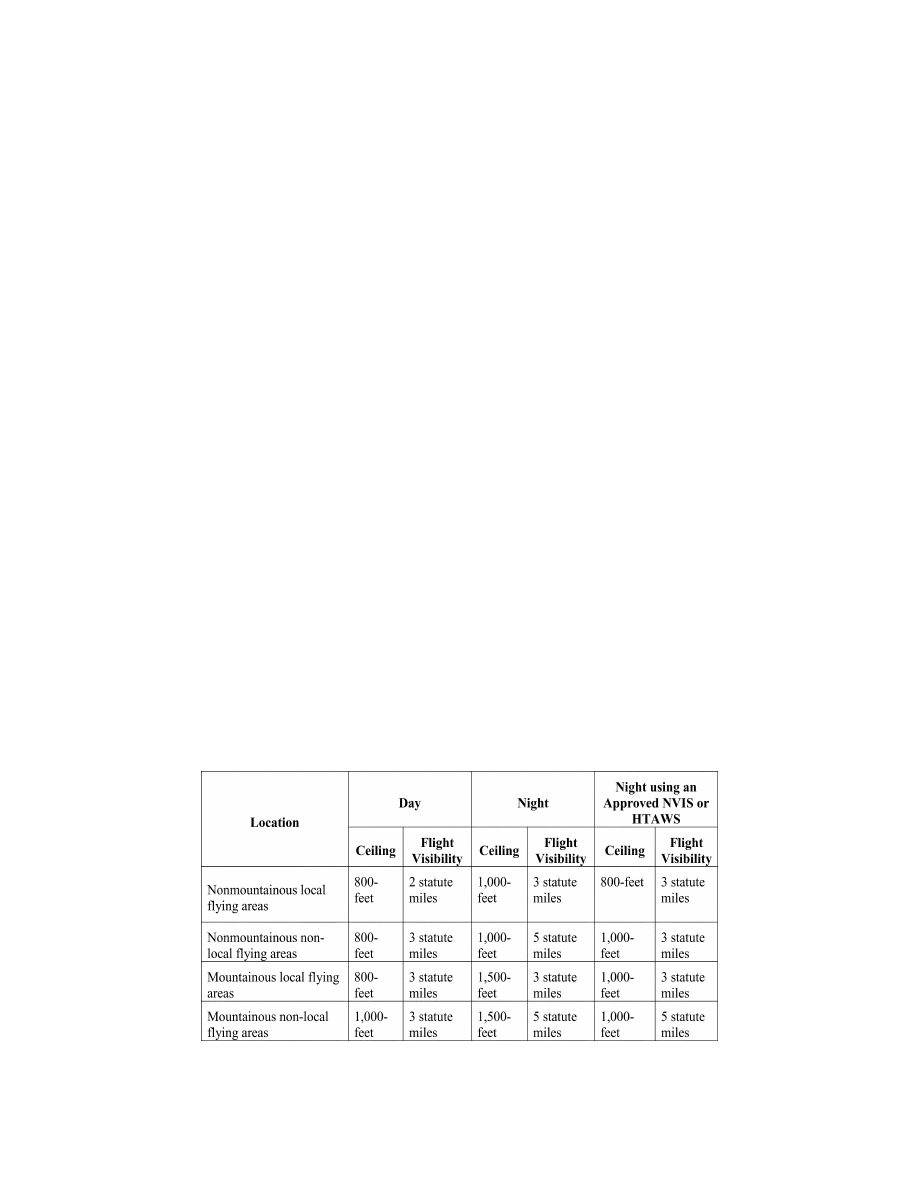
521
Federal Aviation Administration, DOT
§ 135.609
specified in this section, the FAA must
publish notice of change in the F
ED
-
ERAL
R
EGISTER
and the material must
be available to the public. All approved
material is available for inspection at
the FAA’s Office of Rulemaking (ARM–
1), 800 Independence Avenue SW., Wash-
ington, DC 20591 (telephone (202) 267–
9677) and from the sources indicated
below. It is also available for inspec-
tion at the National Archives and
Records Administration (NARA). For
information on the availability of this
material at NARA, call (202) 741–6030 or
go to
http://www.archives.gov/fed-
eral
_
register/code
_
of
_
federal
_
regulations/
ibr
_
locations.html.
(1) U.S. Department of Transpor-
tation, Subsequent Distribution Office,
DOT Warehouse M30, Ardmore East
Business Center, 3341 Q 75th Avenue,
Landover, MD 20785; telephone (301)
322–5377. Copies are also available on
the FAA’s Web site. Use the following
link and type the TSO number in the
search box:
http://rgl.faa.gov/Regu-
latory
_
and
_
Guidance
_
Library/rgTSO.nsf/
Frameset?OpenPage.
(i) TSO C–194, Helicopter Terrain
Awareness and Warning System
(HTAWS), Dec. 17, 2008.
(ii) [Reserved]
(2) RTCA, Inc., 1150 18th Street NW.,
Suite 910, Washington, DC 20036, tele-
phone (202) 833–9339, and are also avail-
able on RTCA’s Web site at
http://
www.rtca.org/onlinecart/index.cfm.
(i) RTCA DO–309, Minimum Oper-
ational Performance Standards
(MOPS) for Helicopter Terrain Aware-
ness and Warning System (HTAWS)
Airborne Equipment, Mar. 13, 2008.
(ii) [Reserved]
§ 135.607 Flight Data Monitoring Sys-
tem.
After April 23, 2018, no person may
operate a helicopter in air ambulance
operations unless it is equipped with an
approved flight data monitoring sys-
tem capable of recording flight per-
formance data. This system must:
(a) Receive electrical power from the
bus that provides the maximum reli-
ability for operation without jeopard-
izing service to essential or emergency
loads, and
(b) Be operated from the application
of electrical power before takeoff until
the removal of electrical power after
termination of flight.
§ 135.609 VFR ceiling and visibility re-
quirements for Class G airspace.
(a) Unless otherwise specified in the
certificate holder’s operations speci-
fications, when conducting VFR heli-
copter air ambulance operations in
Class G airspace, the weather mini-
mums in the following table apply:

522
14 CFR Ch. I (1–1–24 Edition)
§ 135.611
(b) A certificate holder may des-
ignate local flying areas in a manner
acceptable to the Administrator, that
must—
(1) Not exceed 50 nautical miles in
any direction from each designated lo-
cation;
(2) Take into account obstacles and
terrain features that are easily identi-
fiable by the pilot in command and
from which the pilot in command may
visually determine a position; and
(3) Take into account the operating
environment and capabilities of the
certificate holder’s helicopters.
(c) A pilot must demonstrate a level
of familiarity with the local flying
area by passing an examination given
by the certificate holder within the 12
calendar months prior to using the
local flying area.
[Doc. No. FAA–2010–0982, 79 FR 9975, Feb. 21,
2014; Amdt. 135–129A, 79 FR 41126, July 15,
2014]
§ 135.611 IFR operations at locations
without weather reporting.
(a) If a certificate holder is author-
ized to conduct helicopter IFR oper-
ations, the Administrator may author-
ize the certificate holder to conduct
IFR helicopter air ambulance oper-
ations at airports with an instrument
approach procedure and at which a
weather report is not available from
the U.S. National Weather Service
(NWS), a source approved by the NWS,
or a source approved by the FAA, sub-
ject to the following limitations:
(1) The certificate holder must obtain
a weather report from a weather re-
porting facility operated by the NWS, a
source approved by the NWS, or a
source approved by the FAA, that is lo-
cated within 15 nautical miles of the
airport. If a weather report is not
available, the certificate holder may
obtain weather reports, forecasts, or
any combination of them from the
NWS, a source approved by the NWS,
or a source approved by the FAA, for
information regarding the weather ob-
served in the vicinity of the airport;
(2) Flight planning for IFR flights
conducted under this paragraph must
include selection of an alternate air-
port that meets the requirements of
§§ 135.221 and 135.223;
(3) In Class G airspace, IFR depar-
tures with visual transitions are au-
thorized only after the pilot in com-
mand determines that the weather con-
ditions at the departure point are at or
above takeoff minimums depicted in a
published departure procedure or VFR
minimum ceilings and visibilities in
accordance with § 135.609.
(4) All approaches must be conducted
at Category A approach speeds as es-
tablished in part 97 or those required
for the type of approach being used.
(b) Each helicopter air ambulance op-
erated under this section must be
equipped with functioning severe
weather detection equipment, unless
the pilot in command reasonably deter-
mines severe weather will not be en-
countered at the destination, the alter-
nate destination, or along the route of
flight.
(c) Pilots conducting operations pur-
suant to this section may use the
weather information obtained in para-
graph (a) to satisfy the weather report
and forecast requirements of § 135.213
and § 135.225(a).
(d) After completing a landing at the
airport at which a weather report is
not available, the pilot in command is
authorized to determine if the weather
meets the takeoff requirements of part
97 of this chapter or the certificate
holder’s operations specification, as ap-
plicable.
[Doc. No. FAA–2010–0982, 79 FR 9975, Feb. 21,
2014, as amended by Amdt. 135–131, 79 FR
43622, July 28, 2014; Amdt. 135–141, 84 FR
35823, July 25, 2019]
§ 135.613 Approach/departure IFR
transitions.
(a)
Approaches.
When conducting an
authorized instrument approach and
transitioning from IFR to VFR flight,
upon transitioning to VFR flight the
following weather minimums apply—
(1) For Point-in-Space (PinS) Copter
Instrument approaches annotated with
a ‘‘Proceed VFR’’ segment, if the dis-
tance from the missed approach point
to the landing area is 1 NM or less,
flight visibility must be at least 1 stat-
ute mile and the ceiling on the ap-
proach chart applies;
(2) For all instrument approaches, in-
cluding PinS when paragraph (a)(1) of

523
Federal Aviation Administration, DOT
§ 135.617
this section does not apply, if the dis-
tance from the missed approach point
to the landing area is 3 NM or less, the
applicable VFR weather minimums
are—
(i) For Day Operations: No less than
a 600-foot ceiling and 2 statute miles
flight visibility;
(ii) For Night Operations: No less
than a 600-foot ceiling and 3 statute
miles flight visibility; or
(3) For all instrument approaches, in-
cluding PinS, if the distance from the
missed approach point to the landing
area is greater than 3 NM, the VFR
weather minimums required by the
class of airspace.
(b)
Departures.
For transitions from
VFR to IFR upon departure—
(1) The VFR weather minimums of
paragraph (a) of this section apply if—
(i) An FAA-approved obstacle depar-
ture procedure is followed; and
(ii) An IFR clearance is obtained on
or before reaching a predetermined lo-
cation that is not more than 3 NM from
the departure location.
(2) If the departure does not meet the
requirements of paragraph (b)(1) of this
section, the VFR weather minimums
required by the class of airspace apply.
§ 135.615 VFR flight planning.
(a)
Pre-flight.
Prior to conducting
VFR operations, the pilot in command
must—
(1) Determine the minimum safe
cruise altitude by evaluating the ter-
rain and obstacles along the planned
route of flight;
(2) Identify and document the highest
obstacle along the planned route of
flight; and
(3) Using the minimum safe cruise al-
titudes in paragraphs (b)(1)–(2) of this
section, determine the minimum re-
quired ceiling and visibility to conduct
the planned flight by applying the
weather minimums appropriate to the
class of airspace for the planned flight.
(b)
Enroute.
While conducting VFR
operations, the pilot in command must
ensure that all terrain and obstacles
along the route of flight are cleared
vertically by no less than the fol-
lowing:
(1) 300 feet for day operations.
(2) 500 feet for night operations.
(c)
Rerouting the planned flight path.
A
pilot in command may deviate from
the planned flight path for reasons
such as weather conditions or oper-
ational considerations. Such deviations
do not relieve the pilot in command of
the weather requirements or the re-
quirements for terrain and obstacle
clearance contained in this part and in
part 91 of this chapter. Rerouting,
change in destination, or other changes
to the planned flight that occur while
the helicopter is on the ground at an
intermediate stop require evaluation of
the new route in accordance with para-
graph (a) of this section.
(d)
Operations manual.
Each certifi-
cate holder must document its VFR
flight planning procedures in its oper-
ations manual.
§ 135.617 Pre-flight risk analysis.
(a) Each certificate holder con-
ducting helicopter air ambulance oper-
ations must establish, and document in
its operations manual, an FAA-ap-
proved preflight risk analysis that in-
cludes at least the following—
(1) Flight considerations, to include
obstacles and terrain along the planned
route of flight, landing zone conditions,
and fuel requirements;
(2) Human factors, such as crew fa-
tigue, life events, and other stressors;
(3) Weather, including departure, en
route, destination, and forecasted;
(4) A procedure for determining
whether another helicopter air ambu-
lance operator has refused or rejected a
flight request; and
(5) Strategies and procedures for
mitigating identified risks, including
procedures for obtaining and docu-
menting approval of the certificate
holder’s management personnel to re-
lease a flight when a risk exceeds a
level predetermined by the certificate
holder.
(b) Each certificate holder must de-
velop a preflight risk analysis work-
sheet to include, at a minimum, the
items in paragraph (a) of this section.
(c) Prior to the first leg of each heli-
copter air ambulance operation, the
pilot in command must conduct a pre-
flight risk analysis and complete the
preflight risk analysis worksheet in ac-
cordance with the certificate holder’s
FAA-approved procedures. The pilot in

524
14 CFR Ch. I (1–1–24 Edition)
§ 135.619
command must sign the preflight risk
analysis worksheet and specify the
date and time it was completed.
(d) The certificate holder must retain
the original or a copy of each com-
pleted preflight risk analysis work-
sheet at a location specified in its oper-
ations manual for at least 90 days from
the date of the operation.
§ 135.619 Operations control centers.
(a)
Operations control center.
After
April 22, 2016, certificate holders au-
thorized to conduct helicopter air am-
bulance operations, with 10 or more
helicopter air ambulances assigned to
the certificate holder’s operations
specifications, must have an operations
control center. The operations control
center must be staffed by operations
control specialists who, at a min-
imum—
(1) Provide two-way communications
with pilots;
(2) Provide pilots with weather brief-
ings, to include current and forecasted
weather along the planned route of
flight;
(3) Monitor the progress of the flight;
and
(4) Participate in the preflight risk
analysis required under § 135.617 to in-
clude the following:
(i) Ensure the pilot has completed all
required items on the preflight risk
analysis worksheet;
(ii) Confirm and verify all entries on
the preflight risk analysis worksheet;
(iii) Assist the pilot in mitigating
any identified risk prior to takeoff; and
(iv) Acknowledge in writing, speci-
fying the date and time, that the pre-
flight risk analysis worksheet has been
accurately completed and that, accord-
ing to their professional judgment, the
flight can be conducted safely.
(b)
Operations control center staffing.
Each certificate holder conducting hel-
icopter air ambulance operations must
provide enough operations control spe-
cialists at each operations control cen-
ter to ensure the certificate holder
maintains operational control of each
flight.
(c)
Documentation of duties and respon-
sibilities.
Each certificate holder must
describe in its operations manual the
duties and responsibilities of oper-
ations control specialists, including
preflight risk mitigation strategies and
control measures, shift change check-
list, and training and testing proce-
dures to hold the position, including
procedures for retesting.
(d)
Training requirements.
No certifi-
cate holder may use, nor may any per-
son perform the duties of, an oper-
ations control specialist unless the op-
erations control specialist has satisfac-
torily completed the training require-
ments of this paragraph.
(1)
Initial training.
Before performing
the duties of an operations control spe-
cialist, each person must satisfactorily
complete the certificate holder’s FAA-
approved operations control specialist
initial training program and pass an
FAA-approved knowledge and practical
test given by the certificate holder.
Initial training must include a min-
imum of 80 hours of training on the
topics listed in paragraph (f) of this
section. A certificate holder may re-
duce the number of hours of initial
training to a minimum of 40 hours for
persons who have obtained, at the time
of beginning initial training, a total of
at least 2 years of experience during
the last 5 years in any one or in any
combination of the following areas—
(i) In military aircraft operations as
a pilot, flight navigator, or meteorolo-
gist;
(ii) In air carrier operations as a
pilot, flight engineer, certified aircraft
dispatcher, or meteorologist; or
(iii) In aircraft operations as an air
traffic controller or a flight service
specialist.
(2)
Recurrent training.
Every 12
months after satisfactory completion
of the initial training, each operations
control specialist must complete a
minimum of 40 hours of recurrent
training on the topics listed in para-
graph (f) of this section and pass an
FAA-approved knowledge and practical
test given by the certificate holder on
those topics.
(e)
Training records.
The certificate
holder must maintain a training record
for each operations control specialist
employed by the certificate holder for
the duration of that individual’s em-
ployment and for 90 days thereafter.
The training record must include a
chronological log for each training

525
Federal Aviation Administration, DOT
§ 135.619
course, including the number of train-
ing hours and the examination dates
and results.
(f)
Training topics.
Each certificate
holder must have an FAA-approved op-
erations control specialist training
program that covers at least the fol-
lowing topics—
(1) Aviation weather, including:
(i) General meteorology;
(ii) Prevailing weather;
(iii) Adverse and deteriorating weath-
er;
(iv) Windshear;
(v) Icing conditions;
(vi) Use of aviation weather products;
(vii) Available sources of informa-
tion; and
(viii) Weather minimums;
(2) Navigation, including:
(i) Navigation aids;
(ii) Instrument approach procedures;
(iii) Navigational publications; and
(iv) Navigation techniques;
(3) Flight monitoring, including:
(i) Available flight-monitoring proce-
dures; and
(ii) Alternate flight-monitoring pro-
cedures;
(4) Air traffic control, including:
(i) Airspace;
(ii) Air traffic control procedures;
(iii) Aeronautical charts; and
(iv) Aeronautical data sources;
(5) Aviation communication, includ-
ing:
(i) Available aircraft communica-
tions systems;
(ii) Normal communication proce-
dures;
(iii) Abnormal communication proce-
dures; and
(iv) Emergency communication pro-
cedures;
(6) Aircraft systems, including:
(i) Communications systems;
(ii) Navigation systems;
(iii) Surveillance systems;
(iv) Fueling systems;
(v) Specialized systems;
(vi) General maintenance require-
ments; and
(vii) Minimum equipment lists;
(7) Aircraft limitations and perform-
ance, including:
(i) Aircraft operational limitations;
(ii) Aircraft performance;
(iii) Weight and balance procedures
and limitations; and
(iv) Landing zone and landing facility
requirements;
(8) Aviation policy and regulations,
including:
(i) 14 CFR Parts 1, 27, 29, 61, 71, 91,
and 135;
(ii) 49 CFR Part 830;
(iii) Company operations specifica-
tions;
(iv) Company general operations poli-
cies;
(v) Enhanced operational control
policies;
(vi) Aeronautical decision making
and risk management;
(vii) Lost aircraft procedures; and
(viii) Emergency and search and res-
cue procedures, including plotting co-
ordinates in degrees, minutes, seconds
format, and degrees, decimal minutes
format;
(9) Crew resource management, in-
cluding:
(i) Concepts and practical applica-
tion;
(ii) Risk management and risk miti-
gation; and
(iii) Pre-flight risk analysis proce-
dures required under § 135.617;
(10) Local flying area orientation, in-
cluding:
(i) Terrain features;
(ii) Obstructions;
(iii) Weather phenomena for local
area;
(iv) Airspace and air traffic control
facilities;
(v) Heliports, airports, landing zones,
and fuel facilities;
(vi) Instrument approaches;
(vii) Predominant air traffic flow;
(viii) Landmarks and cultural fea-
tures, including areas prone to flat-
light, whiteout, and brownout condi-
tions; and
(ix) Local aviation and safety re-
sources and contact information; and
(11) Any other requirements as deter-
mined by the Administrator to ensure
safe operations.
(g)
Operations control specialist duty
time limitations.
(1) Each certificate
holder must establish the daily duty
period for an operations control spe-
cialist so that it begins at a time that
allows that person to become thor-
oughly familiar with operational con-
siderations, including existing and an-
ticipated weather conditions in the

526
14 CFR Ch. I (1–1–24 Edition)
§ 135.621
area of operations, helicopter oper-
ations in progress, and helicopter
maintenance status, before performing
duties associated with any helicopter
air ambulance operation. The oper-
ations control specialist must remain
on duty until relieved by another
qualified operations control specialist
or until each helicopter air ambulance
monitored by that person has com-
pleted its flight or gone beyond that
person’s jurisdiction.
(2) Except in cases where cir-
cumstances or emergency conditions
beyond the control of the certificate
holder require otherwise—
(i) No certificate holder may sched-
ule an operations control specialist for
more than 10 consecutive hours of
duty;
(ii) If an operations control specialist
is scheduled for more than 10 hours of
duty in 24 consecutive hours, the cer-
tificate holder must provide that per-
son a rest period of at least 8 hours at
or before the end of 10 hours of duty;
(iii) If an operations control spe-
cialist is on duty for more than 10 con-
secutive hours, the certificate holder
must provide that person a rest period
of at least 8 hours before that person’s
next duty period;
(iv) Each operations control spe-
cialist must be relieved of all duty with
the certificate holder for at least 24
consecutive hours during any 7 con-
secutive days.
(h)
Drug and alcohol testing.
Oper-
ations control specialists must be test-
ed for drugs and alcohol according to
the certificate holder’s Drug and Alco-
hol Testing Program administered
under part 120 of this chapter.
§ 135.621 Briefing of medical per-
sonnel.
(a) Except as provided in paragraph
(b) of this section, prior to each heli-
copter air ambulance operation, each
pilot in command, or other flight crew-
member designated by the certificate
holder, must ensure that all medical
personnel have been briefed on the fol-
lowing—
(1) Passenger briefing requirements
in § 135.117(a) and (b); and
(2) Physiological aspects of flight;
(3) Patient loading and unloading;
(4) Safety in and around the heli-
copter;
(5) In-flight emergency procedures;
(6) Emergency landing procedures;
(7) Emergency evacuation proce-
dures;
(8) Efficient and safe communica-
tions with the pilot; and
(9) Operational differences between
day and night operations, if appro-
priate.
(b) The briefing required in para-
graphs (a)(2) through (9) of this section
may be omitted if all medical per-
sonnel on board have satisfactorily
completed the certificate holder’s
FAA-approved medical personnel train-
ing program within the preceding 24
calendar months. Each training pro-
gram must include a minimum of 4
hours of ground training, and 4 hours of
training in and around an air ambu-
lance helicopter, on the topics set forth
in paragraph (a)(2) through (9) of this
section.
(c) Each certificate holder must
maintain a record for each person
trained under this section that—
(1) Contains the individual’s name,
the most recent training completion
date, and a description, copy, or ref-
erence to training materials used to
meet the training requirement.
(2) Is maintained for 24 calendar
months following the individual’s com-
pletion of training.
[Doc. No. FAA–2010–0982, 79 FR 9975, Feb. 21,
2014; Amdt. 135–129A, 79 FR 41126, July 15,
2014]
A
PPENDIX
A
TO
P
ART
135—A
DDITIONAL
A
IRWORTHINESS
S
TANDARDS FOR
10
OR
M
ORE
P
ASSENGER
A
IRPLANES
Applicability
1.
Applicability.
This appendix prescribes
the additional airworthiness standards re-
quired by § 135.169.
2.
References.
Unless otherwise provided,
references in this appendix to specific sec-
tions of part 23 of the Federal Aviation Reg-
ulations (FAR part 23) are to those sections
of part 23 in effect on March 30, 1967.
Flight Requirements
3.
General.
Compliance must be shown with
the applicable requirements of subpart B of

527
Federal Aviation Administration, DOT
Pt. 135, App. A
FAR part 23, as supplemented or modified in
§§ 4 through 10.
Performance
4.
General.
(a) Unless otherwise prescribed
in this appendix, compliance with each appli-
cable performance requirement in sections 4
through 7 must be shown for ambient atmos-
pheric conditions and still air.
(b) The performance must correspond to
the propulsive thrust available under the
particular ambient atmospheric conditions
and the particular flight condition. The
available propulsive thrust must correspond
to engine power or thrust, not exceeding the
approved power or thrust less—
(1) Installation losses; and
(2) The power or equivalent thrust ab-
sorbed by the accessories and services appro-
priate to the particular ambient atmospheric
conditions and the particular flight condi-
tion.
(c) Unless otherwise prescribed in this ap-
pendix, the applicant must select the take-
off, en route, and landing configurations for
the airplane.
(d) The airplane configuration may vary
with weight, altitude, and temperature, to
the extent they are compatible with the op-
erating procedures required by paragraph (e)
of this section.
(e) Unless otherwise prescribed in this ap-
pendix, in determining the critical engine in-
operative takeoff performance, the accel-
erate-stop distance, takeoff distance,
changes in the airplane’s configuration,
speed, power, and thrust must be made under
procedures established by the applicant for
operation in service.
(f) Procedures for the execution of balked
landings must be established by the appli-
cant and included in the Airplane Flight
Manual.
(g) The procedures established under para-
graphs (e) and (f) of this section must—
(1) Be able to be consistently executed in
service by a crew of average skill;
(2) Use methods or devices that are safe
and reliable; and
(3) Include allowance for any time delays,
in the execution of the procedures, that may
reasonably be expected in service.
5.
Takeoff.
(a)
General.
Takeoff speeds, the
accelerate-stop distance, the takeoff dis-
tance, and the one-engine-inoperative take-
off flight path data (described in paragraphs
(b), (c), (d), and (f) of this section), must be
determined for—
(1) Each weight, altitude, and ambient
temperature within the operational limits
selected by the applicant;
(2) The selected configuration for takeoff;
(3) The center of gravity in the most unfa-
vorable position;
(4) The operating engine within approved
operating limitations; and
(5) Takeoff data based on smooth, dry,
hard-surface runway.
(b)
Takeoff speeds.
(1) The decision speed
V
1
is the calibrated airspeed on the ground at
which, as a result of engine failure or other
reasons, the pilot is assumed to have made a
decision to continue or discontinue the take-
off. The speed
V
1
must be selected by the ap-
plicant but may not be less than—
(i) 1.10
V
S1
;
(ii) 1.10
V
MC
;
(iii) A speed that allows acceleration to
V
1
and stop under paragraph (c) of this section;
or
(iv) A speed at which the airplane can be
rotated for takeoff and shown to be adequate
to safely continue the takeoff, using normal
piloting skill, when the critical engine is
suddenly made inoperative.
(2) The initial climb out speed
V
2
, in terms
of calibrated airspeed, must be selected by
the applicant so as to allow the gradient of
climb required in section 6(b)(2), but it must
not be less than
V
1
or less than 1.2
V
S1
.
(3) Other essential take off speeds nec-
essary for safe operation of the airplane.
(c)
Accelerate-stop distance.
(1) The accel-
erate-stop distance is the sum of the dis-
tances necessary to—
(i) Accelerate the airplane from a standing
start to
V
1
; and
(ii) Come to a full stop from the point at
which
V
1
is reached assuming that in the
case of engine failure, failure of the critical
engine is recognized by the pilot at the speed
V
1
.
(2) Means other than wheel brakes may be
used to determine the accelerate-stop dis-
tance if that means is available with the
critical engine inoperative and—
(i) Is safe and reliable;
(ii) Is used so that consistent results can
be expected under normal operating condi-
tions; and
(iii) Is such that exceptional skill is not re-
quired to control the airplane.
(d)
All engines operating takeoff distance.
The all engine operating takeoff distance is
the horizontal distance required to takeoff
and climb to a height of 50 feet above the
takeoff surface under the procedures in FAR
23.51(a).
(e)
One-engine-inoperative takeoff.
Deter-
mine the weight for each altitude and tem-
perature within the operational limits estab-
lished for the airplane, at which the airplane
has the capability, after failure of the crit-
ical engine at
V
1
determined under para-
graph (b) of this section, to take off and
climb at not less than
V
2
, to a height 1,000
feet above the takeoff surface and attain the
speed and configuration at which compliance
is shown with the en route one-engine-inop-
erative gradient of climb specified in section
6(c).
(f)
One-engine-inoperative takeoff flight path
data.
The one-engine-inoperative takeoff

528
14 CFR Ch. I (1–1–24 Edition)
Pt. 135, App. A
flight path data consist of takeoff flight
paths extending from a standing start to a
point in the takeoff at which the airplane
reaches a height 1,000 feet above the takeoff
surface under paragraph (e) of this section.
6.
Climb.
(a)
Landing climb: All-engines-oper-
ating.
The maximum weight must be deter-
mined with the airplane in the landing con-
figuration, for each altitude, and ambient
temperature within the operational limits
established for the airplane, with the most
unfavorable center of gravity, and out-of-
ground effect in free air, at which the steady
gradient of climb will not be less than 3.3
percent, with:
(1) The engines at the power that is avail-
able 8 seconds after initiation of movement
of the power or thrust controls from the
minimum flight idle to the takeoff position.
(2) A climb speed not greater than the ap-
proach speed established under section 7 and
not less than the greater of 1.05
V
MC
or
1.10
V
S1
.
(b)
Takeoff climb: one-engine-inoperative.
The maximum weight at which the airplane
meets the minimum climb performance spec-
ified in paragraphs (1) and (2) of this para-
graph must be determined for each altitude
and ambient temperature within the oper-
ational limits established for the airplane,
out of ground effect in free air, with the air-
plane in the takeoff configuration, with the
most unfavorable center of gravity, the crit-
ical engine inoperative, the remaining en-
gines at the maximum takeoff power or
thrust, and the propeller of the inoperative
engine windmilling with the propeller con-
trols in the normal position except that, if
an approved automatic feathering system is
installed, the propellers may be in the feath-
ered position:
(1)
Takeoff: landing gear extended.
The min-
imum steady gradient of climb must be
measurably positive at the speed
V
1
.
(2)
Takeoff: landing gear retracted.
The min-
imum steady gradient of climb may not be
less than 2 percent at speed
V
2
. For airplanes
with fixed landing gear this requirement
must be met with the landing gear extended.
(c)
En route climb: one-engine-inoperative.
The maximum weight must be determined
for each altitude and ambient temperature
within the operational limits established for
the airplane, at which the steady gradient of
climb is not less 1.2 percent at an altitude
1,000 feet above the takeoff surface, with the
airplane in the en route configuration, the
critical engine inoperative, the remaining
engine at the maximum continuous power or
thrust, and the most unfavorable center of
gravity.
7.
Landing.
(a) The landing field length de-
scribed in paragraph (b) of this section must
be determined for standard atmosphere at
each weight and altitude within the oper-
ational limits established by the applicant.
(b) The landing field length is equal to the
landing distance determined under FAR
23.75(a) divided by a factor of 0.6 for the des-
tination airport and 0.7 for the alternate air-
port. Instead of the gliding approach speci-
fied in FAR 23.75(a)(1), the landing may be
preceded by a steady approach down to the
50-foot height at a gradient of descent not
greater than 5.2 percent (3
°
) at a calibrated
airspeed not less than 1.3
V
S1
.
Trim
8.
Trim.
(a)
Lateral and directional trim.
The
airplane must maintain lateral and direc-
tional trim in level flight at a speed of
V
H
or
V
MO
/
M
MO,
whichever is lower, with landing
gear and wing flaps retracted.
(b)
Longitudinal trim.
The airplane must
maintain longitudinal trim during the fol-
lowing conditions, except that it need not
maintain trim at a speed greater than
V
MO
/
M
MO
:
(1) In the approach conditions specified in
FAR 23.161(c) (3) through (5), except that in-
stead of the speeds specified in those para-
graphs, trim must be maintained with a
stick force of not more than 10 pounds down
to a speed used in showing compliance with
section 7 or 1.4
V
S1
whichever is lower.
(2) In level flight at any speed from
V
H
or
V
MO
/
M
MO
, whichever is lower, to either
V
x
or
1.4
V
S1
, with the landing gear and wing flaps
retracted.
Stability
9.
Static longitudinal stability.
(a) In showing
compliance with FAR 23.175(b) and with
paragraph (b) of this section, the airspeed
must return to within
±
7
1
⁄
2
percent of the
trim speed.
(b)
Cruise stability.
The stick force curve
must have a stable slope for a speed range of
±
50 knots from the trim speed except that
the speeds need not exceed
V
FC
/
M
FC
or be less
than 1.4
V
S1
. This speed range will be consid-
ered to begin at the outer extremes of the
friction band and the stick force may not ex-
ceed 50 pounds with—
(1) Landing gear retracted;
(2) Wing flaps retracted;
(3) The maximum cruising power as se-
lected by the applicant as an operating limi-
tation for turbine engines or 75 percent of
maximum continuous power for recipro-
cating engines except that the power need
not exceed that required at
V
MO
/
M
MO
;
(4) Maximum takeoff weight; and
(5) The airplane trimmed for level flight
with the power specified in paragraph (3) of
this paragraph.
V
FC
/
M
FC
may not be less than a speed mid-
way between
V
MO
/
M
MO
and
V
DF
/
M
DF,
except
that, for altitudes where Mach number is the
limiting factor,
M
FC
need not exceed the
Mach number at which effective speed warn-
ing occurs.

529
Federal Aviation Administration, DOT
Pt. 135, App. A
(c)
Climb stability (turbopropeller powered
airplanes only).
In showing compliance with
FAR 23.175(a), an applicant must, instead of
the power specified in FAR 23.175(a)(4), use
the maximum power or thrust selected by
the applicant as an operating limitation for
use during climb at the best rate of climb
speed, except that the speed need not be less
than 1.4
V
S1
.
Stalls
10.
Stall warning.
If artificial stall warning
is required to comply with FAR 23.207, the
warning device must give clearly distin-
guishable indications under expected condi-
tions of flight. The use of a visual warning
device that requires the attention of the
crew within the cockpit is not acceptable by
itself.
Control Systems
11.
Electric trim tabs.
The airplane must
meet FAR 23.677 and in addition it must be
shown that the airplane is safely control-
lable and that a pilot can perform all the
maneuvers and operations necessary to ef-
fect a safe landing following any probable
electric trim tab runaway which might be
reasonably expected in service allowing for
appropriate time delay after pilot recogni-
tion of the runaway. This demonstration
must be conducted at the critical airplane
weights and center of gravity positions.
Instruments: Installation
12.
Arrangement and visibility.
Each instru-
ment must meet FAR 23.1321 and in addition:
(a) Each flight, navigation, and powerplant
instrument for use by any pilot must be
plainly visible to the pilot from the pilot’s
station with the minimum practicable devi-
ation from the pilot’s normal position and
line of vision when the pilot is looking for-
ward along the flight path.
(b) The flight instruments required by FAR
23.1303 and by the applicable operating rules
must be grouped on the instrument panel
and centered as nearly as practicable about
the vertical plane of each pilot’s forward vi-
sion. In addition—
(1) The instrument that most effectively
indicates the attitude must be in the panel
in the top center position;
(2) The instrument that most effectively
indicates the airspeed must be on the panel
directly to the left of the instrument in the
top center position;
(3) The instrument that most effectively
indicates altitude must be adjacent to and
directly to the right of the instrument in the
top center position; and
(4) The instrument that most effectively
indicates direction of flight must be adjacent
to and directly below the instrument in the
top center position.
13.
Airspeed indicating system.
Each airspeed
indicating system must meet FAR 23.1323
and in addition:
(a) Airspeed indicating instruments must
be of an approved type and must be cali-
brated to indicate true airspeed at sea level
in the standard atmosphere with a minimum
practicable instrument calibration error
when the corresponding pitot and static
pressures are supplied to the instruments.
(b) The airspeed indicating system must be
calibrated to determine the system error,
i.e., the relation between IAS and CAS, in
flight and during the accelerate-takeoff
ground run. The ground run calibration must
be obtained between 0.8 of the minimum
value of
V
1
and 1.2 times the maximum value
of
V
1
, considering the approved ranges of al-
titude and weight. The ground run calibra-
tion is determined assuming an engine fail-
ure at the minimum value of
V
1
.
(c) The airspeed error of the installation
excluding the instrument calibration error,
must not exceed 3 percent or 5 knots which-
ever is greater, throughout the speed range
from
V
MO
to 1.3
V
S1
with flaps retracted and
from 1.3
V
SO
to
V
FE
with flaps in the landing
position.
(d) Information showing the relationship
between IAS and CAS must be shown in the
Airplane Flight manual.
14.
Static air vent system.
The static air vent
system must meet FAR 23.1325. The altim-
eter system calibration must be determined
and shown in the Airplane Flight Manual.
Operating Limitations and Information
15.
Maximum operating limit speed V
MO
/
M
MO.
Instead of establishing operating limitations
based on
V
NE
and
V
NO,
the applicant must es-
tablish a maximum operating limit speed
V
MO
/
M
MO
as follows:
(a) The maximum operating limit speed
must not exceed the design cruising speed
V
C
and must be sufficiently below
V
D
/
M
D
or
V
DF
/
M
DF
to make it highly improbable that the
latter speeds will be inadvertently exceeded
in flight.
(b) The speed
V
MO
must not exceed 0.8
V
D
/
M
D
or 0.8
V
DF
/
M
DF
unless flight demonstra-
tions involving upsets as specified by the Ad-
ministrator indicates a lower speed margin
will not result in speeds exceeding
V
D
/
M
D
or
V
DF.
Atmospheric variations, horizontal
gusts, system and equipment errors, and air-
frame production variations are taken into
account.
16.
Minimum flight crew.
In addition to
meeting FAR 23.1523, the applicant must es-
tablish the minimum number and type of
qualified flight crew personnel sufficient for
safe operation of the airplane considering—
(a) Each kind of operation for which the
applicant desires approval;
(b) The workload on each crewmember con-
sidering the following:
(1) Flight path control.

530
14 CFR Ch. I (1–1–24 Edition)
Pt. 135, App. A
(2) Collision avoidance.
(3) Navigation.
(4) Communications.
(5) Operation and monitoring of all essen-
tial aircraft systems.
(6) Command decisions; and
(c) The accessibility and ease of operation
of necessary controls by the appropriate
crewmember during all normal and emer-
gency operations when at the crewmember
flight station.
17.
Airspeed indicator.
The airspeed indi-
cator must meet FAR 23.1545 except that, the
airspeed notations and markings in terms of
V
NO
and
V
NH
must be replaced by the
V
MO
/
M
MO
notations. The airspeed indicator mark-
ings must be easily read and understood by
the pilot. A placard adjacent to the airspeed
indicator is an acceptable means of showing
compliance with FAR 23.1545(c).
Airplane Flight Manual
18.
General.
The Airplane Flight Manual
must be prepared under FARs 23.1583 and
23.1587, and in addition the operating limita-
tions and performance information in sec-
tions 19 and 20 must be included.
19.
Operating limitations.
The Airplane
Flight Manual must include the following
limitations—
(a)
Airspeed limitations.
(1) The maximum
operating limit speed
V
MO
/
M
MO
and a state-
ment that this speed limit may not be delib-
erately exceeded in any regime of flight
(climb, cruise, or descent) unless a higher
speed is authorized for flight test or pilot
training;
(2) If an airspeed limitation is based upon
compressibility effects, a statement to this
effect and information as to any symptoms,
the probable behavior of the airplane, and
the recommended recovery procedures; and
(3) The airspeed limits, shown in terms of
V
MO
/M
MO
instead of
V
NO
and
V
NE.
(b)
Takeoff weight limitations.
The max-
imum takeoff weight for each airport ele-
vation ambient temperature and available
takeoff runway length within the range se-
lected by the applicant may not exceed the
weight at which—
(1) The all-engine-operating takeoff dis-
tance determined under section 5(b) or the
accelerate-stop distance determined under
section 5(c), whichever is greater, is equal to
the available runway length;
(2) The airplane complies with the one-en-
gine-inoperative takeoff requirements speci-
fied in section 5(e); and
(3) The airplane complies with the one-en-
gine-inoperative takeoff and en route climb
requirements specified in sections 6 (b) and
(c).
(c)
Landing weight limitations.
The max-
imum landing weight for each airport ele-
vation (standard temperature) and available
landing runway length, within the range se-
lected by the applicant. This weight may not
exceed the weight at which the landing field
length determined under section 7(b) is equal
to the available runway length. In showing
compliance with this operating limitation, it
is acceptable to assume that the landing
weight at the destination will be equal to the
takeoff weight reduced by the normal con-
sumption of fuel and oil en route.
20.
Performance information.
The Airplane
Flight Manual must contain the performance
information determined under the perform-
ance requirements of this appendix. The in-
formation must include the following:
(a) Sufficient information so that the take-
off weight limits specified in section 19(b)
can be determined for all temperatures and
altitudes within the operation limitations
selected by the applicant.
(b) The conditions under which the per-
formance information was obtained, includ-
ing the airspeed at the 50-foot height used to
determine landing distances.
(c) The performance information (deter-
mined by extrapolation and computed for the
range of weights between the maximum
landing and takeoff weights) for—
(1) Climb in the landing configuration; and
(2) Landing distance.
(d) Procedure established under section 4
related to the limitations and information
required by this section in the form of guid-
ance material including any relevant limita-
tions or information.
(e) An explanation of significant or un-
usual flight or ground handling characteris-
tics of the airplane.
(f) Airspeeds, as indicated airspeeds, cor-
responding to those determined for takeoff
under section 5(b).
21.
Maximum operating altitudes.
The max-
imum operating altitude to which operation
is allowed, as limited by flight, structural,
powerplant, functional, or equipment char-
acteristics, must be specified in the Airplane
Flight Manual.
22.
Stowage provision for airplane flight man-
ual.
Provision must be made for stowing the
Airplane Flight Manual in a suitable fixed
container which is readily accessible to the
pilot.
23.
Operating procedures.
Procedures for re-
starting turbine engines in flight (including
the effects of altitude) must be set forth in
the Airplane Flight Manual.
Airframe Requirements
Flight Loads
24.
Engine torque.
(a) Each turbopropeller
engine mount and its supporting structure
must be designed for the torque effects of:
(1) The conditions in FAR 23.361(a).
(2) The limit engine torque corresponding
to takeoff power and propeller speed multi-
plied by a factor accounting for propeller
control system malfunction, including quick
feathering action, simultaneously with 1
g

531
Federal Aviation Administration, DOT
Pt. 135, App. A
level flight loads. In the absence of a ration-
al analysis, a factor of 1.6 must be used.
(b) The limit torque is obtained by multi-
plying the mean torque by a factor of 1.25.
25.
Turbine engine gyroscopic loads.
Each
turbopropeller engine mount and its sup-
porting structure must be designed for the
gyroscopic loads that result, with the en-
gines at maximum continuous r.p.m., under
either—
(a) The conditions in FARs 23.351 and
23.423; or
(b) All possible combinations of the fol-
lowing:
(1) A yaw velocity of 2.5 radians per second.
(2) A pitch velocity of 1.0 radians per sec-
ond.
(3) A normal load factor of 2.5.
(4) Maximum continuous thrust.
26.
Unsymmetrical loads due to engine failure.
(a) Turbopropeller powered airplanes must
be designed for the unsymmet- rical loads re-
sulting from the failure of the critical engine
including the following conditions in com-
bination with a single malfunction of the
propeller drag limiting system, considering
the probable pilot corrective action on the
flight controls:
(1) At speeds between
V
mo
and
V
D,
the loads
resulting from power failure because of fuel
flow interruption are considered to be limit
loads.
(2) At speeds between
V
mo
and
V
c,
the loads
resulting from the disconnection of the en-
gine compressor from the turbine or from
loss of the turbine blades are considered to
be ultimate loads.
(3) The time history of the thrust decay
and drag buildup occurring as a result of the
prescribed engine failures must be substan-
tiated by test or other data applicable to the
particular engine-propeller combination.
(4) The timing and magnitude of the prob-
able pilot corrective action must be conserv-
atively estimated, considering the character-
istics of the particular engine-propeller-air-
plane combination.
(b) Pilot corrective action may be assumed
to be initiated at the time maximum yawing
velocity is reached, but not earlier than 2
seconds after the engine failure. The mag-
nitude of the corrective action may be based
on the control forces in FAR 23.397 except
that lower forces may be assumed where it is
shown by analysis or test that these forces
can control the yaw and roll resulting from
the prescribed engine failure conditions.
Ground Loads
27.
Dual wheel landing gear units.
Each dual
wheel landing gear unit and its supporting
structure must be shown to comply with the
following:
(a)
Pivoting.
The airplane must be assumed
to pivot about one side of the main gear with
the brakes on that side locked. The limit
vertical load factor must be 1.0 and the coef-
ficient of friction 0.8. This condition need
apply only to the main gear and its sup-
porting structure.
(b)
Unequal tire inflation.
A 60–40 percent
distribution of the loads established under
FAR 23.471 through FAR 23.483 must be ap-
plied to the dual wheels.
(c)
Flat tire.
(1) Sixty percent of the loads
in FAR 23.471 through FAR 23.483 must be ap-
plied to either wheel in a unit.
(2) Sixty percent of the limit drag and side
loads and 100 percent of the limit vertical
load established under FARs 23.493 and 23.485
must be applied to either wheel in a unit ex-
cept that the vertical load need not exceed
the maximum vertical load in paragraph
(c)(1) of this section.
Fatigue Evaluation
28.
Fatigue evaluation of wing and associated
structure.
Unless it is shown that the struc-
ture, operating stress levels, materials and
expected use are comparable from a fatigue
standpoint to a similar design which has had
substantial satisfactory service experience,
the strength, detail design, and the fabrica-
tion of those parts of the wing, wing carry-
through, and attaching structure whose fail-
ure would be catastrophic must be evaluated
under either—
(a) A fatigue strength investigation in
which the structure is shown by analysis,
tests, or both to be able to withstand the re-
peated loads of variable magnitude expected
in service; or
(b) A fail-safe strength investigation in
which it is shown by analysis, tests, or both
that catastrophic failure of the structure is
not probable after fatigue, or obvious partial
failure, of a principal structural element,
and that the remaining structure is able to
withstand a static ultimate load factor of 75
percent of the critical limit load factor at
V
C.
These loads must be multiplied by a factor of
1.15 unless the dynamic effects of failure
under static load are otherwise considered.
Design and Construction
29.
Flutter.
For multiengine turbopropeller
powered airplanes, a dynamic evaluation
must be made and must include—
(a) The significant elastic, inertia, and aer-
odynamic forces associated with the rota-
tions and displacements of the plane of the
propeller; and
(b) Engine-propeller-nacelle stiffness and
damping variations appropriate to the par-
ticular configuration.
Landing Gear
30.
Flap operated landing gear warning de-
vice.
Airplanes having retractable landing
gear and wing flaps must be equipped with a
warning device that functions continuously
when the wing flaps are extended to a flap
position that activates the warning device to

532
14 CFR Ch. I (1–1–24 Edition)
Pt. 135, App. A
give adequate warning before landing, using
normal landing procedures, if the landing
gear is not fully extended and locked. There
may not be a manual shut off for this warn-
ing device. The flap position sensing unit
may be installed at any suitable location.
The system for this device may use any part
of the system (including the aural warning
device) provided for other landing gear warn-
ing devices.
Personnel and Cargo Accommodations
31.
Cargo and baggage compartments.
Cargo
and baggage compartments must be designed
to meet FAR 23.787 (a) and (b), and in addi-
tion means must be provided to protect pas-
sengers from injury by the contents of any
cargo or baggage compartment when the ul-
timate forward inertia force is 9
g.
32.
Doors and exits.
The airplane must meet
FAR 23.783 and FAR 23.807 (a)(3), (b), and (c),
and in addition:
(a) There must be a means to lock and
safeguard each external door and exit
against opening in flight either inadvert-
ently by persons, or as a result of mechan-
ical failure. Each external door must be op-
erable from both the inside and the outside.
(b) There must be means for direct visual
inspection of the locking mechanism by
crewmembers to determine whether external
doors and exits, for which the initial opening
movement is outward, are fully locked. In
addition, there must be a visual means to
signal to crewmembers when normally used
external doors are closed and fully locked.
(c) The passenger entrance door must qual-
ify as a floor level emergency exit. Each ad-
ditional required emergency exit except floor
level exits must be located over the wing or
must be provided with acceptable means to
assist the occupants in descending to the
ground. In addition to the passenger en-
trance door:
(1) For a total seating capacity of 15 or
less, an emergency exit as defined in FAR
23.807(b) is required on each side of the cabin.
(2) For a total seating capacity of 16
through 23, three emergency exits as defined
in FAR 23.807(b) are required with one on the
same side as the door and two on the side op-
posite the door.
(d) An evacuation demonstration must be
conducted utilizing the maximum number of
occupants for which certification is desired.
It must be conducted under simulated night
conditions utilizing only the emergency
exits on the most critical side of the aircraft.
The participants must be representative of
average airline passengers with no previous
practice or rehearsal for the demonstration.
Evacuation must be completed within 90 sec-
onds.
(e) Each emergency exit must be marked
with the word ‘‘Exit’’ by a sign which has
white letters 1 inch high on a red back-
ground 2 inches high, be self-illuminated or
independently internally electrically illumi-
nated, and have a minimum luminescence
(brightness) of at least 160 microlamberts.
The colors may be reversed if the passenger
compartment illumination is essentially the
same.
(f) Access to window type emergency exits
must not be obstructed by seats or seat
backs.
(g) The width of the main passenger aisle
at any point between seats must equal or ex-
ceed the values in the following table:
Total seating capacity
Minimum main passenger
aisle width
Less than 25
inches from
floor
25 inches
and more
from floor
10 through 23 .........................
9 inches .......
15 inches.
Miscellaneous
33.
Lightning strike protection.
Parts that
are electrically insulated from the basic air-
frame must be connected to it through light-
ning arrestors unless a lightning strike on
the insulated part—
(a) Is improbable because of shielding by
other parts; or
(b) Is not hazardous.
34.
Ice protection.
If certification with ice
protection provisions is desired, compliance
with the following must be shown:
(a) The recommended procedures for the
use of the ice protection equipment must be
set forth in the Airplane Flight Manual.
(b) An analysis must be performed to es-
tablish, on the basis of the airplane’s oper-
ational needs, the adequacy of the ice protec-
tion system for the various components of
the airplane. In addition, tests of the ice pro-
tection system must be conducted to dem-
onstrate that the airplane is capable of oper-
ating safely in continuous maximum and
intermittent maximum icing conditions as
described in appendix C of part 25 of this
chapter.
(c) Compliance with all or portions of this
section may be accomplished by reference,
where applicable because of similarity of the
designs, to analysis and tests performed by
the applicant for a type certificated model.
35.
Maintenance information.
The applicant
must make available to the owner at the
time of delivery of the airplane the informa-
tion the applicant considers essential for the
proper maintenance of the airplane. That in-
formation must include the following:
(a) Description of systems, including elec-
trical, hydraulic, and fuel controls.
(b) Lubrication instructions setting forth
the frequency and the lubricants and fluids
which are to be used in the various systems.
(c) Pressures and electrical loads applica-
ble to the various systems.
(d) Tolerances and adjustments necessary
for proper functioning.

533
Federal Aviation Administration, DOT
Pt. 135, App. A
(e) Methods of leveling, raising, and tow-
ing.
(f) Methods of balancing control surfaces.
(g) Identification of primary and secondary
structures.
(h) Frequency and extent of inspections
necessary to the proper operation of the air-
plane.
(i) Special repair methods applicable to the
airplane.
(j) Special inspection techniques, such as
X-ray, ultrasonic, and magnetic particle in-
spection.
(k) List of special tools.
Propulsion
General
36.
Vibration characteristics.
For turbo-
propeller powered airplanes, the engine in-
stallation must not result in vibration char-
acteristics of the engine exceeding those es-
tablished during the type certification of the
engine.
37.
In flight restarting of engine.
If the en-
gine on turbopropeller powered airplanes
cannot be restarted at the maximum cruise
altitude, a determination must be made of
the altitude below which restarts can be con-
sistently accomplished. Restart information
must be provided in the Airplane Flight
Manual.
38.
Engines.
(a)
For turbopropeller powered
airplanes.
The engine installation must com-
ply with the following:
(1)
Engine isolation.
The powerplants must
be arranged and isolated from each other to
allow operation, in at least one configura-
tion, so that the failure or malfunction of
any engine, or of any system that can affect
the engine, will not—
(i) Prevent the continued safe operation of
the remaining engines; or
(ii) Require immediate action by any crew-
member for continued safe operation.
(2)
Control of engine rotation.
There must be
a means to individually stop and restart the
rotation of any engine in flight except that
engine rotation need not be stopped if con-
tinued rotation could not jeopardize the safe-
ty of the airplane. Each component of the
stopping and restarting system on the engine
side of the firewall, and that might be ex-
posed to fire, must be at least fire resistant.
If hydraulic propeller feathering systems are
used for this purpose, the feathering lines
must be at least fire resistant under the op-
erating conditions that may be expected to
exist during feathering.
(3)
Engine speed and gas temperature control
devices.
The powerplant systems associated
with engine control devices, systems, and in-
strumentation must provide reasonable as-
surance that those engine operating limita-
tions that adversely affect turbine rotor
structural integrity will not be exceeded in
service.
(b)
For reciprocating engine powered air-
planes.
To provide engine isolation, the pow-
erplants must be arranged and isolated from
each other to allow operation, in at least one
configuration, so that the failure or malfunc-
tion of any engine, or of any system that can
affect that engine, will not—
(1) Prevent the continued safe operation of
the remaining engines; or
(2) Require immediate action by any crew-
member for continued safe operation.
39.
Turbopropeller reversing systems.
(a) Tur-
bopropeller reversing systems intended for
ground operation must be designed so that
no single failure or malfunction of the sys-
tem will result in unwanted reverse thrust
under any expected operating condition.
Failure of structural elements need not be
considered if the probability of this kind of
failure is extremely remote.
(b) Turbopropeller reversing systems in-
tended for in flight use must be designed so
that no unsafe condition will result during
normal operation of the system, or from any
failure (or reasonably likely combination of
failures) of the reversing system, under any
anticipated condition of operation of the air-
plane. Failure of structural elements need
not be considered if the probability of this
kind of failure is extremely remote.
(c) Compliance with this section may be
shown by failure analysis, testing, or both
for propeller systems that allow propeller
blades to move from the flight low-pitch po-
sition to a position that is substantially less
than that at the normal flight low-pitch stop
position. The analysis may include or be sup-
ported by the analysis made to show compli-
ance with the type certification of the pro-
peller and associated installation compo-
nents. Credit will be given for pertinent
analysis and testing completed by the engine
and propeller manufacturers.
40.
Turbopropeller drag-limiting systems.
Tur-
bopropeller drag-limiting systems must be
designed so that no single failure or malfunc-
tion of any of the systems during normal or
emergency operation results in propeller
drag in excess of that for which the airplane
was designed. Failure of structural elements
of the drag-limiting systems need not be con-
sidered if the probability of this kind of fail-
ure is extremely remote.
41.
Turbine engine powerplant operating
characteristics.
For turbopropeller powered
airplanes, the turbine engine powerplant op-
erating characteristics must be investigated
in flight to determine that no adverse char-
acteristics (such as stall, surge, or flameout)
are present to a hazardous degree, during
normal and emergency operation within the
range of operating limitations of the air-
plane and of the engine.
42.
Fuel flow.
(a) For turbopropeller pow-
ered airplanes—

534
14 CFR Ch. I (1–1–24 Edition)
Pt. 135, App. A
(1) The fuel system must provide for con-
tinuous supply of fuel to the engines for nor-
mal operation without interruption due to
depletion of fuel in any tank other than the
main tank; and
(2) The fuel flow rate for turbopropeller en-
gine fuel pump systems must not be less
than 125 percent of the fuel flow required to
develop the standard sea level atmospheric
conditions takeoff power selected and in-
cluded as an operating limitation in the Air-
plane Flight Manual.
(b) For reciprocating engine powered air-
planes, it is acceptable for the fuel flow rate
for each pump system (main and reserve sup-
ply) to be 125 percent of the takeoff fuel con-
sumption of the engine.
Fuel System Components
43.
Fuel pumps.
For turbopropeller powered
airplanes, a reliable and independent power
source must be provided for each pump used
with turbine engines which do not have pro-
visions for mechanically driving the main
pumps. It must be demonstrated that the
pump installations provide a reliability and
durability equivalent to that in FAR
23.991(a).
44.
Fuel strainer or filter.
For turbopropeller
powered airplanes, the following apply:
(a) There must be a fuel strainer or filter
between the tank outlet and the fuel meter-
ing device of the engine. In addition, the fuel
strainer or filter must be—
(1) Between the tank outlet and the en-
gine-driven positive displacement pump
inlet, if there is an engine-driven positive
displacement pump;
(2) Accessible for drainage and cleaning
and, for the strainer screen, easily remov-
able; and
(3) Mounted so that its weight is not sup-
ported by the connecting lines or by the
inlet or outlet connections of the strainer or
filter itself.
(b) Unless there are means in the fuel sys-
tem to prevent the accumulation of ice on
the filter, there must be means to automati-
cally maintain the fuel-flow if ice-clogging
of the filter occurs; and
(c) The fuel strainer or filter must be of
adequate capacity (for operating limitations
established to ensure proper service) and of
appropriate mesh to insure proper engine op-
eration, with the fuel contaminated to a de-
gree (for particle size and density) that can
be reasonably expected in service. The de-
gree of fuel filtering may not be less than
that established for the engine type certifi-
cation.
45.
Lightning strike protection.
Protection
must be provided against the ignition of
flammable vapors in the fuel vent system
due to lightning strikes.
Cooling
46.
Cooling test procedures for turbopropeller
powered airplanes.
(a) Turbopropeller powered
airplanes must be shown to comply with
FAR 23.1041 during takeoff, climb, en route,
and landing stages of flight that correspond
to the applicable performance requirements.
The cooling tests must be conducted with
the airplane in the configuration, and oper-
ating under the conditions that are critical
relative to cooling during each stage of
flight. For the cooling tests a temperature is
‘‘stabilized’’ when its rate of change is less
than 2
°
F. per minute.
(b) Temperatures must be stabilized under
the conditions from which entry is made into
each stage of flight being investigated unless
the entry condition is not one during which
component and engine fluid temperatures
would stabilize, in which case, operation
through the full entry condition must be
conducted before entry into the stage of
flight being investigated to allow tempera-
tures to reach their natural levels at the
time of entry. The takeoff cooling test must
be preceded by a period during which the
powerplant component and engine fluid tem-
peratures are stabilized with the engines at
ground idle.
(c) Cooling tests for each stage of flight
must be continued until—
(1) The component and engine fluid tem-
peratures stabilize;
(2) The stage of flight is completed; or
(3) An operating limitation is reached.
Induction System
47.
Air induction.
For turbopropeller pow-
ered airplanes—
(a) There must be means to prevent haz-
ardous quantities of fuel leakage or overflow
from drains, vents, or other components of
flammable fluid systems from entering the
engine intake systems; and
(b) The air inlet ducts must be located or
protected so as to minimize the ingestion of
foreign matter during takeoff, landing, and
taxiing.
48.
Induction system icing protection.
For
turbopropeller powered airplanes, each tur-
bine engine must be able to operate through-
out its flight power range without adverse
effect on engine operation or serious loss of
power or thrust, under the icing conditions
specified in appendix C of part 25 of this
chapter. In addition, there must be means to
indicate to appropriate flight crewmembers
the functioning of the powerplant ice protec-
tion system.
49.
Turbine engine bleed air systems.
Turbine
engine bleed air systems of turbopropeller
powered airplanes must be investigated to
determine—
(a) That no hazard to the airplane will re-
sult if a duct rupture occurs. This condition
must consider that a failure of the duct can

535
Federal Aviation Administration, DOT
Pt. 135, App. A
occur anywhere between the engine port and
the airplane bleed service; and
(b) That, if the bleed air system is used for
direct cabin pressurization, it is not possible
for hazardous contamination of the cabin air
system to occur in event of lubrication sys-
tem failure.
Exhaust System
50.
Exhaust system drains.
Turbopropeller
engine exhaust systems having low spots or
pockets must incorporate drains at those lo-
cations. These drains must discharge clear of
the airplane in normal and ground attitudes
to prevent the accumulation of fuel after the
failure of an attempted engine start.
Powerplant Controls and Accessories
51.
Engine controls.
If throttles or power le-
vers for turbopropeller powered airplanes are
such that any position of these controls will
reduce the fuel flow to the engine(s) below
that necessary for satisfactory and safe idle
operation of the engine while the airplane is
in flight, a means must be provided to pre-
vent inadvertent movement of the control
into this position. The means provided must
incorporate a positive lock or stop at this
idle position and must require a separate and
distinct operation by the crew to displace
the control from the normal engine oper-
ating range.
52.
Reverse thrust controls.
For turbo-
propeller powered airplanes, the propeller re-
verse thrust controls must have a means to
prevent their inadvertent operation. The
means must have a positive lock or stop at
the idle position and must require a separate
and distinct operation by the crew to dis-
place the control from the flight regime.
53.
Engine ignition systems.
Each turbo-
propeller airplane ignition system must be
considered an essential electrical load.
54.
Powerplant accessories.
The powerplant
accessories must meet FAR 23.1163, and if
the continued rotation of any accessory re-
motely driven by the engine is hazardous
when malfunctioning occurs, there must be
means to prevent rotation without inter-
fering with the continued operation of the
engine.
Powerplant Fire Protection
55.
Fire detector system.
For turbopropeller
powered airplanes, the following apply:
(a) There must be a means that ensures
prompt detection of fire in the engine com-
partment. An overtemperature switch in
each engine cooling air exit is an acceptable
method of meeting this requirement.
(b) Each fire detector must be constructed
and installed to withstand the vibration, in-
ertia, and other loads to which it may be
subjected in operation.
(c) No fire detector may be affected by any
oil, water, other fluids, or fumes that might
be present.
(d) There must be means to allow the flight
crew to check, in flight, the functioning of
each fire detector electric circuit.
(e) Wiring and other components of each
fire detector system in a fire zone must be at
least fire resistant.
56.
Fire protection, cowling and nacelle skin.
For reciprocating engine powered airplanes,
the engine cowling must be designed and
constructed so that no fire originating in the
engine compartment can enter either
through openings or by burn through, any
other region where it would create addi-
tional hazards.
57.
Flammable fluid fire protection.
If flam-
mable fluids or vapors might be liberated by
the leakage of fluid systems in areas other
than engine compartments, there must be
means to—
(a) Prevent the ignition of those fluids or
vapors by any other equipment; or
(b) Control any fire resulting from that ig-
nition.
Equipment
58.
Powerplant instruments.
(a) The fol-
lowing are required for turbopropeller air-
planes:
(1) The instruments required by FAR
23.1305 (a) (1) through (4), (b) (2) and (4).
(2) A gas temperature indicator for each
engine.
(3) Free air temperature indicator.
(4) A fuel flowmeter indicator for each en-
gine.
(5) Oil pressure warning means for each en-
gine.
(6) A torque indicator or adequate means
for indicating power output for each engine.
(7) Fire warning indicator for each engine.
(8) A means to indicate when the propeller
blade angle is below the low-pitch position
corresponding to idle operation in flight.
(9) A means to indicate the functioning of
the ice protection system for each engine.
(b) For turbopropeller powered airplanes,
the turbopropeller blade position indicator
must begin indicating when the blade has
moved below the flight low-pitch position.
(c) The following instruments are required
for reciprocating engine powered airplanes:
(1) The instruments required by FAR
23.1305.
(2) A cylinder head temperature indicator
for each engine.
(3) A manifold pressure indicator for each
engine.
Systems and Equipments
General
59.
Function and installation.
The systems
and equipment of the airplane must meet
FAR 23.1301, and the following:

536
14 CFR Ch. I (1–1–24 Edition)
Pt. 135, App. A
(a) Each item of additional installed equip-
ment must—
(1) Be of a kind and design appropriate to
its intended function;
(2) Be labeled as to its identification, func-
tion, or operating limitations, or any appli-
cable combination of these factors, unless
misuse or inadvertent actuation cannot cre-
ate a hazard;
(3) Be installed according to limitations
specified for that equipment; and
(4) Function properly when installed.
(b) Systems and installations must be de-
signed to safeguard against hazards to the
aircraft in the event of their malfunction or
failure.
(c) Where an installation, the functioning
of which is necessary in showing compliance
with the applicable requirements, requires a
power supply, that installation must be con-
sidered an essential load on the power sup-
ply, and the power sources and the distribu-
tion system must be capable of supplying the
following power loads in probable operation
combinations and for probable durations:
(1) All essential loads after failure of any
prime mover, power converter, or energy
storage device.
(2) All essential loads after failure of any
one engine on two-engine airplanes.
(3) In determining the probable operating
combinations and durations of essential
loads for the power failure conditions de-
scribed in paragraphs (1) and (2) of this para-
graph, it is permissible to assume that the
power loads are reduced in accordance with a
monitoring procedure which is consistent
with safety in the types of operations au-
thorized.
60.
Ventilation.
The ventilation system of
the airplane must meet FAR 23.831, and in
addition, for pressurized aircraft, the ven-
tilating air in flight crew and passenger com-
partments must be free of harmful or haz-
ardous concentrations of gases and vapors in
normal operation and in the event of reason-
ably probable failures or malfunctioning of
the ventilating, heating, pressurization, or
other systems, and equipment. If accumula-
tion of hazardous quantities of smoke in the
cockpit area is reasonably probable, smoke
evacuation must be readily accomplished.
Electrical Systems and Equipment
61.
General.
The electrical systems and
equipment of the airplane must meet FAR
23.1351, and the following:
(a)
Electrical system capacity.
The required
generating capacity, and number and kinds
of power sources must—
(1) Be determined by an electrical load
analysis; and
(2) Meet FAR 23.1301.
(b)
Generating system.
The generating sys-
tem includes electrical power sources, main
power busses, transmission cables, and asso-
ciated control, regulation and protective de-
vices. It must be designed so that—
(1) The system voltage and frequency (as
applicable) at the terminals of all essential
load equipment can be maintained within
the limits for which the equipment is de-
signed, during any probable operating condi-
tions;
(2) System transients due to switching,
fault clearing, or other causes do not make
essential loads inoperative, and do not cause
a smoke or fire hazard;
(3) There are means, accessible in flight to
appropriate crewmembers, for the individual
and collective disconnection of the electrical
power sources from the system; and
(4) There are means to indicate to appro-
priate crewmembers the generating system
quantities essential for the safe operation of
the system, including the voltage and cur-
rent supplied by each generator.
62.
Electrical equipment and installation.
Electrical equipment, controls, and wiring
must be installed so that operation of any
one unit or system of units will not ad-
versely affect the simultaneous operation of
any other electrical unit or system essential
to the safe operation.
63.
Distribution system.
(a) For the purpose
of complying with this section, the distribu-
tion system includes the distribution busses,
their associated feeders, and each control
and protective device.
(b) Each system must be designed so that
essential load circuits can be supplied in the
event of reasonably probable faults or open
circuits, including faults in heavy current
carrying cables.
(c) If two independent sources of electrical
power for particular equipment or systems
are required under this appendix, their elec-
trical energy supply must be ensured by
means such as duplicate electrical equip-
ment, throwover switching, or multichannel
or loop circuits separately routed.
64.
Circuit protective devices.
The circuit
protective devices for the electrical circuits
of the airplane must meet FAR 23.1357, and
in addition circuits for loads which are es-
sential to safe operation must have indi-
vidual and exclusive circuit protection.
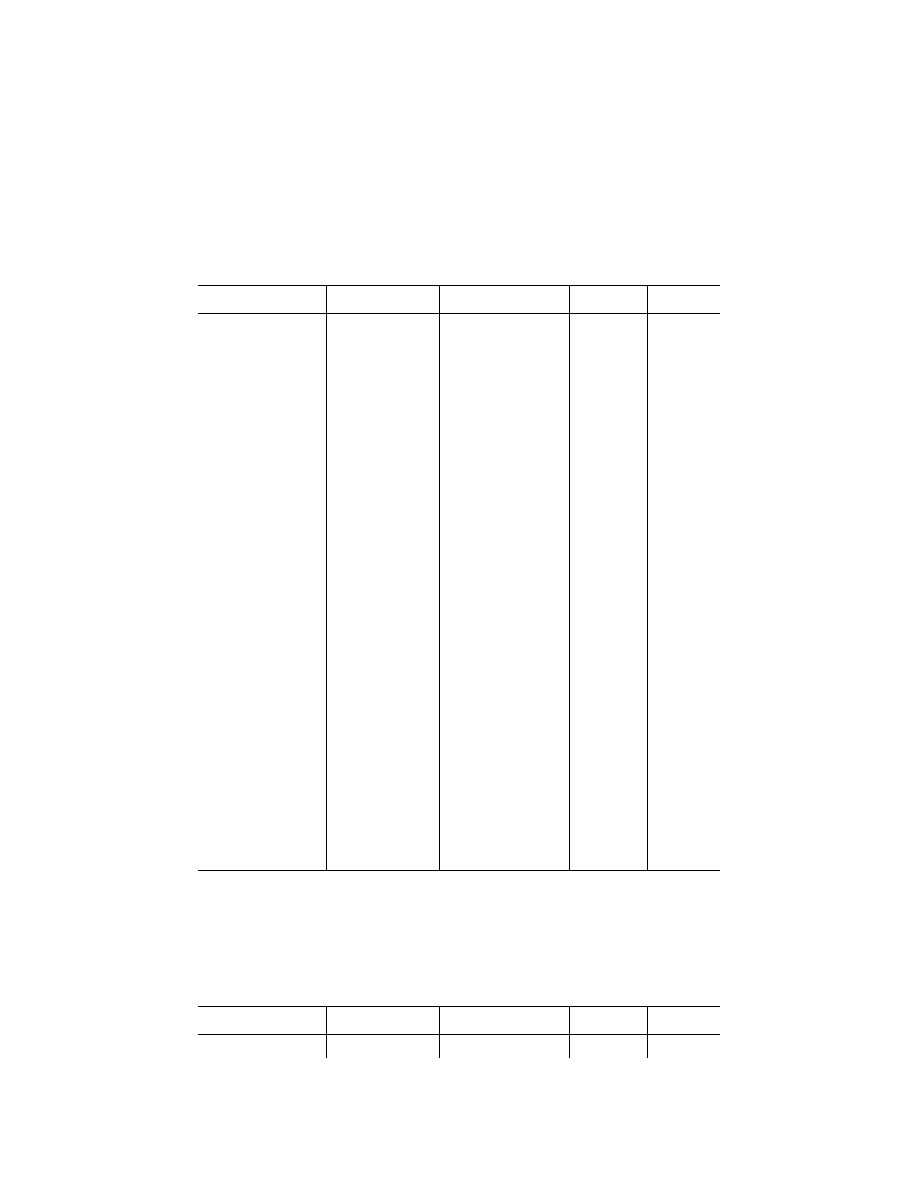
537
Federal Aviation Administration, DOT
Pt. 135, App. C
A
PPENDIX
B
TO
P
ART
135—A
IRPLANE
F
LIGHT
R
ECORDER
S
PECIFICATIONS
Parameters
Range
Installed system
1
minimum
accuracy (to recovered data)
Sampling inter-
val (per second)
Resolution
4
read out
Relative time (from recorded
on prior to takeoff).
25 hr minimum ...............
±
0.125% per hour .................
1 ........................
1 sec.
Indicated airspeed ..................
V
so
to V
D
(KIAS) .............
±
5% or
±
10 kts., whichever is
greater. Resolution 2 kts.
below 175 KIAS.
1 ........................
1%
3
.
Altitude ....................................
¥
1,000 ft. to max cert.
alt. of A/C.
±
100 to
±
700 ft. (see Table 1,
TSO C51–a).
1 ........................
25 to 150
Magnetic heading ...................
360
°
................................
±
5
°
.........................................
1 ........................
1
°
Vertical acceleration ...............
¥
3g to + 6g ...................
±
0.2g in addition to
±
0.3g
maximum datum.
4 (or 1 per sec-
ond where
peaks, ref. to
1g are re-
corded).
0.03g.
Longitudinal acceleration ........
±
1.0g ...............................
±
1.5% max. range excluding
datum error of
±
5%.
2 ........................
0.01g.
Pitch attitude ...........................
100% of usable ..............
±
2
°
.........................................
1 ........................
0.8
°
Roll attitude ............................
±
60
°
or 100% of usable
range, whichever is
greater.
±
2
°
.........................................
1 ........................
0.8
°
Stabilizer trim position ............
Full range .......................
±
3% unless higher uniquely
required.
1 ........................
1%
3
.
Or
Pitch control position ..............
Full range .......................
±
3% unless higher uniquely
required.
1 ........................
1%
3
.
Engine Power, Each Engine
Fan or N
1
speed or EPR or
cockpit indications used for
aircraft certification.
Maximum range ..............
±
5% .......................................
1 ........................
1%
3
.
Or
Prop. speed and torque (sam-
ple once/sec as close to-
gether as practicable).
.........................................
................................................
1 (prop speed),
1 (torque).
Altitude rate
2
(need depends
on altitude resolution).
±
8,000 fpm .....................
±
10%. Resolution 250 fpm
below 12,000 ft. indicated.
1 ........................
250 fpm Below
12,000
Angle of attack
2
(need de-
pends on altitude resolu-
tion).
¥
20
°
to 40
°
or of usable
range.
±
2
°
.........................................
1 ........................
0.8%
3
Radio transmitter keying (dis-
crete).
On/off ..............................
................................................
1.
TE flaps (discrete or analog) ..
Each discrete position
(U, D, T/O, AAP).
................................................
1.
Or.
Analog 0–100% range ....
±
3
°
.........................................
1 ........................
1%
3
LE flaps (discrete or analog) ..
Each discrete position
(U, D, T/O, AAP).
................................................
1.
Or.
Analog 0–100% range ....
±
3
°
.........................................
1 ........................
1%
3
.
Thrust reverser, each engine
(Discrete).
Stowed or full reverse ....
................................................
1.
Spoiler/speedbrake (discrete)
Stowed or out .................
................................................
1.
Autopilot engaged (discrete) ..
Engaged or disengaged
................................................
1.
1
When data sources are aircraft instruments (except altimeters) of acceptable quality to fly the aircraft the recording system
excluding these sensors (but including all other characteristics of the recording system) shall contribute no more than half of the
values in this column.
2
If data from the altitude encoding altimeter (100 ft. resolution) is used, then either one of these parameters should also be re-
corded. If however, altitude is recorded at a minimum resolution of 25 feet, then these two parameters can be omitted.
3
Per cent of full range.
4
This column applies to aircraft manufacturing after October 11, 1991.
[Doc. No. 25530, 53 FR 26152, July 11, 1988; 53 FR 30906, Aug. 16, 1988, as amended by Amdt. 135–
69, 62 FR 38397, July 17, 1997]
A
PPENDIX
C
TO
P
ART
135—H
ELICOPTER
F
LIGHT
R
ECORDER
S
PECIFICATIONS
Parameters
Range
Installed system
1
minimum
accuracy (to recovered data)
Sampling inter-
val (per second)
Resolution
3
read out
Relative time (from recorded
on prior to takeoff).
25 hr minimum ...............
±
0.125% per hour .................
1 ........................
1 sec.
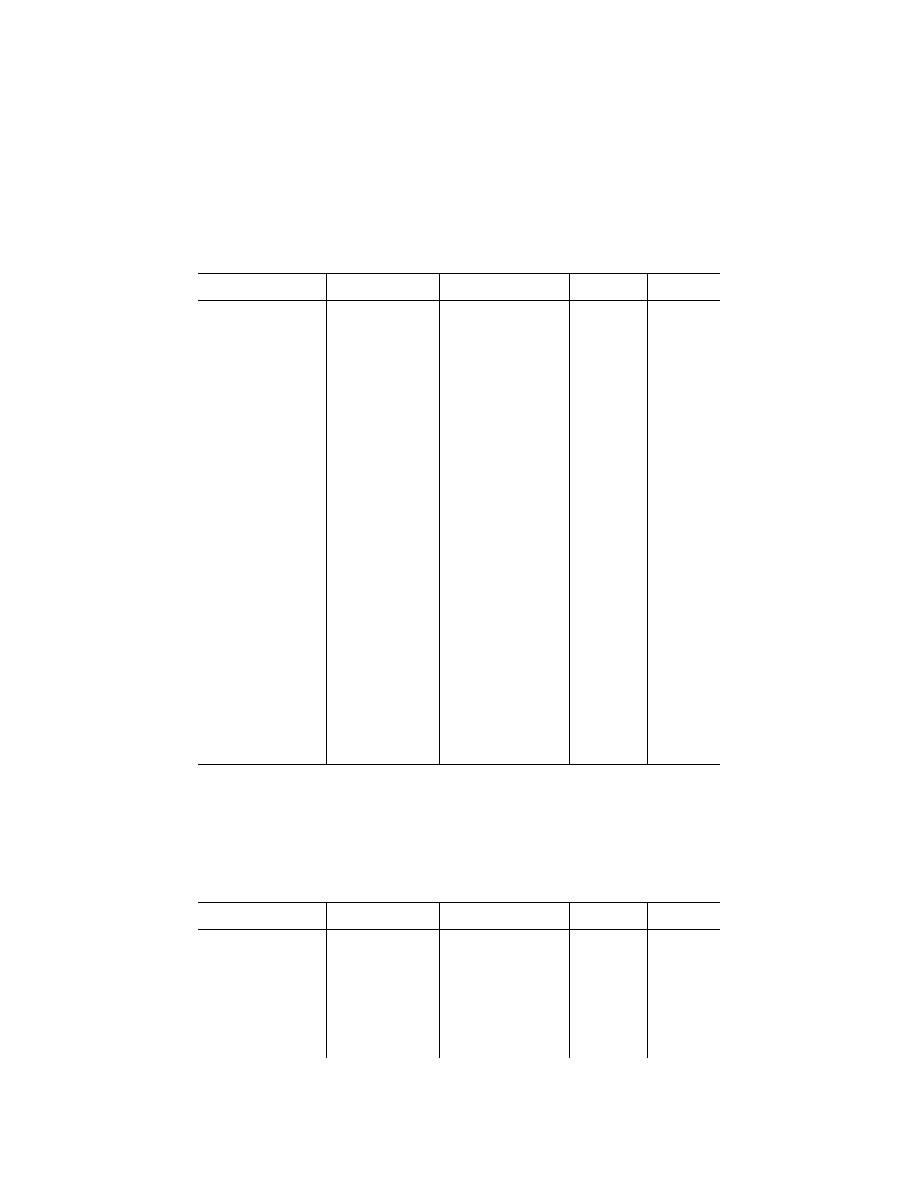
538
14 CFR Ch. I (1–1–24 Edition)
Pt. 135, App. D
Parameters
Range
Installed system
1
minimum
accuracy (to recovered data)
Sampling inter-
val (per second)
Resolution
3
read out
Indicated airspeed ..................
V
m
in to V
D
(KIAS) (min-
imum airspeed signal
attainable with installed
pilot-static system).
±
5% or
±
10 kts., whichever is
greater.
1 ........................
1 kt.
Altitude ....................................
¥
1,000 ft. to 20,000 ft.
pressure altitude.
±
100 to
±
700 ft. (see Table 1,
TSO C51–a).
1 ........................
25 to 150 ft.
Magnetic heading ...................
360
°
................................
±
5
°
.........................................
1 ........................
1
°
.
Vertical acceleration ...............
¥
3g to + 6g ...................
±
0.2g in addition to
±
0.3g
maximum datum.
4 (or 1 per sec-
ond where
peaks, ref. to
1g are re-
corded).
0.05g.
Longitudinal acceleration ........
±
1.0g ...............................
±
1.5% max. range excluding
datum error of
±
5%.
2 ........................
0.03g.
Pitch attitude ...........................
100% of usable range ....
±
2
°
.........................................
1 ........................
0.8
°
.
Roll attitude ............................
±
60
°
or 100% of usable
range, whichever is
greater.
±
2
°
.........................................
1 ........................
0.8
°
.
Altitude rate ............................
±
8,000 fpm .....................
±
10% Resolution 250 fpm
below 12,000 ft. indicated.
1 ........................
250 fpm below
12,000.
Engine Power, Each Engine
Main rotor speed ....................
Maximum range ..............
±
5% .......................................
1 ........................
1%
2
Free or power turbine .............
Maximum range ..............
+ 5% ......................................
1 ........................
1%
2
Engine torque .........................
Maximum range ..............
±
5% .......................................
1 ........................
1%
2
Flight Control—Hydraulic
Pressure
Primary (discrete) ...................
High/low ..........................
................................................
1.
Secondary—if applicable (dis-
crete).
High/low ..........................
................................................
1.
Radio transmitter keying (dis-
crete).
On/off ..............................
................................................
1.
Autopilot engaged (discrete) ..
Engaged or disengaged
................................................
1.
SAS status—engaged (dis-
crete).
Engaged/disengaged ......
................................................
1.
SAS fault status (discrete) .....
Fault/OK .........................
................................................
1.
Flight Controls
Collective
4
..............................
Full range .......................
±
3% .......................................
2 ........................
1%
2
Pedal Position
4
......................
Full range .......................
±
3% .......................................
2 ........................
1%
2
Lat. Cyclic
4
.............................
Full range .......................
±
3% .......................................
2 ........................
1%
2
Long. Cyclic
4
..........................
Full range .......................
±
3% .......................................
2 ........................
1%
2
Controllable Stabilator Posi-
tion
4
.
Full range .......................
±
3% .......................................
2 ........................
1%
2
1
When data sources are aircraft instruments (except altimeters) of acceptable quality to fly the aircraft the recording system
excluding these sensors (but including all other characteristics of the recording system) shall contribute no more than half of the
values in this column.
2
Per cent of full range.
3
This column applies to aircraft manufactured after October 11, 1991.
4
For all aircraft manufactured on or after December 6, 2010, the sampling interval per second is 4.
[Doc. No. 25530, 53 FR 26152, July 11, 1988; 53 FR 30906, Aug. 16, 1988, as amended by Amdt. 135–
69, 62 FR 38397, July 17, 1997; Amdt. 135–113, 73 FR 12570, Mar. 7, 2008; 73 FR 15281, Mar. 21, 2008;
Amdt. 135–121, 75 FR 17047, Apr. 5, 2010]
A
PPENDIX
D
TO
P
ART
135—A
IRPLANE
F
LIGHT
R
ECORDER
S
PECIFICATION
Parameters
Range
Accuracy sensor input to
DFDR readout
Sampling inter-
val (per second)
resolution
4
read
out
Time (GMT or Frame
Counter) (range 0 to 4095,
sampled 1 per frame).
24 Hrs .............................
±
0.125% Per Hour ................
0.25 (1 per 4
seconds).
1 sec.
Altitude ....................................
¥
1,000 ft to max certifi-
cated altitude of air-
craft.
±
100 to
±
700 ft (See Table 1,
TSO-C51a).
1 ........................
5
′
to 35
′
1
.
Airspeed .................................
50 KIAS to V
so
, and V
so
to 1.2 V
D
.
±
5%,
±
3% ..............................
1 ........................
1kt
Heading ..................................
360
°
................................
±
2
°
.........................................
1 ........................
0.5
°
Normal Acceleration (Vertical)
¥
3g to + 6g ...................
±
1% of max range excluding
datum error of
±
5%.
8 ........................
0.01g
Pitch Attitude ..........................
±
75
°
................................
±
2
°
.........................................
1 ........................
0.5
°

539
Federal Aviation Administration, DOT
Pt. 135, App. D
Parameters
Range
Accuracy sensor input to
DFDR readout
Sampling inter-
val (per second)
resolution
4
read
out
Roll Attitude ............................
±
180
°
..............................
±
2
°
.........................................
1 ........................
0.5
°
.
Radio Transmitter Keying .......
On-Off (Discrete) ............
................................................
1 ........................
Thrust/Power on Each Engine
Full range forward ..........
±
2% .......................................
1 (per engine) ...
0.2%
2
.
Trailing Edge Flap or Cockpit
Control Selection.
Full range or each dis-
crete position.
±
3
°
or as pilot’s indicator ......
0.5 .....................
0.5%
2
.
Leading Edge Flap on or
Cockpit Control Selection.
Full range or each dis-
crete position.
±
3
°
or as pilot’s indicator ......
0.5 .....................
0.5%
2
.
Thrust Reverser Position ........
Stowed, in transit, and
reverse (discretion).
................................................
1 (per 4 sec-
onds per en-
gine).
Ground Spoiler Position/
Speed Brake Selection.
Full range or each dis-
crete position.
±
2% unless higher accuracy
uniquely required.
1 ........................
0.22
2
.
Marker Beacon Passage ........
Discrete ..........................
................................................
1 ........................
Autopilot Engagement ............
Discrete ..........................
................................................
1 ........................
Longitudinal Acceleration .......
±
1g ..................................
±
1.5% max range excluding
datum error of
±
5%.
4 ........................
0.01g.
Pilot Input And/or Surface Po-
sition-Primary Controls
(Pitch, Roll, Yaw)
3
.
Full range .......................
±
2
°
unless higher accuracy
uniquely required.
1 ........................
0.2%
2
.
Lateral Acceleration ................
±
1g ..................................
±
1.5% max range excluding
datum error of
±
5%.
4 ........................
0.01g.
Pitch Trim Position .................
Full range .......................
±
3% unless higher accuracy
uniquely required.
1 ........................
0.3%
2
.
Glideslope Deviation ..............
±
400 Microamps .............
±
3% .......................................
1 ........................
0.3%
2
.
Localizer Deviation .................
±
400 Microamps .............
±
3% .......................................
1 ........................
0.3%
2
.
AFCS Mode And Engagement
Status.
Discrete ..........................
................................................
1 ........................
Radio Altitude .........................
¥
20 ft to 2,500 ft ...........
±
2 Ft or
±
3% whichever is
greater below 500 ft and
±
5% above 500 ft.
1 ........................
1 ft + 5%
2
above 500
′
.
Master Warning ......................
Discrete ..........................
................................................
1 ........................
Main Gear Squat Switch Sta-
tus.
Discrete ..........................
................................................
1 ........................
Angle of Attack (if recorded
directly).
As installed .....................
As installed ............................
2 ........................
0.3%
2
.
Outside Air Temperature or
Total Air Temperature.
¥
50
°
C to + 90
°
C .........
±
2
°
c ......................................
0.5 .....................
0.3
°
c
Hydraulics, Each System Low
Pressure.
Discrete ..........................
................................................
0.5 .....................
or 0.5%
2
.
Groundspeed ..........................
As installed .....................
Most accurate systems in-
stalled (IMS equipped air-
craft only).
1 ........................
0.2%
2
.
If additional recording capacity is available, recording of the following parameters is recommended. The parameters are listed in
order of significance:
Drift Angle ...............................
When available. As in-
stalled.
As installed ............................
4 ........................
Wind Speed and Direction .....
When available. As in-
stalled.
As installed ............................
4 ........................
Latitude and Longitude ...........
When available. As in-
stalled.
As installed ............................
4 ........................
Brake pressure/Brake pedal
position.
As installed .....................
As installed ............................
1 ........................
Additional engine parameters:
EPR .................................
As installed .....................
As installed ............................
1 (per engine) ...
N
1
....................................
As installed .....................
As installed ............................
1 (per engine) ...
N
2
....................................
As installed .....................
As installed ............................
1 (per engine) ...
EGT ........................................
As installed .....................
As installed ............................
1 (per engine) ...
Throttle Lever Position ...........
As installed .....................
As installed ............................
1 (per engine) ...
Fuel Flow ................................
As installed .....................
As installed ............................
1 (per engine) ...
TCAS:
TA ....................................
As installed .....................
As installed ............................
1 ........................
RA ...................................
As installed .....................
As installed ............................
1 ........................
Sensitivity level (as se-
lected by crew).
As installed .....................
As installed ............................
2 ........................
GPWS (ground proximity
warning system).
Discrete ..........................
................................................
1 ........................
Landing gear or gear selector
position.
Discrete ..........................
................................................
0.25 (1 per 4
seconds).
DME 1 and 2 Distance ...........
0–200 NM; ......................
As installed ............................
0.25 ...................
1mi.
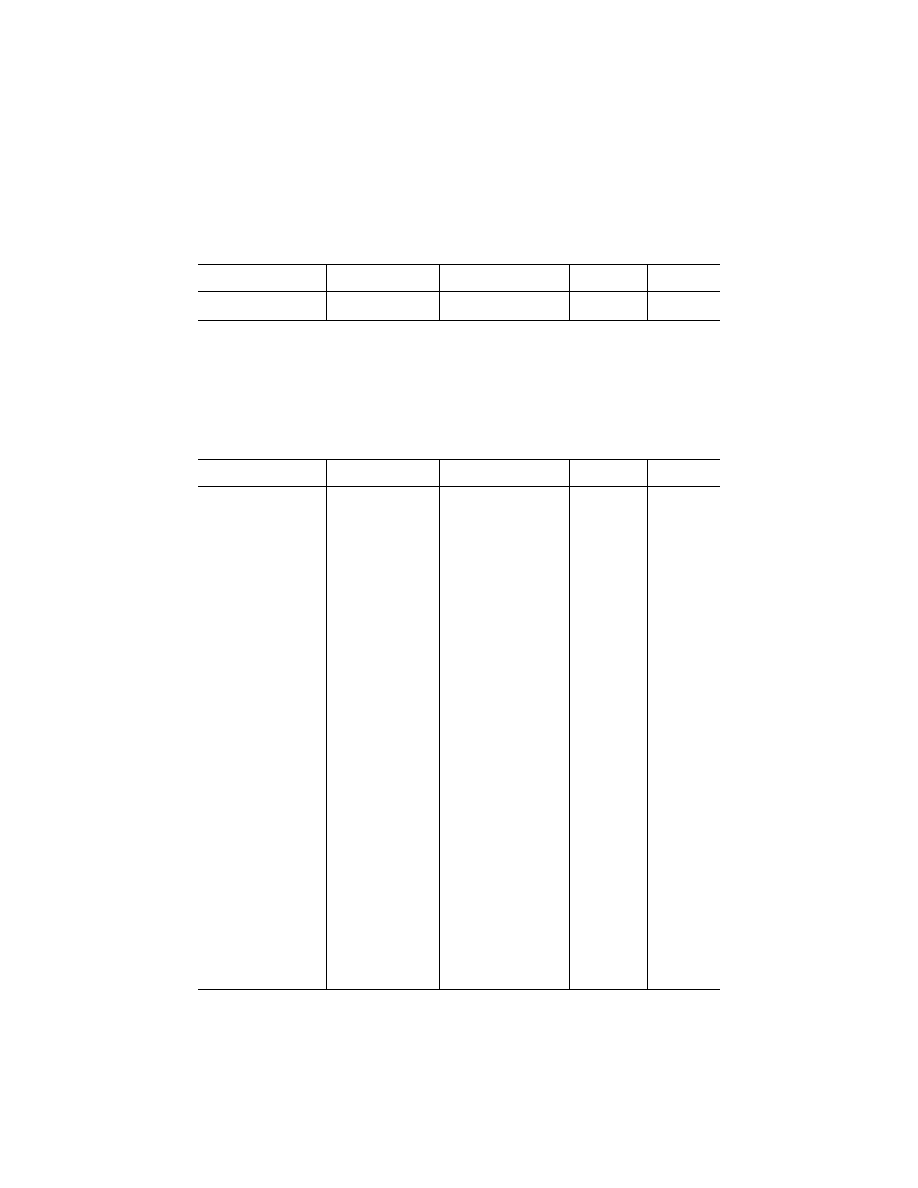
540
14 CFR Ch. I (1–1–24 Edition)
Pt. 135, App. E
Parameters
Range
Accuracy sensor input to
DFDR readout
Sampling inter-
val (per second)
resolution
4
read
out
Nav 1 and 2 Frequency Se-
lection.
Full range .......................
As installed ............................
0.25.
1
When altitude rate is recorded. Altitude rate must have sufficient resolution and sampling to permit the derivation of altitude to
5 feet.
2
Per cent of full range.
3
For airplanes that can demonstrate the capability of deriving either the control input on control movement (one from the
other) for all modes of operation and flight regimes, the ‘‘or’’ applies. For airplanes with non-mechanical control systems (fly-by-
wire) the ‘‘and’’ applies. In airplanes with split surfaces, suitable combination of inputs is acceptable in lieu of recording each sur-
face separately.
4
This column applies to aircraft manufactured after October 11, 1991.
[Doc. No. 25530, 53 FR 26153, July 11, 1988; 53 FR 30906, Aug. 16, 1988]
A
PPENDIX
E
TO
P
ART
135—H
ELICOPTER
F
LIGHT
R
ECORDER
S
PECIFICATIONS
Parameters
Range
Accuracy sensor input to
DFDR readout
Sampling inter-
val (per second)
Resolution
2
read out
Time (GMT) ............................
24 Hrs .............................
±
0.125% Per Hour ................
0.25 (1 per 4
seconds).
1 sec
Altitude ....................................
¥
1,000 ft to max certifi-
cated altitude of air-
craft.
±
100 to
±
700 ft (See Table 1,
TSO-C51a).
1 ........................
5
′
to 30
′
.
Airspeed .................................
As the installed meas-
uring system.
±
3% .......................................
1 ........................
1 kt
Heading ..................................
360
°
................................
±
2
°
.........................................
1 ........................
0.5
°
.
Normal Acceleration (Vertical)
¥
3g to + 6g ...................
±
1% of max range excluding
datum error of
±
5%.
8 ........................
0.01g
Pitch Attitude ..........................
±
75
°
................................
±
2
°
.........................................
2 ........................
0.5
°
Roll Attitude ............................
±
180
°
..............................
±
2
°
.........................................
2 ........................
0.5
°
.
Radio Transmitter Keying .......
On-Off (Discrete) ............
................................................
1 ........................
0.25 sec
Power in Each Engine: Free
Power Turbine Speed and
Engine Torque.
0–130% (power Turbine
Speed) Full range
(Torque).
±
2% .......................................
1 speed 1
torque (per
engine).
0.2%
1
to 0.4%
1
Main Rotor Speed ..................
0–130% ..........................
±
2% .......................................
2 ........................
0.3%
1
Altitude Rate ...........................
±
6,000 ft/min ...................
As installed ............................
2 ........................
0.2%
1
Pilot Input—Primary Controls
(Collective, Longitudinal Cy-
clic, Lateral Cyclic, Pedal)
3
.
Full range .......................
±
3% .......................................
2 ........................
0.5%
1
Flight Control Hydraulic Pres-
sure Low.
Discrete, each circuit ......
................................................
1 ........................
Flight Control Hydraulic Pres-
sure Selector Switch Posi-
tion, 1st and 2nd stage.
Discrete ..........................
................................................
1 ........................
AFCS Mode and Engagement
Status.
Discrete (5 bits nec-
essary).
................................................
1 ........................
Stability Augmentation System
Engage.
Discrete ..........................
................................................
1 ........................
SAS Fault Status ....................
Discrete ..........................
................................................
0.25 ...................
Main Gearbox Temperature
Low.
As installed .....................
As installed ............................
0.25 ...................
0.5%
1
Main Gearbox Temperature
High.
As installed .....................
As installed ............................
0.5 .....................
0.5%
1
Controllable Stabilator Posi-
tion.
Full Range ......................
±
3% .......................................
2 ........................
0.4%
1
.
Longitudinal Acceleration .......
±
1g ..................................
±
1.5% max range excluding
datum error of
±
5%.
4 ........................
0.01g.
Lateral Acceleration ................
±
1g ..................................
±
1.5% max range excluding
datum of
±
5%.
4 ........................
0.01g.
Master Warning ......................
Discrete ..........................
................................................
1 ........................
Nav 1 and 2 Frequency Se-
lection.
Full range .......................
As installed ............................
0.25 ...................
Outside Air Temperature ........
¥
50
°
C to + 90
°
C .........
±
2
°
c ......................................
0.5 .....................
0.3
°
c
1
Per cent of full range.
2
This column applies to aircraft manufactured after October 11, 1991.
3
For all aircraft manufactured on or after December 6, 2010, the sampling interval per second is 4.
[Doc. No. 25530, 53 FR 26154, July 11, 1988; 53 FR 30906, Aug. 16, 1988; Amdt. 135–113, 73 FR 12571,
Mar. 7, 2008; 73 FR 15281, Mar. 21, 2008; Amdt. 135–121, 75 FR 17047, Apr. 5, 2010]
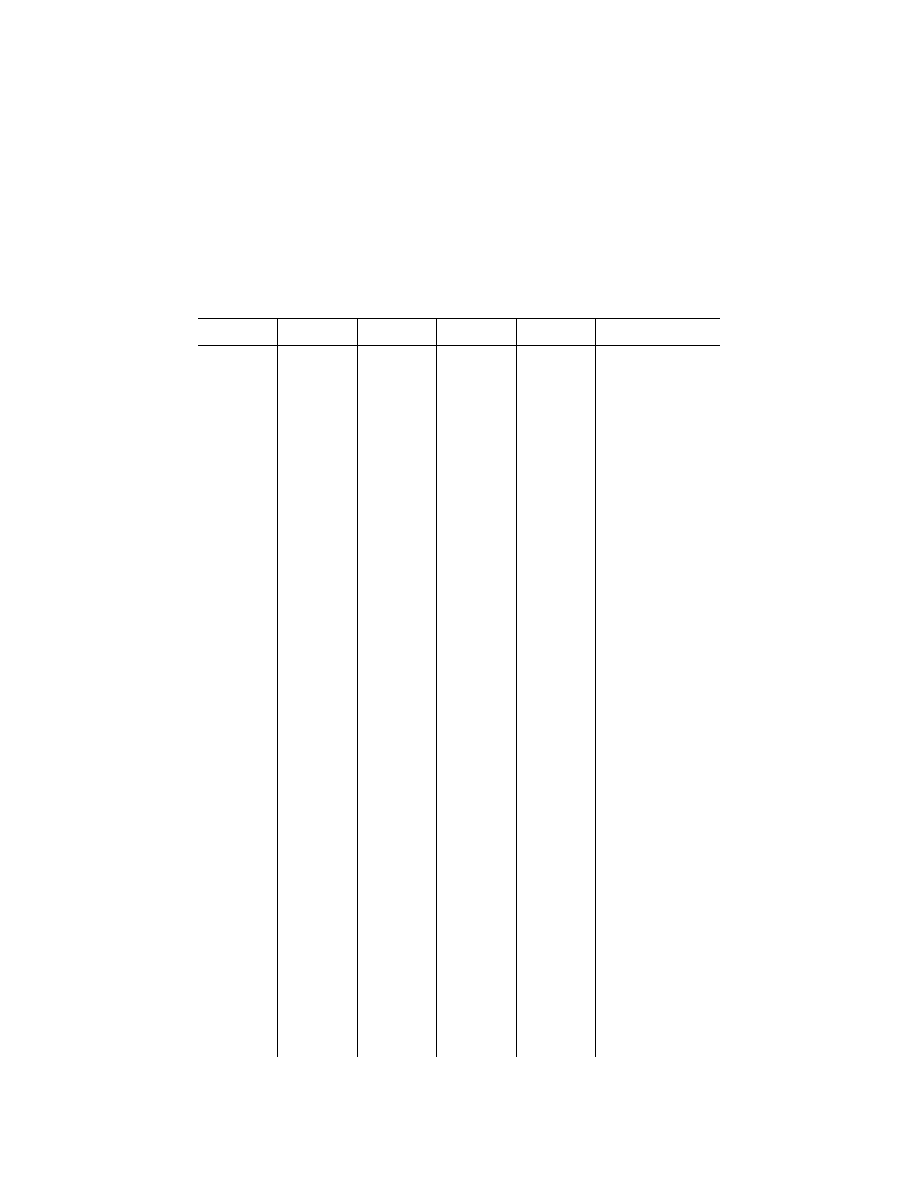
541
Federal Aviation Administration, DOT
Pt. 135, App. F
A
PPENDIX
F
TO
P
ART
135—A
IRPLANE
F
LIGHT
R
ECORDER
S
PECIFICATION
The recorded values must meet the designated range, resolution and accuracy requirements during static and dynamic condi-
tions. Dynamic condition means the parameter is experiencing change at the maximum rate attainable, including the maximum
rate of reversal. All data recorded must be correlated in time to within one second.
Parameters
Range
Accuracy (sensor
input)
Seconds per
sampling interval
Resolution
Remarks
1. Time or Rel-
ative Time
Counts
1
.
24 Hrs, 0 to
4095.
±
0.125% Per
Hour.
4 ........................
1 sec .................
UTC time preferred when
available. Counter incre-
ments each 4 seconds of
system operation.
2. Pressure Alti-
tude.
¥
1000 ft to max
certificated alti-
tude of aircraft.
+ 5000 ft.
±
100 to
±
700 ft
(see table,
TSO C124a or
TSO C51a).
1 ........................
5
′
to 35
″
.............
Data should be obtained
from the air data computer
when practicable.
3. Indicated air-
speed or Cali-
brated airspeed.
50 KIAS or min-
imum value to
Max V
so
ü
and
V
so
to 1.2 V.
D
.
±
5% and
±
3% ....
1 ........................
1 kt ....................
Data should be obtained
from the air data computer
when practicable.
4. Heading (Pri-
mary flight crew
reference).
0
¥
360
°
and Dis-
crete ‘‘true’’ or
‘‘mag’’.
±
2
°
.....................
1 ........................
0.5
°
....................
When true or magnetic head-
ing can be selected as the
primary heading reference,
a discrete indicating selec-
tion must be recorded.
5. Normal Accel-
eration
(Vertical)
9
.
¥
3g to + 6g ......
±
1% of max
range exclud-
ing datum
error of
±
5%.
0.125 .................
0.004g
6. Pitch Attitude ..
±
75% .................
±
2
°
.....................
1 or 0.25 for air-
planes oper-
ated under
§ 135.152(j).
0.5
°
....................
A sampling rate of 0.25 is
recommended.
7. Roll Attitude
2
..
±
180
°
.................
±
2
°
.....................
1 or 0.5 0.5 air-
planes oper-
ated under
§ 135.152(j).
0.5
°
....................
A sampling rate of 0.5 is rec-
ommended.
8. Manual Radio
Transmitter
Keying or CVR/
DFDR synchro-
nization ref-
erence.
On-Off (Discrete)
None ..................
...........................
1 ........................
...........................
Preferably each crew mem-
ber but one discrete ac-
ceptable for all trans-
mission provided the CVR/
FDR system complies with
TSO C124a CVR synchro-
nization requirements
(paragraph 4.2.1 ED–55).
9. Thrust/Power
on each en-
gine—primary
flight crew ref-
erence.
Full Range For-
ward.
±
2% ...................
1 (per engine) ...
0.3% of full
range.
Sufficient parameters (e.g.
EPR, N1 or Torque, NP)
as appropriate to the par-
ticular engine being re-
corded to determine power
in forward and reverse
thrust, including potential
overspeed condition.
10. Autopilot En-
gagement.
Discrete ‘‘on’’ or
‘‘off’’.
...........................
1 ........................
11. Longitudinal
Acceleration.
±
1g ....................
±
1.5% max.
range exclud-
ing datum
error of
±
5%.
0.25 ...................
0.004g.
12a. Pitch con-
trol(s) position
(nonfly-by-wire
systems)
18
.
Full Range .........
±
2
°
unless high-
er accuracy
uniquely re-
quired.
0.5 or 0.25 for
airplanes oper-
ated under
§ 135.152(j).
0.5% of full
range.
For airplanes that have a
flight control breakaway
capability that allows either
pilot to operate the controls
independently, record both
control inputs. The control
inputs may be sampled al-
ternately once per second
to produce the sampling in-
terval of 0.5 or 0.25, as ap-
plicable.
12b. Pitch con-
trol(s) position
(fly-by-wire sys-
tems)
318
.
Full Range .........
±
2
°
unless high-
er accuracy
uniquely re-
quired.
0.5 or 0.25 for
airplanes oper-
ated under
§ 135.152(j).
0.2% of full
range.
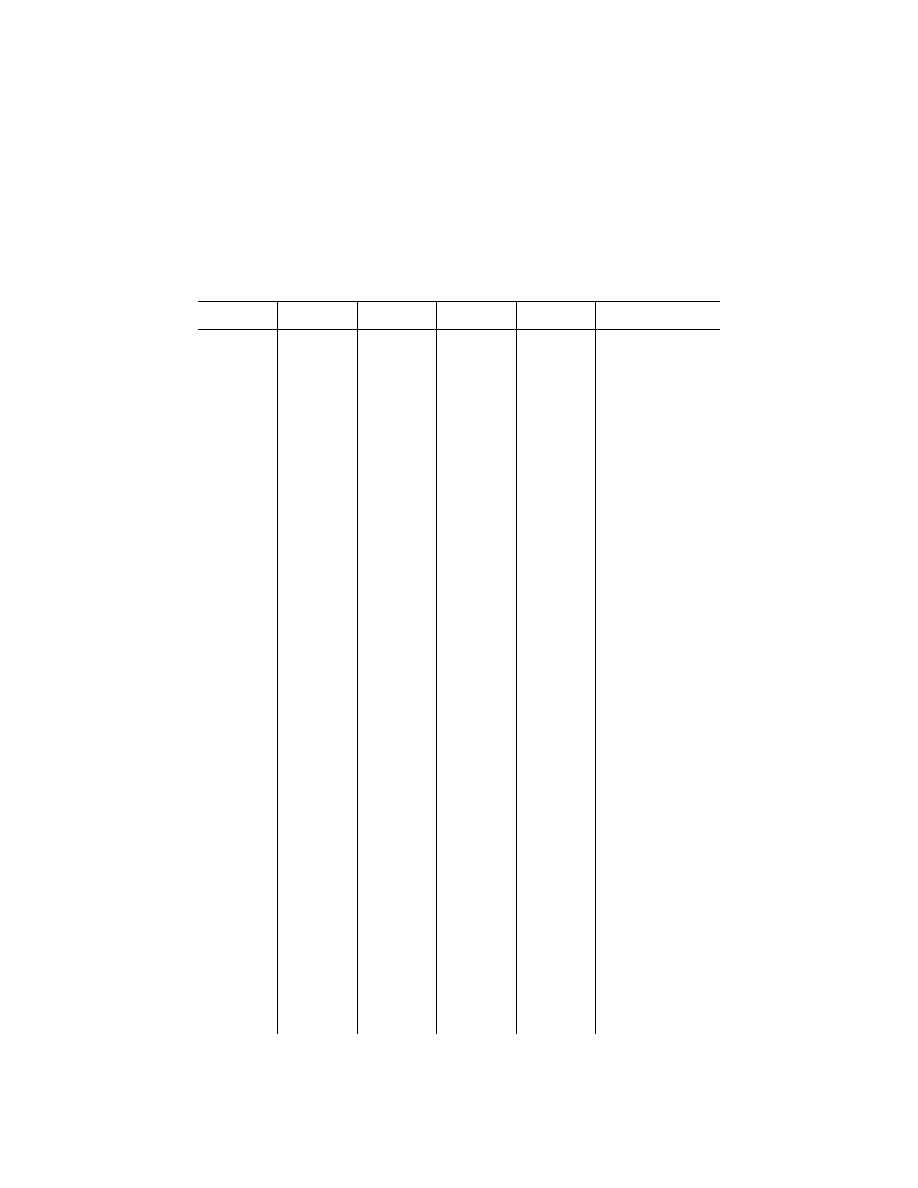
542
14 CFR Ch. I (1–1–24 Edition)
Pt. 135, App. F
The recorded values must meet the designated range, resolution and accuracy requirements during static and dynamic condi-
tions. Dynamic condition means the parameter is experiencing change at the maximum rate attainable, including the maximum
rate of reversal. All data recorded must be correlated in time to within one second.
Parameters
Range
Accuracy (sensor
input)
Seconds per
sampling interval
Resolution
Remarks
13a. Lateral con-
trol position(s)
(nonfly-by-
wire)
18
.
Full Range .........
±
2
°
unless high-
er accuracy
uniquely re-
quired.
0.5 or 0.25 for
airplanes oper-
ated under
§ 135.152(j).
0.2% of full
range.
For airplanes that have a
flight control breakaway
capability that allows either
pilot to operate the controls
independently, record both
control inputs. The control
inputs may be sampled al-
ternately once per second
to produce the sampling in-
terval of 0.5 or 0.25, as ap-
plicable.
13b. Lateral con-
trol position(s)
(fly-by-wire)
418
.
Full Range .........
±
2
°
unless high-
er accuracy
uniquely re-
quired.
0.5 or 0.25 for
airplanes oper-
ated under
§ 135.152(j).
0.2% of full
range.
14a. Yaw control
position(s)
(nonfly-by-
wire)
518
.
Full Range .........
±
2
°
unless high-
er accuracy
uniquely re-
quired.
0.5 .....................
0.3% of full
range.
For airplanes that have a
flight control breakaway
capability that allows either
pilot to operate the controls
independently, record both
control inputs. The control
inputs may be sampled al-
ternately once per second
to produce the sampling of
0.5 or 0.25, as applicable.
14b. Yaw control
position(s) (fly-
by-wire)
18
.
Full Range .........
±
2
°
unless high-
er accuracy
uniquely re-
quired.
0.5 .....................
0.2% of full
range.
15. Pitch control
surface(s) posi-
tion
618
.
Full Range .........
±
2
°
unless high-
er accuracy
uniquely re-
quired.
0.5 or 0.25 for
airplanes oper-
ated under
§ 135.152(j)..
0.3% of full
range.
For airplanes fitted with mul-
tiple or split surfaces, a
suitable combination of in-
puts is acceptable in lieu of
recording each surface
separately. The control
surfaces may be sampled
alternately to produce the
sampling interval of 0.5 or
0.25, as applicable.
16. Lateral control
surface(s) posi-
tion
718
.
Full Range .........
±
2
°
unless high-
er accuracy
uniquely re-
quired.
0.5 or 0.25 for
airplanes oper-
ated under
§ 135.152(j).
0.2% of full
range.
A suitable combination of
surface position sensors is
acceptable in lieu of re-
cording each surface sepa-
rately. The control surfaces
may be sampled alter-
nately to produce the sam-
pling interval of 0.5 or
0.25, as applicable.
17. Yaw control
surface(s) posi-
tion
818
.
Full Range .........
±
2
°
unless high-
er accuracy
uniquely re-
quired.
0.5 .....................
0.2% of full
range.
For airplanes with multiple or
split surfaces, a suitable
combination of surface po-
sition sensors is accept-
able in lieu of recording
each surface separately.
The control surfaces may
be sampled alternately to
produce the sampling inter-
val of 0.5.
18. Lateral Accel-
eration.
±
1g ....................
±
1.5% max.
range exclud-
ing datum
error of
±
5%.
0.25 ...................
0.004g.
19. Pitch Trim
Surface Posi-
tion.
Full Range .........
±
3
°
Unless High-
er Accuracy
Uniquely Re-
quired.
1 ........................
0.6% of full
range
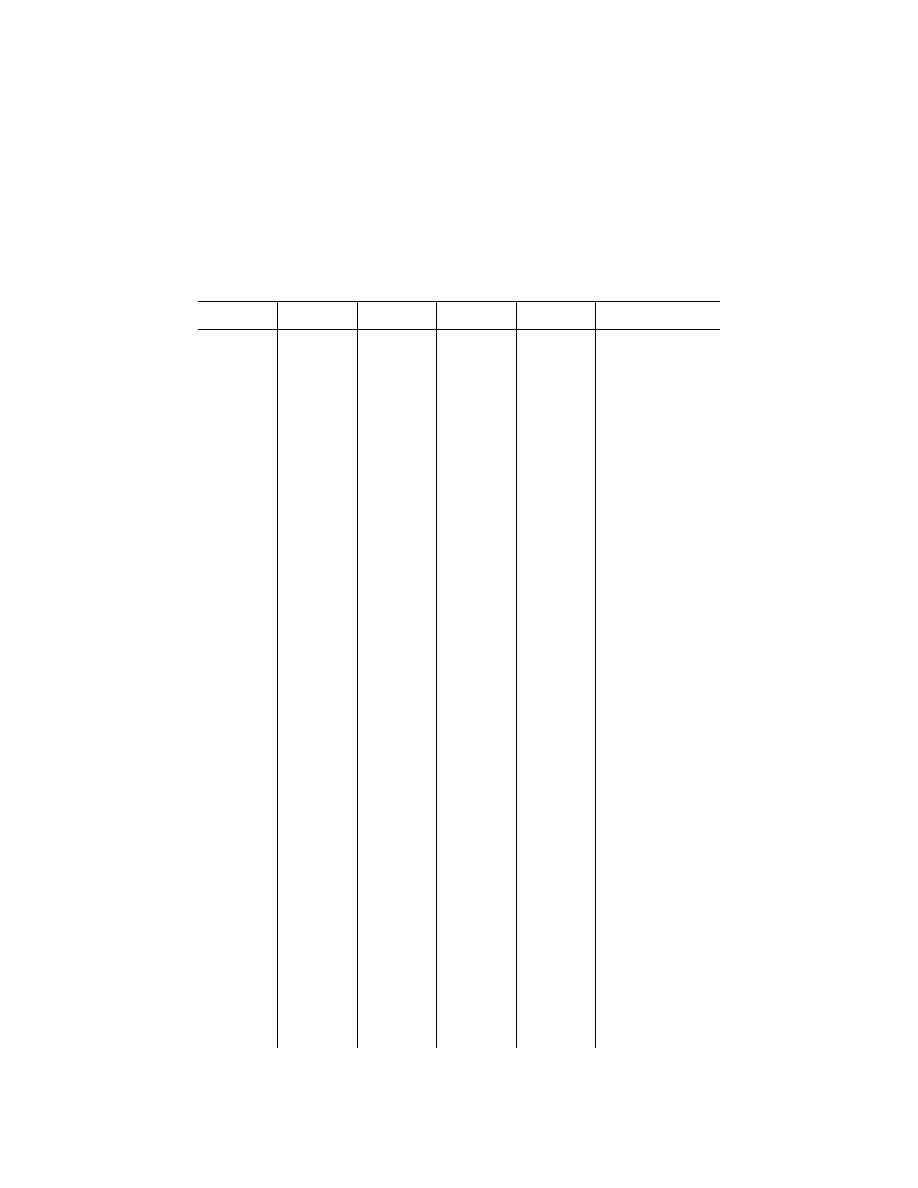
543
Federal Aviation Administration, DOT
Pt. 135, App. F
The recorded values must meet the designated range, resolution and accuracy requirements during static and dynamic condi-
tions. Dynamic condition means the parameter is experiencing change at the maximum rate attainable, including the maximum
rate of reversal. All data recorded must be correlated in time to within one second.
Parameters
Range
Accuracy (sensor
input)
Seconds per
sampling interval
Resolution
Remarks
20. Trailing Edge
Flap or Cockpit
Control Selec-
tion
10
.
Full Range or
Each Position
(discrete).
±
3
°
or as Pilot’s
Indicator.
2 ........................
0.5% of full
range.
Flap position and cockpit
control may each be sam-
pled alternately at 4 sec-
ond intervals, to give a
data point every 2 sec-
onds.
21. Leading Edge
Flap or Cockpit
Control Selec-
tion
11
.
Full Range or
Each Discrete
Position.
±
3
°
or as Pilot’s
Indicator and
sufficient to
determine
each discrete
position.
2 ........................
0.5% of full
range.
Left and right sides, of flap
position and cockpit control
may each be sampled at 4
second intervals, so as to
give a data point to every
2 seconds.
22. Each Thrust
reverser Posi-
tion (or equiva-
lent for pro-
peller airplane).
Stowed, In Tran-
sit, and re-
verse (Dis-
crete).
...........................
1 (per engine .....
...........................
Turbo-jet—2 discretes enable
the 3 states to be deter-
mined
Turbo-prop—1 discrete
23. Ground Spoil-
er Position or
Speed Brake
Selection
12
.
Full Range or
Each Position
(discrete).
±
2
°
Unless High-
er Accuracy
Uniquely Re-
quired.
1 or 0.5 for air-
planes oper-
ated under
§ 135.152(j).
0.5% of full
range
24. Outside Air
Temperature or
Total Air Tem-
perature
13
.
¥
50
°
C to + 90
°
C.
±
2
°
C .................
2 ........................
0.3
°
C
25. Autopilot/
Autothrottle/
AFCS Mode
and Engage-
ment Status.
A suitable com-
bination of
discretes.
...........................
1 ........................
...........................
Discretes should show which
systems are engaged and
which primary modes are
controlling the flight path
and speed of the aircraft.
26. Radio Alti-
tude
14
.
¥
20 ft to 2,500
ft.
±
2 ft or
±
3%
Whichever is
Greater Below
500 ft and
±
5% Above
500 ft.
1 ........................
1 ft + 5% above
500 ft.
For autoland/category 3 op-
erations. Each radio altim-
eter should be recorded,
but arranged so that at
least one is recorded each
second.
27. Localizer De-
viation, MLS
Azimuth, or
GPS Lateral
Deviation.
±
400 Microamps
or available
sensor range
as installed
±
62
°
.
As installed
±
3%
recommended..
1 ........................
0.3% of full
range.
For autoland/category 3 op-
erations. Each system
should be recorded but ar-
ranged so that at least one
is recorded each second. It
is not necessary to record
ILS and MLS at the same
time, only the approach aid
in use need be recorded.
28. Glideslope
Deviation, MLS
Elevation, or
GPS Vertical
Deviation.
±
400 Microamps
or available
sensor range
as installed.
0.9 to + 30
°
.......
As installed
±
3%
recommended.
1 ........................
0.3% of full
range.
For autoland/category 3 op-
erations. Each system
should be recorded but ar-
ranged so that at least one
is recorded each second. It
is not necessary to record
ILS and MLS at the same
time, only the approach aid
in use need be recorded.
29. Marker Bea-
con Passage.
Discrete ‘‘on’’ or
‘‘off’’.
...........................
1 ........................
...........................
A single discrete is accept-
able for all markers.
30. Master Warn-
ing.
Discrete .............
...........................
1 ........................
...........................
Record the master warning
and record each ‘‘red’’
warning that cannot be de-
termined from other pa-
rameters or from the cock-
pit voice recorder.
31. Air/ground
sensor (primary
airplane system
reference nose
or main gear).
Discrete ‘‘air’’ or
‘‘ground’’.
...........................
1 (0.25 rec-
ommended.).
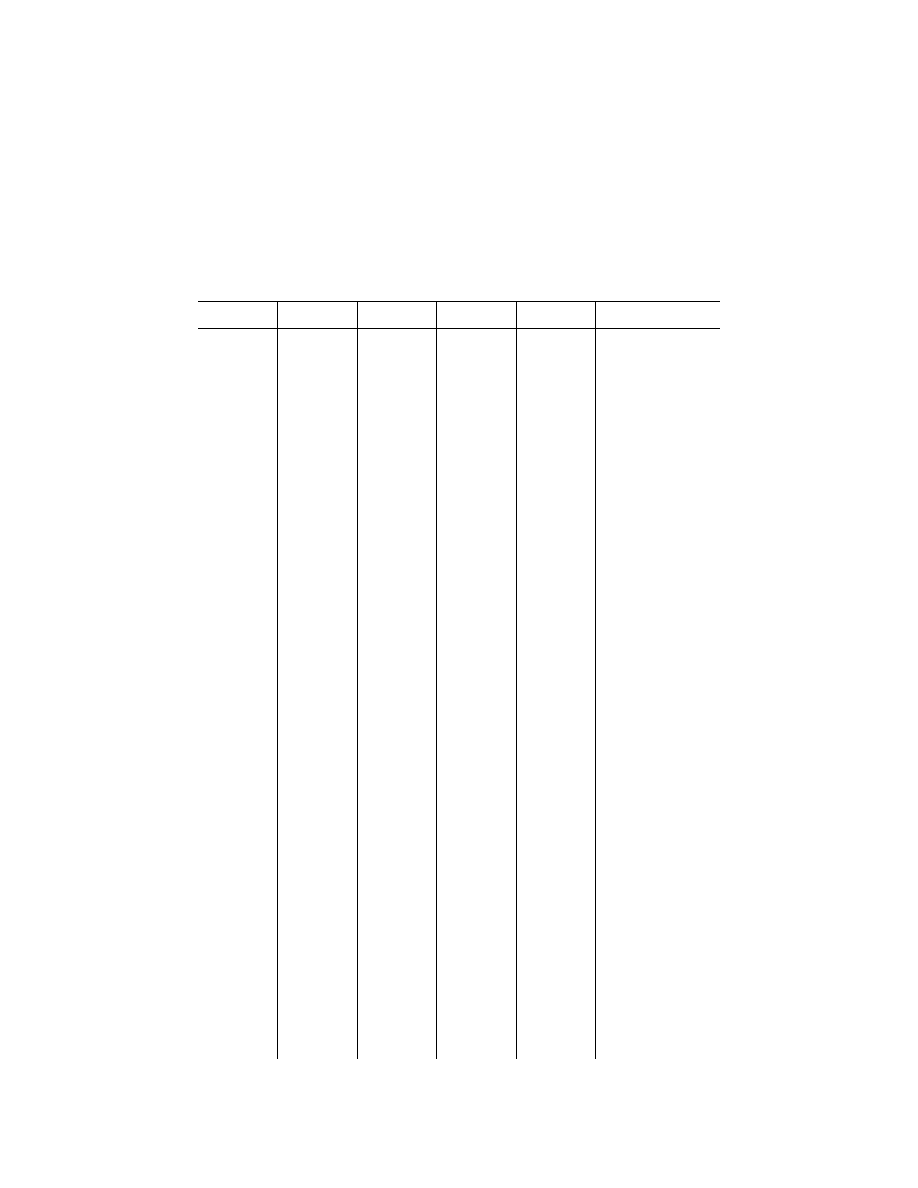
544
14 CFR Ch. I (1–1–24 Edition)
Pt. 135, App. F
The recorded values must meet the designated range, resolution and accuracy requirements during static and dynamic condi-
tions. Dynamic condition means the parameter is experiencing change at the maximum rate attainable, including the maximum
rate of reversal. All data recorded must be correlated in time to within one second.
Parameters
Range
Accuracy (sensor
input)
Seconds per
sampling interval
Resolution
Remarks
32. Angle of At-
tack (If meas-
ured directly).
As installed ........
As installed ........
2 or 0.5 for air-
planes oper-
ated under
§ 135.152(j).
0.3% of full
range.
If left and right sensors are
available, each may be re-
corded at 4 or 1 second in-
tervals, as appropriate, so
as to give a data point at 2
seconds or 0.5 second, as
required.
33. Hydraulic
Pressure Low,
Each System.
Discrete or avail-
able sensor
range, ‘‘low’’ or
‘‘normal’’.
±
5% ...................
2 ........................
0.5% of full
range.
34. Groundspeed
As installed ........
Most Accurate
Systems In-
stalled.
1 ........................
0.2% of full
range.
35. GPWS
(ground prox-
imity warning
system).
Discrete ‘‘warn-
ing’’ or ‘‘off’’.
...........................
1 ........................
...........................
A suitable combination of
discretes unless recorder
capacity is limited in which
case a single discrete for
all modes is acceptable.
36. Landing Gear
Position or
Landing gear
cockpit control
selection.
Discrete .............
...........................
4 ........................
...........................
A suitable combination of
discretes should be re-
corded.
37. Drift Angle
15
As installed ........
As installed ........
4 ........................
0.1
°
38. Wind Speed
and Direction.
As installed ........
As installed ........
4
1 knot, and 1.0
°
.
39. Latitude and
Longitude.
As installed ........
As installed ........
4 ........................
0.002
°
, or as in-
stalled.
Provided by the Primary
Navigation System Ref-
erence. Where capacity
permits latitude/longitude
resolution should be
0.0002
°
.
40. Stick shaker
and pusher acti-
vation.
Discrete(s) ‘‘on’’
or ‘‘off’’.
...........................
1 ........................
...........................
A suitable combination of
discretes to determine acti-
vation.
41. Windshear
Detection.
Discrete ‘‘warn-
ing’’ or ‘‘off’’.
...........................
1.
42. Throttle/power
lever position
16
.
Full Range .........
±
2% ...................
1 for each lever
2% of full range
For airplanes with non-me-
chanically linked cockpit
engine controls.
43. Additional En-
gine Param-
eters.
As installed ........
As installed ........
Each engine
each second.
2% of full range
Where capacity permits, the
preferred priority is indi-
cated vibration level, N2,
EGT, Fuel Flow, Fuel Cut-
off lever position and N3,
unless engine manufac-
turer recommends other-
wise.
44. Traffic Alert
and Collision
Avoidance Sys-
tem (TCAS).
Discretes ...........
As installed ........
1 ........................
...........................
A suitable combination of
discretes should be re-
corded to determine the
status of—Combined Con-
trol, Vertical Control, Up
Advisory, and down advi-
sory. (ref. ARINC Char-
acteristic 735 Attachment
6E, TCAS VERTICAL RA
DATA OUTPUT WORD.)
45. DME 1 and 2
Distance.
0–200 NM; ........
As installed ........
4 ........................
1 NM .................
1 mile.
46. Nav 1 and 2
Selected Fre-
quency.
Full range ..........
As installed ........
4 ........................
...........................
Sufficient to determine se-
lected frequency.
47. Selected baro-
metric setting.
Full Range .........
±
5% ...................
(1 per 64 sec.) ..
0.2% of full
range.
48. Selected alti-
tude.
Full Range .........
±
5% ...................
1 ........................
100 ft.
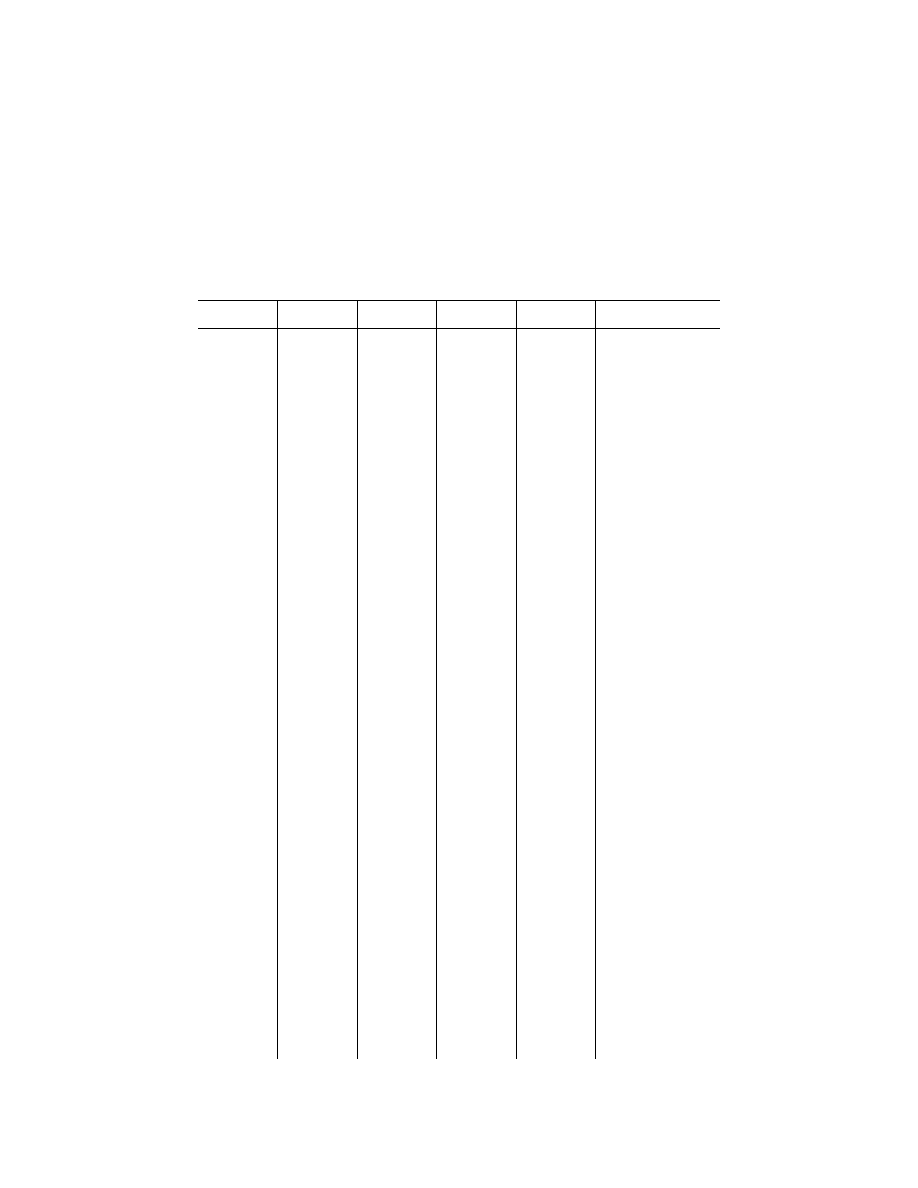
545
Federal Aviation Administration, DOT
Pt. 135, App. F
The recorded values must meet the designated range, resolution and accuracy requirements during static and dynamic condi-
tions. Dynamic condition means the parameter is experiencing change at the maximum rate attainable, including the maximum
rate of reversal. All data recorded must be correlated in time to within one second.
Parameters
Range
Accuracy (sensor
input)
Seconds per
sampling interval
Resolution
Remarks
49. Selected
speed.
Full Range .........
±
5% ...................
1 ........................
1 knot.
50. Selected
Mach.
Full Range .........
±
5% ...................
1 ........................
.01.
51. Selected
vertical speed.
Full Range .........
±
5% ...................
1 ........................
100 ft./min.
52. Selected
heading.
Full Range .........
±
5% ...................
1 ........................
1
°
.
53. Selected flight
path.
Full Range .........
±
5% ...................
1 ........................
1
°
.
54. Selected deci-
sion height.
Full Range .........
±
5% ...................
64 ......................
1 ft.
55. EFIS display
format.
Discrete(s) .........
...........................
4 ........................
...........................
Discretes should show the
display system status (e.g.,
off, normal, fail, composite,
sector, plan, nav aids,
weather radar, range,
copy.
56. Multi-function/
Engine Alerts
Display format.
Discrete(s) .........
...........................
4 ........................
...........................
Discretes should show the
display system status (e.g.,
off, normal, fail, and the
identity of display pages
for emergency procedures,
need not be recorded.
57. Thrust
comand
17
.
Full Range .........
±
2% ...................
2 ........................
2% of full range
58. Thrust target
Full Range .........
±
2% ...................
4 ........................
2% of full range.
59. Fuel quantity
in CG trim tank.
Full Range .........
±
5% ...................
(1 per 64 sec.) ..
1% of full range.
60. Primary Navi-
gation System
Reference.
Discrete GPS,
INS, VOR/
DME, MLS,
Localizer
Glideslope.
...........................
4 ........................
...........................
A suitable combination of
discretes to determine the
Primary Navigation System
reference.
61. Ice Detection
Discrete ‘‘ice’’ or
‘‘no ice’’.
...........................
4.
62. Engine warn-
ing each engine
vibration.
Discrete .............
...........................
1.
63. Engine warn-
ing each engine
over temp..
Discrete .............
...........................
1.
64. Engine warn-
ing each engine
oil pressure low.
Discrete .............
...........................
1.
65. Engine warn-
ing each engine
over speed.
Discrete .............
...........................
1.
66. Yaw Trim Sur-
face Position.
Full Range .........
±
3% Unless
Higher Accu-
racy Uniquely
Required.
2 ........................
0.3% of full
range.
67. Roll Trim Sur-
face Position.
Full Range .........
±
3% Unless
Higher Accu-
racy Uniquely
Required.
2 ........................
0.3% of full
range.
68. Brake Pres-
sure (left and
right).
As installed ........
±
5% ...................
1 ........................
...........................
To determine braking effort
applied by pilots or by
autobrakes.
69. Brake Pedal
Application (left
and right).
Discrete or Ana-
log ‘‘applied’’
or ‘‘off’’.
±
5% (Analog) ....
1 ........................
...........................
To determine braking applied
by pilots.
70. Yaw or side-
slip angle.
Full Range .........
±
5% ...................
1 ........................
0.5
°
.
71. Engine bleed
valve position.
Discrete ‘‘open’’
or ‘‘closed’’.
...........................
4.
72. De-icing or
anti-icing sys-
tem selection.
Discrete ‘‘on’’ or
‘‘off’’.
...........................
4.
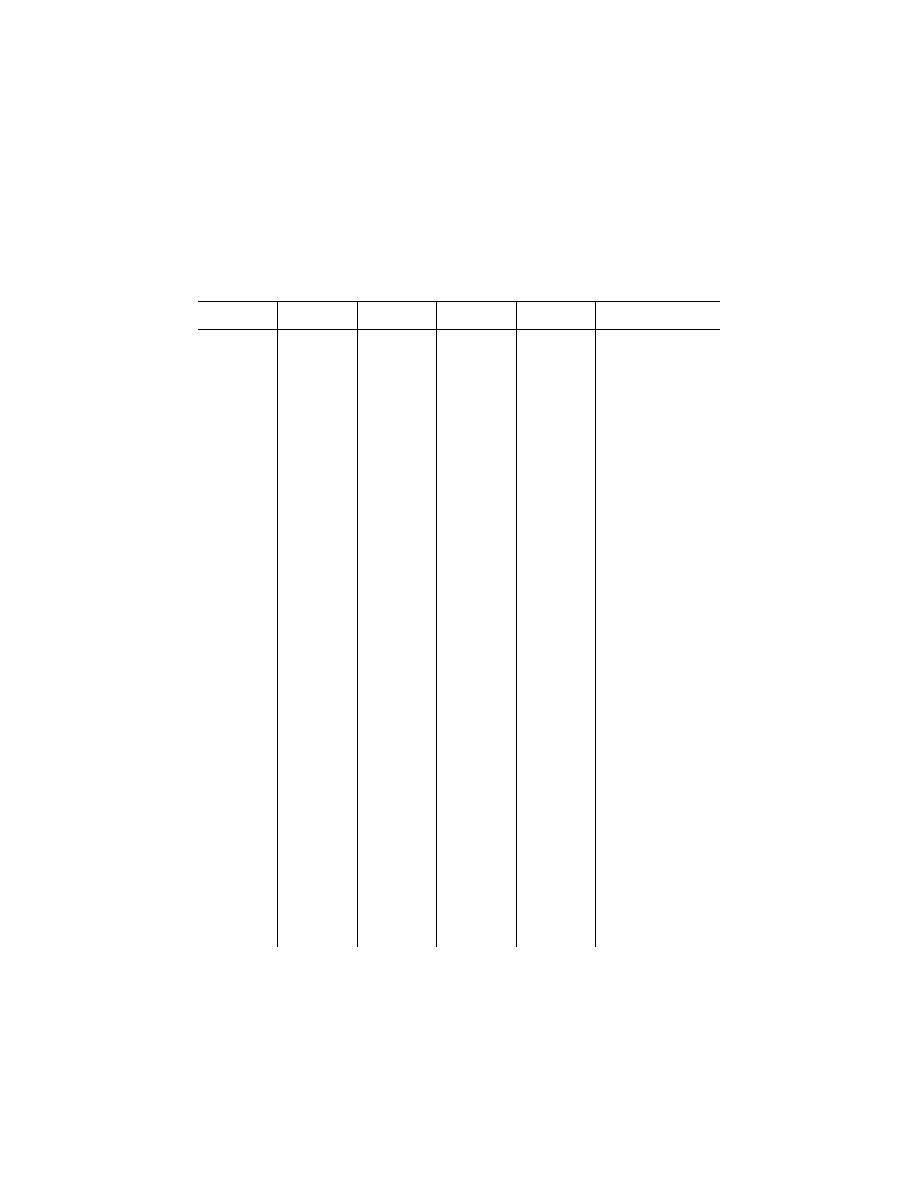
546
14 CFR Ch. I (1–1–24 Edition)
Pt. 135, App. F
The recorded values must meet the designated range, resolution and accuracy requirements during static and dynamic condi-
tions. Dynamic condition means the parameter is experiencing change at the maximum rate attainable, including the maximum
rate of reversal. All data recorded must be correlated in time to within one second.
Parameters
Range
Accuracy (sensor
input)
Seconds per
sampling interval
Resolution
Remarks
73. Computed
center of gravity.
Full Range .........
±
5% ...................
(1 per 64 sec.) ..
1% of full range.
74. AC electrical
bus status.
Discrete ‘‘power’’
or ‘‘off’’.
...........................
4 ........................
...........................
Each bus.
75. DC electrical
bus status.
Discrete ‘‘power’’
or ‘‘off’’.
...........................
4 ........................
...........................
Each bus.
76. APU bleed
valve position.
Discrete ‘‘open’’
or ‘‘closed’’.
...........................
4.
77. Hydraulic
Pressure (each
system).
Full range ..........
±
5% ...................
2 ........................
100 psi.
78. Loss of cabin
pressure.
Discrete ‘‘loss’’
or ‘‘normal’’.
...........................
1.
79. Computer fail-
ure (critical
flight and en-
gine control
systems).
Discrete ‘‘fail’’ or
‘‘normal’’.
...........................
4.
80. Heads-up dis-
play (when an
information
source is in-
stalled).
Discrete(s) ‘‘on’’
or ‘‘off’’.
...........................
4.
81. Para-visual
display (when
an information
source is in-
stalled).
Discrete(s) ‘‘on’’
or ‘‘off’’.
...........................
1.
82. Cockpit trim
control input po-
sition—pitch.
Full Range .........
±
5% ...................
1 ........................
0.2% of full
range.
Where mechanical means for
control inputs are not avail-
able, cockpit display trim
positions should be re-
corded.
83. Cockpit trim
control input po-
sition—roll.
Full Range .........
±
5% ...................
1 ........................
0.7% of full
range.
Where mechanical means for
control inputs are not avail-
able, cockpit display trim
position should be re-
corded.
84. Cockpit trim
control input po-
sition—yaw.
Full Range .........
±
5% ...................
1 ........................
0.3% of full
range.
Where mechanical means for
control input are not avail-
able, cockpit display trim
positions should be re-
corded.
85. Trailing edge
flap and cockpit
flap control po-
sition.
Full Range .........
±
5% ...................
2 ........................
0.5% of full
range.
Trailing edge flaps and cock-
pit flap control position
may each be sampled al-
ternately at 4 second inter-
vals to provide a sample
each 0.5 second.
86. Leading edge
flap and cockpit
flap control po-
sition.
Full Range or
Discrete.
±
5% ...................
1 ........................
0.5% of full
range.
87. Ground spoil-
er position and
speed brake se-
lection.
Full Range or
Discrete.
±
5% ...................
0.5 .....................
0.3% of full
range
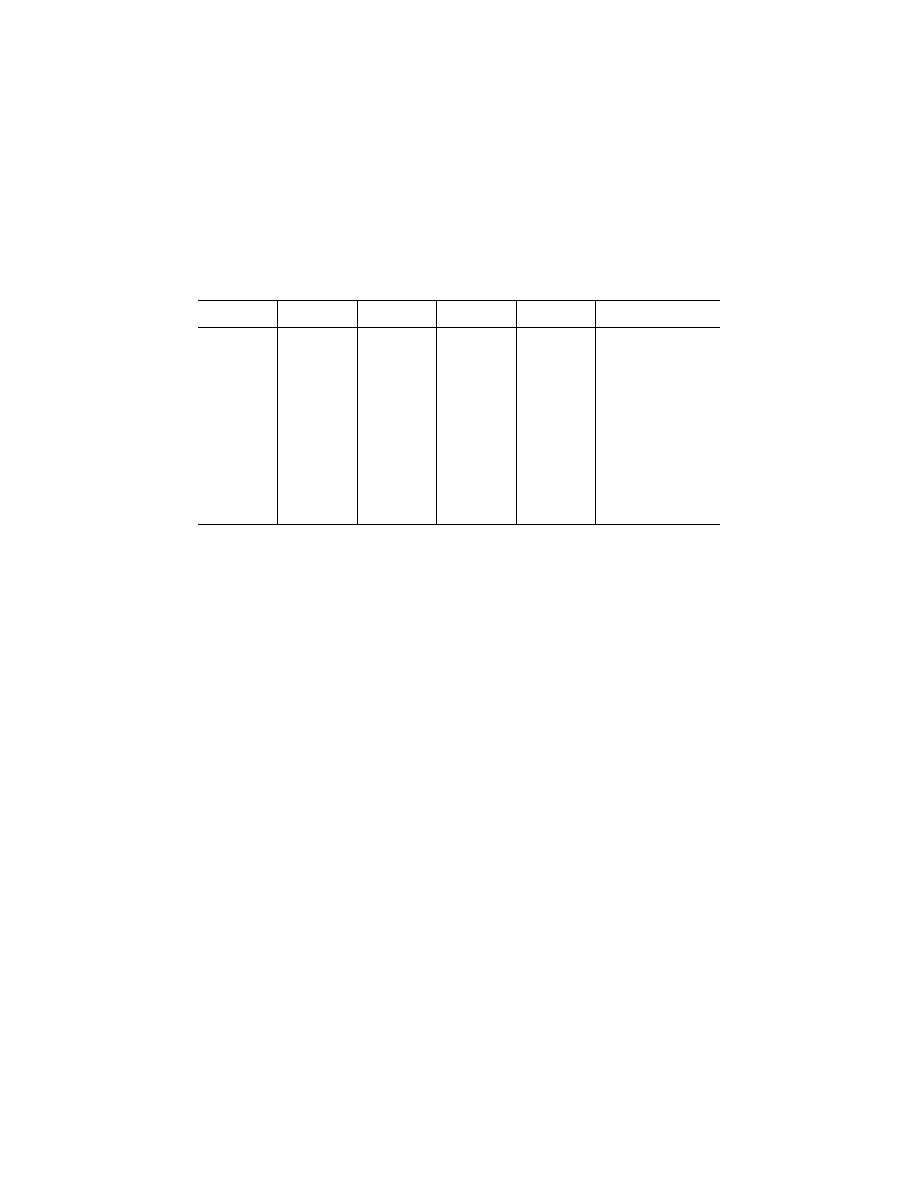
547
Federal Aviation Administration, DOT
Pt. 135, App. G
The recorded values must meet the designated range, resolution and accuracy requirements during static and dynamic condi-
tions. Dynamic condition means the parameter is experiencing change at the maximum rate attainable, including the maximum
rate of reversal. All data recorded must be correlated in time to within one second.
Parameters
Range
Accuracy (sensor
input)
Seconds per
sampling interval
Resolution
Remarks
88. All cockpit
flight control
input forces
(control wheel,
control column,
rudder pedal)
18
.
Full Range Con-
trol wheel
±
70
lbs. Control
column
±
85
lbs. Rudder
pedal
±
165 lbs.
±
5
°
.....................
1 ........................
0.3% of full
range.
For fly-by-wire flight control
systems, where flight con-
trol surface position is a
function of the displace-
ment of the control input
device only, it is not nec-
essary to record this pa-
rameter. For airplanes that
have a flight control break-
away capability that allows
either pilot to operate the
control independently,
record both control force
inputs. The control force
inputs may be sampled al-
ternately once per 2 sec-
onds to produce the sam-
pling interval of 1.
1
For A300 B2/B4 airplanes, resolution = 6 seconds.
2
For A330/A340 series airplanes, resolution = 0.703
°
.
3
For A318/A319/A320/A321 series airplanes, resolution = 0.275% (0.088
°
>0.064
°
). For A330/A340 series airplanes, resolution
= 2.20% (0.703
°
>0.064
°
).
4
For A318/A319/A320/A321 series airplanes, resolution = 0.22% (0.088
°
>0.080
°
). For A330/A340 series airplanes, resolution
= 1.76% (0.703
°
>0.080
°
).
5
For A330/A340 series airplanes, resolution = 1.18% (0.703
°
>0.120
°
).
6
For A330/A340 series airplanes, resolution = 0.783% (0.352
°
>0.090
°
).
7
For A330/A340 series airplanes, aileron resolution = 0.704% (0.352
°
>0.100
°
). For A330/A340 series airplanes, spoiler resolu-
tion = 1.406% (0.703
°
>0.100
°
).
8
For A330/A340 series airplanes, resolution = 0.30% (0.176
°
>0.12
°
). For A330/A340 series airplanes, seconds per sampling
interval = 1.
9
For B–717 series airplanes, resolution = .005g. For Dassault F900C/F900EX airplanes, resolution = .007g.
10
For A330/A340 series airplanes, resolution = 1.05% (0.250
°
>0.120
°
).
11
For A330/A340 series airplanes, resolution = 1.05% (0.250
°
>0.120
°
). For A300 B2/B4 series airplanes, resolution = 0.92%
(0.230
°
>0.125
°
).
12
For A330/A340 series airplanes, spoiler resolution = 1.406% (0.703
°
>0.100
°
).
13
For A330/A340 series airplanes, resolution = 0.5
°
C.
14
For Dassault F900C/F900EX airplanes, Radio Altitude resolution = 1.25 ft.
15
For A330/A340 series airplanes, resolution = 0.352 degrees.
16
For A318/A319/A320/A321 series airplanes, resolution = 4.32%. For A330/A340 series airplanes, resolution is 3.27% of full
range for throttle lever angle (TLA); for reverse thrust, reverse throttle lever angle (RLA) resolution is nonlinear over the active
reverse thrust range, which is 51.54 degrees to 96.14 degrees. The resolved element is 2.8 degrees uniformly over the entire ac-
tive reverse thrust range, or 2.9% of the full range value of 96.14 degrees.
17
For A318/A319/A320/A321 series airplanes, with IAE engines, resolution = 2.58%.
18
For all aircraft manufactured on or after December 6, 2010, the seconds per sampling interval is 0.125. Each input must be
recorded at this rate. Alternately sampling inputs (interleaving) to meet this sampling interval is prohibited.
[Doc. No. 28109, 62 FR 38398, July 17, 1997; 62 FR 48135, Sept. 12, 1997; Amdt. 135–85, 67 FR 54323,
Aug. 21, 2002; Amdt. 135–89, 68 FR 42939, July 18, 2003; 68 FR 50069, Aug. 20, 2003; Amdt. 135–
113, 73 FR 12570, Mar. 7, 2008; Amdt. 135–121, 75 FR 17047, Apr. 5, 2010; Amdt. 135–120, 75 FR 7357,
Feb. 19, 2010; Docket FAA–2017–0733, Amdt. 135–137, 82 FR 34399, July 25, 2017]
A
PPENDIX
G
TO
P
ART
135—E
XTENDED
O
PERATIONS
(ETOPS)
G135.1
Definitions.
G135.1.1
Adequate Airport
means an airport
that an airplane operator may list with ap-
proval from the FAA because that airport
meets the landing limitations of § 135.385 or
is a military airport that is active and oper-
ational.
G135.1.2
ETOPS Alternate Airport
means an
adequate airport that is designated in a dis-
patch or flight release for use in the event of
a diversion during ETOPS. This definition
applies to flight planning and does not in
any way limit the authority of the pilot in
command during flight.
G135.1.3
ETOPS Entry Point
means the
first point on the route of an ETOPS flight,
determined using a one-engine inoperative
cruise speed under standard conditions in
still air, that is more than 180 minutes from
an adequate airport.
G135.1.4
ETOPS Qualified Person
means a
person, performing maintenance for the cer-
tificate holder, who has satisfactorily com-
pleted the certificate holder’s ETOPS train-
ing program.
G135.2
Requirements.
G135.2.1
General.
After August 13, 2008, no
certificate holder may operate an airplane,
other than an all-cargo airplane with more
than two engines, outside the continental
United States more than 180 minutes flying

548
14 CFR Ch. I (1–1–24 Edition)
Pt. 135, App. G
time (at the one-engine-inoperative cruise
speed under standard conditions in still air)
from an airport described in § 135.364 unless—
(a) The certificate holder receives ETOPS
approval from the FAA;
(b) The operation is conducted in a multi-
engine transport category turbine-powered
airplane;
(c) The operation is planned to be no more
than 240 minutes flying time (at the one en-
gine inoperative cruise speed under standard
conditions in still air) from an airport de-
scribed in § 135.364; and
(d) The certificate holder meets the re-
quirements of this appendix.
G135.2.2
Required certificate holder experience
prior to conducting ETOPS.
Before applying for ETOPS approval, the
certificate holder must have at least 12
months experience conducting international
operations (excluding Canada and Mexico)
with multi-engine transport category tur-
bine-engine powered airplanes. The certifi-
cate holder may consider the following expe-
rience as international operations:
(a) Operations to or from the State of Ha-
waii.
(b) For certificate holders granted ap-
proval to operate under part 135 or part 121
before February 15, 2007, up to 6 months of
domestic operating experience and oper-
ations in Canada and Mexico in multi-engine
transport category turbojet-powered air-
planes may be credited as part of the re-
quired 12 months of international experience
required by paragraph G135.2.2(a) of this ap-
pendix.
(c) ETOPS experience with other aircraft
types to the extent authorized by the FAA.
G135.2.3
Airplane requirements.
No certifi-
cate holder may conduct ETOPS in an air-
plane that was manufactured after February
17, 2015 unless the airplane meets the stand-
ards of § 25.1535.
G135.2.4
Crew information requirements.
The
certificate holder must ensure that flight
crews have in-flight access to current weath-
er and operational information needed to
comply with § 135.83, § 135.225, and § 135.229.
This includes information on all ETOPS Al-
ternate Airports, all destination alternates,
and the destination airport proposed for each
ETOPS flight.
G135.2.5
Operational Requirements.
(a) No person may allow a flight to con-
tinue beyond its ETOPS Entry Point un-
less—
(1) The weather conditions at each ETOPS
Alternate Airport are forecast to be at or
above the operating minima in the certifi-
cate holder’s operations specifications for
that airport when it might be used (from the
earliest to the latest possible landing time),
and
(3) All ETOPS Alternate Airports within
the authorized ETOPS maximum diversion
time are reviewed for any changes in condi-
tions that have occurred since dispatch.
(b) In the event that an operator cannot
comply with paragraph G135.2.5(a)(1) of this
appendix for a specific airport, another
ETOPS Alternate Airport must be sub-
stituted within the maximum ETOPS diver-
sion time that could be authorized for that
flight with weather conditions at or above
operating minima.
(c) Pilots must plan and conduct ETOPS
under instrument flight rules.
(d)
Time-Limited Systems.
(1) Except as pro-
vided in paragraph G135.2.5(d)(3) of this ap-
pendix, the time required to fly the distance
to each ETOPS Alternate Airport (at the all-
engines-operating cruise speed, corrected for
wind and temperature) may not exceed the
time specified in the Airplane Flight Manual
for the airplane’s most limiting fire suppres-
sion system time required by regulation for
any cargo or baggage compartments (if in-
stalled), minus 15 minutes.
(2) Except as provided in G135.2.5(d)(3) of
this appendix, the time required to fly the
distance to each ETOPS Alternate Airport
(at the approved one-engine-inoperative
cruise speed, corrected for wind and tem-
perature) may not exceed the time specified
in the Airplane Flight Manual for the air-
plane’s most time limited system time
(other than the airplane’s most limiting fire
suppression system time required by regula-
tion for any cargo or baggage compart-
ments), minus 15 minutes.
(3) A certificate holder operating an air-
plane without the Airplane Flight Manual
information needed to comply with para-
graphs G135.2.5(d)(1) and (d)(2) of this appen-
dix, may continue ETOPS with that airplane
until February 17, 2015.
G135.2.6
Communications Requirements.
(a) No person may conduct an ETOPS
flight unless the following communications
equipment, appropriate to the route to be
flown, is installed and operational:
(1) Two independent communication trans-
mitters, at least one of which allows voice
communication.
(2) Two independent communication re-
ceivers, at least one of which allows voice
communication.
(3) Two headsets, or one headset and one
speaker.
(b) In areas where voice communication fa-
cilities are not available, or are of such poor
quality that voice communication is not pos-
sible, communication using an alternative
system must be substituted.
G135.2.7
Fuel Requirements.
No person may
dispatch or release for flight an ETOPS
flight unless, considering wind and other
weather conditions expected, it has the fuel
otherwise required by this part and enough
fuel to satisfy each of the following require-
ments:

549
Federal Aviation Administration, DOT
Pt. 135, App. G
(a)
Fuel to fly to an ETOPS Alternate Airport.
(1) Fuel to account for rapid decompression
and engine failure. The airplane must carry
the greater of the following amounts of fuel:
(i) Fuel sufficient to fly to an ETOPS Al-
ternate Airport assuming a rapid decompres-
sion at the most critical point followed by
descent to a safe altitude in compliance with
the oxygen supply requirements of § 135.157;
(ii) Fuel sufficient to fly to an ETOPS Al-
ternate Airport (at the one-engine-inoper-
ative cruise speed under standard conditions
in still air) assuming a rapid decompression
and a simultaneous engine failure at the
most critical point followed by descent to a
safe altitude in compliance with the oxygen
requirements of § 135.157; or
(iii) Fuel sufficient to fly to an ETOPS Al-
ternate Airport (at the one-engine-inoper-
ative cruise speed under standard conditions
in still air) assuming an engine failure at the
most critical point followed by descent to
the one engine inoperative cruise altitude.
(2) Fuel to account for errors in wind fore-
casting. In calculating the amount of fuel re-
quired by paragraph G135.2.7(a)(1) of this ap-
pendix, the certificate holder must increase
the actual forecast wind speed by 5% (result-
ing in an increase in headwind or a decrease
in tailwind) to account for any potential er-
rors in wind forecasting. If a certificate hold-
er is not using the actual forecast wind based
on a wind model accepted by the FAA, the
airplane must carry additional fuel equal to
5% of the fuel required by paragraph
G135.2.7(a) of this appendix, as reserve fuel to
allow for errors in wind data.
(3) Fuel to account for icing. In calculating
the amount of fuel required by paragraph
G135.2.7(a)(1) of this appendix, (after com-
pleting the wind calculation in G135.2.7(a)(2)
of this appendix), the certificate holder must
ensure that the airplane carries the greater
of the following amounts of fuel in anticipa-
tion of possible icing during the diversion:
(i) Fuel that would be burned as a result of
airframe icing during 10 percent of the time
icing is forecast (including the fuel used by
engine and wing anti-ice during this period).
(ii) Fuel that would be used for engine
anti-ice, and if appropriate wing anti-ice, for
the entire time during which icing is fore-
cast.
(4) Fuel to account for engine deteriora-
tion. In calculating the amount of fuel re-
quired by paragraph G135.2.7(a)(1) of this ap-
pendix (after completing the wind calcula-
tion in paragraph G135.2.7(a)(2) of this appen-
dix), the certificate holder must ensure the
airplane also carries fuel equal to 5% of the
fuel specified above, to account for deterio-
ration in cruise fuel burn performance unless
the certificate holder has a program to mon-
itor airplane in-service deterioration to
cruise fuel burn performance.
(b)
Fuel to account for holding, approach,
and landing.
In addition to the fuel required
by paragraph G135.2.7 (a) of this appendix,
the airplane must carry fuel sufficient to
hold at 1500 feet above field elevation for 15
minutes upon reaching the ETOPS Alternate
Airport and then conduct an instrument ap-
proach and land.
(c)
Fuel to account for APU use.
If an APU
is a required power source, the certificate
holder must account for its fuel consumption
during the appropriate phases of flight.
G135.2.8
Maintenance Program Requirements.
In order to conduct an ETOPS flight under
§ 135.364, each certificate holder must develop
and comply with the ETOPS maintenance
program as authorized in the certificate
holder’s operations specifications for each
two-engine airplane-engine combination
used in ETOPS. This provision does not
apply to operations using an airplane with
more than two engines. The certificate hold-
er must develop this ETOPS maintenance
program to supplement the maintenance pro-
gram currently approved for the operator.
This ETOPS maintenance program must in-
clude the following elements:
(a)
ETOPS maintenance document.
The cer-
tificate holder must have an ETOPS mainte-
nance document for use by each person in-
volved in ETOPS. The document must—
(1) List each ETOPS Significant System,
(2) Refer to or include all of the ETOPS
maintenance elements in this section,
(3) Refer to or include all supportive pro-
grams and procedures,
(4) Refer to or include all duties and re-
sponsibilities, and
(5) Clearly state where referenced material
is located in the certificate holder’s docu-
ment system.
(b)
ETOPS pre-departure service check.
The
certificate holder must develop a pre-depar-
ture check tailored to their specific oper-
ation.
(1) The certificate holder must complete a
pre-departure service check immediately be-
fore each ETOPS flight.
(2) At a minimum, this check must:
(i) Verify the condition of all ETOPS Sig-
nificant Systems;
(ii) Verify the overall status of the air-
plane by reviewing applicable maintenance
records; and
(iii) Include an interior and exterior in-
spection to include a determination of en-
gine and APU oil levels and consumption
rates.
(3) An appropriately trained maintenance
person, who is ETOPS qualified must accom-
plish and certify by signature ETOPS spe-
cific tasks. Before an ETOPS flight may
commence, an ETOPS pre-departure service
check (PDSC) Signatory Person, who has
been authorized by the certificate holder,
must certify by signature, that the ETOPS
PDSC has been completed.
(4) For the purposes of this paragraph (b)
only, the following definitions apply:

550
14 CFR Ch. I (1–1–24 Edition)
Pt. 135, App. G
(i) ETOPS qualified person: A person is
ETOPS qualified when that person satisfac-
torily completes the operator’s ETOPS
training program and is authorized by the
certificate holder.
(ii) ETOPS PDSC Signatory Person: A per-
son is an ETOPS PDSC Signatory Person
when that person is ETOPS Qualified and
that person:
(A) When certifying the completion of the
ETOPS PDSC in the United States:
(
1
) Works for an operator authorized to en-
gage in part 135 or 121 operation or works for
a part 145 repair station; and
(
2
) Holds a U.S. Mechanic’s Certificate
with airframe and powerplant ratings.
(B) When certifying the completion of the
ETOPS PDSC outside of the U.S. holds a cer-
tificate in accordance with § 43.17(c)(1) of this
chapter; or
(C) When certifying the completion of the
ETOPS PDSC outside the U.S. holds the cer-
tificates needed or has the requisite experi-
ence or training to return aircraft to service
on behalf of an ETOPS maintenance entity.
(iii) ETOPS maintenance entity: An entity
authorized to perform ETOPS maintenance
and complete ETOPS pre-departure service
checks and that entity is:
(A) Certificated to engage in part 135 or 121
operations;
(B) Repair station certificated under part
145 of this title; or
(C) Entity authorized pursuant to
§ 43.17(c)(2) of this chapter.
(c)
Limitations on dual maintenance.
(1) Ex-
cept as specified in paragraph G135.2.8(c)(2)
of this appendix, the certificate holder may
not perform scheduled or unscheduled dual
maintenance during the same maintenance
visit on the same or a substantially similar
ETOPS Significant System listed in the
ETOPS maintenance document, if the im-
proper maintenance could result in the fail-
ure of an ETOPS Significant System.
(2) In the event dual maintenance as de-
fined in paragraph G135.2.8(c)(1) of this ap-
pendix cannot be avoided, the certificate
holder may perform maintenance provided:
(i) The maintenance action on each af-
fected ETOPS Significant System is per-
formed by a different technician, or
(ii) The maintenance action on each af-
fected ETOPS Significant System is per-
formed by the same technician under the di-
rect supervision of a second qualified indi-
vidual; and
(iii) For either paragraph G135.2.8(c)(2)(i)
or (ii) of this appendix, a qualified individual
conducts a ground verification test and any
in-flight verification test required under the
program developed pursuant to paragraph
G135.2.8(d) of this appendix.
(d)
Verification program.
The certificate
holder must develop a program for the reso-
lution of discrepancies that will ensure the
effectiveness of maintenance actions taken
on ETOPS Significant Systems. The
verification program must identify potential
problems and verify satisfactory corrective
action. The verification program must in-
clude ground verification and in-flight
verification policy and procedures. The cer-
tificate holder must establish procedures to
clearly indicate who is going to initiate the
verification action and what action is nec-
essary. The verification action may be per-
formed on an ETOPS revenue flight provided
the verification action is documented as sat-
isfactorily completed upon reaching the
ETOPS entry point.
(e)
Task identification.
The certificate hold-
er must identify all ETOPS-specific tasks.
An ETOPS qualified person must accomplish
and certify by signature that the ETOPS-
specific task has been completed.
(f)
Centralized maintenance control proce-
dures.
The certificate holder must develop
procedures for centralized maintenance con-
trol for ETOPS.
(g)
ETOPS parts control program.
The cer-
tificate holder must develop an ETOPS parts
control program to ensure the proper identi-
fication of parts used to maintain the con-
figuration of airplanes used in ETOPS.
(h)
Enhanced Continuing Analysis and Sur-
veillance System (E–CASS) program.
A certifi-
cate holder’s existing CASS must be en-
hanced to include all elements of the ETOPS
maintenance program. In addition to the re-
porting requirements of § 135.415 and § 135.417,
the program includes reporting procedures,
in the form specified in § 135.415(e), for the
following significant events detrimental to
ETOPS within 96 hours of the occurrence to
the responsible Flight Standards office:
(1) IFSDs, except planned IFSDs performed
for flight training.
(2) Diversions and turnbacks for failures,
malfunctions, or defects associated with any
airplane or engine system.
(3) Uncommanded power or thrust changes
or surges.
(4) Inability to control the engine or obtain
desired power or thrust.
(5) Inadvertent fuel loss or unavailability,
or uncorrectable fuel imbalance in flight.
(6) Failures, malfunctions or defects asso-
ciated with ETOPS Significant Systems.
(7) Any event that would jeopardize the
safe flight and landing of the airplane on an
ETOPS flight.
(i)
Propulsion system monitoring.
The certifi-
cate holder, in coordination with the respon-
sible Flight Standards office, must—
(1) Establish criteria as to what action is
to be taken when adverse trends in propul-
sion system conditions are detected, and
(2) Investigate common cause effects or
systemic errors and submit the findings to
the responsible Flight Standards office with-
in 30 days.

551
Federal Aviation Administration, DOT
Pt. 136
(j)
Engine condition monitoring.
(1) The cer-
tificate holder must establish an engine-con-
dition monitoring program to detect deterio-
ration at an early stage and to allow for cor-
rective action before safe operation is af-
fected.
(2) This program must describe the param-
eters to be monitored, the method of data
collection, the method of analyzing data, and
the process for taking corrective action.
(3) The program must ensure that engine
limit margins are maintained so that a pro-
longed engine-inoperative diversion may be
conducted at approved power levels and in
all expected environmental conditions with-
out exceeding approved engine limits. This
includes approved limits for items such as
rotor speeds and exhaust gas temperatures.
(k)
Oil consumption monitoring.
The certifi-
cate holder must develop an engine oil con-
sumption monitoring program to ensure that
there is enough oil to complete each ETOPS
flight. APU oil consumption must be in-
cluded if an APU is required for ETOPS. The
operator’s consumption limit may not ex-
ceed the manufacturer’s recommendation.
Monitoring must be continuous and include
oil added at each ETOPS departure point.
The program must compare the amount of
oil added at each ETOPS departure point
with the running average consumption to
identify sudden increases.
(l)
APU in-flight start program.
If an APU is
required for ETOPS, but is not required to
run during the ETOPS portion of the flight,
the certificate holder must have a program
acceptable to the FAA for cold soak in-flight
start and run reliability.
(m)
Maintenance training.
For each air-
plane-engine combination, the certificate
holder must develop a maintenance training
program to ensure that it provides training
adequate to support ETOPS. It must include
ETOPS specific training for all persons in-
volved in ETOPS maintenance that focuses
on the special nature of ETOPS. This train-
ing must be in addition to the operator’s
maintenance training program used to qual-
ify individuals for specific airplanes and en-
gines.
(n)
Configuration, maintenance, and proce-
dures (CMP) document.
The certificate holder
must use a system to ensure compliance
with the minimum requirements set forth in
the current version of the CMP document for
each airplane-engine combination that has a
CMP.
(o)
Reporting.
The certificate holder must
report quarterly to the responsible Flight
Standards office and the airplane and engine
manufacturer for each airplane authorized
for ETOPS. The report must provide the op-
erating hours and cycles for each airplane.
G135.2.9
Delayed compliance date for all air-
planes.
A certificate holder need not comply
with this appendix for any airplane until Au-
gust 13, 2008.
[Doc. No. FAA–2002–6717, 72 FR 1885, Jan. 16,
2007, as amended by Amdt. 135–108, 72 FR
7348, Feb. 15, 2007; 72 FR 26542, May 10, 2007;
Amdt. 135–112, 73 FR 8798, Feb. 15, 2008; Amdt.
135–115, 73 FR 33882, June 16, 2008; Docket
FAA–2018–0119, Amdt. 135–139, 83 FR 9175,
Mar. 5, 2018]
PART 136—COMMERCIAL AIR
TOURS AND NATIONAL PARKS
AIR TOUR MANAGEMENT
Subpart A—National Air Tour Safety
Standards
Sec.
136.1
Applicability and definitions.
136.3
Letters of Authorization.
136.5
Additional requirements for Hawaii.
136.7
Passenger briefings.
136.9
Life preservers for operations over
water.
136.11
Rotorcraft floats for over water.
136.13
Performance plan.
136.15–136.29
[Reserved]
Subpart B—National Parks Air Tour
Management
136.31
Applicability.
136.33
Definitions.
136.35
Prohibition of commercial air tour
operations over the Rocky Mountain Na-
tional Park.
136.37
Overflights of national parks and
tribal lands.
136.39
Air tour management plans (ATMP).
136.41
Interim operating authority.
136.43–136.49
[Reserved]
Subpart C—Grand Canyon National Park
136.51–136.69
[Reserved]
Subpart D—Special Operating Rules for Air
Tour Operators in the State of Hawaii
136.71
Applicability.
136.73
Definitions.
136.75
Equipment and requirements.
A
UTHORITY
: 49 U.S.C. 106(f), 106(g), 40113,
40119, 44101, 44701–44702, 44705, 44709–44711,
44713, 44716–44717, 44722, 44901, 44903–44904,
44912, 46105.
S
OURCE
: Docket No. FAA–2001–8690, 67 FR
65667, Oct. 25, 2002, unless otherwise noted.








































































































































